17.1: Working Capital
17.1.1: Calculating Working Capital
Working Capital = current assets – current liabilities.
Learning Objective
Calculate a company’s working capital
Key Points
- WC is current assets minus current liabilities. Companies want positive WC.
- WC is an signal of whether or not the company has enough assets to turn into cash to pay upcoming expenses or debts.
- WC is a measurement of liquidity and is not a guarantee that a company can pay for its liabilities.
Key Terms
- Current Asset
-
An asset on the balance sheet, such as cash, accounts receivable, and inventory that is expected to be sold or otherwise used up in the near future, usually within one year or one business cycle, whichever is longer.
- liquidity
-
Availability of cash over short term: ability to service short-term debt.
- current liabilities
-
All liabilities of the business that are to be settled in cash within the fiscal year or the operating cycle of a given firm, whichever period is longer.
Working capital (WC) is a financial metric which represents operating liquidity available to a business, organization, or other entity, including governmental entity. Along with fixed assets, such as plant and equipment, working capital is considered a part of operating capital.
Working capital can be found through the following formula:
WC=CA-CL (Working Capital = current assets – current liabilities)
Current assets (CA) is an accounting term that refers to assets that can easily be turned into cash. For example, cash is a current asset, but so are most accounts receivable.
Current liabilities (CL) is an accounting term similar to CA: CL is the amount of liabilities that are expected to be settled in cash within a year (or the operating cycle of the company).
The difference between the two (WC) is a measurement of liquidity. It signals whether or not the company has enough assets to turn into cash to pay off upcoming liabilities. It is not a perfect signal, however.
Since most expenses and debt must be paid in cash , having positive WC shows that the company has the ability to pay off expenses and debt that will arise or come due in the short-term.

Buying Food
Most purchases, including food, must be made with a specific asset–cash. Not all current assets can be used to pay off expenses of debts.
WC, though, does not guarantee that a company can pay off all short-term expenses or liabilities. Simply having positive WC does not mean necessarily that a company will be able to pay off all expenses. Suppose that a company has current assets of $100: $20 of cash and $80 of accounts receivable. They also have $50 of current liabilities. That means that they have WC of +$50. One of their accounts payable comes due tomorrow, so the company owes $40. They have $20 of cash on hand, but can’t get the other $20 by tomorrow because they can’t collect $20 of accounts receivable by tomorrow. The company cannot pay a short-term expense, even though a positive WC says that the company should be able to pay off most expenses and loans in the short-term.
WC is not a guarantee that the company will have enough cash for each expense, merely that they have operating liquidity.
17.1.2: Controlling the Components of Working Capital
Working capital (WC) can be controlled by changing the levels of current assets and/or current liabilities through a number of mechanisms.
Learning Objective
Discuss how a company can adjust its working capital
Key Points
- Increasing current assets or decreasing current liabilities increases WC, and vice versa.
- Four common mechanisms for controlling WC are cash management, inventory management, debtors management, and financing management.
- Having too little WC impairs a company’s ability to meet it’s financial obligations, while having too much WC can also be bad because it means that there are assets that are not being invested in the long-term.
Key Terms
- Current Asset
-
An asset on the balance sheet, such as cash, accounts receivable, and inventory that is expected to be sold or otherwise used up in the near future, usually within one year or one business cycle, whichever is longer.
- current liabilities
-
All liabilities of the business that are to be settled in cash within the fiscal year or the operating cycle of a given firm, whichever period is longer.
Controlling the Components of Working Capital
Each company has different demands for how much Working Capital (WC) they need, but all companies prefer to have positive WC (recall that WC = current assets – current liabilities). Having too little WC impairs a company’s ability to meet it’s financial obligations. It is hard to pay expenses or debts that come due in the short-term. Having too much WC can also be bad because it means that there are assets that are not being invested. Holding too many short term assets slows future growth of the company. Thus, managing WC to an acceptable level is one of the most important jobs of management .

Walmart CFO
Charles Holley, the Chief Financial Officer (CFO) of Wal-Mart, is in charge of making sure all of Wal-Mart’s assets are allocated as optimally as possible.
WC can be adjusted by increasing or decreasing its two components: current assets (CA) and current liabilities (CL). Increasing CA or decreasing CL increases WC, and vis versa. Management can enact a number of policies, some of which are highlighted below:
- Cash management: Identify the cash balance that allows the business to meet day to day expenses, but reduces cash holding costs. Cash is a CA.
- Inventory management: Identify the level of inventory which allows for uninterrupted production but reduces the investment in raw materials–and minimizes reordering costs–and hence increases cash flow. Inventory is a CA.
- Debtors management: Identify the appropriate credit policy, such as credit terms, that will attract customers, such that any impact on cash flows and the cash conversion cycle will be offset by increased revenue and hence Return on Capital (or vice versa). Credit extended to customers (accounts receivable) is a CA.
- Financing management: Identify the appropriate source of financing. Short-term financing (as well as long-term financing that comes due in the next year or operating cycle) is a CL.
By adjusting these four primary influencers on CA and CL, management can change WC to a desirable level.
17.1.3: Importance of Working Capital
Working capital (WC) is a measurement of a company’s operating liquidity.
Learning Objective
Discuss why working capital is important to businesses
Key Points
- WC is important for large companies’ ability to borrow, increase their share price, pay expenses and short-term debts.
- WC is important for small companies that cannot access financial markets to borrow, and for start-ups that need to survive until they break even.
- WC cannot guarantee whether a company is financially sound, but it gives some insight.
Key Terms
- operating liquidity
-
The ability of a company or individual to quickly convert assets to cash for the purpose of paying operating expenses.
- working capital
-
A financial metric that is a measure of current assets of a business that exceeds its liabilities and can be applied to its operation.
Working capital (WC) is an important metric for all businesses, regardless of their size. WC is a signal of a company’s operating liquidity . Having enough WC means that the company should be able to pay for all of its short-term expenses and liabilities.

Cash
Liquidity is a measurement of a company’s ability to quickly turn assets into cash.
Large companies pay attention to WC for the same reason as small ones do: WC is a measure of liquidity, and thus is a measure of their future credit-worthiness. Companies who want to borrow by issuing bonds or purchasing commercial paper (a market of large, short-term loans for big companies) will find it more expensive if they do not have enough WC. If they are a public company, their stock price may fall if the market doesn’t believe they have adequate WC.
For small businesses and start-ups, unable to access financial markets for borrowing, WC has more dire implications. WC can also be described as the amount of money that a small business or start-up needs to stay in operation. Start-ups need to pay attention to their WC because it is the amount of money they need to keep the business running until they break-even (start earning a net profit).
On one hand, WC is important to because it is a measure of a company’s ability to pay off short-term expenses or debts. On the other hand, too much working capital means that some assets are not being invested for the long-term, so they are not being put to good use in helping the company grow as much as possible.
WC is only one measure of a company’s operating liquidity. It is not the only measure, and it is certainly not a guarantee of a company’s ability to pay. A company may have positive WC, but not enough cash to pay an expense tomorrow. Similarly, a company may have negative WC, but may be able to adjust some of their debt into long-term debt in order to reduce their current liabilities.
WC is an important metric, but is not the whole story of a company’s financial health.
17.2: Approaches to Working Capital Financing
17.2.1: Understanding the Needs of the Business
Working capital needs will vary depending on the type of the business and its operational requirements.
Learning Objective
Describe the goals of a business in the context of ts working capital needs
Key Points
- Sufficient working capital is required to ensure that a firm is able to continue its operations and that it has sufficient funds to satisfy both maturing short-term and long-term debt and upcoming operational expenses.
- The management of working capital involves managing inventories, accounts receivable and payable, and cash.
- When calculating working capital we think in terms of net working capital, which is calculated as current assets minus current liabilities.
- In any company, large or small, there is an inherent tradeoff between liquidity and profitability.
Key Term
- inventory
-
The stock of an item on hand at a particular location or business
Understanding the Business Needs
Working capital is a financial metric which represents the operating liquidity available to a business. Working capital is considered a part of operating capital along with fixed assets, such as plant and equipment. Sufficient working capital is required to ensure that a firm is able to continue its operations and that it has sufficient funds to satisfy both maturing short-term and long-term debt and take care of upcoming operational expenses. However, too much working capital can carry with it a higher cost of capital. A company can be endowed with assets and profitability but short of liquidity if its assets cannot readily be converted into cash. The management of working capital involves managing inventories, accounts receivable and payable, and cash.
Calculation of Working Capital
When calculating working capital, we think in terms of net working capital, which is calculated as current assets minus current liabilities. This is the figure commonly used in valuation techniques such as discounted cash flows. If current assets are less than current liabilities, an entity has a working capital deficiency, also called a working capital deficit. Current assets and current liabilities include three accounts which are of special importance. These accounts represent the areas of the business where managers have the most direct impact:
- Accounts receivable (current asset)
- Inventory (current asset)
- Accounts payable (current liability)
A company ideally wants accounts receivable to be collected as quickly as possible in order to have as much use of the funds as possible. Conversely, a firm strives to put off the settlement of accounts payable as long as possible for the same reason. The current portion of debt is also critical, because it represents a short-term claim to current assets and is often secured by long term assets. Common types of short-term debt are bank loans and lines of credit. Inventory is a special case in which even non-financial managers have a stage. Too much inventory on hand will reduce the risk of a company failing to satisfy customer needs, but it can also reduce profitability. An example of reduced profitability would be in the computer industry, where inventories regularly lose value because of the fast-moving nature of the industry.

Inventory Software
This is an example of modern inventory software that enables managers to precisely track orders and inventory levels.
Profitability and Liquidity Tradeoff
In any company, large or small, there is an inherent tradeoff between liquidity and profitability. Large companies possess resources to help them manage this tradeoff, such as an accounting department, negotiating power with their suppliers, or access to the capital markets. For the entrepreneur, however, who is often resource-starved and doesn’t have enough operating history to secure additional credit, managing this tradeoff can feel like walking a tightrope. Consider the case of a new customer for a small company. This new customer has the potential to offer huge growth in the company’s sales, but this growth in sales will be accompanied by a subsequent growth in variable costs. The company may not have the resources, i.e., working capital, to meet these variable costs that come with increased sales.
17.2.2: Long-Term Approach
Recognize the broader objectives of working capital, as well as how organizations can consider a long-term perspective when viewing the utilization of working capital.
Learning Objective
Identify the primary objectives of working capital, and how a longer-term perspective can offer insights
Key Points
- Working capital demonstrates the current operating liquidity of a given organization through subtracting the current liabilities from the current assets.
- The primary objectives of working capital are profitability and liquidity.
- Short-term planning is predominately what is used when discussing working capital management, as working capital is intrinsically a short-term assessment.
- However, some long-term perspectives can be utilized when approaching working capital. This includes how working capital is considered strategically, and the organizational policies around availability and utilization of working capital.
Key Term
- Working capital
-
The total available cash and cash equivalents after subtracting current liabilities from current assets.
Working Capital
Working capital is a calculation of the overall operating liquidity an organization has access to at a given moment, derived through a simple calculation from the balance sheet:
Working Capital = Current Assets – Current Liabilities
Current assets are items a business owns that are either current cash, or assets that can be rapidly converted to cash, such as accounts receivables, cash, cash equivalents, short-term investments, and inventory. Current liabilities are debts owed in the short term, such as accounts payable, short-term debts, and other obligations within a short operational cycle.
When you subtract what is owed in the short term from what is available, an organization can project how much free working capital is on hand during the operating cycle.
Long Term Planning
This free working capital can be utilized in a variety of ways. Working capital under-utilized incurs the opportunity costs associated with the time value of money, and organizations must use financial planning to ensure appropriate utilization of this capital over the longer term.
While short-term planning is predominately what is used in respect to working capital (due to the short term nature of the inputs and outputs involved), it is reasonable to set long-term polices and strategies for incorporating changes in working capital into financial strategy. The primary benefits of leveraging working capital are liquidity and profitability, each of which can be viewed through a longer term lens.
Liquidity
When discussing long-term objectives, the focal point is broader strategy (as opposed to tactics). From a strategic perspective, there is a certain amount of liquidity business would like to maintain at any given moment to ensure that they can capture external opportunities in the market. Having easily accessible working capital at any given moment enables organizations to minimize the opportunity cost of foregone opportunities, and careful regulation of working capital strategic criteria can ensure the appropriate amount is available.
Profitability
The other broader objective of working capital is how effectively it is utilized over a given time period. From the long-term perspective, this profitability metric will be quite a bit different than the short term. From a longer-term perspective, working capital profitability decisions revolve around how much should be available within any short-term time frame in order to maximize the return (on average) of existing working capital. By looking at differences in working capital availability over a long period of historical data, the organization can make rough estimations of the optimal amount of working capital availability that allows optimal growth.
Despite the potential advantages of longer-term planning in working capital, it is still largely a field of shorter term decision making. Generally, working capital should be considered within a one year or less time frame, making it more often a shorter term decision.
17.2.3: Short-Term Approach
Decisions relating to working capital are usually short-term, since it is the difference between current assets and current liabilities.
Learning Objective
Explain how the cash conversion cycle influences working capital management
Key Points
- The main considerations for working capital are cash flow / liquidity and profitability / returns on capital.
- The most widely used measure of cash flow is the net operating cycle or cash conversion cycle.
- The cash conversion cycle measures how long a firm will be deprived of cash if it increases its investment in resources in order to expand customer sales.
- The aim of the study and calculation of the cash conversion cycle is to change the policies relating to credit purchase and credit sales.
Key Term
- discounting
-
The process of finding the present value using the discount rate.
Short-Term Approach to Working Capital Management
Working capital is the amount of capital that is readily available to an organization. Working capital is the difference between cash resources or assets readily convertible into cash (current assets) and cash obligations (current liabilities). As a result, the decisions relating to working capital are almost always current, i.e., short term, decisions. In other words, working capital management differs from capital investment decisions – specifically in terms of discounting and profitability. Working capital management applies different criteria in decision making. The main considerations are cash flow / liquidity and profitability / returns on capital. The most widely used measure of cash flow is the net operating cycle or cash conversion cycle. This measures how long a firm will be deprived of cash if it increases its investment in resources in order to expand customer sales.
The cash conversion cycle indicates the firm’s ability to convert its resources into cash and informs management of the liquidity risk entailed by growth . Because this number effectively corresponds to the time that the firm’s cash is tied up in operations and unavailable for other activities, management generally aims at shortening the cash conversion cycle as much as possible. However, shortening the cycle creates its own risks. While a firm could even achieve a negative cash conversion by collecting from customers before paying suppliers, a policy of strict collections and lax payments is not typically sustainable. The aim of the study and calculation of the cash conversion cycle is to change the policies relating to credit purchase and credit sales. A firm can change its standards for payment on credit purchases and getting payment from debtors on the basis of cash conversion cycle. If the firm is in an effective cash liquidity position, it can maintain its past credit policies.
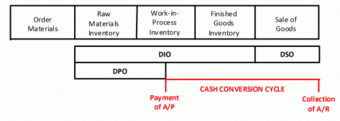
Cash Conversion Cycle
Above is a chart showing a sample cash conversion cycle.
17.2.4: Choosing a Policy
A firm will use a combination of policies for managing working capital, focusing on cash flow, liquidity, profitability, and capital return.
Learning Objective
Describe refinancing risk and how it influence working capital policy
Key Points
- Working capital policies aim at managing current assets – generally, cash and cash equivalents, inventories, and debtors – and short term financing, such that cash flows and returns are acceptable.
- One of the objectives within working capital management and general financing decisions is to match the maturity of liabilities with the life expectancy of assets.
- If the maturity of liabilities is less than the life expectancy of assets, a firm faces refinancing risk since it will have to raise new capital to pay off liabilities.
Key Term
- credit policy
-
Credit terms given to customers that affect sales and collection practices.
Choosing a Policy
Guided by criteria measuring cash flow, liquidity, profitability, and return on capital, the management of a firm will use a combination of policies and techniques for the management of working capital. These policies aim to manage the current assets – generally, cash and cash equivalents, inventories and debtors – and the short term financing, such that cash flows and returns are acceptable. As with any decision involving the management of capital, the firm’s goal should be to minimize the overall cost of capital and maximize value to the shareholders . In order to effectively manage cash flow, a firm should identify the cash balance which allows for the business to meet day to day expenses, but reduces cash holding costs – i.e., the opportunity cost of holding cash as opposed to investing it.
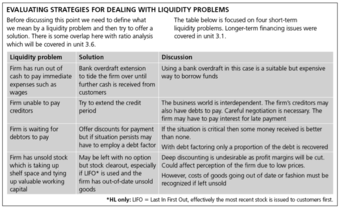
Policies Regarding Liquidity
This chart lays out sample working capital issues and some possible solutions.
A company should also identify the level of inventory which allows for uninterrupted production, but reduces the investment in raw materials – and minimizes reordering costs – and therefore increases cash flow. Another area of concern for a firm will be managing debtors. Management should identify the appropriate credit policy so that any impact on cash flows and the cash conversion cycle will be offset by increased revenue and return on capital. Moreover, management should implement appropriate credit scoring policies and techniques so that the risk of default on any new business is acceptable given these criteria.
A final area management should be concerned with when deciding on a working capital policy is short-term financing. A firm should identify the appropriate source of financing, given the cash conversion cycle. Inventory is ideally financed by credit granted by the supplier. However, it may be necessary to utilize a bank loan.
Refinancing Risk
One of the objectives within working capital management and general financing decisions is to match the maturity of liabilities with the life expectancy of assets. This allows liabilities to be self-liquidating. If the maturity of liabilities is less than the life expectancy of assets, a firm faces refinancing risk since it will have to raise new capital to pay off liabilities. If the maturity of liabilities is longer than the life expectancy of assets, then there should be sufficient working capital available to pay off debts. The mismatching of liabilities with assets can occur if financing is not available.
For example, suppose long-term financing is not available. Short-term sources of financing may have to be used. Mismatching can also be intentional. For example, suppose a company expects long-term interest rates to fall. The firm may want to finance assets with short-term maturities since it can refinance in a few years at much lower rate.
17.3: Overview of the Working Capital Financing Decision
17.3.1: Evaluating Interest Rates
Management of working capital requires evaluating factors affecting cash flows — including the evaluation of appropriate interest rates.
Learning Objective
Evaluate a company’s interest rates based on its stage of development
Key Points
- The interest rate most commonly used in working capital management is the cost of capital.
- Firm value is enhanced when, and if, the return on capital, which results from working-capital management, exceeds the cost of capital, which results from capital investment decisions.
- Working capital decision criteria that focus on interest rates include debtors management and short-term financing.
- The discount rates typically applied to different types of companies show significant differences.
Key Terms
- cash conversion cycle
-
how long a firm will be deprived of cash if it increases its investment in resources in order to expand customer sales.
- credit rating
-
An estimate, based on a company or person’s history of borrowing and repayment and/or available financial resources, that is used by creditors to determine the maximum amount of credit it can extend to a without undue risk.
- cost of capital
-
The rate of return that capital could be expected to earn in an alternative investment of equivalent risk.
Evaluating Interest Rates
The management of working capital takes place in the realm of short-term decision-making. These decisions are, therefore, based primarily on profitability, cash flows and their management. Many criteria go into the management of cash flows and subsequently the management of working capital — including the evaluation of appropriate interest rates.
The interest rate most commonly used in working capital management is the cost of capital. The cost of capital, in a financial market equilibrium, will be the same as the market rate of return on the financial asset mixture the firm uses to finance capital investment. In other words, a company’s cost of capital is the cost of obtaining funds for operation through the sale of equity or debt in the marketplace. In market equilibrium, investors will determine what return they expect from providing funds to a company. The return expected on debt depends upon the credit rating of the company, which takes into account a number of factors to determine how risky loaning funds to a company will be. The return expected from equity also involves a number of factors, usually centered around the operation of the company and its prospects for profitability. Some conventional rates of return expected for various types of companies include:
- Startups seeking money: 50% – 100%
- Early startups: 40% – 60%
- Late startups: 30% – 50%
- Mature companies: 10% – 25%
When evaluating short-term profitability, company’s may use measures such as return on capital. ROC is shown as a percentage, determined by dividing relevant income for the 12 months by capital employed. Firm value is enhanced when, and if, the return on capital, which results from working-capital management, exceeds the cost of capital, which results from capital investment decisions. ROC measures are therefore useful as a management tool, in that they link short-term policy with long-term decision making.
As mentioned, working capital decisions are made with the short-term in mind. Thus, working capital policies aim at managing the current assets (generally cash and cash equivalents, inventories and debtors) and the short term financing, such that cash flows and returns are acceptable. Decision criteria that focus on interest rates include debtors management and short-term financing.
Debtors management involves identifying the appropriate credit policy — i.e. credit terms which will attract customers — such that any impact on cash flows and the cash conversion cycle will be offset by increased revenue and, hence, return on capital (or vice versa). Interest rates can affect this decision because of the time value of money. If inflation is at a high level or there are opportunities foregone because of lack of working capital, a firm will more than likely have a stricter credit policy.
Short-term financing involves identifying the appropriate source of financing, given the cash conversion cycle. For instance, inventory is ideally financed by credit granted by the supplier; however, it may be necessary to utilize a bank loan or to “convert debtors to cash.”. Another possible solution is to use services from companies sell outstanding invoices to raise working capital for their clients. Obviously interest rates will play a vital role in determining whether an option such as a bank loan is viable for obtaining short-term financing.
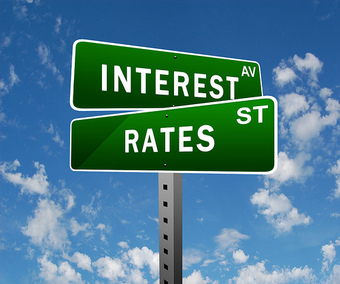
Interest
Interest rates of working capital financing can be largely affected by discount rate, WACC and cost of capital.
17.3.2: Decision Criteria
The main considerations of working capital management decisions are (1) cash flow/ liquidity and (2) profitability/return on capital.
Learning Objective
Identify which factors influence a company’s working capital management decisions
Key Points
- The decisions relating to working capital are always current (i.e., short-term decisions.
- The most useful measure of profitability is return on capital (ROC).
- One measure of cash flow is provided by the cash conversion cycle (CCC)–the net number of days from the outlay of cash for raw material to receiving payment from the customer.
- The most useful measure of profitability is return on capital (ROC).
Key Terms
- liquidity
-
Availability of cash over short term: ability to service short-term debt.
- working capital
-
A financial metric that is a measure of current assets of a business that exceeds its liabilities and can be applied to its operation.
Working capital is the amount of capital which is readily available to an organization. That is, working capital is the difference between resources in cash or readily convertible into cash (current assets), and cash requirements (current liabilities). As a result, the decisions relating to working capital are always current (i.e., short-term decisions). In addition to the time horizon, working capital decisions differ from capital investment decisions in terms of discounting and profitability considerations; they are also “reversible” to some extent.
Working capital management decisions are, therefore, not made on the same basis as long-term decisions, and working capital management applies different criteria in decision making: the main considerations are (1) cash flow/liquidity and (2) profitability/ return on capital (of which cash flow is generally the most important).
1. Cash Conversion Cycle (CCC)
One measure of cash flow is provided by the cash conversion cycle—the net number of days from the outlay of cash for raw material to receiving payment from the customer. As a management tool, this metric makes explicit the interrelatedness of decisions regarding inventories, accounts receivable and payable, and cash. Because this number effectively corresponds to the time that the firm’s cash is tied up in operations and unavailable for other activities, management generally aims at a low net count.
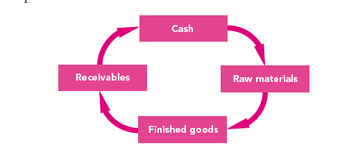
Cash cycle
Cash conversion cycle is a main criteria for working capital management.
2. Return On Capital (ROC)
In this context, the most useful measure of profitability is return on capital (ROC). The result is shown as a percentage, determined by dividing relevant income for the 12 months by capital employed; return on equity (ROE) shows this result for the firm’s shareholders. Firm value is enhanced when, and if, the return on capital, which results from working-capital management, exceeds the cost of capital, which results from capital investment decisions as above. ROC measures are, therefore, useful as a management tool, in that they link short-term policy with long-term decision making.
Credit
policy
Another factor affecting working capital management is credit policy of the firm. It includes buying of raw materials and selling of finished goods either in cash or on credit. This affects the cash conversion cycle.
17.3.3: Identifying Varying Conditions
Management uses policies and techniques for the management of working capital such as cash, inventory, debtors and short term financing.
Learning Objective
Identify the four main areas of variability of working capital management
Key Points
- The goal of working capital management is to ensure that the firm is able to continue its operations and that it has sufficient cash flow to satisfy both maturing short-term debt and upcoming operational expenses.
- Identify the cash balance which allows for the business to meet day to day expenses, but reduces cash holding costs.
- Identify the level of inventory which allows for uninterrupted production but reduces the investment in raw materials – and minimizes reordering costs – and hence increases cash flow.
- Identify the appropriate credit policy and the appropriate source of financing, given the cash conversion cycle.
Key Terms
- Work in process
-
Work in process (WIP) or in-process inventory includes the set at large of unfinished items for products in a production process. These items are not yet completed but either just being fabricated or waiting in a queue for further processing or in a buffer storage.
- Finished good
-
Finished goods are goods that have completed the manufacturing process but have not yet been sold or distributed to the end user.
Decisions relating to working capital and short-term financing are referred to as working capital management. These involve managing the relationship between a firm’s short-term assets and its short-term liabilities. The goal of working capital management is to ensure that the firm is able to continue its operations and that it has sufficient cash flow to satisfy both maturing short-term debt and upcoming operational expenses.
Management will use a combination of policies and techniques for the management of working capital. The policies aim at managing the current assets (generally cash and cash equivalents, inventories and debtors) and the short-term financing, such that cash flows and returns are acceptable.
There are four main areas of variability that must be managed
1. Cash management
Identify the cash balance that allows for the business to meet day-to-day expenses, but reduces cash holding costs.
2. Inventory management
Identify the level of inventory that allows for uninterrupted production but reduces the investment in raw materials and minimizes reordering costs and, hence, increases cash flow. Besides this, the lead times in production should be lowered to reduce work in process (WIP) and similarly, the finished goods should be kept on as low level as possible to avoid over production.

Inventory
Identify the level of inventory which allows for uninterrupted production but reduces the investment in raw materials and minimizes reordering costs and, hence, increases cash flow.
3. Debtors management
Identify the appropriate credit policy (i.e., credit terms which will attract customers such that any impact on cash flows and the cash conversion cycle will be offset by increased revenue and hence return on capital or vice versa).
4. Short-term financing
Identify the appropriate source of financing, given the cash conversion cycle. The inventory is ideally financed by credit granted by the supplier; however, it may be necessary to utilize a bank loan (or overdraft), or to “convert debtors to cash” through “factoring. “
17.3.4: Calculating Expected Value
The main accounts which affect the value of working capital are accounts receivable, inventory, and accounts payable.
Learning Objective
Calculate a company’s working capital
Key Points
- Positive working capital is required to ensure that a firm is able to continue its operations and that it has sufficient funds to satisfy both maturing short-term debt and upcoming operational expenses.
- The management of working capital involves managing inventories, accounts receivable and payable, and cash.
- Current assets and current liabilities include three accounts which are of special importance: accounts receivable, inventory, and accounts payable.
- Working capital is equal to accounts receivable plus the value of inventory, minus accounts payable.
Key Terms
- M&A
-
Mergers and acquisitions (M&A) are aspects of corporate strategy, corporate finance, and management dealing with the buying, selling, dividing, and combining of different companies and similar entities that can help an enterprise grow rapidly in its sector or location of origin, or a new field or new location, without creating a subsidiary, other child entity or using a joint venture.
- balance sheet
-
A summary of a person’s or organization’s assets, liabilities and equity as of a specific date.
Working capital (WC) is a financial metric which represents operating liquidity available to a business, organization, or other entity – including a governmental entity. Along with fixed assets such as plant and equipment, working capital is considered a part of operating capital. Net working capital is calculated as current assets minus current liabilities. It is a derivation of working capital that is commonly used in valuation techniques, such as DCFs (Discounted Cash Flows). If current assets are less than current liabilities, an entity has a working capital deficiency, also called a “working capital deficit. “
A company can be endowed with assets and profitability but short on liquidity if its assets cannot readily be converted into cash. Positive working capital is required to ensure that a firm is able to continue its operations and that it has sufficient funds to satisfy both maturing short-term debt and upcoming operational expenses. The management of working capital involves managing inventories, accounts receivable and payable, and cash.
Calculation
Current assets and current liabilities include three accounts which are of special importance. These accounts represent the areas of the business where managers have the most direct impact:
- accounts receivable (current asset)
- inventory (current assets)
- accounts payable (current liability)
Therefore, in this context, we calculate available working capital using the following formula:

Working Capital Equation
Working capital is equal to accounts receivable, plus current inventory, minus accounts payable.
These values can be readily found on a company’s balance sheet. The current portion of debt (payable within 12 months) is critical, because it represents a short-term claim to current assets and is often secured by long-term assets. Common types of short-term debt are bank loans and lines of credit.
As an example, imagine a company has accounts receivable of $10,000, current inventory that has a value of $5,000, and accounts payable of $7,000. We can find working capital by:
Working Capital = $10,000 + $5,000 – $7,000 = $8,000
An increase in working capital indicates that the business has either increased current assets (that it has increased its receivables, or other current assets) or has decreased current liabilities, for example, has paid off some short-term creditors.
Implications on M&A
The common commercial definition of working capital for the purpose of a working capital adjustment in a mergers and acquisitions transaction (i.e., for a working capital adjustment mechanism in a sale and purchase agreement) is equal to:
Current Assets – Current liabilities (excluding deferred tax assets/liabilities, excess cash, surplus assets, and/or deposit balances).
Cash balance items often attract a one-for-one purchase-price adjustment.
Chapter 16: Options and Corporate Finance
16.1: Convertible Securities
16.1.1: Overview of Convertible Securities
Convertible securities are convertible bonds or preferred stocks that pay regular interest and can be converted into shares of common stock.
Learning Objective
Discuss the advantages and disadvantages of convertible bonds
Key Points
- A convertible bond is a type of bond that the holder can convert into shares of common stock in the issuing company or cash of equal value, at an agreed-upon price.
- Convertible preferred stocks are securities that contain a provision in which the holder may convert the preferred into the common stock of the company under certain conditions.
- Convertible arbitrage involves the simultaneous purchase of convertible securities and the short sale of the same issuer’s common stock.
- Forced conversion usually occurs when the price of the stock is higher than the amount it would be if the bond were redeemed.
Key Term
- debt gearing
-
debt techniques used to multiply gains or losses; also known as leverage.
Overview Of Convertible Securities
Convertible securities can be bonds or preferred stocks that pay regular interest and can be converted into shares of common stock (sometimes conditioned on the stock price appreciating to a predetermined level).
A convertible bond (CB) is a type of bond that can be converted into shares of common stock in the issuing company or cash of equal value, at an agreed-upon price. It is a hybrid security with debt and equity-like features. Although a CB typically has a coupon rate lower than that of similar, non-convertible debt, the instrument carries additional value through the option to convert the bond to stock, and thereby participate in further growth in the company’s equity value. The investor receives the potential upside of conversion into equity while protecting the downside with cash flow from coupon payments and the return of principal upon maturity. Convertible bonds are usually issued offering a higher yield than obtainable on the shares into which the bonds convert. Convertible bond markets in the United States and Japan are of primary global importance because they are the largest in terms of market capitalization.
Convertible bonds have all the features of typical bonds, plus the following additional features:
- Conversion price: The nominal price per share at which conversion takes place.
- Conversion ratio: The number of shares each convertible bond converts into.
- Parity (Conversion) value: Equity price × Conversion ratio.
- Conversion premium: Represent the divergence of the market value of the CB compared to that of the parity value.
- Call features: The ability of the issuer (on some bonds) to call a bond early for redemption.
- Put features: The ability of the holder of the bond (the lender) to force the issuer (the borrower) to repay the loan at a date earlier than the maturity.
Convertible preferred stocks are securities that contain a provision by which the holder may convert the preferred into the common stock of the company (or, sometimes, into the common stock of an affiliated company) under certain conditions – among which may be the specification of a future date when conversion may begin, a certain number of common shares per preferred share or a certain price per share for the common stock.
Convertible Arbitrage
Convertible arbitrage is a market-neutral investment strategy often employed by hedge funds. It involves the simultaneous purchase of convertible securities and the short sale of the same issuer’s common stock. The premise of this strategy is that the convertible is sometimes priced inefficiently relative to the underlying stock, for reasons that range from illiquidity to market psychology. In particular, the equity option embedded in the convertible bond may be a source of cheap volatility, which convertible arbitrageurs can then exploit. Under normal market conditions, the arbitrageur expects the combined position to be insensitive to small fluctuations in the price of the underlying stock.

Arbitrage
Arbitrage is the simultaneous purchase and sale of an asset in order to profit from a difference in the price. This diagram illustrates an arbitrage opportunity in foreign currency exchange.
Advantages and Disadvantages Of Convertibles
From the issuer’s perspective, the key benefit of raising money by selling convertible bonds is a reduced cash interest payment. The advantage for companies of issuing CBs is that, if the bonds are converted to stocks, the company’s debt vanishes. Additional advantages for issuers include:
- Lower fixed-rate borrowing costs.
- Locking into low fixed-rate long-term borrowing.
- Deferral of voting dilution.
- Increasing the total level of debt gearing.
- Tax advantages: a high tax-paying shareholder can benefit from the company securitizing gross future income on a convertible income that it can offset against taxable profits.
Convertible bonds are safer for the investor than preferred or common shares; they provide asset protection, because the value of the convertible bond will only fall to the value of the bond floor. At the same time, CBs can provide the possibility of high equity-like returns. Also, CBs are usually less volatile than regular shares.
A primary disadvantage of convertible bonds is their liquidity risk. In theory, when a stock declines, the associated convertible bond will decline less, because it is protected by its value as a fixed-income instrument. However, CBs can decline in value more than stocks due to their liquidity risk. Moreover, in exchange for the benefit of reduced interest payments, the value of shareholder’s equity is reduced due to the stock dilution expected when bondholders convert their bonds into new shares. Convertible securities also bring with them the risk of diluting control of the company and forced conversion, which occurs when the price of the stock is higher than the amount it would be if the bond were redeemed. This feature caps the capital appreciation potential of a convertible bond.
16.2: Options
16.2.1: Defining Options and Their Valuation
Options give the owner the right, but not the obligation, to buy or sell an underlying asset or instrument.
Learning Objective
Discuss the factors that influence the values of different types of options
Key Points
- An option that conveys the right to buy something at a specific price is called a call; an option that conveys the right to sell something at a specific price is called a put.
- Today, many options are created in a standardized form and traded through clearinghouses on regulated options exchanges, while other over-the-counter options are written as bilateral, customized contracts between a single buyer and seller.
- The most common options are European, which may only be exercised on expiration, and American, may be exercised on any trading day on or before expiration.
- Nearly all stock and equity options are American options, while indexes are generally represented by European options.
Key Terms
- stochastic
-
Random, randomly determined, relating to stochastics.
- in the money
-
For a call option, when the option’s strike price is below the market price of the underlying asset. For a put option, when the strike price is above the market price of the underlying asset.
- out of the money
-
A call option with a strike price that is higher than the market price of the underlying asset, or a put option with a strike price that is lower than the market price of the underlying asset.
Options are a type of derivative that give the owner the right, but not the obligation, to buy or sell an underlying asset or instrument at a specified strike price on or before a specified date. The seller incurs a corresponding obligation to fulfill the transaction, that is to sell or buy, if the long holder elects to “exercise” the option prior to expiration. The buyer pays a premium to the seller for this right. An option that conveys the right to buy something at a specific price is referred to as a call; an option that conveys the right to sell something at a specific price is called a put.
The value of an option is commonly deconstructed into two parts. The first of these is the “intrinsic value,” which is defined as the difference between the market value of the underlying asset and the strike price of the given option. The second part depends on a set of other factors which, through a multi-variable, non-linear interrelationship, reflect the discounted expected value of that difference at expiration. Today, many options are created in a standardized form and traded through clearinghouses on regulated options exchanges, while other over-the-counter options are written as bilateral, customized contracts between a single buyer and seller – one or both of which may be a dealer or market-maker.
Contract Specifications
Every financial option is a contract between two counterparties with the terms of the option specified in a term sheet. Option contracts may be quite complicated; however, at minimum, they usually contain the following specifications:
- Whether the option holder has the right to buy (a call option) or the right to sell (a put option).
- The quantity and class of the underlying asset (e.g., 100 shares of XYZ Co. B stock).
- The strike price, also known as the exercise price, which is the price at which the underlying transaction will occur upon exercise.
- The expiration date, which is the last date the option can be exercised.
- The settlement terms – for instance whether the writer must deliver the actual asset on exercise, or may simply tender the equivalent cash amount.
- The terms by which the option is quoted in the market to convert the quoted price into the actual premium – the total amount paid by the holder to the writer.
Option Styles
Naming conventions are used to help identify properties common to many different types of options. These include:
- European option – may only be exercised on expiration.
- American option – may be exercised on any trading day on or before expiration.
- Bermudan option – may be exercised only on specified dates on or before expiration.
- Asian option – the payoff is determined by the average underlying price over some preset time period.
- Barrier option – any option with the general characteristic that the underlying security’s price must pass a certain level or “barrier” before it can be exercised.
- Binary option – an all-or-nothing option that pays the full amount if the underlying security meets the defined condition on expiration, otherwise it expires worthless.
- Exotic option – any of a broad category of options that may include complex financial structures.
- Vanilla option – any option that is not exotic.
Nearly all stock and equity options are American options, while indexes are generally represented by European options.
Valuation
The value of an option can be estimated using a variety of quantitative techniques based on the concept of risk neutral pricing and using stochastic calculus. In general, standard option valuation models depend on the following factors:
- The current market price of the underlying security,
- The strike price of the option, particularly in relation to the current market price of the underlying (in the money vs. out of the money),
- The cost of holding a position in the underlying security, including interest and dividends,
- The time to expiration together with any restrictions on when exercise may occur, and
- An estimate of the future volatility of the underlying security’s price over the life of the option.
More advanced models can require additional factors, such as an estimate of how volatility changes over time and for various underlying price levels, or the dynamics of stochastic interest rates.
Black-Scholes Model
In 1973, Fischer Black and Myron Scholes made a major breakthrough by deriving a differential equation that must be satisfied by the price of any derivative dependent on a non-dividend-paying stock. By employing the technique of constructing a risk neutral portfolio that replicates the returns of holding an option, Black and Scholes produced a closed-form solution for a European option’s theoretical price. At the same time, the model generates hedge parameters necessary for effective risk management of option holdings. The application of the model in actual options trading can be clumsy because of the assumptions of continuous (or no) dividend payment, constant volatility, and a constant interest rate. Nevertheless, the Black-Scholes model is still one of the most important methods and foundations for the existing financial market in which the result is within the reasonable range.
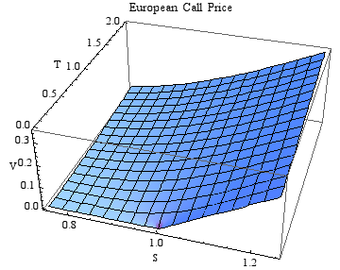
European Call Surface
A European call valued using the Black-Scholes pricing equation for varying asset price S and time-to-expiry T. In this particular example, the strike price is set to unity, the risk-free rate is 0.04 and the volatility is 0.2.
The Black–Scholes equation is a partial differential equation that describes the price of the option over time. The key idea behind the equation is that one can perfectly hedge the option by buying and selling the underlying asset in just the right way and consequently “eliminate risk. ” This hedge, in turn, implies that there is only one right price for the option.

Valuation of a Call Option
Where: N is the cumulative distribution function of the standard normal distribution; T – t is the time to maturity; S is the spot price of the underlying asset; K is the strike price; r is the risk free rate; and omega is the volatility of returns of the underlying asset.

Value of a Put Option
Where: N is the cumulative distribution function of the standard normal distribution; T – t is the time to maturity; S is the spot price of the underlying asset; K is the strike price; r is the risk free rate; and omega is the volatility of returns of the underlying asset.
16.3: Warrants
16.3.1: Overview of Warrants
A warrant is a security that entitles the holder to buy the underlying stock of the issuing company at a fixed exercise price until the expiration date.
Learning Objective
Differentiate warrants from other type of convertibles
Key Points
- A warrant’s “premium” represents how much extra you have to pay for your shares when buying them through the warrant as compared to buying them the regular way.
- Warrants are issued by private parties, typically the corporation on which a warrant is based, rather than a public options exchange.
- A warrant’s lifetime is measured in years (as long as 15 years), while options are typically measured in months.
- The market value of a warrant can be divided into two components: intrinsic value and time value.
- Warrants are often used as deal sweeteners, in order to entice hesitant investors.
Key Terms
- intrinsic
-
Innate, inherent, inseparable from the thing itself, essential.
- stockbroker
-
A person who buys and sells shares (stock) on a stock exchange on behalf of clients. May also provide investment advice and/or company information, depending on the level of service offered (or chosen by the client).
- portfolio
-
The group of investments and other assets held by an investor.
Overview of Warrants
A warrant is a security that entitles the holder to buy the underlying stock of the issuing company at a fixed exercise price until the expiration date. Some important characteristics to consider include the following:
- A warrant is exercised when the holder informs the issuer of their intention to purchase the shares underlying the warrant.
- A warrant’s “premium” represents how much extra you have to pay for your shares when buying them through the warrant as compared to buying them the regular way.
- A warrant’s “gearing” is the way to ascertain how much more exposure you have to the underlying shares using the warrant as compared to the exposure you would have if you buy the shares through the market.
- If you plan on exercising the warrant, you must do so before the expiration date. The more time remaining until expiration, the more time for the underlying security to appreciate, which, in turn, will increase the price of the warrant (unless it depreciates). Therefore, the expiration date is the date on which the right to exercise ceases to exist.
- Like options, there are different exercise types associated with warrants such as American style (holder can exercise anytime before expiration) or European style (holder can only exercise on expiration date).
Sometimes, the issuer will try to establish a market for the warrant and to register it with a listed exchange. In this case, the price can be obtained from a stockbroker. Often, though, warrants are privately held or not registered, which makes their prices less obvious.
Warrants Versus Other Convertibles
Warrants are very similar to call options. For instance, many warrants confer the same rights as equity options, and warrants often can be traded in secondary markets like options. However, there are several key differences between warrants and equity options:
- Warrants are issued by private parties, typically the corporation on which a warrant is based, rather than a public options exchange.
- Warrants issued by the company itself are dilutive. When the warrant issued by the company is exercised, the company issues new shares of stock, so the number of outstanding shares increases. When a call option is exercised, the owner of the call option receives an existing share from an assigned call writer. Unlike common stock shares outstanding, warrants do not have voting rights.
- Warrants are considered over-the-counter instruments, and thus are usually only traded by financial institutions with the capacity to settle and clear these types of transactions.
- A warrant’s lifetime is measured in years (as long as 15 years), while options are typically measured in months. Upon expiration, the warrants are worthless unless the price of the common stock is greater than the exercise price.
- Warrants are not standardized like exchange-listed options. While each option contract is generally over 1,000 underlying ordinary shares, the number of warrants that must be exercised by the holder to buy the underlying asset depends on the conversion ratio set out in the offer documentation for the warrant issue.
Valuation
There are various methods of evaluating warrants, the most popular being the Black-Scholes evaluation model [see section on Options]. However, it is important to have some understanding of the various influences on warrant prices. The market value of a warrant can be divided into two components:
Intrinsic value: This is simply the difference between the exercise (strike) price and the underlying stock price. Warrants are also referred to as in-the-money or out-of-the-money, depending on where the current asset price is in relation to the warrant’s exercise price. Thus, for instance, for call warrants, if the stock price is below the strike price, the warrant has no intrinsic value (only time value – to be explained shortly). If the stock price is above the strike, the warrant has intrinsic value and is said to be in-the-money.
Time value: Time value can be considered as the value of the continuing exposure to the movement in the underlying security that the warrant provides. Time value declines as the expiration of the warrant gets closer. This erosion of time value is called time decay. It is not constant, but increases rapidly towards expiration. Time value is affected by time to expiration, volatility, dividends and interest rates.
Traditional warrants are issued in conjunction with a bond (known as a warrant-linked bond), and represent the right to acquire shares in the entity issuing the bond. In other words, the writer of a traditional warrant is also the issuer of the underlying instrument. Warrants are issued in this way to reduce the interest rate that must be offered in order to sell the bond issue. Valuing this type of warrant can be accomplished with the following equation:

Valuing a Warrant
Where: P is the price paid for the bond with warrants; C is the coupon payment; T is the maturity of the bond; r is the required rate of return; and F is the face value of the bond.
Uses, Advantages & Disadvantages
Warrants are often used as deal sweeteners, in order to entice hesitant investors. However, a warrant only benefits the investor if the company grows. Warrants can also be used for portfolio protection. For example, put warrants allow the owner to protect the value of the owner’s portfolio against falls in the market or in particular shares. Because of the dilutive nature of warrants, their issuance can lead to a decrease in stock value and loss of voting control. Warrants may also carry liquidity risk, due to their specialized nature.
16.4: Derivatives
16.4.1: Overview of Derivatives
A derivative is a financial instrument whose value is based on one or more underlying assets.
Learning Objective
Differentiate between different types of derivatives and their uses
Key Points
- Derivatives are broadly categorized by the relationship between the underlying asset and the derivative, the type of underlying asset, the market in which they trade, and their pay-off profile.
- The most common types of derivatives are forwards, futures, options, and swaps. The most common underlying assets include commodities, stocks, bonds, interest rates, and currencies.
- Derivatives allow investors to earn large returns from small movements in the underlying asset’s price. Conversely, investors could lose large amounts if the price of the underlying moves against them significantly.
- Derivatives contracts can be either over-the-counter or exchange-traded.
Key Terms
- derivative
-
A financial instrument whose value depends on the valuation of an underlying asset; such as a warrant, an option, etc.
- margin
-
Collateral that the holder of a financial instrument has to deposit to cover some or all of the credit risk of their counterparty.
- notional
-
Having descriptive value as opposed to a syntactic category.
Overview Of Derivatives
A derivative is a financial instrument whose value is based on one or more underlying assets. In practice, it is a contract between two parties that specifies conditions – especially dates, resulting values of the underlying variables, and notional amounts – under which payments are to be made between the parties.
Derivatives are broadly categorized by the relationship between the underlying asset and the derivative, the type of underlying asset, the market in which they trade, and their pay-off profile. The most common types of derivatives are forwards, futures, options, and swaps. The most common underlying assets include commodities, stocks, bonds, interest rates, and currencies.
Derivatives are used by investors for the following:
- To provide leverage, such that a small movement in the underlying value can cause a large difference in the value of the derivative.
- To speculate and make a profit if the value of the underlying asset moves the way they expect.
- To hedge or mitigate risk in the underlying, by entering into a derivative contract whose value moves in the opposite direction to the underlying position and cancels part or all of it out.
- To obtain exposure to the underlying where it is not possible to trade in the underlying (e.g., weather derivatives).
- To create option ability where the value of the derivative is linked to a specific condition or event (e.g. the underlying reaching a specific price level).
The use of derivatives can result in large losses because of the use of leverage. Derivatives allow investors to earn large returns from small movements in the underlying asset’s price. Conversely, investors could lose large amounts if the price of the underlying moves against them significantly .
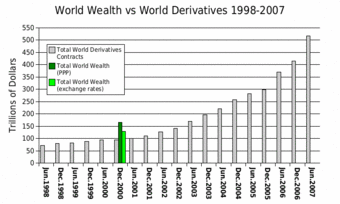
World Wealth Vs. World Derivatives
This graph illustrates total world wealth versus total notional value in derivatives contracts between 1998 and 2007.
Types
In broad terms, there are two groups of derivative contracts, which are distinguished by the way they are traded in the market.
Over-the-counter (OTC) derivatives are contracts that are traded (and privately negotiated) directly between two parties, without going through an exchange or other intermediary. Products such as swaps, forward rate agreements, exotic options – and other exotic derivatives – are almost always traded in this way. The OTC derivative market is the largest market for derivatives, and is mostly unregulated with respect to disclosure of information between the parties.
Exchange-traded derivative contracts (ETD) are those derivatives instruments that are traded via specialized derivatives exchanges or other exchanges. A derivatives exchange is a market where individuals trade standardized contracts that have been defined by the exchange. It acts as an intermediary to all related transactions, and takes initial margin from both sides of the trade to act as a guarantee.
Common Derivative Types
A forward contract is a non-standardized contract between two parties to buy or sell an asset at a specified future time, at a price agreed upon today. The party agreeing to buy the underlying asset in the future assumes a long position, and the party agreeing to sell the asset in the future assumes a short position. The price agreed upon is called the delivery price, which is equal to the forward price at the time the contract is entered into. The forward price of such a contract is commonly contrasted with the spot price, which is the price at which the asset changes hands on the spot date. The difference between the spot and the forward price is the forward premium or forward discount, generally considered in the form of a profit, or loss, by the purchasing party.
A futures contract differs from a forward contract in that the futures contract is a standardized contract written by a clearing house that operates an exchange where the contract can be bought and sold. On the other hand, the forward contract is a non-standardized contract written by the parties themselves. Forwards also typically have no interim partial settlements – or “true-ups” – in margin requirements like futures, such that the parties do not exchange additional property, securing the party at gain, and the entire unrealized gain or loss builds up while the contract is open.
Swaps are derivatives in which counterparties exchange cash flows of one party’s financial instrument for those of the other party’s financial instrument. For example, in the case of a swap involving two bonds, the benefits in question can be the periodic interest (or coupon) payments associated with the bonds. Specifically, the two counterparties agree to exchange one stream of cash flows against another stream. The swap agreement defines the dates when the cash flows are to be paid and the way they are calculated. Usually at the time when the contract is initiated at least one of these series of cash flows is determined by a random or uncertain variable such as an interest rate, foreign exchange rate, equity price or commodity price.
16.5: Managing Risk with Derivatives
16.5.1: Uses of Derivatives to Manage Exposure
Derivatives allow risk related to the price of underlying assets, such as commodities, to be transferred from one party to another.
Learning Objective
Discuss how derivatives manage exposure
Key Points
- Companies that produce or depend on the purchase of commodities are exposed to price fluctuations that occur in commodities markets.
- Hedging also occurs when an individual or institution buys an asset (such as a commodity, a bond that has coupon payments, a stock that pays dividends, etc. ) and sells it using a futures contract.
- Although a third party, called a “clearing house,” insures a futures contract; not all derivatives are insured against counter-party risk.
Key Term
- commodities
-
term used to describe a class of goods for which there is demand, but which is supplied without qualitative differentiation across a market.
Managing Exposure
Companies that produce or depend on the purchase of commodities are exposed to price fluctuations that occur in commodities markets. Examples of such companies include the airline industry, which is constantly exposed to the price of oil, and farming, which is not only exposed to the fluctuation in the price they can sell their goods at, but also the fluctuation in the price of animal feed, fertilizer, pesticides, and other such inputs.
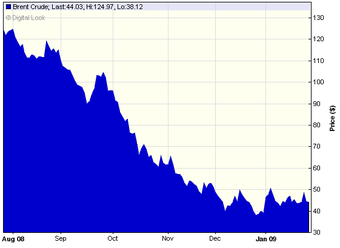
Commodity Price Fluctuation
This graph shows the price of crude oil between August 2008 and January 2009. Companies depending on the price of oil for their supply can implement hedging strategies using derivatives to manage this exposure.
Derivatives allow risk related to the price of underlying assets, such as commodities, to be transferred from one party to another. For example, a wheat farmer and a miller could sign a futures contract to exchange a specified amount of cash for a specified amount of wheat in the future. Both parties have reduced a future risk: for the wheat farmer, the uncertainty of the price, and for the miller, the availability of wheat. However, there is still the risk that no wheat will be available because of events unspecified by the contract, such as the weather, or that one party will renege on the contract. Although a third party, called a clearing house, insures a futures contract, not all derivatives are insured against counter-party risk.
Hedging also occurs when an individual or institution buys an asset (such as a commodity, a bond that has coupon payments, a stock that pays dividends, etc.) and sells it using a futures contract. The individual or institution has access to the asset for a specified amount of time and can then sell it in the future at a specified price according to the futures contract. Of course, this allows the individual or institution the benefit of holding the asset, while reducing the risk that the future selling price will deviate unexpectedly from the market’s current assessment of the future value of the asset.
Derivatives can serve legitimate business purposes, as well. For example, a corporation borrows a large sum of money at a specific interest rate. The rate of interest on the loan resets every six months. The corporation is concerned that the rate of interest may be much higher in six months. The corporation could buy a forward rate agreement (FRA), which is a contract to pay a fixed rate of interest six months after purchases on a notional amount of money. If the interest rate after six months is above the contract rate, the seller will pay the difference to the corporation, or FRA buyer. If the rate is lower, the corporation will pay the difference to the seller. The purchase of the FRA serves to reduce the uncertainty concerning the rate increase and stabilize earnings.
Chapter 15: Dividends
15.1: Introduction to Dividends
15.1.1: Defining Dividends
Dividends are a portion of company earnings regularly paid to shareholders, paid as some fixed amount per share price.
Learning Objective
Describe the process of issuing a dividend
Key Points
- Dividends are periodical payments a corporation can choose to issue to its shareholders, with the amount of payment to each shareholder commensurate with their number of shares. They may be paid as cash, additional stock, or property.
- Dividends may also be categorized as common stock or preferred dividends; preferred stock owners get their dividends paid in full first, before any common stock dividends are distributed.
- Ratios using dividend value, such as dividends per share (DPS), dividend yield, and payout ratio have historically been used as indicators of a stock’s investment strength and the company’s overall performance, though their usefulness has been contested.
Key Terms
- dividends per share
-
The amount shareholders earn per share.
- dividend yield
-
A company’s total annual dividend payment per share, divided by its price per share.
- dividend
-
A pro rata payment of money by a company to its shareholders, usually made periodically (e.g., quarterly or annually).
Dividends are payments made by a corporation to its shareholder members on a regular (usually quarterly) basis–these are essentially the shareholder’s portion of a company’s profits. A dividend is allocated as a fixed amount per share. Therefore, a shareholder receives a dividend in proportion to their shareholding; owning more shares results in greater dividends for the shareholder. When it is time to make dividend payments, corporations always pay preferred stock owners first, and then common stock dividends are allocated after all preferred dividends are paid in full. In the United States, dividends are usually declared quarterly by the corporation’s board of directors.
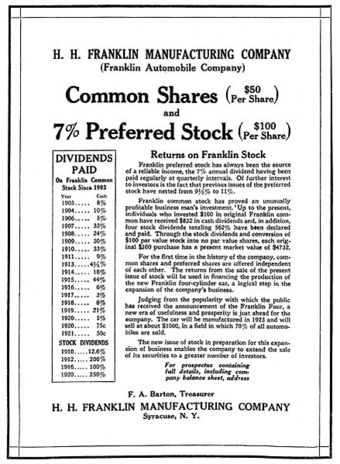
Historical dividend information for Franklin Automobile Company
Dividends are one of the privileges of stock ownership, and preferred shares get more rights to them than common shares do.
Dividends per share (DPS) refers to the dollar amount shareholders earn for each share, calculated by dividing total dividend amount by total number of shares outstanding. Dividend yield refers the ratio between dividends per share and the market price of each share, and it is expressed in terms of percentage. Payout ratio is calculated by dividing the company’s dividend by the earnings per share. A payout ratio greater than 1 means the company is paying out more in dividends for the year than it earned, while a low payout ratio indicates that the company is retaining a greater proportion of their earnings instead of paying out dividends. These ratios have historically been used as indicators of a stock’s investment strength and the company’s overall performance.
Dividends may be allocated in different forms of payment, outlined below:Cash dividends are the most common. As the name suggests, these are paid out as currency via electronic funds transfer or a printed paper check. For each share owned, a declared amount of money is distributed. Thus, if a person owns 1000 shares and the cash dividend is USD 0.90 per share, the holder of the stock will be paid USD 900.Stock dividends (also known as scrips) are payments in the form of additional stock shares of the company itself or one of its subsidiaries, as the name suggests. This may be a more palatable option for companies who would prefer to use its earnings towards growth of the company, rather than diverting them into cash dividends for shareholders. Property dividends or dividends in specie (Latin for “in kind”) are those paid out in the form of assets from the issuing corporation or another corporation, such as a subsidiary corporation. They are relatively rare and can take the form of securities of other companies owned by the issuer, or products and services. Companies may also offer reinvestment plans where shareholders can automatically reinvest dividends into more stock.
For public companies, there are six important dates to remember regarding dividends:
- Declaration date is the day the board of directors announces its intention to pay a dividend. On this day, a liability is created and the company records that liability on its books; it now owes the money to the stockholders. The board will also announce a date of record and a payment date.
- In-dividend date is the last day, which is one trading day before the ex-dividend date, where the stock is said to be cum dividend (‘with [including] dividend’). In other words, existing holders of the stock and anyone who buys it on this day will receive the dividend, whereas any holders selling the stock lose their right to the dividend. After this date the stock becomes ex-dividend.
- Ex-dividend date (typically two trading days before the record date for U.S. securities) is the day on which all shares bought and sold no longer come attached with the right to be paid the most recently declared dividend. This is an important date for any company that has many stockholders, including those that trade on exchanges, as it makes reconciliation of who is to be paid the dividend easier. Existing holders of the stock will receive the dividend even if they now sell the stock, whereas anyone who now buys the stock will not receive the dividend. It is relatively common for a stock’s price to decrease on the ex-dividend date by an amount roughly equal to the dividend paid. This reflects the decrease in the company’s assets resulting from the declaration of the dividend. The company does not take any explicit action to adjust its stock price; in an efficient market, buyers and sellers will automatically price this in.
- Book closure date is when company will ideally temporarily close its books for fresh transfers of stock.
- Record date refers to the date that shareholders must be registered on record in order to receive the dividend. Shareholders who are not registered as of this date will not receive the dividend.
- Payment date is the day when the dividends will actually be distributed to the shareholders of a company or credited to brokerage accounts.
15.1.2: The Nature of Dividends
Dividends are attractive to many investors because they are seen as steady streams of income from low risk investments.
Learning Objective
Analyze what dividends mean to an investor making a decision on which stock to include in her portfolio
Key Points
- Dividends offer consistent returns on relatively low risk investments. While companies experiencing rapid growth are unlikely to offer dividends, established companies with stable business and less room to grow do pay dividends to shareholders.
- A firm’s dividend decision may also serve as a signalling device about a firm’s future prospects. Due to information asymmetry between investors and the firm managers, investors will look to indicators like dividend decisions, which may give clues about what the firm managers forecast for the firm.
- Critics of dividends contend that company profits are better used reinvested back into the company for research, development, and capital expansion.
Key Term
- information asymmetry
-
In economics and contract theory, information asymmetry deals with the study of decisions in transactions where one party has more or better information than the other.
The nature of dividends may appeal to investors because they offer consistent returns on relatively low risk investments. While companies experiencing rapid growth are unlikely to offer dividends, established companies with stable business and less room to grow do pay dividends to shareholders. Despite the low earnings growth of these stocks, shareholders get the benefit of knowing that the value of their initial investment is likely to remain stable. They can still profit off a steady stream of dividend payments.
A firm’s dividend decision may also serve as a signaling device which gives clues about a firm’s future prospects. Due to information asymmetry between investors and the firm managers, investors will look to indicators like dividend decisions. Studies have shown that stock prices tend to increase when an increase in dividends is announced and tend to decrease when a decrease or omission is announced. Managers have more information than investors about the firm, and such information may inform their dividend decisions. When managers lack confidence in the firm’s ability to generate cash flows in the future they may keep dividends constant or possibly even reduce the amount of dividends paid out. Conversely, managers that have access to information that indicates very good future prospects for the firm are more likely to increase dividends.
Investors can use this knowledge about managers’ behavior to determine their decision to buy or sell the firm’s stock, bidding the price up in the case of a positive dividend surprise or selling it down when dividends do not meet expectations. This, in turn, may influence the dividend decision as managers know that stock holders closely watch dividend announcements looking for good or bad news. Managers tend to avoid sending a negative signal to the market about the future prospects of their firm. This also tends to lead to a dividend policy of a steady, gradually increasing payment .

Stock prices shown in a ticker in Tokyo, Japan
Stock prices may be informed by a firm’s dividend decisions.
On the other hand, critics of dividends contend that company profits are best re-invested back into the company for research and development, capital expansion, and so forth. Their view is that an eagerness to return profits to shareholders may signal to investors that the management does not have ideas for the firm’s future prospects.
15.1.3: Dividend Irrelevance Theory
Under perfect market conditions, stockholders would ultimately be indifferent between returns from dividends or returns from capital gains.
Learning Objective
Discuss the implications and assumptions of the Modigliani-Miller theory
Key Points
- Dividend irrelevance comes from Modigliani-Miller’s capital irrelevance model, which works under specific market conditions–no taxes, no transaction costs, and no flotation costs. Investors and firms must have identical borrowing and lending rates and the same information on the firm’s prospects.
- Firms that pay more dividends offer less stock price appreciation. However, the total return from both dividends and capital gains to stockholders should be the same, so stockholders would ultimately be indifferent between the two choices.
- If dividends are too small, a stockholder can simply choose to sell some portion of their stock for cash and vice versa.
Key Terms
- capital gains
-
Profit that results from a disposition of a capital asset, such as stock, bond, or real estate due to arbitrage.
- dividend irrelevance
-
Theory that a firm’s dividend policy is not relevant because stockholders are ultimately indifferent between receiving returns from dividends or capital gain.
- flotation costs
-
Costs paid by a firm for the issuance of new stocks or bonds.
Economists Modigliani and Miller put forth a theory that only the firm’s ability to earn money and riskiness of its activity can have an impact on the value of the company; the value of a firm is unaffected by how that firm is financed. It does not matter if the firm’s capital is raised by issuing stock or selling debt, nor does it matter what the firm’s dividend policy is. Dividend irrelevance follows from this capital structure irrelevance.

Merton Miller
Merton Miller, one of the co-authors of the capital irrelevance theory which implied dividend irrelevance.
Modigliani-Miller grounded their theory on a set of assumptions:
- No time lag and transaction costs exist.
- Securities can be split into any parts (i.e., they are divisible).
- No taxes and flotation costs.
- Financial leverage does not affect the cost of capital.
- Both managers and investors have access to the same information.
- Firm’s cost of equity is not affected in any way by distribution of income between dividend and retained earnings.
- Dividend policy has no impact on firm’s capital budget
Under these frictionless perfect capital market assumptions, dividend irrelevance follows from the Modigliani-Miller theorem. Essentially, firms that pay more dividends offer less stock price appreciation that would benefit stock owners who could choose to profit from selling the stock. However, the total return from both dividends and capital gains to stockholders should be the same. If dividends are too small, a stockholder can simply choose to sell some portion of his stock. Therefore, if there are no tax advantages or disadvantages involved with these two options, stockholders would ultimately be indifferent between returns from dividends or returns from capital gains.
Since the publication of the papers by Modigliani and Miller, numerous studies have shown that it does not make any difference to the wealth of shareholders whether a company has a high dividend yield or if a company uses its earnings to reinvest in the company and achieves higher growth. However, the importance of a firm’s dividend decision is still contested, with a number of theories arguing for dividend relevance.
15.1.4: Value of a Low Dividend
Low dividend payouts can be interpreted in a number of ways, including: as a leading indicator of future growth or a sign of instability.
Learning Objective
Discuss the advantages of a stock having a low dividend
Key Points
- A relatively low payout could mean that the company is retaining more earnings toward developing the firm instead of paying stockholders, which hints at future growth. Future capital gains also have tax advantages. These are all factors in favor of investing in stocks with low dividends.
- If a stock has a low dividend yield, this implies that the stock’s market price is considerably higher than the dividend payments a shareholder gets from owning the stock. This may indicate an overvalued stock or larger dividends in the future.
- A history of low or falling yields may indicate that the firm’s cash situation is not stable. They cannot afford to give higher dividends because they do lack cash on hand. As a result, there is some measure of risk involved with these low dividend investments.
Key Terms
- dividend yield
-
A company’s total annual dividend payment per share, divided by its price per share.
- dividend cover
-
The ratio of total earnings to total dividend payments.
The value of a dividend is expressed as some percentage proportion of the number of shares held. A relatively low payout could mean that the company is retaining more earnings toward developing the firm instead of paying stockholders. Some investors would prefer this low payout because it hints at future growth. Furthermore, retained earnings lead to long-term capital gains, which have taxation advantages over high dividend payouts, according to the Taxation Preference Theory. Taxes on capital gains are deferred into the future when the stock is actually sold, as opposed to immediately like cash dividends. Furthermore, capital gains are taxed at lower rates than dividends. Therefore, taxation benefit is another point in favor of low dividend payouts .

Investor preferences for low dividend payouts
According to the clientele effect, firms offering low dividend payout will attract certain investors who are looking for a long term investment and would like to avoid taxes.
However, under dividend irrelevance theory, the actual value of a dividend is inconsequential to investors. If the dividend is too low, they can simply sell off part of their portfolio to generate more income for themselves. The conflicting theories on dividend policy complicate interpretations of low dividends in real life.
Dividend value must also be considered in relation to other measures of the firm, such as their earnings and stock price.
If a stock has a low dividend yield, this implies that the stock’s market price is considerably higher than the dividend payments a shareholder gets from owning the stock. There are a number of ways to interpret this ratio. A history of low or falling yields may indicate that the firm’s cash situation is not stable. They cannot afford to give higher dividends because they do lack cash on hand.
This instability can be seen in calculating the dividend cover, which is calculated as DC = EPS/DPS. A ratio of 2 or higher is considered safe—in the sense that the company can well afford the dividend—but anything below 1.5 is risky. If the ratio is under 1, the company is using its retained earnings from a previous year to pay this year’s dividend, which signals the risk of instability and poor performance of the firm. Signs of risk will deter investors, particularly if they are looking for cash dividends as a steady source of income.
Conversely, a low dividend yield can be considered evidence that the firm is experiencing rapid growth or that future dividends might be higher. Investors who prefer a “growth investment” strategy may prefer a stock with low to no dividend yields, as that is one of several indicators for a firm experiencing quick growth.
15.1.5: Value of a High Dividend
High dividend yields are attractive to investors who desire current income and stability since established firms often offer such stocks.
Learning Objective
Discuss the advantages of owning stock that has a high dividend
Key Points
- A high-yield stock is generally considered as a stock whose dividend yield is higher than the yield of any benchmark average such as the 10 year U.S. Treasury note, although the exact classification of high yield may differ depending on the analyst.
- High-yield may indicate undervaluation of the stock because the dividend is high relative to stock price or it can be a sign of a risky investment. If the high yield is due to a declining stock price, that reflects poorly on the firm’s performance and suggests that the dividend is unsustainable.
- Generally speaking, firms that usually pay out high dividends are quite mature, profitable, and stable. They pay out high dividends simply because they have too much cash flow and few positive net present value investment possibilities.
- The Dogs of the Dow strategy is a famous and extreme strategy using high dividend yields, where the investor buys the 10 highest dividend yielding stocks from the Dow Jones Industrial Average.
Key Term
- Dogs of the Dow
-
An extreme investing strategy that dictates buying the 10 stocks with the highest dividend yields from the Dow Jones Industrial Average at the beginning of the year.
A high-yield stock is generally considered as a stock whose dividend yield is higher than the yield of any benchmark average such as the 10 year U.S. Treasury note. The classification of a high-yield stock is relative to the criteria of any given analyst. Some analysts may consider a 2% dividend yield to be high, while others may consider 2% to be low. There is no set standard for judging whether a dividend yield is high or low. A high dividend yield indicates undervaluation of the stock because the stock’s dividend is high relative to the stock price. High dividend yields are particularly sought after by income and value investors. High-yield stocks tend to outperform low yield and no yield stocks during bear markets because many investors consider dividend paying stocks to be less risky.
Generally speaking, most firms that pay out high dividends are quite mature, profitable, and stable. They pay out high dividends simply because they have too much cash flow and few positive net present value investment possibilities. But not all firms offering high dividend yields are steady, reliable investments. Perhaps the greatest risk in high-dividend securities is a falling stock price, which means that the high yield is due to decline of the firm. If a company is not earning enough profit to cover their dividend payments, the current dividend is unsustainable. In this case, a falling stock price indicates investor fears of a dividend cut. Therefore, if an investor buys these risky high-dividend stocks and the dividend is decreased because the company is suffering losses, the investor will have the problem of both less dividend income and portfolio of stocks with declining values. There may be investors, such as retirees, who prefer current income from high dividends to low dividends and growth in stock value. Theories may say this should not matter since investors could sell a portion of the low dividend paying stocks to supplement cash flow, but in the real world, markets are not frictionless. The sale of securities involves transaction costs that may outweigh any benefits of the sale. Therefore, some individuals are better off holding high dividend stock.
The Dogs of the Dow strategy is a well known and rather extreme strategy that incorporates high dividend yields. The strategy dictates that the investor compile a list of the 10 highest dividend yielding stocks from the Dow Jones Industrial Average and buying an equal position in all 10 at the beginning of each year. At the end of each year, the investor finds the 10 highest dividend yield stocks again, and reallocates their positions so as to have an equal position in all 10 Dogs of the Dow. The Dogs of the Dow made a compounded annual return of 18% from 1975 to 1999 outperforming the market by 3%. This would make 10,000 turn into 625,000 in 25 years .

High dividend gambles
Risk aversion can be applied to many different situations including investments, lotteries, and any other situations with uncertain outcomes.
Proponents of the Dogs of the Dow strategy argue that blue chip companies do not alter their dividend to reflect trading conditions. Therefore, the dividend is a measure of the average worth of the company. In contrast, the stock price fluctuates through the business cycle. This should mean that companies with a high yield, with high dividend relative to price, are near the bottom of their business cycle and are likely to see their stock price increase faster than low yield companies. Under this model, an investor annually reinvesting in high-yield companies should out-perform the overall market. The logic behind this is that a high dividend yield suggests both that the stock is oversold and that management believes in its company’s prospects and is willing to back that up by paying out a relatively high dividend. Investors are thereby hoping to benefit from both above average stock price gains as well as a relatively high quarterly dividend. Of course, several assumptions are made in this argument. The first assumption is that the dividend price reflects the company size rather than the company business model. The second is that companies have a natural, repeating cycle in which good performances are predicted by bad ones.
15.2: Dividend Policy
15.2.1: Accounting Considerations
Accounting for dividends depends on their payment method (cash or stock).
Learning Objective
Describe the accounting considerations associated with dividends
Key Points
- Cash dividends are payments taken directly from the firm’s income. This is formally accounted for by marking the amount down as a liability for the firm. The amount is transferred into a separate dividends payable account and this is debited on payment day.
- Accounting for stock dividends is essentially a transfer from retained earnings to paid-in capital.
- Unlike cash dividends, stock dividends do not come out of the firm’s income, so the firm is able to both maintain their cash and offer dividends. The firm’s net assets remain the same, as does the wealth of the investor.
Key Terms
- paid-in capital
-
Capital contributed to a corporation by investors through purchase of stock from the corporation.
- retained earnings
-
The portion of net income that is retained by the corporation rather than distributed to its owners as dividends.
- declaration date
-
the day the Board of Directors announces its intention to pay a dividend
Example
- Cash dividend example: Firm A’s Board of Directors declared a dividend on December 1, 2011 of $100,000 payable to shareholders of record on Feb 1, 2012 and payable on Feb 29, 2012. This $100,000 goes down as a liability on the firm’s accounting sheet.
Accounting for dividends depends on their payment method (cash or stock). On the declaration day, the firm’s Board of Directors announces the issuance of stock dividends or payment of cash dividends. Cash dividends are payments taken directly from the firm’s income. This is formally accounted for by marking the amount down as a liability for the firm. The amount is placed in a separate dividends payable account.
The accounting equation for this is simply:
Retained Earnings = Net Income − Dividends
Retained earnings are part of the balance sheet (another basic financial statement) under “stockholders equity (shareholders’ equity). ” It is mostly affected by net income earned during a period of time by the company less any dividends paid to the company’s owners/stockholders. The retained earnings account on the balance sheet is said to represent an “accumulation of earnings” since net profits and losses are added/subtracted from the account from period to period.
On the date of payment, when dividend checks are mailed out to stockholders, the dividends payable account is debited and the firm’s cash account is credited.
Stock dividends are parsed out as additional stocks to shareholders on record. Unlike cash dividends, this does not come out of the firm’s income. The firm is able to both maintain their cash and give dividends to investors. Here, the firm’s net assets remain the same. If a firm authorizes a 15% stock dividend on Dec 1st, distributable on Feb 29, and to stockholders of record on Feb 1, the stock currently has a market value of $15 and a par value of $4. There are 150,000 shares outstanding and the firm will issue 22,500 additional shares. The value of the dividend is (150,000)(15%)(15) = $337,500.
The declaration of this dividend debits retained earnings for this value and credits the stock dividend distributable account for the number of new stock issued (150,000*.15 = 22,500) at par value. We must also consider the difference between market value and par (stated) value and record that as credit for additional paid-in-capital . On the day of issuance, the stock dividends distributable account is debited and stock is credited $90,000.
15.2.2: Investor Preferences
The significance of investors’ dividend preferences is a contested topic in finance that has serious implications for dividend policy.
Learning Objective
Identify the criteria that define a company’s dividend policy
Key Points
- Elements of dividend policy include: paying a dividend vs reinvestment in company, high vs low payout, stable vs irregular dividends, and frequency of payment.
- Some are of the opinion that the future gains are more risky than the current dividends, so investors prefer dividend payments over capital gains. Others contend that dividend policy is ultimately irrelevant, since investors are indifferent between selling stock and receiving dividends.
- Assuming dividend relevance, coming up with a dividend policy is challenging for the firms because different investors have different views on present cash dividends and future capital gains.
- Importance of the content and the stability of a dividend policy are subject to much academic debate.
Key Terms
- capital gains
-
Profit that results from a disposition of a capital asset, such as stock, bond, or real estate due to arbitrage.
- dividend
-
A pro rata payment of money by a company to its shareholders, usually made periodically (e.g., quarterly or annually).
- dividend policy
-
A firm’s decisions on how to distribute (or not distribute) their earnings to their shareholders.
The role of investor preferences for dividends and the value of a firm are pieces of the dividend puzzle, which is the subject of much academic debate. Assuming dividend relevance, coming up with a dividend policy is challenging for the directors and financial manager of a company because different investors have different views on present cash dividends and future capital gains. Investor preferences are first split between choosing dividend payments now, or future capital gains in lieu of dividends. Further elements of the dividend policy also include:1. High versus low payout, 2. Stable versus irregular dividends, and 3. Frequency of payment. Cash dividends provide liquidity, but the bonus share will bring capital gains to the shareholders. The investor’s preference between the current cash dividend and the future capital gain has been viewed in kind.
Many people hold the opinion that the future gains are more risky than the current dividends, as the “Bird-in-the-hand Theory” suggests. This view is supported by both the Walter and Gordon models, which find that investors prefer those firms which pay regular dividends, and such dividends affect the market price of the share. Gordon’s dividend discount model states that shareholders discount the future capital gains at a higher rate than the firm’s earnings, thereby evaluating a higher value of the share. In short, when the retention rate increases, they require a higher discounting rate.
In contrast, others (see Dividend Irrelevance Theory) argue that the investors are indifferent between dividend payments and the future capital gains. Therefore, the content of a firm’s dividend policy has no real effect on the value of the firm.
Investor preferences play an uncertain role in the “dividend puzzle,” which refers to the phenomenon of companies that pay dividends being rewarded by investors with higher valuations, even though according to many economists, it should not matter to investors whether or not a firm pays dividends. There are a number of factors, such as psychology, taxes, and information asymmetries tied into this puzzle, which further complicate the matter.

Stock Market
Different kinds of investors are active in stock market.
15.2.3: Stock Dividends vs. Cash Dividends
Investors’ preference for stock or cash depends on their inclinations toward factors such as liquidity, tax situation, and flexibility.
Learning Objective
Assess whether a particular shareholder would prefer stock or cash dividends
Key Points
- Cash dividends provide steady payments of cash that can be used to reinvest in a company, if the shareholder desires.
- Holders of stock dividends can sell their stock for (hopefully) high capital gains in the future, or they can sell it off immediately to get cash, much like a cash dividend. This flexibility is seen by some as a benefit of stock dividend.
- Cash dividends are immediately taxable as income, while stock dividends are only taxed when they are actually sold by the shareholder.
- If an investor is interested in long-term capital gains, he or she will likely prefer stock dividends. If an investor needs a regular source of income, cash dividends will provide liquidity.
- Firms can choose to issue stock dividends if they would like to direct their earnings toward the development of the firm but would still like to appease stockholders with some form of payment.
- Established firms with little more room to grow do not have pressing needs for all their cash earnings, so they are more likely to give cash dividends.
Key Terms
- cash dividend
-
a payment by the company to shareholders paid out in currency, usually via electronic funds transfer or a printed paper check
- stock dividends
-
Stock or scrip dividends are those paid out in the form of additional stock shares of either the issuing corporation or another corporation.
- cash dividends
-
Cash dividends are those paid out in currency, usually via electronic funds transfer or by paper check.
If a firm decides to parcel out dividends to shareholders, they have a choice in the form of payment: cash or stock. Cash dividends are those paid out in currency, usually via electronic funds transfer or by paper check. This is the most common method of sharing corporate profits with the shareholders of a company. Stock or scrip dividends are those paid out in the form of additional stock shares of either the issuing corporation or another corporation.Cash dividends provide investors with a regular stream of income. Stock dividends, unlike cash dividends, do not provide liquidity to the investors; however, they do ensure capital gains to the stockholders. Therefore, if investors are not interested in a long-term investment, they will prefer regular cash payments over payments of additional stock.

Income from Dividends
When choosing between cash or stock dividends, the trade-off is between liquidity in the short-term or income from capital gains in the long-term.
Costs of taxes can also play a role in choosing between cash or stock dividends. Cash dividends are immediately taxable under most countries’ tax codes as income, while stock dividends are not taxable until sold for capital gains (if stock was the only choice for receiving dividends). This can be seen as a huge benefit of stock dividends, particularly for investors of a high income tax bracket. A further benefit of the stock dividend is its perceived flexibility. Shareholders have the choice of either keeping their shares in hopes of high capital gains, or selling some of the new shares for cash, which is somewhat like receiving a cash dividend.
If the payment of stock dividends involves the issuing of new shares, it increases the total number of shares while lowering the price of each share without changing the market capitalization of the shares held. It has the same effect as a stock split: the total value of the firm is not affected. If the payment involves the issuing of new shares, it increases the total number of shares while lowering the price of each share without changing the market capitalization, or total value, of the shares held. As such, receiving stock dividends does not increase a shareholder’s stake in the firm; by contrast, a shareholder receiving cash dividends could use that income to reinvest in the firm and increase their stake.
For the firm, dividend policy directly relates to the capital structure of the firm, so choosing between stock dividends and cash dividends is an important consideration. A firm that is still in its stages of growth will most likely prefer to retain its earnings and put them toward firm development, instead of sending them to their shareholders. The firm could also choose to appease investors with stock dividends, which would still allow it to retain its earnings. Conversely, a firm that is already quite stable with low growth is much more likely to choose payment of dividends in cash. The needs and cash flow of the firm are necessary points of consideration in choosing a dividend policy.
15.2.4: Signaling
Dividend decisions are frequently seen by investors as revealing information about a firm’s prospects; therefore firms are cautious with these decisions.
Learning Objective
Describe what information a shareholder can obtain from a company issuing dividends
Key Points
- Signaling is the idea that one agent conveys some information about itself to another party through an action. It took root in the idea of asymmetric information; in this case, managers know more than investors, so investors will find “signals” in the managers’ actions to get clues about the firm.
- For instance, when managers lack confidence in the firm’s ability to generate cash flows in the future they may keep dividends constant, or possibly even reduce the amount of dividends paid out. Investors will notice this and choose to sell their share of the firm.
- Investors can use this knowledge about signal to inform their decision to buy or sell the firm’s stock, bidding the price up in the case of a positive dividend surprise, or selling it down when dividends do not meet expectations.
- Firms are aware of this signaling effect, so they will try not to send a negative signal that sends their stock price down.
Key Terms
- dividend decision
-
A decision made by the directors of a company. It relates to the amount and timing of any cash payments made to the company’s stockholders. The decision is an important one for the firm as it may influence its capital structure and stock price. In addition, the decision may determine the amount of taxation that stockholders pay.
- information asymmetry
-
In economics and contract theory, information asymmetry deals with the study of decisions in transactions where one party has more or better information than the other.
- signalling
-
Action taken by one agent to indirectly convey information to another agent.
A dividend decision may have an information signalling effect that firms will consider in formulating their policy. This term is drawn from economics, where signaling is the idea that one agent conveys some information about itself to another party through an action.
Signaling took root in the idea of asymmetric information, which says that in some economic transactions, inequalities in access to information upset the normal market for the exchange of goods and services . An information asymmetry exists if firm managers know more about the firm and its future prospects than the investors.

A company’s dividend decision may signal what management believes is the future prospects of the firm and its stock price.
A model developed by Merton Miller and Kevin Rock in 1985 suggests that dividend announcements convey information to investors regarding the firm’s future prospects. Many earlier studies had shown that stock prices tend to increase when an increase in dividends is announced and tend to decrease when a decrease or omission is announced. Miller and Rock pointed out that this is likely due to the information content of dividends.
When investors have incomplete information about the firm (perhaps due to opaque accounting practices) they will look for other information in actions like the firm’s dividend policy. For instance, when managers lack confidence in the firm’s ability to generate cash flows in the future they may keep dividends constant, or possibly even reduce the amount of dividends paid out. Conversely, managers that have access to information that indicates very good future prospects for the firm (e.g. a full order book) are more likely to increase dividends.
Investors can use this knowledge about managers’ behavior to inform their decision to buy or sell the firm’s stock, bidding the price up in the case of a positive dividend surprise, or selling it down when dividends do not meet expectations. This, in turn, may influence the dividend decision as managers know that stock holders closely watch dividend announcements looking for good or bad news. As managers tend to avoid sending a negative signal to the market about the future prospects of their firm, this also tends to lead to a dividend policy of a steady, gradually increasing payment.
15.2.5: Impact of Dividend Policy on Clientele
Change in a firm’s dividend policy may cause loss of old clientele and gain of new clientele, based on their different dividend preferences.
Learning Objective
Describe how the clientele effect can influence stock price
Key Points
- The clientele effect is the idea that the type of investors attracted to a particular kind of security will affect the price of the security when policies or circumstances change.
- Current clientele might choose to sell their stock if a firm changes their dividend policy and deviates considerably from the investor’s preferences. Changes in policy can also lead to new clientele, whose preferences align with the firm’s new dividend policy.
- In equilibrium, the changes in clientele sets will not lead to any change in stock price.
- The real world implication of the clientele effect lies in the importance of dividend policy stability, rather than the content of the policy itself.
Key Terms
- clientele effect
-
The theory that changes in a firm’s dividend policy will cause loss of some clientele who will choose to sell their stock, and attract new clientele who will buy stock based on dividend preferences.
- clientele
-
The body or class of people who frequent an establishment or purchase a service, especially when considered as forming a more-or-less homogeneous group of clients in terms of values or habits.
- dividend clientele
-
Sets of investors who are attracted to certain types of dividend policy.
Example
- Suppose Firm A had been in a growth stage and did not offer dividends to its shareholders, but their policy changed to paying low cash dividends. Clientele interested in long term capital gains might be alarmed, interpreting this decision as a sign of slowing growth, which would mean less stock price appreciation in the future. This set of clientele could choose to sell the stock. On the other hand, dividend payments could appeal to investors who are interested in regular additional income from the investment, and they would buy Firm A’s stock.
The Clientele Effect
The clientele effect is the idea that the type of investors attracted to a particular kind of security will affect the price of the security when policies or circumstances change. These investors are known as dividend clientele. For instance, some clientele would prefer a company that doesn’t pay dividends at all, but instead invests their retained earnings toward growing the business. Some would instead prefer the regular income from dividends over capital gains. Of those who prefer dividends over capital gains, there are further subsets of clientele; for example, investors might prefer a stock that pays a high dividend, while another subset might look for a balance between dividend payout and reinvestment in the company.

Clientele Type Example
Retirees are more likely to prefer high dividend payouts over capital gains since this provides them with cash income. Therefore, if a company discontinued paying dividends, the clientele effect may cause retiree shareholders to sell the stock in favor of other income generating investments.
Clientele may choose to sell their stock if a firm changes its dividend policy, and deviates considerably from its preferences. On the other hand, the firm may attract a new clientele group if its new dividend policy appeals to the group’s dividend preferences. These changes in demographics related to a stock’s ownership due to a change of dividend policy are examples of the “clientele effect. “
This theory is related to the dividend irrelevance theory presented by Modigliani and Miller, which states that, under particular assumption, an investor’s required return and the value of the firm are unrelated to the firm’s dividend policy. After all, clientele can just choose to sell off their holdings if they dislike a firm’s policy change, and the firm may simultaneously attract a new subset of clientele who like the policy change. Therefore, stock value is unaffected. This is true as long as the “market” for dividend policy is in equilibrium, where demand for such a policy meets the supply.
The clientele effect’s real world implication is that what matters is not the content of the dividend policy, but rather the stability of the policy. While investors can always choose to sell shares of firms with undesirable dividend policy, and buy shares of firms with attractive dividend policy, there are brokerage costs and tax considerations associated with this. As a result, an investor may stick with a stock that has a sub-optimal dividend policy because the cost of switching investments outweighs the benefit the investor would receive by investing in a stock with a better dividend policy.
Although commonly used in reference to dividend or coupon (interest) rates, the clientele effect can also be used in the context of leverage (debt levels), changes in line of business, taxes, and other management decisions.
15.3: Setting the Dividend
15.3.1: Setting the Target Payout Ratio
Companies determine what kind of investors they want to attract and the investment opportunities they face before setting the target payout ratio.
Learning Objective
Calculate a company’s target payout ratio
Key Points
- The ratio is calculated by dividing Dividends Paid by Net Income for the same accounting period, or Dividend per Share by Earnings per Share.
- A high dividend ratio appeals to investors who want high current income and are unconcerned with capital gains. A lower ratio appeals to investors who value growth and capital gains over income.
- In general, the Dividend Payout Ratio of publicly traded companies has steadily declined, on average, since 1940.
Key Term
- capital gains
-
Profit that results from a disposition of a capital asset, such as stock, bond, or real estate due to arbitrage.
Setting the Target Payout Ratio
The Target Payout Ratio, or Dividend Payout Ratio, is the fraction of net income a firm pays to its stockholders in dividends. It is calculated by dividing the dividends distributed by the net income for the same period. The part of the earnings not paid to investors in the form of a dividend is left for investment to provide for future earnings growth. Investors seeking high current income and limited capital growth prefer companies with high Dividend Payout Ratios.
However investors seeking capital growth may prefer lower payout ratios. This is appealing to some investors because a lower dividend implies that more earnings are being reinvested in the company, which should cause the stock price to rise. Some investors, such as young people saving for retirement, may prefer higher returns later than smaller cash distributions now.
Dividend Ratio and Investment Strategy
The Target Payout Ratio depends on what investors the management of a company are trying to attract, and what current investors’ expectations are. It also depends on the growth goals of the company. If a company is trying to grow very fast, it may prefer to reinvest its income in expanding operations.
A more established firm with an established market probably does not need to expand its operations, and would prefer to use its earning to compensate its investors. High growth firms in early life generally have low or zero payout ratios. As they mature, they tend to return more of the earnings back to investors.
Historical Perspective
The payout rate has gradually declined from 90% of operating earnings in the 1940s to about 30% in recent years. For smaller growth companies, the average payout ratio can be as low as 10%
15.3.2: Residual Dividend Model
The Residual Dividend Model first uses earnings to finance new projects, then distributes the remainder as dividends.
Learning Objective
Apply the Residual Dividend Model to making decisions about dividends
Key Points
- The Residual Dividend Model implies the Irrelevance of Dividends Theory, which claims that investors are indifferent between returns in the form of dividends or capital gains.
- Residual Dividends result in a passively-calculated dividend, which changes every year.
- Since the Residual Dividend Model assumes dividends and capital gains are two forms of the same value, it will not affect the market value.
Key Terms
- dividend
-
A pro rata payment of money by a company to its shareholders, usually made periodically (e.g., quarterly or annually).
- ex-dividend date
-
the first date upon which the buyer of a stock is not permitted to receive the next payment from the company to shareholders
Definition
The Residual Dividend Model is a method a company uses to determine the dividend it will pay to its shareholders.
Companies which use retained earnings to finance new projects use this method. The company first determines which new projects it wants to finance, dedicates funds to those projects, and then distributes any leftover profits to its shareholders as dividends.
This model can lead to unpredictable and inconsistent dividend returns for the investor. However, the company’s goal is to generate further profits from the projects it funds, which benefits the shareholders overall.
Irrelevance of Dividends
The Residual Dividend Model is an outgrowth of The Modigliani and Miller Theory that posits that dividends are irrelevant to investors. This school of thought believes that investors do not state any preference between current dividends and capital gains. It goes on to say that dividend policy does not determine market value of a stock. Accordingly, the shareholders are indifferent to the two ways by which their investment grows:
- receiving a dividend
- share price increasing due to retained earnings
What investors want are high returns – either in the form of dividends or in the form of re-investment of retained earnings by the firm .

Writing a check.
Companies usually issue investors a check for their dividend.
Dividend or Capital Gain Trade-Off
The Residual Model dividend policy is a passive one and, in theory, does not influence market price because the same wealth is created for the investor regardless of the dividend. The firm paying out dividends is obviously generating income for an investor; however, even if the firm diverts some earnings for investment opportunities, the income of the investors will rise later, assuming that those investments are profitable. The dividend, therefore, fluctuates every year because of different investment opportunities and earning levels.
15.3.3: Methods of Paying Dividends
Dividends, which are distributed based on how many shares each person owns, can be paid using cash, stock, or other company property.
Learning Objective
Classify the different types of dividends based on method of payment
Key Points
- The most common method of payment for dividends is cash. This can be either electronic transfer or check to the shareholder, and is taxed when it is received.
- The dividend can also be paid as new shares of stock. This can either involve newly issued shares or old shares.
- The most rare method is to distribute property or other assets as the dividend.
Key Terms
- interim
-
A transitional or temporary period between other events.
- proportion
-
A quantity of something that is part of the whole amount or number.
Proportional Payment
A dividend is allocated as a fixed amount per share. Therefore, a shareholder receives a dividend in proportion to their shareholding.
Cash
Cash dividends are those paid out in currency, usually via electronic funds transfer or a printed paper check. Such dividends are a form of investment income and are usually taxable to the recipient in the year they are paid. This is the most common method of sharing corporate profits with the shareholders of the company. For each share owned, a declared amount of money is distributed. Thus, if a person owns 100 shares and the cash dividend is 50 cents per share, the holder of the stock will be paid 50 dollars. Dividends paid are not classified as an expense, but rather a deduction of retained earnings. Dividends paid does not show up on a Income Statement but does appear on the Balance Sheet.
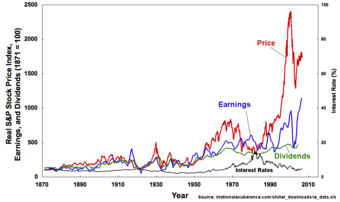
Real S&P Prices, Earnings, and Dividends 1871-2006
A graph visualizing S&P’s prices, earnings, and dividends over a 130-year period. Earnings and dividends have risen steadily over time; price spiked substantially around 2000 and is only slightly lower now.
Stock
Stock or scrip dividends are those paid out in the form of additional stock shares of the issuing corporation or another corporation, such as its subsidiary corporation. They are usually issued in proportion to shares owned. For example, for every 100 shares of stock owned, a 5% stock dividend will yield 5 extra shares. If the payment involves the issue of new shares, it is similar to a stock split: it increases the total number of shares while lowering the price of each share without changing the market capitalization, or total value, of the shares held.
Property
Property dividends or dividends in specie (Latin for “in kind”) are those paid out in the form of assets from the issuing corporation or another corporation, such as a subsidiary corporation. They are relatively rare and most frequently are securities of other companies owned by the issuer. However, they can take other forms, such as products and services.
Interim Dividends
Interim dividends are dividend payments made before a company’s annual general meeting and final financial statements. This declared dividend usually accompanies the company’s interim financial statements.
Other
Other dividends can be used in structured finance. Financial assets with a known market value can be distributed as dividends; warrants are sometimes distributed in this way. For large companies with subsidiaries, dividends can take the form of shares in a subsidiary company. A common technique for “spinning off” a company from its parent is to distribute shares in the new company to the old company’s shareholders. The new shares can then be traded independently.
15.4: Cash Dividend Alternatives
15.4.1: Stock Splits
A stock split increases the number of shares outstanding without changing the market value of the firm.
Learning Objective
Describe a stock split
Key Points
- A stock split is executed by offering several new shares in exchange for old ones. This may be a 3-for-1 split, for example: each share could be traded in for three new ones.
- A stock split does not change the market capitalization of the firm, it merely changes the number of shares outstanding. Therefore the price per share decreases as the number of shares outstanding increases.
- Each shareholder retains his or her same ownership stake because the number of share s/he holds changes in proportion to the change in the total number of shares outstanding.
Key Term
- market capitalization
-
The total market value of the equity in a publicly traded entity.
A stock split or stock divide increases the number of shares in a public company. Suppose a company has 1,000 shares outstanding. The company may want to increase this number to 2,000 shares without issuing new shares. They would split their stock 2-for-1. That means that every shareholder trades in one old share and gets two new shares in return.
The ownership stake for each shareholder remains constant because the number of shares held changes in proportion to the number of shares outstanding. They own the same percentage of the outstanding shares, though the nominal number of shares increases.
The price of the shares, however, changes. Since the market value of the company remains the same, the price of the new shares adjusts to reflect the new number of outstanding shares. For example, a company that has 100,000 shares outstanding that trade at $6 has a market capitalization of $600,000. After a 3-for-1 stock split the market capitalization of the company remains unchanged at $600,000, but there are not 300,000 shares trading at $2.
Lowering the price per share is attractive to some companies. Berkshire Hathaway Class A shares have never been split, so the price has followed the company’s growth over time . Since the price of a Class A share was over $121,000 on May 2, 2012, smaller investors may have chosen not to invest in Berkshire Hathaway Class A shares because of cash-flow or liquidity concerns. There are, however, Class B shares that trade at a lower value.

Berkshire Hathaway
Berkshire Hathaway has famously never had a stock split, and has never paid a dividend. As a result its Class A shares traded at $121,775.00 as of May 2, 2012, making them the highest-priced shares on the New York Stock Exchange.
15.4.2: Stock Dividends
Stock dividends are when a company gives each shareholder additional stock in lieu of a cash dividend.
Learning Objective
Create a journal entry to record a stock dividend and a stock split
Key Points
- Stock dividends are no different than stock splits in practice. They simply increase the number of shares outstanding, but not the market capitalization or the total value of the shareholders’ assets.
- Stock dividends may be paid from non-outstanding stock or from the stock of another company (e.g. its subsidiary).
- Cash dividends are taxed while stock dividends are not.
- The journal entry to record the stock dividend is a debit to the retained earnings account and credit both common stock and the paid in capital accounts.
Key Terms
- stock split
-
To issue a higher number of new shares to replace old shares. This effectively increases the number of shares outstanding without changing the market capitalization of the company.
- stock dividend
-
a payment to a shareholder paid out in the form of additional stock shares of the issuing corporation, or another corporation (such as its subsidiary corporation)
In lieu of cash, a company may choose to pay its dividend in the form of stock. Instead of each shareholder receiving, say $2 for each share, they may receive an additional share. A stock dividend (also known as a scrip dividend) can be the economic equivalent of a stock split.
When a stock dividend is paid, no shareholder actually increases the values of his or her assets. The total number of shares outstanding increases in proportion to the change in the number of shares held by each shareholder. If a 5% stock dividend is paid, the total number of shares outstanding increases by 5%, and each shareholder will receive 5 additional shares for each 100 held. As a result, each shareholder has the same ownership stake as before the stock dividend.
In addition, the value of the shares held does not change for each shareholder. As the number of shares outstanding increases, the price per share drops because the market capitalization does not change. Therefore, each shareholder will hold more shares, but each has a lower price so the total value of the shares remains unchanged.
The stock dividend is not, however, exactly the same as a stock split. A stock split is paid by switching out old shares for a greater number of new shares. The company is essentially converting to a new set of shares and asking each shareholder to trade in the old ones.
A stock dividend could be paid from shares not-outstanding. These are the company’s own shares that it holds: they are not circulating in the market, but were issued just the same. The company may have gotten these shares from share repurchases, or simply from them not being sold when issued.
Stock dividends may also be paid from non-outstanding stock or from the stock of another company (e.g. its subsidiary).
The company would record the stock dividend as a debit to the retained earnings account and credit both common stock and the paid in capital accounts.
An advantage of paying stock dividends instead of cash dividends to the shareholder is due to tax considerations. Cash dividends are taxed, while stock dividends are not . Of course, stock dividends don’t actually change the asset value of the shareholders so, in effect, nothing of substance has occurred.

Supreme Court Seal
The Eisner vs. Macomber case was a US Supreme Court Case that helped determine the differences in taxation of cash and stock dividends.
15.4.3: Reverse Splits
Reverse splits are when a company reduces the number of shares outstanding by offering a number of new shares for each old one.
Learning Objective
Define a reverse split
Key Points
- In a reverse stock split (also called a stock merge), the company issues a smaller number of new shares. New shares are typically issued in a simple ratio, e.g. 1 new share for 2 old shares, 3 for 4, etc.
- A reverse split boosts the share price, so there is a stigma attached. Some investors have rules against trading shares below a certain value, so a company in financial trouble may issue a reverse split to keep their share price above that threshold.
- A reverse stock split may be used to reduce the number of shareholders. If a company completes reverse split in which 1 new share is issued for every 100 old shares, any investor holding less than 100 shares would simply receive a cash payment.
Key Terms
- outstanding shares
-
Shares outstanding are all the shares of a corporation that have been authorized, issued and purchased by investors and are held by them.
- outstanding stock
-
all the stock of a corporation or financial asset that have been authorized, issued and purchased by investors and are held by them
By owning a share, the shareholder owns a percentage of the company whose share s/he owns. A share, however, does entitle the shareholder to a specific percentage ownership; the amount of the company that the shareholder owns is dependent of the number of shares owned and the number of shares outstanding. If Jim owns 10 shares of Oracle, and there are 1,000 shares outstanding, Jim effectively owns 1% of Oracle. If the number of shares outstanding were to double to 2,000, Jim’s 10 shares would now correspond to a 0.5% ownership stake. In order for Jim’s ownership stake to remain constant, the number of shares he holds must change in proportion to change in outstanding shares: he must own 20 shares if there are 2,000 shares outstanding.
That is the premise behind a reverse stock split. In a reverse stock split (also called a stock merge), the company issues a smaller number of new shares. New shares are typically issued in a simple ratio, e.g. 1 new share for 2 old shares, 3 for 4, etc.
The reduction in the number of issued shares is accompanied by a proportional increase in the share price. A company with a market capitalization of $1,000,000 from 1,000,000 shares trading at $1 chooses to reduce the number of outstanding shares to 500,000 through a reverse split. This leads to a corresponding rise in the stock price to $2.
There is a stigma attached to doing a reverse stock split, so it is not initiated without very good reason and may take a shareholder or board meeting for consent. Many institutional investors and mutual funds, for example, have rules against purchasing a stock whose price is below some minimum. In an extreme case, a company whose share price has dropped so low that it is in danger of being delisted from its stock exchange, might use a reverse stock split to increase its share price. For these reasons, a reverse stock split is often an indication that a company is in financial trouble.
A reverse stock split may be used to reduce the number of shareholders. If a company completes reverse split in which 1 new share is issued for every 100 old shares, any investor holding less than 100 shares would simply receive a cash payment. If the number of shareholders drops, the company may be placed into a different regulatory categories and may be governed by different laws .

SEC
The Securities and Exchange Commission is the department that sets the different regulations regarding stock trading and splitting.
15.4.4: Repurchasing Shares
A share repurchase is when a company buys its own stock from public shareholders, thus reducing the number of shares outstanding.
Learning Objective
Describe the different ways a company may repurchase its stock
Key Points
- Since the market capitalization is unchanged and the number of shares outstanding drops, a share repurchase will lead to a corresponding increase in stock price.
- The reduction of the shares outstanding means that even if profits remain the same, the earnings per share increase.
- There are a number of methods for repurchasing shares, the most popular of which is open-market: the company buys back shares at the market dictated price if the price is favorable.
Key Term
- Repurchase
-
To buy back a company’s own shares. The issuing company pays public shareholder for their shares.
An alternative to cash dividends is share repurchases. In a share repurchase, the issuing company purchases its own publicly traded shares, thus reducing the number of shares outstanding. The company then can either retire the shares, or hold them as treasury stock (non-circulating, but available for re-issuance).
When a company repurchases its own shares, it reduces the number of shares held by the public. The reduction of the shares outstanding means that even if profits remain the same, the earnings per share increase. Repurchasing shares when a company’s share price is undervalued benefits non-selling shareholders and extracts value from shareholders who sell.
Repurchasing shares will lead to a corresponding increase in price of the shares still outstanding. The market capitalization of the company is unchanged, meaning that a reduction in the number of shares outstanding must be accompanied by an increase in stock price.
There are six primary repurchasing methods:
- Open Market: The firm buys its stock on the open market from shareholders when the price is favorable. This method is used for almost 75% of all repurchases.
- Selective Buy-Backs: The firm makes repurchase offers privately to some shareholders.
- Repurchase Put Rights: Put rights are the right of the seller to purchase at a certain price, set ahead of time. If the company has put rights on its shares, it may use them to repurchase shares at that price.
- Fixed Price Tender Offer: The firm announces a number of shares it is looking for and a fixed price they are willing to pay. Shareholders decide whether or not to sell their shares to the company.
- Dutch Auction Self-Tender Repurchase: The company announces a range of prices at which they are willing to repurchase. Shareholder voluntarily state the price at which they individually are willing to sell. The company then constructs the supply-curve, and then announces the purchase price. The company repurchases shares from all shareholders who stated a price at or below that repurchase price .
- Employee Share Scheme Buy-Back: The company repurchases shares held by or for employees or salaried directors of the company.
15.4.5: Benefits of Repurchasing Shares
Share repurchases are beneficial when the stock is undervalued, management needs to meet a financial metric, or there is a takeover threat.
Learning Objective
Discuss the benefits of a company repurchasing its shares
Key Points
- If management feels the company is undervalued, they will repurchase the stock, and then resell it once the price of the shares increases to reflect the accurate value of the firm.
- A member of management may have to meet earnings per share (EPS) metrics which can be increased by increasing earnings or lowering the number of outstanding shares. Share repurchases decrease the number of outstanding shares, and thus increase EPS.
- To prevent a firm from acquiring enough of a company’s stock to take it over, the takeover target may buy back shares, often at a price above market value.
Key Terms
- Earnings Per Share
-
EPS. (Net Income – Dividends on Preferred Stock) / Outstanding Shares
- hostile takeover
-
An attempted takeover of a company that is strongly resisted by the target company’s management.
A company may seek to repurchase some of its outstanding shares for a number of reasons. The company may feel that the shares are undervalued, an executive’s compensation may be tied to earnings per share targets, or it may need to prevent a hostile takeover.
For shareholders, the primary benefit is that those who do not sell their shares now have a higher percent ownership of the company’s shares and a higher price per share. Those who do choose to sell have done so at a price they are willing to sell at – unless there was a ‘put’ clause, in which case they had to sell because of the structure of the share, something they would have already known when they bought the shares.
Undervaluation
Repurchasing shares may also be a signal that the manager feels that the company’s shares are undervalued. In this event, it will choose to repurchase shares, and then resell them in the open market once the price increases to accurately reflect the value of the company.
Executive Compensation
In some instances, executive compensation may be tied to meeting certain earnings per share (EPS) metrics. If management needs to boost the EPS of the company to meet the metric, s/he has two choices: raise earnings or reduce the number of shares. If earnings cannot be increased, there are a number of ways to artificially boost earnings (called earnings management), but s/he can also reduce the number of shares by repurchasing shares . Strictly speaking, this is a benefit to the management and executives, not the company or the shareholders. -Thwart.

Marc Benioff
CEOs, like Marc Benioff of Salesforce.com, may have to meet certain financial targets in order to earn his or her bonus. If one of these targets is EPS, they may have an incentive to try to increase EPS artificially.
Hostile Takeovers
A company can take over another firm if it holds enough of the other takeover target’s shares (the buyer of the shares is called the bidder, and the company it is trying to buy is called the takeover target). The bidder is buying the takeover target’s shares in an attempt to purchase enough to own it. Assuming the firm does not want to be taken over this way, the takeover attempt is called hostile. In order to prevent this from happening, the takeover target needs to prevent the bidder from purchasing enough of the shares. To do this, the takeover target will repurchase its own shares from the unfriendly bidder, usually at a price well above market value. Furthermore, it can prevent future takeover attempts. Companies with a lot of cash on their balance sheets are more attractive takeover targets because the cash can be used to pay down the debt incurred to carry out the acquisition. Share repurchases are one way of lowering the amount of cash on the balance sheet.
15.4.6: Drawbacks of Repurchasing Shares
Share repurchases often give an advantage to insiders and can be used to manipulate financial metrics.
Learning Objective
Discuss the drawbacks of a share repurchase
Key Points
- Insiders are more likely to know if a firm is undervalued, and are therefore more likely to know whether they should sell their shares in an open-market repurchase.
- Financial ratios that use the number of shares outstanding change when shares are repurchased. Executives and management whose compensation is tied to these metrics have an incentive to manipulate them through share repurchases.
- Share repurchases are often not completed. It is tough to value the effect of a share repurchase announcement because it is unknown whether it will occur in full.
Key Terms
- Earnings Per Share
-
The amount of earnings per each outstanding share of a company’s stock.
- insider
-
A person who has special knowledge about the inner workings of a group, organization, or institution.
There are a number of drawbacks to share repurchases. Both shareholders and the companies that are repurchasing the shares can be negatively affected.
Shares may be repurchased if the management of the company feels that the company’s stock is undervalued in the market. It repurchases the shares with the intention of selling them once the market price of the shares increase to accurately reflect their true value. Not every shareholder, however, has a fair shot at knowing whether the repurchase price is fair. The repurchasing of the shares benefits the non-selling shareholders and extracts value from shareholders who sell. This gives insiders an advantage because they are more likely to know whether they should sell their shares to the company .

Martha Stewart
Martha Stewart was convicted of insider trading, which is not the same as insiders choosing whether to sell their shares in a share repurchase. Insiders are still at an advantage because they will know not to sell during the share repurchase.
Furthermore, share repurchases can be used to manipulate financial metrics. All financial ratios that include the number of shares outstanding (notably earnings per share, or EPS) will be affected by share repurchases. Since compensation may be tied to reaching a high enough EPS number, there is an incentive for executives and management to try to boost EPS by repurchasing shares. Inaccurate EPS numbers are not good for investors because they imply a degree of financial health that may not exist.
From the investor’s standpoint, one drawback of share repurchases is that it’s hard to judge how it will affect the valuation of the company. Companies often announce repurchases and then fail to complete them, but repurchase completion rates increased after companies were forced to retroactively disclose their repurchase activity. It is difficult for shareholders, especially relatively uninformed ones, to judge how the announcement will affect the value of their holdings if there is no guarantee that the full announced repurchase will occur.
15.4.7: Dividend Reinvestments
Dividend reinvestment plans (DRIPs) automatically reinvest cash dividends in the stock.
Learning Objective
Describe a dividend reinvestment plan
Key Points
- DRIPs help shareholders reinvest their dividends in the underlying stock without having to wait for enough money to buy a whole number of shares. It also may allow them to avoid some brokerage fees.
- DRIPs help stabilize stock prices by inherently encouraging long-term investment instead of active-management, which may cause volatility.
- DRIPs are generally associated with programs offered by the company. However, brokerage firms may offer similar reinvestment programs called “synthetic DRIPs”.
Key Term
- reinvest
-
To invest cash again, instead of holding it as cash.
In some instances, a company may offer its shareholders an alternative option to receiving cash dividends. The shareholder chooses to not receive dividends directly as cash; instead, the shareholder’s dividends are directly reinvested in the underlying equity. This is called a dividend reinvestment program or dividend reinvestment plan (DRIP).
The purpose of the DRIP is to allow the shareholder to immediately reinvest his or her dividends in the company. Should the shareholder choose to do this on his or her own, s/he would have to wait until enough cash accumulates to buy a whole number of shares and s/he would also incur brokerage fees .

Charles Schwab
Brokerage firms like Charles Schwab earn money by charging a brokerage fee for executing transactions. Thus, participating in a DRIP helps shareholders avoid some or all of the fees they would occur if they reinvested the dividends themselves.
Participating in a DRIP, however, does not mean that the reinvestment of the dividends is free for the shareholder. Some DRIPs are free of charge for participants, while others do charge fees and/or proportional commissions.
DRIPs have become popular means of investment for a wide variety of investors as DRIPs enable them to take advantage of dollar-cost averaging with income in the form of corporate dividends that the company is paying out. Not only is the investor guaranteed the return of whatever the dividend yield is, but s/he may also earn whatever the stock appreciates to during his or her time of ownership. However, s/he is also subject to whatever the stock may decline to, as well.
There is an advantage to the the company managing the DRIP, too. DRIPS inherently encourage long-term investment in the shares, which helps to mitigate some of the volatility associated with active-trading. DRIPs help to stabilize the stock price.
The name “DRIP” is generally associated with programs run by the dividend-paying company. However, some brokerage firms also offer similar plans where shareholders can choose to have their cash dividends reinvested in stocks for little or no cost. This is called a synthetic DRIP.
Chapter 14: Obtaining Capital: Methods of Long-Term Financing
14.1: Types of Financing
14.1.1: Financing Life Cycle of the Firm
Firms progress through four stages of a developmental life cycle, each with their own funding needs.
Learning Objective
Identify which type of finance is appropriate for a business based on its stage of development
Key Points
- In the first stage, a new company’s external financing needs (EFN) are high, since it needs money to develop its idea but lacks retained earnings. They are usually financed through debt, but may find investors who are willing to take on risk if projected growth is high.
- In the growth stage, a firm’s initial EFN is high relative to its current value; it needs significant funds for growth. It can be financed through venture capital or issuing equity.
- Growth eventually slows and the firm enters the mature stage. These firms can be financed by equity or debt. If they have no new projects, EFN is relatively low.
- The firm may go into decline as their product becomes obsolete or a competitor outperforms them. In this case, they have very low external financing needs.
Key Terms
- venture capital
-
Money invested in an innovative enterprise in which both the potential for profit and the risk of loss are considerable.
- external financing needs
-
Additional funds needed from sources outside the firm, in order to support firm operations.
- debt
-
Money that the borrowing entity owes or is required to pay to a lender.
Most businesses pass through a series of well defined stages based on their level of development. Churchill and Lewis (1983) identified that all businesses vary greatly in size and potentiality for growth. However, they all experience common problems that arise at similar stages of their development.
From these observations came the four stage life cycle of the firm. Methods of obtaining financial capital may be more or less suitable for a firm, depending on the current stage of its life cycle .
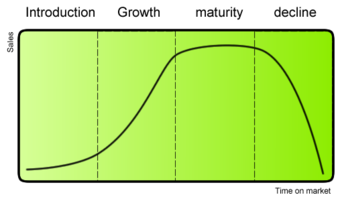
Firm Life Cycle
Firms progress through stages of development, indicated by their changing profits over time.
Introduction
In the first stage, a new company begins with the seed of an idea. Its external financing needs (EFN) are high, since it needs money to develop but lacks retained earnings. These young firms are frequently financed through debt, acquiring loans from banks and acquaintances. They may also acquire seed money, a form of securities offering in which an investor (usually friends, family, or angel investors) purchases part of a business. The source of the financing may depend on the perceived riskiness and growth of the business.
Growth
After the firm is able to acquire external funding and develop its product/service, it enters the growth phase. Once a company has a successful strategy, it attempts to offer its products or services to potential customers–expanding first to other states and regions and then often internationally and globally. Successful companies can turn in increasing earnings year after year, evidenced by the increasingly steep slope in the diagram. Firms may face an increase in competitors. In the growth stage, a firm’s initial EFN is high relative to its current value; it needs significant funds for growth. If it fits the specifications for venture capital (high growth potential, innovative product) a VC firm may agree to finance the firm. It may also raise capital through equity financing. As it progresses through the growth stage, earnings begin to increase less rapidly. At some point, the company may decide to go public, offering its stock to the general public on a security exchange as a means of equity financing.
Maturity
Eventually, all possible customers have the product or service. They may still buy parts or replace their product with newer models, etc, but growth slows. This is the mature stage of a company’s development. If the firm has no new projects in the works, their EFN is quite low and internal funding is high. In fact, the firm may have so much in retained earnings that they cannot put all of it to productive use. They can choose to finance operations by issuing bonds and equity.
Decline
When the firm has reached the final stage, sales can stagnate or decline due to replacement by a better product or competitor. EFN declines further. They may choose to retire debt or repurchase stock, as significant external financing is no longer necessary.
14.1.2: Venture Capital
Venture capital is an equity investment in a new company.
Learning Objective
Differentiate between the different stages of funding
Key Points
- Young companies with high growth potential turn to venture capitalists for funding because they cannot issue debt or raise capital in public markets.
- Venture capitalists assume high risk by investing in small, unproven companies, rationalizing that successful investments will have so much growth that their returns will far exceed any failed investments.
- By agreeing to fund a start-up company, the VC firm gets the potentials of high future returns, significant control over company decisions, and a portion of the company’s ownership.
- Because a VC firm’s returns are contingent on the company’s performance, it is in their interest to take an active role in company decision-making.
- A company receiving venture capital goes through several rounds of funding, roughly corresponding to stages of company development.
Key Terms
- IPO
-
An initial public offering (IPO) or stock market launch is a type of public offering where shares of stock in a company are sold to the general public for the first time. Through this process, a private company transforms into a public company.
- venture capital
-
Money invested in an innovative enterprise in which both the potential for profit and the risk of loss are considerable.
What is Venture Capital
Venture capital (abbreviated as VC) is an attractive funding option for young companies with high growth potential, most often in high technology industries. These new companies are unable to raise funds in more conventional ways like bank loans. Investors assume high risk of loss in exchange for high potential of future growth, significant control over company decisions, and a portion of the company’s ownership.
How to Obtain Venture Capital
Obtaining venture capital is different from raising debt or a loan from a lender. Lenders have a legal right to interest on a loan and repayment of the capital, irrespective of the success or failure of a business. In contrast, the venture capitalist’s return is dependent on the growth and profitability of the business. Return is earned when the venture capitalist sells its shareholdings. This happens when the business goes public, issues shares to the general public through an Initial Public Offering (IPO), or is acquired by a third party company.
It is also in the venture capitalist’s interest to nurture the companies in which they invest. This increases the likelihood of reaching an IPO stage when valuations give high returns. Therefore, in addition to the initial financial funding, VC firms provide time, expertise and valuable business connections. As these investments are illiquid and require 3-7 years to reap full benefit, venture capitalists carry out due diligence, conducting very detailed investigations into the firms prior to investment. This process includes examining the firm’s financial records and all aspects of its operations. Most venture capitalists will also require significant detail about a company’s business plan. Venture investors may obtain special privileges that are not granted to holders of common stock, including:
- Anti-dilution protection
- Guaranteed seats on the company’s board.
- Positive and negative covenants that the company must abide by
- Registration right, defined as the special rights to demand registration of their stock on public exchanges, and to participate in an IPO
- Representations and warranties.These are statements in which the company gives certain assurances to the VC firm as to the operations and financial condition of the company
- Liquidation preferences – in any liquidation event, the VC investors get their money back, often with interest before common stock is paid any funds from liquidation.
Initially, VC firms establish a fund which pools money raised from individuals, companies and other interested parties. This pooled investment vehicle is then used for investment in start-up enterprises.
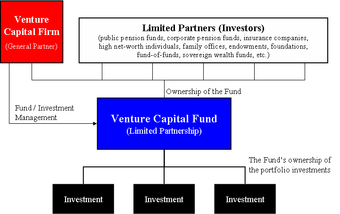
Structure of a Venture Capital Firm
The venture capital firm pools capital from investors and allocates it to venture efforts deemed worthy of investment.
Stages of Funding
Through informal and formal business networks, VC firms and entrepreneurs will meet to discuss the business plan and investment possibilities.There are different rounds of financing corresponding to different stages of a company’s development:
- Seed money round: The entrepreneur must convince the venture capitalist to fund their business vision. The VC firm is looking for a number of qualities including a solid business plan, an effective management team, high growth potential, and high target minimum returns. The VC firm will investigate into the technical and economic feasibility of the venture’s idea. If it is not directly feasible, but the investor sees potential, the investor will choose to invest some seed money for further investigation.
- Start-up: VC firms provide capital to early stage firms that need funding for marketing and product development. Organization of the company is formed, with finalization of the management team and establishment of an individual from the VC firm on the company’s board. The prototype product/idea is developed and tested. Market research for the idea is conducted, and the VC firm also monitors product feasibility and capability of the management. If at this stage the VC firm is not satisfied with the progress from market research, the VC firm may stop their funding and the venture will have to search for other sources of funding.
- Second-Round: Early-stage companies that are selling product but not yet turning a profit receive working capital.
- Expansion/Mezzanine financing: As the name suggests, VC firms provide expansion money for a newly profitable company.
- Bridge financing/exit of venture capitalist : Finally, the company is expected to either “go public” or be bought by a third-party company. The VC firm then exits by selling off its shareholdings of the company. The investor’s risk of losing the investment decreases as the company advances from one round to the next of this process.
14.1.3: Long-Term Debt
Long-term debt is a means of financing that allows firms access to capital without diluting equity; capital & interest is paid off over time.
Learning Objective
Discuss how long-term debt is used by companies
Key Points
- Debt financing takes the form of loans that must be repaid by the borrower over a specified period of time, usually with interest.
- Generally, debt financing is most appropriate for firms who are in the start-up phase or have progressed to the maturity phase. For young companies, debt financing usually takes the form of bank loans, while mature companies may issue bonds.
- When investors buy a corporate bond or the bank loans to a small business, they must have faith that the company will have the means to repay them. Riskier investments will require compensation for the lender in the form of higher interest rates.
- Bonds may be an attractive alternative to getting bank loans or issuing stock because it can have less restrictive loan terms and better interest rates than loans, and it doesn’t dilute equity or ownership as stock does. It also has considerable corporate tax advantages.
- Costs of debt financing include: bankruptcy costs (in the event of inability to cover payments to lenders) and increased uncertainty about future financing needs.
Key Terms
- bond
-
A documentary obligation to pay a sum or to perform a contract; a debenture.
- debt
-
Money that the borrowing entity owes or is required to pay to a lender.
Overview
In the most basic terms, debt financing takes the form of short-term or long-term loans that must be repaid over a specified period of time, usually with interest. Money is borrowed, and usually the borrower (debtor) gives the lender (creditor) a promissory note that obligates the debtor to pay back a certain defined amount at a particular and defined time in the future .

Bank loans as a means of financing
A promissory note dating to 1926 from the Imperial Bank of India, Rangoon, Burma for 20,000 Rupees, plus interest.
With debt financing, the creditor’s return is fixed as the agreed upon interest rate for the debt, which varies depending on the perceived riskiness of the debtor. Debt financing usually takes the form of bank loans or bonds.
Bonds
Bonds are a debt security under which the issuer owes the holders a debt. Depending on the terms of the bond, the bond issuer is obliged to pay the bondholders interest and/or to repay the principal (also known as nominal, par or face amount). Most corporate bonds are fixed-rate bonds, meaning that the interest rate stays the same until maturity. Some use floating rates to determine the exact interest rate paid to bond holders. The interest rate paid on these varies depending on some index, such as LIBOR. Other corporate bonds, called zero-coupons, make no regular interest payments at all, but investors still receive returns because these bonds are originally sold at a discount, and then are redeemed at par value upon maturity.
Interest Rate
The interest that the firm will pay ultimately comes down to one factor: at what rate will investors believe the bonds are a good investment? Riskier investments will require compensation for the lender in the form of higher interest rates. Indicators for riskiness can include individual credit histories (for a bank loan) or bond rating by a credit rating company (for corporate bonds). The difference in yield reflects the higher probability of default and liquidity and risk premium.
Capital Structure Theory
The actual effect of the firm’s capital structure on firm value is a contested topic in financial theory (see Miller Modigliani Theorem). From a tax perspective, debt financing may have some advantages over equity financing for both investors and the firm. Under a majority of taxation systems around the world, firms are subject to corporate tax and individuals to income tax, leading to double taxation of dividends, if the firm is financed through issuing stock.
For example, a firm that earns 100 dollars in profits in the U.S. would have to pay around 30 dollars in taxes. If it then distributes these profits to its owners as dividends, then the owners in turn pay taxes on this income, say 20 on the 70 dollars of dividends. The 100 dollars of profits turned into 50 dollars of investor income.
If, instead the firm finances with debt, then, assuming the firm owes 100 dollars of interest to investors, its profits are now 0. Investors now pay taxes on their interest income, say 30 dollars. This implies for 100 dollars of profits before taxes, investors got 70 dollars. The firm also benefits considerably, as interest payments can be deducted from the firm’s taxable income while dividends and share repurchases cannot be deducted.
It is also postulated that debt makes management more disciplined, forcing them to work harder to ensure that they will make enough to cover their interest payments. These benefits are applicable to both bonds and bank loans. However, costs of debt can outweigh these benefits, depending on the firm. In the event of inability to repay debts, firms go into bankruptcy which is a costly process in itself. Furthermore, the more debt a firm takes on, the more uncertainty it will have about future financing needs: if a firm is already taking on a considerable amount of debt today, where will it get financing for its operations in the future?
14.1.4: Common and Preferred Stock
Firms may raise capital by receiving funds from investors in exchange for equity stakes in the form of common and preferred stock.
Learning Objective
Differentiate the different types of preferred stock
Key Points
- Firms using equity financing gain financial capital from investors, in exchange for ownership stakes in the firm in the form of common and preferred stocks.
- The main advantage of equity financing is the lack of an obligation to pay back all investors in the event of poor company performance, while the main disadvantage is diminished control and business autonomy.
- In the event of liquidation and dividend payments, preferred stock has priority claims to assets. Common stockholders must wait until all preferred stockholders have been paid in full.
- In the event of bankruptcy, common stock investors receive any remaining funds after bondholders, creditors (including employees), and preferred stock holders are paid.
- Common stockholders often have voting rights, exercising some measure of control over company board elections and corporate policy, while preferred stockholders usually lack these rights.
- Preferred stock is divided into a number of sub-categories including: cumulative preferred stock, non-cumulative preferred stock, participating preferred stock, and convertible preferred stock.
Key Terms
- Preferred Stock
-
Stock with a dividend, usually fixed, that is paid out of profits before any dividend can be paid on common stock. It also has priority to common stock in liquidation.
- Common stock
-
Shares of an ownership interest in the equity of a corporation or other entity with limited liability. Holders of this type of stock are entitled to dividends. Importantly, the financial rights for holders of this type of stock are junior to preferred stock and liabilities.
Example
- If a company’s stock currently sells for 40 a share, expects to pay a dividend of 2 next year, is subject to flotation costs of 10%, and expects to maintain a growth rate of 10%, the cost of newly issued common stock = 2/[40(1-.10)] + .1 = 14.5%
Introduction: Equity Financing
Equity financing occurs when ownership stakes in a particular firm are exchanged for financial capital from investors. These investors may be all types of people, from friends and family of the business, to wealthy, “angel” investors, to venture capitalists. The main advantage of equity financing is that the business is not obligated to repay anything, since the individual investors are assuming a certain amount of risk in return for the possibility of making money in the future. However, because equity financing involves trading funds for ownership in the company, these new investors do gain some decision-making power in the company, and the managers lose some autonomy.
Common Stock and Preferred Stock
Typically, firms obtain their long-term sources of equity financing by issuing common and preferred stock. Holders of common stock (also be known as a “voting share” or an “ordinary share”) often have voting rights on corporate policy and have a say in electing the firm’s Board of Directors. They also receive dividend payments if the firm offers them. That being said, in the event of liquidation, preferred stock is considered more senior than common stock, in terms of rights awarded to particular investors. If one investor has preferred stock, while another holds common stock, that first individual has more rights to their share of assets, in the event of a liquidation. After bondholders, creditors (including employees), and preferred stock holders are paid their full share, common stock investors receive any funds that still remain. Thus, it is clear that common stock investors have the riskiest investment, often receiving nothing in the event of a bankruptcy.
Preferred stock is considered to be a form of equity security. It has properties of both an equity and a debt instrument, making it a “hybrid instrument”. Preferred stock generally has preference in receiving dividend payments and always has preference in asset claims during liquidation. That being said, holders of this type of stock usually do not have voting rights, while common stock holders do. Almost all preferred shares have a negotiated, fixed-dividend amount. The dividend is usually specified as a percentage of the par value, or as a fixed amount (for example, Pacific Gas & Electric 6% Series A Preferred). Sometimes, dividends on preferred shares may be negotiated as floating. This means that they may change according to a benchmark interest-rate index (such as LIBOR).
Types of Preferred Stock
In general, there are four different types of preferred stock: cumulative preferred stock, non-cumulative preferred stock, participating preferred stock, and convertible preferred stock. With cumulative preferred stock, If the dividend is not paid, it will accumulate for future payment. With non-cumulative preferred stock, dividends will not accumulate if they are unpaid. In other words, holders of this type of stock cannot make claims to forgone, past dividends. Convertible preferred stock are preferred issues which holders can exchange for a predetermined number of the company’s common-stock shares. This exchange may occur at any time the investor chooses, regardless of the market price of the common stock. It is a one-way deal, and an individual cannot convert the common stock back to preferred stock, if they have already exchanged their preferred stock with the company. The final type, participating preferred stock, are preferred issues that offer holders a set, specified dividend. These also offer investors the the opportunity to receive extra dividends if the company achieves predetermined financial goals. In the event of liquidation, holders of this last type of preferred stock are entitled to receive back the total amount they invested in the company, as well as the accumulated unpaid dividends, before any common stock holders are paid.
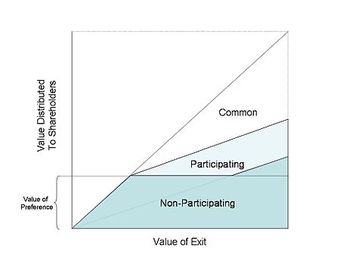
Participating Preferred vs. Non-Participating Preferred
This graph shows an example of a liquidation event, illustrating how assets will be divided up between common, participating preferred, and non-participating preferred stock holders. All preferred stockholders are paid first, before common stock holders. Participating preferred stockholders can “double dip”, and are entitled to both their money back, as well as the leftovers for common stock, proportionate to the amount of common stock for which their preferred stock can be converted into.
There are capital costs associated with equity financing, including accounting and legal costs, as well as underwriting and filing fees. For new issues of stocks, there are flotation costs that must be taken into consideration before choosing equity as a method of long-term financing. These can be established with the following formulas. Cost of preferred stock = Next dividend to be paid/[Current market value(1-flotation costs)]Cost of newly issued common stock = Next dividend to be paid/Current market value(1-flotation cost) + projected growth rate.
14.2: Venture Capital
14.2.1: Defining Venture Capital
Early-stage business ventures gain funding and guidance from venture capitalists in exchange for an equity stake in the firm.
Learning Objective
Describe how the venture capital process works
Key Points
- Venture capital is the financial capital provided to early-stage high-potential start-ups unable to acquire the necessary funding through conventional means.
- For venture capitalists, the high risk of investing is offset by the potential of high returns.
- Venture capitalists typically spread out their fund over a number of investments so that returns from successful investments will outweigh the losses from failed ventures.
- Venture capitalists take an active role in a company’s performance; guidance, expertise, and industry connections can be just as valuable as financial capital.
Key Terms
- Initial public offering
-
An initial public offering (IPO) or stock market launch is a type of public offering where shares of stock in a company are sold to the general public.
- venture capital
-
Money invested in an innovative enterprise in which both the potential for profit and the risk of loss are considerable.
Venture capital is a method of financing a business start-up in exchange for an equity stake in the firm. The risk of investment loss and the potential for future payout are both very high. As a shareholder, the venture capitalist’s return is dependent on the growth and profitability of the business. Return is earned when the business is sold to another owner or it “goes public” with an initial public offering (IPO). The venture capitalist can then “exit” by selling his shareholdings in the company.

Venture capital funds revolutionary social networking services
Facebook is one example of a entrepreneurial idea that benefited from venture capital financing. The Menlo Park-based firm has seen immense success since their launch in 2004. Unfortunately for Facebook’s venture capitalist investors (Accel Partners, Greylock Partners and Meritech Capital), the IPO has not performed as well as expected.
Due to their risky nature, most venture capital investments are done with pooled investment vehicles. Investors combine their financial contributions into one fund, which is then used to invest in a number of companies. This way, investors are diversifying their portfolio and spreading out risk. Venture capitalists are gambling that returns from successful investments will outweigh investments lost in failed ventures. Venture capitalists are selective in their investments. Innovative technology, growth potential and a well-developed business model are among the qualities they look for. Growth potential is the most important quality, given the high risk a VC firm assumes by investing. The priority for VC firms is high financial return and a successful exit within three to seven years.Venture funding is most suitable for businesses having large up-front capital requirements that cannot be financed by debt or other alternatives. These characteristics usually best fit companies in high-tech industries, which explains the venture capital boom of the late 1990s. The technology firms of Silicon Valley and Menlo Park were primarily funded by venture capital. These industries saw a surge in public interest that eventually generated large returns for VC firms.
A VC firm’s contributions often extend beyond financial funding. To increase the likelihood of high returns, it is in the venture capitalists’ interests to nurture their investments. Any guidance and expertise venture capitalists offer to start-up firms can be instrumental to success.
14.2.2: Advantages and Disadvantages of VC Financing
While VC financing provides the benefit of significant resources, costs include loss of ownership and autonomy.
Learning Objective
Discuss the advantages and disadvantages of using venture capital
Key Points
- With VC financing, companies can acquire large sums of capital that would not be possible through bank loans or other conventional methods.
- Venture capitalists provide expertise and industry connections that can be extremely valuable.
- Accounting and legal costs make securing a VC deal a difficult process. If a deal is secured, VC investors will be highly involved in deciding on the company’s strategic direction.
Key Term
- venture capital
-
Money invested in an innovative enterprise in which both the potential for profit and the risk of loss are considerable.

Weighing advantages and disadvantages
Pursuing venture capital financing may not be appropriate for most start-up companies. It is important to weigh the benefits of receiving abundant resources against the costs of losing autonomy and ownership.
Advantages: The primary advantage of venture capital financing is an ability for company expansion that would not be possible through bank loans or other methods. This is essential for start-ups with limited operating histories and high upfront costs. In addition, repayment of VC investors isn’t necessarily an obligation like it would be for a bank loan. Rather, investors are shouldering the investment risk because they believe in the company’s future success.
In addition to financial capital, venture capitalists provide valuable expertise, advice and industry connections. A stipulation of many VC deals includes appointing a venture capitalist as a member of the company’s board. This way, the VC firm has intimate involvement in the direction of the company.
Venture capital is also associated with job creation (accounting for 2% of US GDP), the knowledge economy, and used as a proxy measure of innovation within an economic sector or geography.
Disadvantages: Securing a VC deal can be a difficult process due to accounting and legal costs a firm must shoulder. The start-up company must also give up some ownership stake to the VC company investing in it. This results in a partial loss of autonomy that finds venture capitalists involved in decision-making processes. VC deals also come with stipulations and restrictions in composition of the start-up’s management team, employee salary and other factors. Furthermore, with the VC firm literally invested in the company’s success, all business operations will be under constant scrutiny. The loss of control varies depending on the terms of the VC deal.
14.2.3: IPOs
Initial public offerings are a primary and potentially lucrative means of exit from investment for venture capitalists.
Learning Objective
Describe the benefits and disadvantages of an IPO
Key Points
- An initial public offering is the first time a company’s stock is sold to the general public on a securities exchange, transforming the company from private to public. Though unpredictable and potentially costly, IPOs give benefits like increased access to financial markets and more capital.
- Venture capitalists gain both financial returns and professional reputation from successful IPOs.
- For venture-backed companies, their VC investors often expect the company to go public within a certain time frame so that they can sell or distribute their holdings of the company and exit the investment.
- Venture capitalists protect their ability to sell shares by contracting for registration rights prior to agreeing on funding the company. Demand rights allow the investors to initiate an IPO, while piggyback rights allow investors to sell when the company initiates an IPO.
- If the IPO market is weak, this threatens the venture capitalists’ chances of a successful exit. The VC investors may instead select a different method of exit, or they can wait and hope for the market to improve.
Key Terms
- Registration rights
-
A contractual agreement specifying conditions for registering shares of stock with the SEC prior to selling them on a security exchange.
- Initial public offering
-
An initial public offering (IPO) or stock market launch is a type of public offering where shares of stock in a company are sold to the general public.
Example
- For a recent example of a weak IPO market, we can look to online companies like Facebook and Zynga. Facebook’s IPO launch in May 2012 was highly anticipated but ended up under-performing, losing 47% of its original offering price as of August 2012. The online game developer Zynga’s IPO similarly fell flat despite high expectations. Falling values can put pressure on the VC investors to sell before they can lose any more of their returns.
An initial public offering (IPO), also known as a stock market launch, is the first time a private company’s shares are sold to the general public on a securities exchange. Allowing the general public to take up equity stakes in the company transforms it from being privately traded to publicly traded. If the company was venture-backed, the VC firms often gain their returns from IPO yields. Usually, the VC exits investments within a short time (1-3 years, normally) after the IPO is concluded either by distributing the shares to VC fund investors or selling them off on the market. Going public can also have benefits for the company, including:
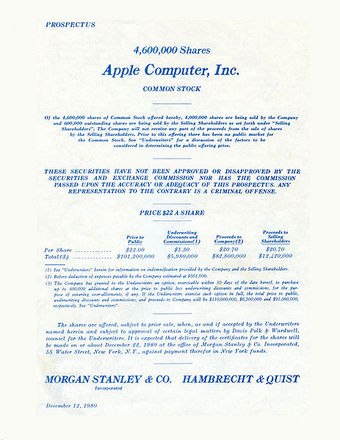
Apple Computers IPO Prospectus
The Initial Public Offering (IPO) Prospectus for Apple Computer Inc. in December 1980. A total of 5 million shares were offered to the public for $22 each. The total outstanding shares after the offering were 54,215,332. The company’s officers, directors and major shareholders held 32 million shares and the rest were held by the company for stock options plans and other needs. Apple’s valuation after the IPO was over $1 billion. (54 million shares at $22. )
- Increasing exposure, prestige, and public image
- Enlarging and diversifying equity base
- Enabling cheaper access to capital, which is particularly important for high growth companies
- Allowing owners of the company to cash in on their efforts in a very lucrative way (if the IPO is successful).
- Attracting and retaining better management and employees through liquid equity participation
IPOs are not without cost to the company. Disadvantages to completing an initial public offering, include:
- Legal, accounting and marketing costs associated with the process
- Requirement to disclose financial and business information
- Meaningful time, effort and attention required of senior management
- Risk that required funding will not be raised
- Public dissemination of information which may be useful to competitors, suppliers and customers.
Prior to agreeing to provide capital, venture capitalists contract for privileges including “registration rights”, which ensure their ability to sell shares into the public capital markets, thereby safeguarding their future returns. Prior to selling shares on the stock exchange, companies must register these shares with the Securities and Exchange Commission. The registration rights agreement between the company and the venture capitalists requires the company to register the offering of shares by venture capitalists under certain conditions.
These conditions may be in the form of “demand rights” or “piggyback rights”.
- Demand rights require the company itself to prepare, file and maintain a registration statement on behalf of the investors’ shares, so that investors can actually initiate a public offering and sell their shares.
- Piggyback rights require that the VC investors’ shareholdings are included in a company-initiated registration, so that the investors can sell their shares when the company initiates a public offering. The number of each type of demand or piggyback rights, the percentage of investors necessary to exercise these rights, allocation of expenses of registration, the minimum size of the offering, the scope of indemnification and the selection of underwriters and brokers are all areas of potential negotiation in the registration rights agreement.
14.3: Leasing
14.3.1: Capital Leases vs. Operating Leases
Capital leases and operating leases are two types of leases with different criteria.
Learning Objective
Distinguish between a capital and an operating lease
Key Points
- The finance company is the legal owner of the asset during duration of the lease. However the lessee has control over the asset providing them the benefits and risks of (economic) ownership.
- An operating lease is a lease whose term is short compared to the useful life of the asset or piece of equipment (an airliner, a ship, etc. ) being leased.
- Unlike a Financial Lease or Finance lease, at the end of the operating lease the title to the asset does not pass to the lessee, but remains with the lessor.
Key Term
- present value
-
Present value, also known as present discounted value, is the value on a given date of a payment or series of payments made at other times.
Capital lease
A capital lease (or finance lease) is a type of lease. It is a commercial arrangement where:
- the lessee (customer or borrower) will select an asset (equipment, vehicle, software);
- the lessor (finance company) will purchase that asset;
- the lessee will have use of that asset during the lease;
- the lessee will pay a series of rentals or installments for the use of that asset;
- the lessor will recover a large part or all of the cost of the asset plus earn interest from the rentals paid by the lessee;
- the lessee has the option to acquire ownership of the asset (e.g. paying the last rental, or bargain option purchase price);
The finance company is the legal owner of the asset during duration of the lease. However the lessee has control over the asset providing them the benefits and risks of (economic) ownership.
Under US accounting standards, a finance (capital) lease is a lease which meets at least one of the following criteria:
- ownership of the asset is transferred to the lessee at the end of the lease term;
- the lease contains a bargain purchase option to buy the equipment at less than fair market value;
- the lease term equals or exceeds 75% of the asset’s estimated useful life;
- the present value of the lease payments equals or exceeds 90% of the total original cost of the equipment.
Operating lease
An operating lease is a lease whose term is short compared to the useful life of the asset or piece of equipment (an airliner, a ship, etc.) being leased. An operating lease is commonly used to acquire equipment on a relatively short-term basis. Thus, for example, an aircraft which has an economic life of 25 years may be leased to an airline for 5 years on an operating lease.
The lessor leases the equipment to the lessee which pays periodically a rent. Operating lease is the smartest way for the outsourcing of industrial equipment. It allows the company not to use its equity in a investment that produces no direct added value, but to dedicate it to its core business and valuation.
Unlike a Financial Lease or Finance lease, at the end of the operating lease the title to the asset does not pass to the lessee, but remains with the lessor. Accordingly, at the end of an operating lease, the lessee has several possibilities:

Lease
Leasing is a good way to lower the costs of a company.
- Pursuit of the lease
- Return of the equipment
- Renewal of equipment
- Restoration of equipment
- Purchase of equipment at their market value
14.3.2: Impact of Leasing on the Income Statement
Leasing assets, both as lessee or lessor, has significant impacts on various financial statements.
Learning Objective
Identify the income statement implications of leasing an asset, both as lessor and lessee
Key Points
- Leasing is an alternative approach to buying an asset required for operation or selling an unused asset.
- The lessee, or the individual renting the asset, benefits from leasing through incurring lower costs (albeit consistently over time). The lessor benefits by procuring a return on a previous under-utilized investment.
- Capital leases usually transfer ownership of the leased item to the lessee at the end of the contract, while operating leases generally just represent utilization of the asset (and not eventual ownership).
- Capital leases and operating leases have different accounting implications for both the lessee and the lessor. Capital leases, due to the transfer of an asset, have a greater impact on the balance sheet.
Key Terms
- capital lease
-
A capital lease is usually quite long, perhaps even the entire duration of the life of the asset being leased. A capital lease has balance sheet implications, as the asset itself may be transferred at the end of the contract.
- operating lease
-
An operating lease is usually short compared to the life of the asset being leased, and does not result in a change of ownership at the end of the lease.
Leasing is an alternative approach to buying or selling a given asset or real estate location. The lessee will pay the lessor for the rights to utilize a given asset (i.e. the lessor is the owner of the asset, the lessee is renting it over a fixed time frame). For each respective organization, leasing will have significant impacts on financial statements during the accounting process. Understanding the accounting implications for each organization (lessee and lessor) is useful for accurate reporting on both the income statement and the balance sheet.
Capital and Operating Leases
In accounting, leases can be considered either operating leases or capital leases (also called financial leases). An operating lease is not reported as an asset or a liability (i.e. not represented on the balance sheet) and is expensed via the income statement as payments are incurred. A capital lease, on the other hand, is recorded as both asset and liability calculated as the present value of the cumulative rental payments (but never more than the overall fair market value of the underlying asset).
Capital Lease Criteria
When determining whether a lease is capital or operating, the following criteria are useful considerations:
- The lessee gains ownership of the asset at the conclusion of the lease
- The lessee is offered a bargain purchase contract at the end of the lease. This means the lessee can purchase the lease from the lessor at a price below the fair market price
- The life of the lease is equal to or greater than 75% of the economic life of the asset
- The present value of the minimum lease payments (MLP) is equal to or greater than 90% of the fair market value of leased property
If any one of these criteria are accurate in a given leasing contract, the lease is considered a capital lease and thus will impact the assets and liabilities of the balance sheet. Otherwise, it is seen as an expense and filed as an operating lease on the income statement.
Lessee Accounting
The lessee records rent expense (debit) over the lease term, and a credit to either cash or rent payable when on an operating lease. From an income statement perspective, the expense incurred is equivalent to the cumulative rent being paid over the reporting period.
With a capital lease, the lessee does not record rent as an expense. However, due to the classification of the leased asset, there are interest and depreciation alterations to be made via the income sheet when applicable. Over time, the depreciation and interest will equate to the value of the underlying rent payments.
From the lessee’s perspective, there are some situations where accountants must be aware of altercations to the asset and/or existing contract with the lessor:
- Improvements: If improvements are made, they should be capitalized and depreciated over the lease life. If the lessor gives the lessee a cash allowance for improvements, this is treated as a reduction of rent and amortized over the lease term.
- Percentage Rent: Some contracts have a percentage kick-back to the lessor in instances where sales reach a certain volume (common in retail leases). For example, the lessor decides that if the shop sells over $100,000, any sales past that point are subject to a 10% kick back to the owner of the property.
Lessor Accounting
For an operating lease – the ownership of the asset is maintained by the lessor and must be represented on the balance sheet as an asset. Rent revenue is credited with a corresponding debit to cash/cash receivables.
For a capital lease – the lessor debits the receivable account for the present value of the rents and credits any owned assets. Cash is debited upon payment while the receivable is credited, and unearned (interest) income is credited as well.
14.3.3: Advantages of Leasing
The main advantage of leasing lies in a business’ ability to attain assets without outlaying essential cash.
Learning Objective
Describe how a company can benefit from leasing its equipment
Key Points
- Leasing is a process by which a firm can obtain the use of a certain fixed asset for which it must pay a series of contractual, periodic, tax deductible payments.
- Capital assets may fluctuate in value. Leasing shifts risks to the lessor, but if the property market has shown steady growth over time, a business that depends on leased property is sacrificing capital gains.
- Depreciation of capital assets has different tax and financial reporting treatment from ordinary business expenses.
- Leasing may provide more flexibility to a business which expects to grow or move in the relatively short term, because a lessee is not usually obliged to renew a lease at the end of its term.
Key Term
- capital-intensive
-
Capital intensity is the term for the amount of fixed or real capital present in relation to other factors of production, especially labor.
Leasing Overview
Leasing is a process by which a firm obtains the use of a certain fixed asset for which it must pay a series of contractual, periodic, tax deductible payments.
In these arrangements there is a lessee and a lessor. The lessee is the receiver of the services or the assets under the lease contract while the lessor is the owner of the assets.
Advantages of Leasing
For businesses, leasing property may have significant financial benefits, which are outlined below:
- Leasing is less capital-intensive than purchasing, so if a business has constraints on its capital, it can grow more rapidly by leasing property than by purchasing property.
- Capital assets may fluctuate in value. Leasing shifts risks to the lessor, but if the property market has shown steady growth over time, a business that depends on leased property is sacrificing capital gains.
- Depreciation of capital assets has different tax and financial reporting treatment from ordinary business expenses. Lease payments are considered expenses rather than assets, which can be set off against revenue when calculating taxable profit at the end of the relevant tax accounting period.
- In some cases, a lease may be the only practical option; for example, a small business may wish to open a location in a large office building within tight location parameters.
- Leasing may provide more flexibility to a business which expects to grow or move in the relatively short term, because a lessee is not usually obliged to renew a lease at the end of its term.
14.4: The Role of Investment Banks in Financing
14.4.1: Underwriter
Investment bank underwriters help securities issuers lessen their risk in exchange for a premium.
Learning Objective
Explain the role of underwriters
Key Points
- Security issuers want to mitigate the risk of having an unsuccessful issue.
- Underwriters will buy the securities from the issuer and then sell it on the market. The underwriter aims to buy the securities below market price, and then sell them for a profit.
- Underwriters deal with both companies and government. The issuer could issue stocks, bonds, or any other type of security.
Key Terms
- issuer
-
The firm or government selling the security.
- security
-
proof of ownership of stocks, bonds, or other investment instruments.W
Underwriting refers to the process that a large financial service provider (bank, insurer, investment house) uses to assess the eligibility of a customer to receive their products (equity capital, insurance, mortgage, or credit). Underwriters exist in a number of different industries, and are primarily responsible for evaluating the risk of potential clients.
In investment banking, underwriters are best known for the role that they play in initial public offerings (IPOs). IPOs are when a company decides to sell equity on the stock market for the first time . They sell their own stock on the market and in the process, raise money through selling equity. However, investment banks are involved in the underwriting of all types of securities, not just stock.
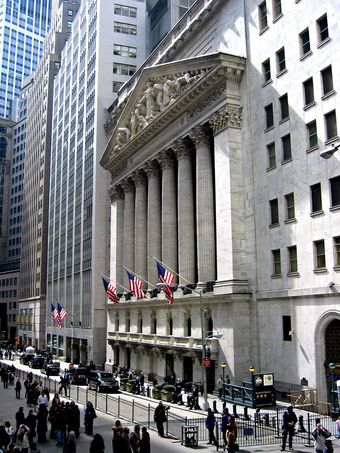
NYSE
Firms may issue an IPO on an exchange such as the New York Stock Exchange (NYSE). They sell their stock in exchange for cash.
The company needs to set a price for its stock; they want to set it high enough to raise as much money as possible but low enough that they will be able to sell their stock. Thus, there is a risk to the company in the offering of securities. For all types of securities, whether offered by companies or the government, there is a risk that the issuer may not be able to have a successful securities offering.
That is where the job of the security underwriter comes in. The underwriter offers to take on some of the risk of the offering in exchange for a premium. In essence, the underwriter buys the securities from the issuer and then turns around to sell the securities on the market. This means that the issuer gets cash up front. The issuer knows that it is probably not getting the full market value of the securities, but that’s okay because it no longer has the risk of having to find enough buyers to purchase the securities at a desirable price. The underwriting investment bank likes the deal because if it can sell the securities on the market at a higher price than it purchased them, it can make a profit.
There are sometimes multiple investment banks involved in the underwriting of a security. The details of the process may vary from deal to deal, but the fundamental job of the underwriter(s) is to take some of the issuer’s risk in exchange for a premium.
14.4.2: Market Maker
Market makers provide liquidity to securities markets by submitting both bids and asks on a security.
Learning Objective
Explain the role of market makers
Key Points
- Without sufficient liquidity, markets would become more inefficient because there may not be a buyer/seller to transact with, even at what should be the market price.
- Market-designated market makers provide liquidity by submitting both bids and asks on certain securities. This helps ensure transactions can occur at the market price.
- By submitting bids below ask prices, the market maker can make money.
- The difference between the highest bid and the lowest ask price is called the bid-ask spread.
Key Terms
- liquidity
-
Availability of cash over short term: ability to service short-term debt.
- bid-ask spread
-
the difference between the prices quoted for an immediate sale and an immediate purchase
- bid
-
The submitted price at which the trader is willing to buy.
- ask
-
The submitted price at which the trader is willing to sell.
- bid price
-
the amount offered by a buyer
The price of a stock is determined through a simple process of matching buyers and sellers. All those who want to sell the stock say the price at which they’re willing to sell a certain number of shares (the ask price). All those who want to buy say the maximum price they’re willing to pay for a certain number of shares (the bid). The difference between the highest bid and the lowest ask price is called the bid-ask spread . If the one person’s bid equals another’s ask price, they have found a price at which they’re both willing to do business, and the transaction occurs. The mutually agreeable price is then inputted as the stock price.

New York Spot Prices
The highest price someone is willing to pay (bid) for gold is $742.30 and the lowest someone is willing to accept (ask) is $743.30. There is a bid-ask spread of $1.10.
In major stock exchanges (such as the New York Stock Exchange) there are enough people who want to buy or sell at any given time that it’s generally easy to find someone to transact with if you’re making a bid/ask near the last price. This is called liquidity.
But what happens if there is no liquidity? Since there aren’t very many people looking to trade the stock, the highest bid may be significantly lower than the lowest ask price, so no transactions occur. A lack of liquidity is really bad for investors. If they don’t think they can buy/sell the stock when they need to, they will choose to just not deal with it.
That’s where a special type of trader comes in. They are the market makers. Market makers are a company or individual that quotes both an ask price and a bid. This helps to provide liquidity to the market, making the market more efficient. For this reason, many exchanges (such as the New York Stock Exchange and American Stock Exchange) have designated market makers for certain securities.
The financial reason why market makers do this is because the ask price that they submit will always be slightly higher than their bid. It is the bid-ask spread that provides the money-making opportunity. A bid-ask spread of even a cent can mean a huge profit when trading thousands of shares.
14.4.3: The Role of an Advisor
The advisory group of an investment bank is primarily concerned with facilitating the mergers and acquisitions of businesses.
Learning Objective
Define how investment banks act as advisors
Key Points
- Mergers and acquisitions (M&A) require an investment bank to bring the buyer and seller together and to help negotiate the deal.
- The advisor is hired by the client company to find a buyer/seller. The advisor pitches the deal to potential buyers/sellers using a pitch book, which contains all relevant financial information.
- The advisor also helps facilitate the deal which is incredible context because it must account for everything from financial projections to assets to brand names.
Key Term
- M&A
-
Mergers and acquisitions (M&A) are aspects of corporate strategy, corporate finance, and management dealing with the buying, selling, dividing, and combining of different companies and similar entities that can help an enterprise grow rapidly in its sector or location of origin, or a new field or new location, without creating a subsidiary, other child entity or using a joint venture.
Advisory Role
Investment banks also play the role of advisor to companies. They are not consultants, but are more like facilitators. The advisory group in an investment bank is often termed M&A.
M&A stands for “mergers and acquisitions”, which refers to the the buying, selling, dividing and combining of different firms. For example, if a company wants to sell of an unprofitable division, they will hire an investment bank to find a company that would want to buy it. Investment banks play a large role in facilitating M&A deals. The advisory group is charged with the task of helping buyers find sellers and vice versa, and then facilitating the deal.
Once the advisory group is hired by a company looking to sell itself to another, it will put together something called a pitch book. The pitch book contains all the relevant financial information about the company looking to get acquired. The investment bank then takes the pitch book to companies that it thinks might be interested in acquiring their client.
If the pitch is successful, the bank arranges the deal for the client. In order for the acquisition to take place, the two boards and leadership must be agree on the terms. This is often a very complex process because of the intricacies of the financial, functional, and organizational structures of both companies. There must be a plan for transferring everything from technology to debt to employees to titles, and the transaction must occur at a favorable price . If the negotiations are successful, the investment bank’s client will be acquired.

Pricewaterhouse Cooper
Pricewaterhouse Cooper got it’s name after the 1998 merger of Price Waterhouse and Coopers & Lybrand.
14.4.4: Agency
In its agency role, an investment bank is tasked with matching companies with investors.
Learning Objective
Define the different sources of capital financing
Key Points
- Many small and private companies cannot access traditional financial markets for capital, so they need to either take on debt or find other sources of financing. Investment banks help them find those other sources of capital.
- Common sources of financing are equity financing, mezzanine financing, and specialist financing (e.g., government loans).
- The investment banks match their clients to investors and then charge a fee for the service.
Key Term
- private
-
A company that is not publicly traded.
Investment banks are not confined solely to working with and making money on large, publicly traded companies. They also can be hired by private firms. A private firm might hire an investment bank for help with a merger or acquisition or for issuing an IPO (initial public offering of shares). A private firm might also hire an investment bank as a placement agent.
Suppose a firm does not want to be acquired and cannot (or does not want to get) good loans from banks. They still need to raise capital, but can’t access public markets, such as the stock market; they have to find different ways to raise capital. They hire a placement agent to act as an intermediary between them and investors. This allows them not only to connect with investors, but also allows them to focus on management, instead of finding investors.
Capital financing for private companies can come from a number of sources. Three of the main capital sources are:
- Equity financing: Private firms can sell some or all of their equity to investors. This is akin to selling off a portion of the ownership of the company. It may seem undesirable to sell a portion of the company’s ownership, but many firms (especially start-ups and growth companies) need to do so for immediate capital to fund future growth .
- Mezzanine capital: A subordinated debt or preferred equity instrument that represents a claim on a company’s assets, which is senior only to that of the common shares. Mezzanine financings can be structured either as debt (typically an unsecured and subordinated note) or preferred stock.
- Specialist financing: This could include things such as government loans or special grants that the company qualifies for.
Placement agents are most often compensated through fee arrangements based on the amount of money raised and supported by the fund or company they are representing.
14.5: Distributing Stock
14.5.1: Defining Spread
The spread is the difference between the prices for immediate purchase and sale of a stock, which is one measure of market liquidity.
Learning Objective
Describe the importance of spread in a stock transaction
Key Points
- The party that initiates the trade is the liquidity demander who pays the spread. The counterparty is the liquidity supplier who earns the spread.
- Liquidity suppliers use limit orders. A limit order is when the buyer waits until the stock reaches a designated price.
- The spread is one component of transaction cost, which along with brokerage fees, reflects the cost of making an instantaneous trade.
Key Terms
- liquidity
-
Availability of cash over short term: ability to service short-term debt.
- tender offer
-
an invitation to shareholders of a corporation to exchange their shares in return for a monetary buy-out
Concept
The bid–offer spread for securities is the difference between the prices quoted for an immediate sale (offer) and an immediate purchase (bid). The size of the bid-offer spread in a security is one measure of the liquidity of the market and size of the transaction cost. If the spread is 0 then the security is a frictionless asset.

Signals from dividend policy may give clues about stocks.
The spread measures the cost of executing an instant trade.
Liquidity
The trader initiating the transaction is said to demand liquidity, and the other party (counterparty) to the transaction supplies liquidity. Liquidity demanders place market orders and liquidity suppliers place limit orders.
Limit Order
A limit order is an order to buy or sell a stock at a specific price or better. A buy limit order can only be executed at the limit price or lower, and a sell limit order can only be executed at the limit price or higher. A limit order is not guaranteed to execute. A limit order can only be filled if the stock’s market price reaches the limit price. While limit orders do not guarantee execution, they help ensure that an investor does not pay more than a pre-determined price for a stock.
Example
If the current bid price for the EUR/USD currency pair is 1.5760 and the current offer price is 1.5763, this means that currently you can sell the EUR/USD at 1.5760 and buy at 1.5763. The difference between those prices (3 pips) is the spread.
For a round trip (a purchase and sale together), the liquidity demander pays the spread and the liquidity supplier earns the spread. In some markets such as NASDAQ, dealers supply liquidity. However, on most exchanges, such as the Australian Securities Exchange, there are no designated liquidity suppliers, and liquidity is supplied by other traders. On these exchanges, and even on NASDAQ, institutions and individuals can supply liquidity by placing limit orders.
Transaction Costs
The bid–offer spread is an accepted measure of liquidity costs in exchange traded securities and commodities. On any standardized exchange, two elements comprise almost all of the transaction cost—brokerage fees and bid-offer spreads. Under competitive conditions, the bid-offer spread measures the cost of making transactions without delay.
14.5.2: Pricing a Security
The price of a security is the market determination of the value of the underlying asset.
Learning Objective
Differentiate the different methods of pricing a security
Key Points
- Several methods are used to determine the value of a company including Present Value, Comparable Company Analysis, and Net Asset Value. The goal of each of these methods is to determine the worth of a potential investment in the company.
- Financial analysis of this sort determines what investors are willing to pay for a given security because it is what they think the security is worth.
- If most investors think a stock is worth a lot, or will be in the future, they buy it and this demand drives price up. The opposite occurs if investors are not confident about the stock. Therefore, stock price reflects investor expectations.
Key Term
- security
-
proof of ownership of stocks, bonds, or other investment instruments.W
Concept
The price of a security reflects the value of the asset underlying it. Therefore, the market price for a security indicates the consensus value placed on its asset by all the buyers and sellers in the market. It is the result of the valuation of the asset .
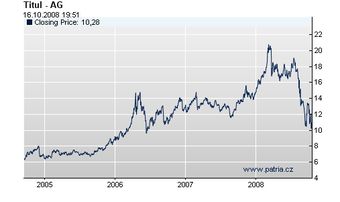
Price
Price fluctuates depending on how the market values the security.
Valuation
In finance, valuation is the process of estimating what something is worth. There are different valuation methods. The choice of which method to use depends in part on what kind of security one is valuing. For instance, some financial instruments such as options are valued using mathematical models which take several variables into account. The price of stocks, on the other hand, depends on the value of the company. There are several methods used to value the company itself.
Present Value
This method estimates the value of an asset based on its expected future cash flows, which are discounted to the present. This concept of discounting future money is commonly known as the time value of money. The time value of money says that if you have an asset that matures in one year and pays $1 at that time, it is worth less than $1 today. This is because if you have a dollar today, you can do all kinds of things with it: invest it, use it to buy something you want, or pay back a debt. On the other hand, if you have to wait a year to get your dollar, you miss out on all these opportunities. Those missed opportunities are called the opportunity cost. Therefore, money you get in the future needs to be reduced to approximate the opportunity cost. The size of the discount is based on the opportunity cost of capital and it is expressed as a percentage. This percentage is the discount rate.
For a valuation using the discounted cash flow method, one first estimates the future cash flows from the investment and then estimates a reasonable discount rate after considering the riskiness of those cash flows and interest rates in the capital markets. Then one makes a calculation to compute the present value of the future cash flows.
Comparable Company Analysis
This method determines the value of a firm by observing the prices of similar companies that sold in the market. Those sales could be shares of stock or sales of entire firms. The observed prices serve as valuation benchmarks. From the prices, one calculates price multiples such as the price-to-earnings or price-to-book value ratios. Next, one or more price multiples are used to value the firm. For example, the average price-to-earnings multiple of the guideline companies is applied to the subject firm’s earnings to estimate its value.
Net Asset Value
The third common method of estimating the value of a company looks to the assets and liabilities of the business. At a minimum, a solvent company could shut down operations, sell off the assets, and pay the creditors. Any cash that would remain establishes a floor value for the company. This method is known as the net asset value. Normally, the discounted cash flows of a well-performing company exceed this floor value. However, some companies are “worth more dead than alive,” such as weakly performing companies that own many tangible assets. This method can also be used to value heterogeneous portfolios of investments, as well as non-profit companies for which discounted cash flow analysis is not relevant.
Financial Analysis
Financial professionals make their own estimates of the valuations of assets or liabilities that they are interested in. Their calculations are of various kinds including analyses of companies that focus on
- price-to-book
- price-to-earnings
- price-to-cash-flow
- present value calculations
All of these approaches may be thought of as creating estimates of value that compete for credibility with the prevailing stock or bond prices, and may result in buying or selling by market participants.
Price and Valuation
Investors use valuation methods to estimate what a company is worth, but the price of a stock on the market usually does not rest at the book-value of the company. Typically there will be people who are either optimistic about the company–because they anticipate that it will be worth more in the future than it is in the present–or pessimistic–because they think it will do worse in the future. Optimists will buy more of the stock and drive the price up, while pessimists will sell and drive it down. Therefore, a stock’s market price also takes into account expectations for the future performance of the company.
14.5.3: Shelf Registration
Shelf registration is a type of public offering in which the issuer is allowed to offer several types of securities in a single prospectus.
Learning Objective
Describe the self registration process
Key Points
- A company can file a shelf registration statement with a prospectus that offers different classes of securities. It can then sell all, none, or some of the classes at any time.
- Regulators generally grant shelf registration to companies that are reliable. They also require a statement of material changes in business since the prospectus was filed before each security is actually sold.
- Shelf registration can be used by a company as a strategy to quickly sell securities for funds when market conditions become favorable.
Key Term
- prospectus
-
A document that describes a proposed endeavor (venture, undertaking) such as a literary work (which one proposes to write).
Definition
Shelf registration or shelf offering is a type of public offering where certain issuers are allowed to offer and sell securities to the public without a separate prospectus for each act of offering. Instead, there is a single prospectus for multiple, undefined future offerings. The prospectus (often as part of a registration statement) may be used to offer securities for up to several years after its publication .

Shelf Registration
Some of the securities in the prospectus can be “shelved,” and sold later.
Application
A company can file a shelf registration statement with, for instance, a prospectus for 100,000,000 shares, $1,000,000,000 face value of bonds, $500,000,000 dollar face value of convertible bonds, $50,000,000 Series A warrants, and $50,000,000 Series B warrants. These five different classes or series of securities are offered in a single document. The company may offer to sell all of them, none of them, or any part of some class. It can sell 30,000,000 shares at one time and another 50,000,000 a year later. In that case, it will then have 20,000,000 unissued shares covered by the shelf prospectus.
Material Changes in Business
Before each offering and sale is actually made, the company must file a relatively short statement regarding material changes in its business and finances since the shelf prospectus was filed.
Regulation
Shelf registration is usually available to companies deemed reliable by the securities regulation authority in the relevant country. Shelf offerings, due to their purposefully time-constrained nature, are examined far less rigorously by those authorities, compared to standard public offerings.
Strategy
Shelf registration is a registration of a new issue which can be prepared up to two years in advance, so that the issue can be offered quickly as soon as funds are needed or market conditions are favorable. By using shelf registration, the firm can fulfill all registration-related procedures beforehand and go to market quickly when conditions become more favorable.
Firms often use universal shelf filings and choose between debt and equity offerings based on the prevailing relative market conditions.
14.6: Comparing Public and Private Financing
14.6.1: Advantages of Public Financing
The main advantage in seeking public financing is that it offers a larger pool of funding for the company than private financing alone.
Learning Objective
Discuss why a company may want to go public
Key Points
- The magnitude of funding available from public financing is its chief advantage.
- An initial public offering is when a private company converts to a public company by selling shares of its stock publicly.
- A company can sell further shares of stock in secondary offerings.
- A company can also sell debt, in the form of bonds, in public exchanges.
Key Term
- security
-
proof of ownership of stocks, bonds, or other investment instruments.W
Public Company Definition
A publicly traded company is a limited liability company that offers its securities for sale to the general public, typically through a stock exchange, or through market makers operating over the counter markets. .

Public Financing
Public financing offers immediate access to large amounts of funding.
Main Advantage of Public Financing
Usually, security of a publicly traded company is owned by many investors while the shares of a privately held company are owned by relatively few shareholders. Therefore, publicly traded companies are able to raise funds and capital through the sale (in the primary or secondary market) of their securities, whether debt or equity, to a wide range of buyers. This is the reason publicly traded corporations are important; prior to their existence, it was very difficult to obtain large amounts of capital for private enterprises. The magnitude of funding available from public financing is its chief advantage.
Advantages from Initial Public Offering
New companies, which are typically small, tend to be privately held. After a number of years, if a company has grown significantly and is profitable or has promising prospects, there is often an initial public offering, which converts the privately held company into a publicly traded company.
Through this process, a private company transforms into a public company. Initial public offerings are used by companies to raise expansion capital, to monetize the investments of early private investors, and to become publicly traded enterprises.
When a company lists its securities on a public exchange, the money paid by the investing public for the newly issued shares goes directly to the company (primary offering) as well as to any early private investors who opt to sell all or a portion of their holdings (secondary offering) as part of the larger IPO. An IPO, therefore, allows a company to tap into a wide pool of potential investors to provide itself with capital for future growth, repayment of debt, or working capital. A company selling common shares is never required to repay the capital to its public investors.
An IPO accords several benefits to the previously private company:
- Enlarging and diversifying equity base
- Enabling cheaper access to capital
- Increasing exposure, prestige, and public image
- Attracting and retaining better management and employees through liquid equity participation
- Facilitating acquisitions (potentially in return for shares of stock)
- Creating multiple financing opportunities, such as equity, convertible debt, and cheaper bank loans
Advantages from Follow-On Offering
Once a company is listed, it is able to issue additional common shares in a number of different ways, one of which is the follow-on offering. This method provides capital for various corporate purposes through the issuance of equity without incurring any debt. This ability to quickly raise potentially large amounts of capital from the marketplace is a key reason many companies seek to go public.
14.6.2: Advantages of Private Financing
Private financing can enhance a firm’s capital structure, save on costs, and improve managerial incentive alignment.
Learning Objective
Describe why a company may want to go private
Key Points
- One advantage of private financing is that private investors may infuse the company with more capital than was available to it from public financing.
- Private financing also saves on administrative costs of being a publicly traded company.
- Private financing can improve incentives for management, and increase investor involvement.
Key Terms
- incentive
-
Something that motivates, rouses, or encourages.
- Stock
-
The capital raised by a company through the issue of shares. The total of shares held by an individual shareholder.
- investor
-
A person who invests money in order to make a profit.
Definition
In countries with public trading markets, a privately held business is generally taken to mean one whose ownership shares or interests are not publicly traded. Often, privately held companies are owned by the company founders or their families and heirs or by a small group of investors. Sometimes employees also hold shares of private companies. Most small businesses are privately held.

Private financing
Private financing can offer advantages over public.
Going Private
Though most companies start out privately held, there are situations in which a publicly traded company becomes privately acquired. This means that a small group of investors purchases all outstanding shares of the company. The company is then privately financed. This transition it known as “going private. “
Advantages
There are several advantages to private financing:
- Increased capital: Sometimes going private results in a significant injection of capital, because the investors are willing to buy the company’s stock at a higher price than it is trading on the market. They are willing to pay more in order to privately control the firm.
- Administrative costs: It is possible for the company to save administrative costs. Being a publicly traded company entails administrative costs, such as annual reports, registration with regulating bodies, and communicating with shareholders. A privately financed company does not have these costs.
- Managerial incentives: In many instances it is the management which takes over and privately controls the company. In this case, they have a more immediate incentive to improve the company’s performance, because they are investors as well.
- Investor involvement: A publicly traded company’s shareholders are a large, anonymous, and mostly uninformed group. They do not typically know the business, much less the daily operations, of the company and are not in a good position to be productively involved with it. Private investors, on the other hand, can offer expert knowledge, and direct oversight of the company in a way that can benefit performance.
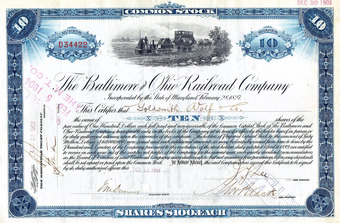
1903 stock certificate of the Baltimore and Ohio Railroad
Normally stocks are traded publicly, except in the instance of private stocks, which are only offered and traded by internal stakeholders such as founders, employees, etc.
14.6.3: Types of Private Financing Deals: Going Private and Leveraged Buyouts
LBOs use debt to secure an acquisition and the acquired assets service the debt.
Learning Objective
Define a leveraged buyout
Key Points
- The acquiring party borrows money in addition to using its own funds to meet the purchase price of the target. LBOs can also occur to public companies, such as in public to private (PtP) transactions.
- The term typically applies to a deal in which a financial sponsor acquires a company. In this instance, the sponsor uses debt to increase its return on equity.
- LBOs are appealing to the acquiring company because debt typically carries a lower cost of capital than equity, which means that by employing more debt, the acquiring party magnifies returns.
Key Terms
- insolvency
-
The condition of being insolvent; the state or condition of a person who is insolvent; the condition of one who is unable to pay his debts as they fall due, or in the usual course of trade and business; as, a merchant’s insolvency.
- overleveraged
-
Subject to excessive leverage
- leverage
-
The use of borrowed funds with a contractually determined return to increase the ability of a business to invest and earn an expected higher return (usually at high risk).
Definition of Leveraged Buyout
A leveraged buyout (LBO) is an acquisition (usually of a company, but it can also be single assets like a real estate) where the purchase price is financed through a combination of equity and debt, and in which the cash flows or assets of the target are used to secure and repay the debt . As the debt usually has a lower cost of capital than the equity, the returns on the equity increase with the increasing debt. The debt thus effectively serves as a lever to increase returns, which explains the origin of the term leveraged buyout (LBO).

Financing deal
An LBO is a type of financing deal.
Forms of LBOs
LBOs are a very common occurrence in today’s Mergers and Aquisitions environment. The term LBO is usually employed when a financial sponsor acquires a company. However, many corporate transactions are part-funded by bank debt, and thus also effectively representing an LBO. LBOs can have many different forms, such as Management Buyout (MBO), Management Buy-in (MBI), and secondary buyout and tertiary buyout, among others. They can occur in growth situations, restructuring situations, and insolvencies just like in companies with stable performance. LBOs mostly occur in private companies, but can also be employed with public companies (in a so-called PtP transaction, Public to Private).
Common Cause of LBOs
As financial sponsors increase their returns by employing a very high leverage (i.e., a high ratio of debt to equity), they have an incentive to employ as much debt as possible to finance an acquisition. This has, in many cases, led to situations in which companies were “overleveraged”, meaning that they did not generate sufficient cash flows to service their debt. In turn, this then led to insolvency or to debt-to-equity swaps, in which the equity owners lose control over the business and the debt providers assume the equity.
Characteristics
LBOs have become attractive, as they usually represent a win-win situation for the financial sponsor and the banks: The financial sponsor can increase the returns on his equity by employing the leverage; banks can make substantially higher margins when supporting the financing of LBOs as compared to usual corporate lending. The amount of debt banks which are willing to provide and support an LBO varies greatly and depends on the quality of the asset to be acquired–stability of cash flows, history, growth prospects, and hard assets; the amount of equity supplied by the financial sponsor; and the history and experience of the financial sponsor.
Debt Ratio
For companies with very stable and secured cash flows, debt volumes of up to 100% of the purchase price have been provided. In situations of “normal” companies with normal business risks, debt of 40–60% of the purchase price are normal figures. The debt ratios that are possible also vary significantly between the regions and industries of the target. Depending on the size and purchase price of the acquisition, the debt is provided in different tranches:
- Senior debt: This debt is secured with the assets of the target company and has the lowest interest margin
- Junior debt: This debt usually has no securities and bears a higher interest margin
Chapter 13: Capital Structure
13.1: Introducing Capital Structure
13.1.1: Capital Structure Overview and Theory
Capital Structure is the way a company finances its assets through a combination of equity and liabilities.
Learning Objective
Describe how a company’s capital structure can influence its value and investment decisions
Key Points
- In theory, capital structure does not alter the value of a firm, so there is an incentive to use more debt and deduct interest expense to achieve tax savings.
- In reality, there is financial risk in taking on too much debt, so each company must find a balanced structure.
- Trade-Off Theory and Pecking Order Theory are two different explanations for differences among observed capital structures.
Key Terms
- equity
-
Ownership, especially in terms of net monetary value, of a business.
- structure
-
A cohesive whole built up of distinct parts.
Capital Structure Overview
Capital structure refers to the way a corporation finances its assets through some combination of equity, debt, or hybrid securities. A firm’s capital structure is the composition or ‘structure’ of its liabilities. For example, a firm that sells 20 billion dollars in equity and 80 billion dollars in debt is said to be 20% equity-financed and 80% debt-financed. The firm’s ratio of debt to total financing, 80% in this example, is referred to as the firm’s leverage. In reality, capital structure may be highly complex and include dozens of sources. Gearing Ratio is the proportion of the capital employed by the firm which comes from outside of the business, such as by taking a short term loan.

Capital Structure.
Capital Structure shows how a company’s assets are built out of debt and equity.
Modigliani and Miller created a theory of Capital Structure in a perfect market. There are several qualifications for a “perfect market”:
- no transaction or bankruptcy cost
- perfect information
- firms and individuals can borrow at the same interest rate
- no taxes
- investment decisions are not affected by financing decisions
Modigliani and Miller made two findings under these conditions:
- The value of a company is independent of its capital structure
- The cost of equity for a leveraged firm is equal to the cost of equity for an unleveraged firm, plus an added premium for financial risk
This means, as leverage increases, while the burden of individual risks is shifted between different investor classes, total risk is conserved and hence no extra value created.
Their analysis was extended to include the effect of taxes and risky debt. Under a classical tax system, the tax deductibility of interest makes debt financing valuable; the cost of capital decreases as the proportion of debt in the capital structure increases. The optimal structure, then would be to have virtually no equity at all.
If capital structure is irrelevant in a perfect market, then imperfections which exist in the real world must be the cause of its relevance. The theories below try to address some of these imperfections, by relaxing assumptions made in the M&M model.
Capital Structure Theory
Trade-off theory allows bankruptcy cost to exist. It states that there is an advantage to financing with debt (the tax benefits of debt) and that there is a cost of financing with debt (the bankruptcy costs and the financial distress costs of debt). The marginal benefit of further increases in debt declines as debt increases, while the marginal cost increases, so that a firm that is optimizing its overall value will focus on this trade-off when choosing how much debt and equity to use for financing. Empirically, this theory may explain differences in Debt/Equity ratios between industries, but it doesn’t explain differences within the same industry.
Pecking Order Theory tries to capture the costs of asymmetric information. It states that companies prioritize their sources of financing (from internal financing to issuing shares of equity) according to least resistance, preferring to raise equity for financing as a last resort. Internal financing is used first. When that is depleted, debt is issued. When it is no longer sensible to issue any more debt, equity is issued.
This theory maintains that businesses adhere to a hierarchy of financing sources and prefer internal financing when available, while debt is preferred over equity if external financing is required. Thus, the form of debt a firm chooses can act as a signal of its need for external finance.
The Pecking Order Theory is popularized by Myers (1984), when he argues that equity is a less preferred means to raise capital because when managers (who are assumed to know better about true condition of the firm than investors) issue new equity, investors believe that managers think that the firm is overvalued and managers are taking advantage of this over-valuation. As a result, investors will place a lower value to the new equity issuance.
13.2: Capital Structure Considerations
13.2.1: Optimal Capital Structure Considerations
The optimal capital structure is the mix of debt and equity that maximizes a firm’s return on capital, thereby maximizing its value.
Learning Objective
Explain the influence of a company’s cost of capital on its capital structure and therefore its value
Key Points
- Capital structure categorizes the way a company has its assets financed.
- Miller and Modigliani developed a theory which through its assumptions and models, determined that in perfect markets a firm’s capital structure should not affect its value.
- In the real world, there are costs and variables that create different returns on capital and, therefore, give rise to the possibility of an optimal capital structure for a firm.
- The cost of capital is the rate of return that capital could be expected to earn in an alternative investment of equivalent risk.
- For an investment to be worthwhile, the expected return on capital must be greater than the cost of capital.
- The weighted average cost of capital multiplies the cost of each security (debt or equity) by the percentage of total capital taken up by the particular security, and then adds up the results from each security involved in the total capital of the company.
Key Terms
- capital structure
-
Capital structure is the way a corporation finances its assets, through a combination of debt, equity, and hybrid securities.
- leverage
-
Debt taken on by a firm in order to finance assets.
- cost of capital
-
the rate of return that capital could be expected to earn in an alternative investment of equivalent risk
Capital structure is the way a corporation finances its assets, through a combination of debt, equity, and hybrid securities. In short, capital structure can be termed a summary of a firm’s liabilities by categorization of asset sources. In a simple example, if a company’s assets come from a $20 million equity issuance and lending that amounts to $80 million, the capital structure can be said to be 20% equity and 80% debt. While equity results from the selling of ownership shares, debt is termed “leverage. ” Therefore, a term that has issued no debt or bonds is said to not be leveraged. This is a simplistic view, because in reality a firm’s capital structure can be highly complex and include many different sources.
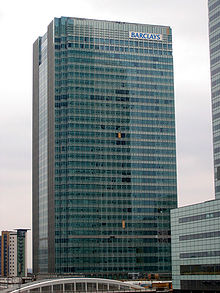
Capital Structure
Captial structure is the assignment of the sources of company assets into equity or debt securities.
The Modigliani-Miller theorem, proposed by Franco Modigliani and Merton Miller, forms the basis for modern thinking on capital structure (though it is generally viewed as a purely theoretical result, since it disregards many important factors in the capital structure decision). The theorem states that in a perfect market, how a firm is financed is irrelevant to its value. However, as with many theories, it is difficult to use this abstract theory as a basis to evaluate conditions in the real world, where markets are imperfect and capital structure will indeed affect the value of the firm. Actual market considerations when dealing with capital structure include bankruptcy costs, agency costs, taxes, and information asymmetry.
Cost of Capital Considerations
One of the major considerations that overseers of firms must take into account when planning out capital structure is the cost of capital. For an investment to be worthwhile, the expected return on capital must be greater than the cost of capital. A company’s securities typically include both debt and equity; therefore, one must calculate both the cost of debt and the cost of equity to determine a company’s cost of capital. The weighted average cost of capital multiplies the cost of each security by the percentage of total capital taken up by the particular security, and then adds up the results from each security involved in the total capital of the company.
Because of tax advantages on debt issuance, such as the ability to deduct interest payments from taxable income, issuing debt will typically be cheaper than issuing new equity. At some point, however, the cost of issuing new debt will be greater than the cost of issuing new equity. This is due to the fact that adding debt increases the default risk and, thus, the interest rate that the company must pay in order to borrow money. This increased default risk can also drive up the costs for other sources (such as retained earnings and preferred stock). Management must identify the “optimal mix” of financing, which is the capital structure where the cost of capital is minimized so that the firm’s value can be maximized.
13.2.2: Tax Considerations
Taxation implications which change when using equity or debt for financing play a major role in deciding how the firm will finance assets.
Learning Objective
Explain how taxes can influence a company capital structure
Key Points
- Tax considerations have a major effect on the way a company determines its capital structure and deals with its costs of capital.
- Under a classical tax system, the tax deductibility of interest makes debt financing valuable; that is, the cost of capital decreases as the proportion of debt in the capital structure increases. The optimal structure, then would be to have virtually no equity at all.
- In general, since dividend payments are not tax deductible but interest payments are, one would think that, theoretically, higher corporate tax rates would call for an increase in usage of debt to finance capital, relative to usage of equity issuance.
- There are different kinds of debt that can be used, and they may have different deductibility and tax implications. This will affect the types of debt used in financing, even if corporate taxes do not change the total amount of debt used.
Key Terms
- Interest
-
The price paid for obtaining, or price received for providing, money or goods in a credit transaction, calculated as a fraction of the amount or value of what was borrowed.
- dividend
-
A pro rata payment of money by a company to its shareholders, usually made periodically (e.g., quarterly or annually).
- optimal capital structure
-
the amount of debt and equity that maximizes the value of the firm
Tax considerations have a major effect on the way a company determines its capital structure and deals with its costs of capital .

Taxes
A company’s decision makers must take taxes into consideration when determining a firm’s capital structure.
Miller and Modigliani assume that in a perfect market, firms will borrow at the same interest rate as individuals, there are no taxes, and that investment decisions are not changed by financing decisions. This leads to a conclusion that capital structure should not affect value.
When the theory is extended to include taxes and risky debt, things change. Under a classical tax system, the tax deductibility of interest makes debt financing valuable; that is, the cost of capital decreases as the proportion of debt in the capital structure increases. The optimal structure then, would be to have virtually no equity at all.
However, we see that in real world markets capital structure does affect firm value. Therefore, we see that imperfections exist; often a firm’s optimal structure does not involve having one hundred percent leveraging and no equity whatsoever. There is much debate over how changing corporate tax rates would affect debt usage in capital structure. In general, since dividend payments are not tax deductible, but interest payments are, one would think that, theoretically, higher corporate tax rates would call for an increase in usage of debt to finance capital, relative to usage of equity issuance. However, since many things fall into tax applicability, including firm location and size, this is a generality at best.
There are also different kinds of debt that can be used, and they may have different deductibility and tax implications. That is why, while many believe that taxes don’t really affect the amount of debt used, they actually do. In the end, different tax considerations and implications will affect the costs of debt and equity, and how they are used, relative to each other, in financing the capital of a company.
13.2.3: Cost of Capital Considerations
Cost of capital is important in deciding how a company will structure its capital so to receive the highest possible return on investment.
Learning Objective
Describe the influence of a company’s cost of capital on its capital structure and investment decisions
Key Points
- For an investment to be worthwhile, the expected return on capital must be greater than the cost of capital. The cost of capital is the rate of return that capital could be expected to earn in an alternative investment of equivalent risk.
- Once cost of debt and cost of equity have been determined, their blend, the weighted average cost of capital (WACC), can be calculated. This WACC can then be used as a discount rate for a project’s projected cash flows.
- The weighted average cost of capital multiplies the cost of each security (debt or equity) by the percentage of total capital taken up by the particular security, and then adds up the results from each security involved in the total capital of the company.
Key Terms
- cost of preferred stock
-
the additional premium paid to have an equity security with certain additional features not present in common stock
- capital rationing
-
restrictions on how or how much a company can invest
- cost of capital
-
The rate of return that capital could be expected to earn in an alternative investment of equivalent risk.
One of the major considerations that overseers of firms must take into account when planning out capital structure is the cost of capital.
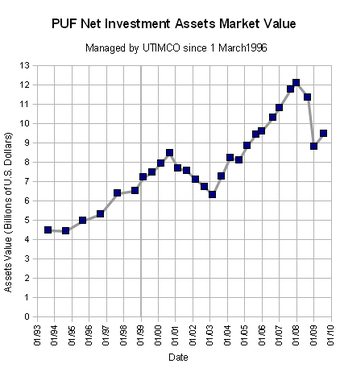
The expected return on an asset is compared to the cost of capital to invest in the asset.
Cost of capital is an important way of determining whether or not a firm is a worthwhile investment.
For an investment to be worthwhile, the expected return on capital must be greater than the cost of capital. A company’s securities typically include both debt and equity, so one must therefore calculate both the cost of debt and the cost of equity to determine a company’s cost of capital. The weighted average cost of capital multiplies the cost of each security by the percentage of total capital taken up by the particular security, and then adds up the results from each security involved in the total capital of the company.
If there were no tax advantages for issuing debt, and equity could be freely issued, Miller and Modigliani showed that, under certain assumptions, the value of a leveraged firm and the value of an unleveraged firm should be the same.
Because of tax advantages on debt issuance, such as the ability to deduct interest payments from taxable income, it will be cheaper to issue debt rather than new equity. At some point, however, the cost of issuing new debt will be greater than the cost of issuing new equity. This is because adding debt increases the default risk and thus the interest rate that the company must pay in order to borrow money. By utilizing too much debt in its capital structure, this increased default risk can also drive up the costs for other sources (such as retained earnings and preferred stock). Management must identify the “optimal mix” of financing–the capital structure where the cost of capital is minimized so that the firm’s value can be maximized.
13.2.4: The Marginal Cost of Capital
The marginal cost of capital is the cost needed to raise the last dollar of capital, and usually this amount increases with total capital.
Learning Objective
Describe how the cost of capital influences a company’s capital budget
Key Points
- The marginal cost of capital is calculated as being the cost of the last dollar of capital raised.
- When raising extra capital, firms will try to stick to desired capital structure, but once sources are depleted they will have to issue more equity. Since this tends to be higher than other sources of financing, we see an increase in marginal cost of capital as capital levels increase.
- Since an investment in capital is logically only a good decision if the return on the capital is greater than its cost, and a negative return is generally undesirable, the marginal cost of capital often becomes a benchmark number in the decision making process that goes into raising more capital.
Key Terms
- capital gains yield
-
compound rate of return of increases in a stock’s price
- marginal tax rate
-
the percent paid out to the government of the last dollar (or applicable currency) earned
- Marginal Cost of Capital
-
The cost of the last dollar of capital raised or the minimum acceptable rate of return or hurdle rate.
The marginal cost of capital is calculated as being the cost of the last dollar of capital raised. Generally we see that as more capital is raised, the marginal cost of capital rises . This happens due to the fact that marginal cost of capital generally is the weighted average of the cost of raising the last dollar of capital. Usually, we see that in raising extra capital, firms will try to stick to desired capital structure. Usually once sources are depleted they will have to issue more equity. Since the cost of issuing extra equity seems to be higher than other costs of financing, we see an increase in marginal cost of capital as the amounts of capital raised grow higher.
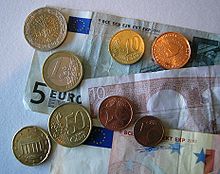
Cost of Money
The Marginal Cost of Capital is the cost of the last dollar of capital raised. It is an important consideration the firm must take into account when making corporate decisions.
The marginal cost of capital can also be discussed as the minimum acceptable rate of return or hurdle rate. The investment in capital is logically only a good decision if the return on the capital is greater than its cost. Also, a negative return is generally undesirable. As a result, the marginal cost of capital often becomes a benchmark number in the decision making process that goes into raising more capital. If it is determined that the dollars invested in raising this extra capital could be allocated toward a greater or safer return if used differently, according to the firm, then they will be directed elsewhere. For this we must look into marginal returns of capital, which can be described as the gains or returns to be had by raising that last dollar of capital.
13.2.5: Trade-Off Consideration
Trade-off considerations are important because they take into account the cost and benefits of raising capital through debt or equity.
Learning Objective
Describe the balancing act between debt and equity for a company as described by the “trade-off” theory
Key Points
- An important purpose of the trade off theory is to explain the fact that corporations are usually financed partly with debt and partly with equity. It states that there is an advantage to financing with debt.
- The marginal benefit of further increases in debt declines as debt increases while the marginal cost increases, so that a firm that is optimizing its overall value will focus on this trade-off when choosing how much debt and equity to use for financing.
- One would think that firms would use much more debt than they do in reality. The reason they do not is because of the risk of bankruptcy and the volatility that can be found in credit markets—especially when a firm tries to take on too much debt.
Key Terms
- trade-off
-
Refers to the idea that a company chooses how much debt finance and how much equity finance to use by balancing the costs and benefits.
- trade credit
-
a form of debt offered from one business to another with which it transacts
Trade-Off Consideration
The trade-off theory of capital structure refers to the idea that a company chooses how much debt finance and how much equity finance to use by balancing the costs and benefits. It is often set up as a competitor theory to the pecking order theory of capital structure. An important purpose of the theory is to explain the fact that corporations are usually financed partly with debt and partly with equity. It states that there is an advantage to financing with debt—the tax benefits of debt, and there is a cost of financing with debt—the cost of financial distress including bankruptcy.

Structural Considerations
Trade-off considerations are important factors in deciding appropriate capital structure for a firm since they weigh the cost and benefits of extra capital through debt vs. equity.
The marginal benefit of further increases in debt declines as debt increases, while the marginal cost increases. Of course, using equity is initially more expensive than debt because it is ineligible for the same tax savings, but becomes more favorable in comparison to higher levels of debt because it does not carry the same financial risk. Therefore, a firm that is optimizing its overall value will focus on this trade-off when choosing how much debt and equity to use for financing.
Another trade-off consideration to take into account is that the while interest payments can be written off, dividends on equity that the firm issues usually cannot. Combine that with the fact that issuing new equity is often seen as a negative signal by market investors, which can decrease value and returns.
As more capital is raised and marginal costs increase, the firm must find a fine balance in whether it uses debt or equity after internal financing when raising new capital. Therefore, one would think that firms would use much more debt than they do in reality. The reason they do not is because of the risk of bankruptcy and the volatility that can be found in credit markets—especially when a firm tries to take on too much debt. Therefore, trade off considerations change from firm to firm as they impact capital structure.
13.2.6: Signaling Consideration
Signaling is the conveyance of nonpublic information through public action, and is often used as a technique in capital structure decisions.
Learning Objective
Explain how a company’s attempts at signaling can affect its capital structure
Key Points
- Signaling becomes important in a state of asymmetric information.
- Signaling can affect the way investors view a firm, and corporate actions that are made public can indirectly alter the value investors assign to a firm.
- In general, issuing new equity can be seen as a bad signal for the health of a firm and can decrease current share value.
- While the issuance of equity does have benefits, in the sense that investors can take part in potential earnings growth, a company will usually choose new debt over new equity in order to avoid the possibility of sending a negative signal.
Key Terms
- asymmetric information
-
State of being regarding decisions on transactions where one party has more or better information than the other.
- Signaling
-
The idea that one party (termed the agent) credibly conveys some information about itself to another party (the principal).
In economics and finance, signaling is the idea that a party may indirectly convey information about itself, which may not be public, through actions to other parties. Signaling becomes important in a state of asymmetric information (a deviation from perfect information), which says that in some economic transactions inequalities in access to information upset the normal market for the exchange of goods and services. In his seminal 1973 article, Michael Spence proposed that two parties could get around the problem of asymmetric information by having one party send a signal that would reveal some piece of relevant information to the other party. That party would then interpret the signal and adjust its purchasing behavior accordingly — usually by offering a higher or lower price than if the signal had not been received. In general, the degree to which a signal is thought to be correlated to unknown or unobservable attributes is directly related to its value. A basic example of signaling is that of a student to a potential employer. The degree the student obtained signals to the employer that the student is competent and has a good work ethic — factors that are vital in the decision to hire.

Signaling
Education credentials, such as diplomas, can send a positive signal to potential employers regarding a workers talents and motivation.
In terms of capital structure, management should, and typically does, have more information than an investor, which implies asymmetric information. Therefore, investors generally view all capital structure decisions as some sort of signal. For example, let us think of a company that is issuing new equity. If a company issues new equity, this generally dilutes share value. Since the goal of the firm is generally to maximize shareholder value, this can be a viewed as a signal that the company is facing liquidity issues or its prospects are dim. Conversely, a company with strong solvency and good prospects would generally be able to obtain funds through debt, which would generally take on lower costs of capital than issuing new equity. If a company fails to have debt extended to it, or the company’s credit rating is downgraded, that is also a bad signal to investors. While the issuance of equity does have benefits, in the sense that investors can take part in potential earnings growth, a company will usually choose new debt over new equity in order to avoid the possibility of sending a negative signal.
13.2.7: Constraint on Managers
Managers will have their actions influenced by their firm’s capital structure and the resources that it allows them to use.
Learning Objective
Explain how capital structure can minimize a company’s agency problem
Key Points
- Debt-heavy capital structures put constraints on managers by limiting the amount of free cash they have available to them.
- Managers may often act in their own best interests instead of those of the firm’s investors. This is known as an agency dilemma.
- We see that the firms that have debt-heavy capital structures limit free cash to managers and, therefore, have managers with goals that tend to be more aligned with those of the shareholder.
Key Term
- Agency Dilemma
-
Takes into account the difficulties in motivating one party (the “agent”), to act on behalf of another (the “principal”).
Managers who make decisions about the firm’s corporate behavior will have their actions influenced by capital structure and the resources that it allows them to use.
Managerial finance is the branch of the industry that concerns itself with the managerial significance of finance techniques. It is focused on assessment rather than technique. However, this process can be tainted by the fact that managers may often act in their own best interests instead of those of investors of the firm. This is known as an agency dilemma.
Adopting the right kind of capital structure can help combat this kind of problem, however. When the capital structure draws heavily on debt, then this leaves less money to be distributed to managers in the form of compensation, as well as free cash to be used on behalf of the business. Managers have to be more careful with the resources they are given to use with the purpose of running the firm successfully, since they have to produce enough income to pay back this debt by a certain date, with interest. When managers work with equity heave capital structure they have a little more leeway, and while shareholders may be upset or suffer because of fluctuations in the value of the firm, managers may find ways to make sure their compensation can have some immunity from the market value of the firm.
Therefore, firms that have debt-heavy capital structures have managers with goals that tend to be more aligned with those of the shareholder. The limitation of free cash that managers have provides incentive for them to make decisions for the company that will grow the firm in value and increase the cash they have available to them to pay back debt, pay back into the firm, and compensate themselves.
13.2.8: Pecking Order
In corporate finance pecking ordering consideration takes into account the increase in the cost of financing with asymmetric information.
Learning Objective
Explain the benefits and shortcomings of using the “pecking order” theory to evaluate a company’s value
Key Points
- When it comes to methods of raising capital, companies will prefer internal financing, debt, and then issuing new equity, respectively.
- Outside investors tend to think managers issue new equity because they feel the firm is overvalued and wish to take advantage, so equity is a less desired way of raising new capital. This then gives the outside investors an incentive to lower the value of the new equity.
- The form of debt a firm chooses can act as a signal of its need for external finance. This sort of signalling can affect how outside investors view the firm as a potential investment.
Key Term
- Pecking Order
-
Theory that states that the cost of financing increases with asymmetric information. When it comes to methods of raising capital, companies prefer financing that comes from internal funds, debt, and issuing new equity, respectively. Raising equity can be considered a last resort.
Pecking Order Consideration
The pecking order of investors or credit holders in a company plays a part in the way a company decides to structure it’s capital. Pecking order theory basically states that the cost of financing increases with asymmetric information. Financing comes from internal funds, debt, and new equity. When it comes to methods of raising capital, companies will prefer internal financing, debt, and then issuing new equity, respectively. Raising equity, in this sense, can be viewed as a last resort.
The pecking order theory was popularized by Stewart C. Myers when he argues that equity is a less preferred means to raise capital because managers issue new equity (who are assumed to know better about true conditions of the firm than investors). Investors believe that managers overvalue the firms and are taking advantage of this over-valuation. As a result, investors will place a lower value to the new equity issuance. This theory maintains that businesses adhere to a hierarchy of financing sources and prefer internal financing when available, and debt is preferred over equity if external financing is required. Thus, the form of debt a firm chooses can act as a signal of its need for external finance. This sort of signalling can affect how outside investors view the firm as a potential investment, and once again must be considered by the people in charge of the firm when making capital structure decisions.
Tests of the pecking order theory have not been able to show that it is of first-order importance in determining a firm’s capital structure. However, several authors have found that there are instances where it is a good approximation of reality. On the one hand, Fama, French, Myers, and Shyam-Sunder find that some features of the data are better explained by the Pecking Order than by the trade-off theory. Goyal and Frank show, among other things, that Pecking Order theory fails where it should hold, namely for small firms where information asymmetry is presumably an important problem.
13.2.9: Window of Opportunity
In corporate finance, a “window of opportunity” is the time when an asset or product which is unattainable will become available.
Learning Objective
Identify a window of opportunity
Key Points
- Windows of opportunity must be taken into consideration by a corporation in order to purchase capital to achieve maximum return.
- From the seller’s perspective, the unique time a party will be able to sell a certain product at its highest price point in order to get a maximum return on capital purchased and used.
- The people in charge of a firm must take windows of opportunity into account in order to keep costs low and returns high, in order to make the firm look like the best investment possible for creditors of all types.
Key Term
- Window of opportunity
-
The idea of a time when an asset or product. which is unattainable, will become available. It can be extended to a time when a certain product will be attainable at a certain price, or from an opposite perspective, the unique time a party will be able to sell a certain product at its highest price point in order to get a maximum return on investment.
In corporate finance, a “window of opportunity” basically is the idea of a time when an asset or product that is unattainable will become available. It can be extended to a time when a certain product will be attainable at a certain price or from an opposite perspective, the unique time a party will be able to sell a certain product at its highest price point in order to get a maximum return on investment.
For example, when a firm issues an IPO, which allows a company to tap into a wide pool of potential investors to provide itself with capital for future growth, repayment of debt, or working capital. A company selling common shares is never required to repay the capital to its public investors. Those investors must endure the unpredictable nature of the open market to price and trade their shares. However, for a company with massive growth potential, the IPO may be the lowest price that the stock is available for public purchase. Therefore, the IPO presents a window of opportunity to the potential investor to get in on the new equity while it is still affordable and a greater return on investment is attainable. From the firm side, the opportunity to purchase a new plant or real estate at a cheap cost or lower lending rates also presents an opportunity to attain a greater investment on assets used in production. Management of a firm must take this into account in order to keep costs low and returns high, in order to make the firm look like the best possible investment for creditors of all types.
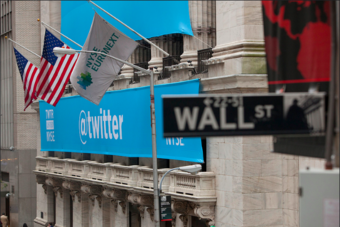
Twitter at the New York Stock Exchange
A Twitter banner hanging over the New York Stock Exchange on the day of its IPO.
13.2.10: Bankruptcy Considerations
Bankruptcy occurs when an entity cannot repay the debts owed to creditors and must take action to regain solvency or liquidate.
Learning Objective
Describe how the risk of a corporate bankruptcy can influence a company’s cost of capital
Key Points
- Generally, a debtor declares bankruptcy to obtain relief from debt. This is accomplished either through a discharge of the debt or through a restructuring of the debt.
- In the U.S. firms that go bankrupt generally file for Chapter 7 or 11. Chapter 7 involves basic liquidation for businesses. It is also known as straight bankruptcy. Chapter 11 involves rehabilitation or reorganization while allowing the firm to continue functioning.
- When liquidation occurs one must remember that bondholders and other lenders are paid back first before equity holders. Usually, there is little to no capital left over for common shareholders.
Key Terms
- Chapter 11
-
In bankruptcy involves rehabilitation or reorganization and is known as corporate bankruptcy. It is a form of corporate financial reorganization which typically allows companies to continue to function while they follow debt repayment plans.
- Chapter 7
-
In bankruptcy involves basic liquidation for businesses. Also known as straight bankruptcy, it is the simplest and quickest form of bankruptcy available.
- bankruptcy
-
Legal status of an insolvent person or an organisation, that is, one who cannot repay the debts they owe to creditors.
Bankruptcy is a legal status of an insolvent person or an organization, that is, one who cannot repay the debts they owe to creditors . In most jurisdictions bankruptcy is imposed by a court order, often initiated by the debtor. Generally, a debtor declares bankruptcy to obtain relief from debt. This is accomplished either through a discharge of the debt or through a restructuring of the debt. Usually, when a debtor files a voluntary petition, his or her bankruptcy case commences.

Chapter 9 Bankruptcy
Jefferson County, Alabama underwent Chapter 9 bankruptcy in 2009.
In the U.S. firms that go bankrupt normally file for Chapter 7 or 11. Chapter 7 involves basic liquidation for businesses. It is also known as straight bankruptcy. Chapter 7 is the simplest and quickest form of bankruptcy available. Chapter 11 involves rehabilitation or reorganization and is known as corporate bankruptcy. It is a form of corporate financial reorganization that typically allows companies to continue to function while they follow debt repayment plans. When liquidation occurs one must remember that bondholders and other lenders are paid back first before equity holders. Usually, there is little or no capital left over for common shareholders.
When gaining the financing for capital, firms must take the possibility of bankruptcy into consideration. This is especially important when looking into financing capital through debt. If potential creditors sense that bankruptcy could be likely firms will have a harder time acquiring financing and even if they do, it will probably come at a high interest rate that significantly increases the cost of debt. These firms will have to rely heavily on equity, which once again can be seen as a negative signal about the firm’s current state. It can put a downward pressure on equity values. This places a high cost on raising capital, with potential for low returns. Therefore, it is best that the firm take into consideration any possibilities of bankruptcy and work to minimize them when designing capital structure.
13.3: Understanding the Bankruptcy Process
13.3.1: What Happens in Bankruptcy
Bankruptcy allows debtors to either reorganize and restructure debts or liquidate assets to be used to pay off creditors.
Learning Objective
Differentiate between the different types of bankruptcy
Key Points
- The bankruptcy system generally endeavors to reward creditors who continue to extend financing to debtors and discourage creditors from accelerating their debt collection efforts.
- In voluntary bankruptcy cases, debtors petition the bankruptcy court. In involuntary bankruptcy cases, creditors file the petition.
- The automatic stay provision generally prohibits the commencement, enforcement, or appeal of actions and judgments against a debtor for the collection of a claim that arose prior to the filing of the bankruptcy petition.
- Under Chapter 7, a trustee collects the non-exempt property of the debtor, sells it, and distributes the proceeds to the creditors.
- Chapters 9, 11, 12, and 13 allow the debtor to keep some or all of his or her property and use future earnings to pay off creditors.
Key Terms
- financial distress
-
a term used to indicate a condition when promises to creditors are broken or honored with difficulty.
- insolvent
-
Unable to pay one’s bills as they fall due.
What Happens in Bankruptcy
Individuals or entities undergoing financial distress may be forced to consider bankruptcy. Bankruptcy is the legal status of an insolvent person or organization, that is, one who cannot repay the debts they owe to creditors. The principal focus of insolvency legislation and business debt restructuring practices is not on the elimination of insolvent entities but on remodeling the financial and organizational structure of debtors experiencing financial distress, so as to permit the rehabilitation and continuation of their business. The bankruptcy system generally endeavors to reward creditors who continue to extend financing to debtors and discourage creditors from accelerating their debt collection efforts.
Features of Bankruptcy in the United States
Bankruptcy cases are either voluntary or involuntary. In voluntary bankruptcy cases, which account for the overwhelming majority filed, debtors petition the bankruptcy court. In involuntary bankruptcy cases, creditors file the petition. Commencement of a bankruptcy case creates an estate. The estate consists of all property interests of the debtor at the time of case commencement, subject to certain exclusions and exemptions.
The United States District Courts have jurisdiction over bankruptcy matters; however, each district court may “refer” bankruptcy matters to the Bankruptcy Court. Most district courts have a standing “reference” order to that effect, so that all bankruptcy cases are handled by the Bankruptcy Court. The US Attorney General appoints trustees for each of the 21 geographical regions in the US. These trustees maintain and supervise a panel of private trustees for Chapter 7 bankruptcy cases. Furthermore, a US trustee may be heard on any issue in any bankruptcy case, except for filing a Chapter 11 plan of reorganization.
Automatic Stay
The Bankruptcy Code imposes an automatic stay at the moment a bankruptcy petition is filed. The automatic stay generally prohibits the commencement, enforcement, or appeal of actions and judgments against a debtor for the collection of a claim that arose prior to the filing of the bankruptcy petition. In other words, as soon as a petition is filed, a debtor is entitled to all the provisions of the Bankruptcy Code. The automatic stay also prohibits collection actions and proceedings directed toward property of the bankruptcy estate itself.
A secured creditor may be allowed to take the applicable collateral if the creditor first obtains permission from the court. The court must either grant permission or provide adequate protection to the secured creditor that the value of their collateral will not decrease during the stay.
Chapters of the Bankruptcy Code
Entities seeking relief under the Bankruptcy Code may file a petition for relief under a number of different chapters of the Code, depending on the circumstances. A case is typically referred to by the chapter under which the petition is filed.
Chapter 7: Liquidation
Liquidation under a Chapter 7 filing is the most common form of bankruptcy. Under Chapter 7, a trustee collects the non-exempt property of the debtor, sells it, and distributes the proceeds to the creditors. Because each state allows for debtors to keep essential property, most Chapter 7 cases are “no asset” cases – meaning that there are not sufficient non-exempt assets to fund a distribution to creditors.
Chapter 9: Reorganization for Municipalities
A Chapter 9 bankruptcy is available only to municipalities, and is a form of reorganization, not liquidation. Because municipalities are entities of state governments, the power of Congress to adjust debts through bankruptcy is limited. Municipalities’ ability to re-write collective bargaining agreements is much greater than in a corporate Chapter 11 bankruptcy, and can trump state labor protections, allowing cities to renegotiate unsustainable pension or other benefits packages negotiated in flush times.

Chapter 9 Bankruptcy
Jefferson County, Alabama underwent Chapter 9 bankruptcy in 2009.
Chapters 11, 12 & 13: Reorganization
Bankruptcy under Chapter 11, 12, or 13 requires more complex reorganization, and involves allowing the debtor to keep some or all of his or her property and to use future earnings to pay off creditors. Individuals usually file Chapter 7 or Chapter 13. Chapter 12 is similar to Chapter 13, but it provides extra benefits to “family farmers” and “family fisherman” in certain situations. Chapter 12 generally has more generous terms for debtors than a comparable Chapter 13 case would have available.
Chapter 11 is commonly the form of re-organizational bankruptcy frequently entered into by businesses. Debtors may “emerge” from a Chapter 11 bankruptcy within a few months or several years, depending on the size and complexity of the bankruptcy. The Bankruptcy Code accomplishes this objective through the use of a bankruptcy plan. With some exceptions, the plan may be proposed by any party in interest. Interested creditors then vote for a plan.
13.3.2: Financial Management Before and During Bankruptcy
To avoid the negative impacts of bankruptcy, individuals and companies in financial distress can implement certain financial management techniques.
Learning Objective
Devise a management plan when a company is in financial distress
Key Points
- Bankruptcy has the disadvantage of making it more difficult for an individual to borrow in the future, and companies that are reorganized and not dissolved face the risk of higher costs of capital for future operations.
- Before entering into bankruptcy, a company or individual can reduce debt obligations and take actions to increase income and profitability.
- During the period of reorganization, a company must reduce debt and increase profits in order to emerge from bankruptcy without losing control of operations.
Key Term
- garnishment
-
A judgment that a third party should pay money owed to a debtor directly to a creditor.
Management before and during Bankruptcy
Financial Management before and during Bankruptcy is an effective method for companies and individuals to remedy financial distress and insolvency. However, it has the disadvantage of making it more difficult for an individual to borrow in the future and companies that are reorganized and not dissolved face the risk of higher costs of capital for future operations after emerging from bankruptcy. To avoid the negative impacts of bankruptcy, individuals and companies in financial distress have a number of bankruptcy alternatives.
Management before Bankruptcy
Financial distress typically arises when a high amount of fixed or unavoidable costs exists relative to the amount of cash flow or income. In terms of an individual, the most obvious solution is to reduce monthly spending to allow extra cash flow to service debt. For a company, there are many options of avoiding financial distress, including:
- decrease the amount of financial and operating leverage,
- dispose of investments or operations not producing a profit,
- stagger or extending obligatory payments on debt,
- lower earnings distributions, such as dividends,
- diversify operations,
- reduce costs where possible,
- avoid risky investments,
- improve efficiency.
If the situation is too dire for such measures and a debtor does not expect to have steady income or property, it may be appropriate to utilize the take no action approach. In other words, the debtor should do nothing since a company with no assets or income cannot undergo garnishment by a creditor. In such cases, however, a creditor could attempt to seize.
Altman Z-Score
A company may reference the Altman Z-score formula in order to determine the likelihood that it will be forced into bankruptcy. The formula may be used to predict the probability that a firm will go into bankruptcy within two years. The Z-score uses multiple corporate income and balance sheet values to measure the financial health of a company. Specifically, the formula references:
- ratios of working capital to total assets,
- retained earnings to total assets,
- EBIT to total assets,
- market value of equity to book value of liabilities,
- sales to total assets .
Management during Bankruptcy
For the option of financial management during bankruptcy to exist, a form of bankruptcy allowing reorganization, such as chapter 11, must be used. Chapter 11 requires that all interested parties agree on a plan. Once confirmed, the plan becomes binding and identifies the treatment of debts and operations of the business for the duration of the plan. Under this plan, a debtor may be able to acquire financing and loans on favorable terms by giving new lenders first priority on the business’ earnings. The court may also permit debtors to reject and cancel contracts previously agreed to, if this would be financially favorable to the company and its creditors. If the company’s debts exceed its assets, the bankruptcy can result in the company’s owners being left with nothing. In such a case, the company’s creditors may be awarded with ownership of the newly reorganized company. During the period of reorganization, a company must utilize financial management, consisting of the options listed above, in order to emerge from bankruptcy without losing control of operations.
13.3.3: Striking Agreements to Avoid Bankruptcy
Most creditors are willing to negotiate a settlement to receive a portion of their money and not risk losing everything in a bankruptcy.
Learning Objective
Differentiate between debt restructuring and debt consolidation
Key Points
- Negotiation is a viable alternative if the debtor has sufficient income, or has assets that can be liquidated so the proceeds can be applied against the debt.
- Debt restructuring is a process that allows a company or individual in financial distress to reduce and renegotiate its delinquent debts in order to improve or restore liquidity and continue its operations.
- Debt consolidation typically involves borrowing from one lender at a low rate of interest in order to repay a number of higher interest rate obligations.
Key Term
- delinquent
-
Late or failing to pay a debt or other financial obligation, like a mortgage or loan.
Striking Agreements To Avoid Bankruptcy
In general, creditors understand that bankruptcy is an option for debtors with excessive debt. Therefore, most creditors are willing to negotiate a settlement so that they receive a portion of their money, instead of risking losing everything in a bankruptcy. Negotiation is a viable alternative if the debtor has sufficient income, or has assets that can be liquidated so the proceeds can be applied against the debt. Negotiation may also buy the debtor some time to rebuild finances.
Debt Restructuring
Debt restructuring is a process that allows a company or individual in financial distress to reduce and renegotiate its delinquent debts in order to improve or restore liquidity and continue its operations. Out-of court restructurings, also known as workouts, are becoming increasingly common. A debt restructuring is usually less expensive than bankruptcy. The main cost associated with debt restructuring is the time and effort required to negotiate with creditors. Debt restructurings typically involve a reduction of debt and an extension of payment terms. A debtor and creditor could also agree to a debt-for-equity swap, wherein a company’s creditors generally agree to cancel some or all of the debt in exchange for equity in the company. These deals typically occur with large companies in financial distress, and often result in these companies being taken over by their principal creditors.
Debt Consolidation
Debt consolidation typically involves borrowing from one lender at a low rate of interest in order to repay a number of higher interest rate obligations. By consolidating debts, the debtor replaces payments to many different creditors with a payment to one creditor. This simplifies the debtor’s obligations and can result in faster debt repayment. This is a common course of action for individuals owing large sums on multiple credit cards .

Too Much Credit
Debt consolidation is one option for individuals owing large sums on multiple credit cards.
13.4: Thinking About Operating Leverage
13.4.1: Defining Operating Leverage
Operating leverage is a measure of how revenue growth translates into growth in operating income.
Learning Objective
Identify ways to increase or decrease a company’s operating leverage
Key Points
- As operating leverage increases, more sales are needed to cover the increased fixed costs.
- High levels of fixed costs increase business risk, which is the inherent uncertainty in the operation of the business.
- Operating leverage also increases forecasting risk. Therefore, even a small error made in forecasting sales can be magnified into a major error in forecasting cash flows.
- Measures used to interpret operating leverage include the ratio of fixed costs to total costs, the ratio of fixed costs to variable costs, and Degree of Operating Leverage (DOL).
Key Terms
- fixed cost
-
business expenses that are not dependent on the level of goods or services produced by the business
- variable cost
-
a cost that changes with the change in volume of activity experienced by an organization
Defining Operating Leverage
Operating leverage can be defined, simply, as the degree to which a firm incurs a combination of fixed and variable costs. Specifically, it is the use of fixed costs over variable costs in production. For example, replacing production workers (variable cost) with robots (fixed cost) . Operating leverage is also a measure of how revenue growth translates into growth in operating income.

Example of Operating Leverage
Factory automation with industrial robots for metal die casting.
Recall that variable costs are those that change alongside the volume activity of a business, and fixed costs are those that remain constant regardless of volume. Utilizing operating leverage will allow variable costs to be reduced in favor of fixed costs; therefore, profits will increase more for a given increase in sales. This is, of course, after the breakeven point has been reached. In other words, because variable costs are reduced, each sale will contribute a higher profit margin to the company.

Fixed and Variable Costs
Fixed costs and variable costs, together, comprise total costs.
As operating leverage increases, more sales are needed to cover the increased fixed costs. Therefore, companies with low output would not benefit from increased operating leverage. Moreover, high levels of fixed costs increase business risk, which is the inherent uncertainty in the operation of the business. Manufacturing companies tend to invest heavily in fixed assets. Therefore, operating leverage is used much more than financial leverage for these types of firms. Operating leverage also increases forecasting risk. Therefore, even a small error made in forecasting sales can be magnified into a major error in forecasting cash flows.
Interpreting Operating Leverage
Various measures can be used to interpret operating leverage. These include the ratio of fixed costs to total costs, the ratio of fixed costs to variable costs, and the Degree of Operating Leverage (DOL). All of these measures depend on sales. The ratios of fixed cost to total costs and fixed costs to variable costs tell us that if the unit variable cost is constant, then as sales increase, operating leverage decreases. The DOL tells us, as a percentage, that for a given level of sales and profit, a company with higher fixed costs has a higher contribution margin – the marginal profit per unit sold. Therefore, its operating income increases more rapidly with sales than a company with lower fixed costs (and correspondingly lower contribution margin).
13.4.2: Break-Even Analysis
Break-even analysis tells a company how much it needs to sell in order to pay for an investment.
Learning Objective
Employ a break even analysis in the context of a company’s production process
Key Points
- Break-even analysis gives a company an idea about what level of operating leverage will be ideal to generate greater profits.
- To find the amount of units required to be sold in order to break even, we simply divide the total fixed costs by the unit contribution margin.
- Unit contribution margin can be thought of as the fraction of sales, or amount of each unit sold, that contributes to the offset of fixed costs.
- Break-even analysis helps to provide a dynamic view of the relationships between sales, costs and profits.
Key Terms
- variable cost
-
a cost that changes with the change in volume of activity experienced by an organization
- fixed cost
-
business expenses that are not dependent on the level of goods or services produced by the business
Example
- A company sells each unit of its product for $20. The variable cost per unit is $5, and the total fixed costs are $1,000. 67 units must be sold in order to break even.
Break-Even Analysis and Operating Leverage
Recall that operating leverage describes the relationship between fixed and variable costs. Having high operating leverage (having a larger proportion of fixed costs compared to variable costs) can lead to much higher profits for a company. However, increasing operating leverage can also cause substantial losses and puts more pressure on a business. The key to understanding the appropriate amount of operating leverage lies in analysis of the break-even point.
Break-Even Definition
Break-even analysis tells a company how much it needs to sell in order to pay for an investment– or at what point expenses and revenue are equal.
To find the amount of units required to be sold in order to break even, we simply divide the total fixed costs by the unit contribution margin.

Unit Contribution Margin
Contribution margin (C) is the unit net revenue (P = price) minus unit variable cost (V = variable cost).
Unit contribution margin can be thought of as the fraction of sales, or amount of each unit sold, that contributes to the offset of fixed costs. It is simply the unit net revenue minus the unit variable cost. When sales have exceeded the break-even point, a larger contribution margin will mean greater increases in profits for a company. By inserting different prices into the break-even formula, you will obtain a number of break-even points– one for each possible price charged.
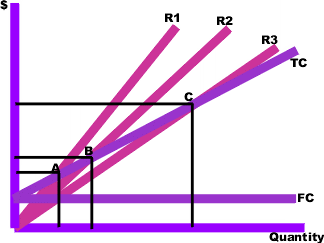
Multiple Break-Even Prices
R1, R2 and R3 = revenues at different chosen prices. TC = total cost curve. FC = fixed cost curve.
In the above graph, points A, B, and C are the break-even points. The break-even quantity at each selling price can be read off the horizontal axis and the break-even price can be read off the vertical axis.
Break-Even Application
Break-even analysis helps to provide a dynamic view of the relationships between sales, costs and profits. By providing a better understanding of the amount of success an investment or project must attain, break-even analysis gives companies a benchmark to compare to and an idea about what level of operating leverage will be ideal to generate greater profits.

Breakeven Example
FC = 1,000. P = 20. VC = 5.
13.4.3: Leverage Models
The relationship between fixed and variable costs, when calculated alongside sales volume, enables modeling of operational leverage.
Learning Objective
Calculate operating leverage using simple cost equations
Key Points
- High fixed costs as a percentage of overall cost has a big impact on the variation that volume can create when it comes to operating margins and leverage.
- The ratio between fixed costs and variable costs has a high impact on the overall risk incurred by a business operation.
- Over time (assuming no new fixed asset investments are required), fixed costs become a smaller percentage of cost per unit while variable costs remain consistent. Increases in volume will therefore result in overall increases in margin.
Key Term
- leverage
-
The ability to utilize something to gain more of something else.
Why Leverage Matters
Before learning each calculation, it’s useful to frame the issue of leverage first. Operating leverage is largely predicated on fixed costs. When fixed costs are high (and variable costs are low), there is quite a bit of risk if the volume of production is low. However, strong increases in revenues will eventually result in substantially higher increase in profitability (as the relative impact of variable costs is lower, and the fixed cost is being divided by higher quantity). The equations below will demonstrate this concept in practice and clarify the concept. What’s important to keep in mind is the importance of fixed costs compared to variable costs, and the impact this can have on financial leverage.
Leverage Models
Most of the calculations and models for leverage are relatively intuitive when looking at examples.
Let’s say you own a business selling coffee. Each cup of coffee you sell costs you about $0.10. You’re want to beat out the competition on price, so you sell your coffees pretty low at $1.00/coffee. As you can see, your variable cost is only 10% of the overall revenue. The rest of those costs (plus the profit left over) fall into the fixed costs category. After being in business for one year, you have spent a total of $100,000 acquiring the fixed assets you need (a small location, coffee machines, grinders, chairs, tables, and other random necessities).
If you sell one cup of coffee, you’ve spent $100,000.10 and made $1.00. Not so profitable at this point, as you can see. Your fixed costs compared to your total costs is pretty much 100%. To find our where you’ll break even, simply subtract the variable cost from the sale price and divide that by the fixed costs (i.e. how many $0.90 profits are required to cover the full $100,000 you owe in fixed costs). Around your 111,111 cup of coffee, you’ll find yourself just about even. After this point, pretty much every cup of coffee you sell if 90% profit and 10% cost. Not bad, right? But it’ll take a lot of leverage to get there, and therefore there is always the risk you’ll go out of business before you make it to your 111,111th cup of coffee.
So, the model for leverage in this case is fixed costs/total costs (or fixed costs/fixed costs + variable costs):
The Degree of Operating Leverage
Calculating the overall degree of operating leverage is an important strategic consideration to make as often as possible. The cleanest way to few this is as the overall change in operating income compared to the overall change in sales:
It is also useful to frame this as the operating margin, which compares the overall revenue to the overall operating income. This is more of a snapshot of the current situation, while the DOL above is more in tune with relative changes over time.
At the core of degree of operating leverage is the same concept discussed in the example above. The overall amount gained per new unit sold changes based on the ratio between fixed and variable costs, and this change is what is being modeled what talking about leverage.
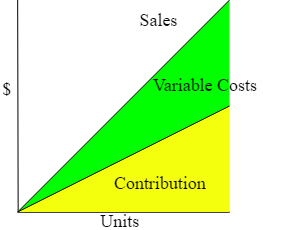
Variable Costs and Contribution
After filtering out the fixed costs, increases in volume will increase both the overall variable expense and the overall contribution.
13.4.4: Benefits and Risks of Operating Leverage
The use of operating leverage can multiply profits when a given break-even point is reached, but it can intensify losses when it is not.
Learning Objective
Identify the types of companies that would benefit from higher operating leverage
Key Points
- The use of leverage necessarily creates a degree of risk. Thus, the use of leverage will always necessitate a tradeoff between risk and return.
- Once a certain break-even point is reached, sales contribute to profits in a much higher capacity than they would if more of the costs were variable.
- The uncertainty of achieving a certain level of sales, and thus breaking even, can be referred to as business risk.
Key Term
- break-even point
-
The point where total costs equal total revenue and the organization neither makes a profit nor suffers a loss.
Leverage, in general, can defined as any technique that is used to multiply gains and losses. By this definition the use of leverage creates risk, and thus will always necessitate a tradeoff between risk and return. As in any situation of this sort, added risk can produce benefits for a firm, but it can also lead to detrimental consequences.
When considering the benefits of operating leverage, it is appropriate to consider the contribution margin, or the excess of sales over variable costs. When variable costs are lower, the contribution of sales to profits will be greater. In other words, a company with higher operating leverage has the potential to generate much larger profits than a company with lower operating leverage. For example, the variable costs for a software company, such as packaging and the cost of various media devices (like CDs), are very low compared to its fixed costs, such as research and development. Therefore, once a certain break-even point is reached, the contribution that sales make to profits is much higher than it would be if a greater portion of the costs were variable.
Problems can arise if a company has very high fixed costs, and if a company has difficulty selling enough units to break even on a particular investment. This is referred to as “business risk,” since it arises from the inherent risk of doing business. In other words, the uncertainty of generating a necessary amount of sales is a dilemma all businesses face. Just as the use of operating leverage can lead to greater profits, if a company is able to reach a given, break-even point, so too can the use of leverage drastically multiply losses if that point is not reached.
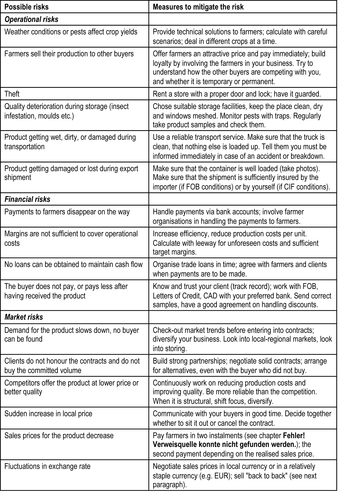
Possible Business Risks
This chart represents a list of the possible risks involved in running an organic business. Risks such as these affect sales, which in turn affect the amount of operating leverage a company should utilize.
13.5: Thinking About Financial Leverage
13.5.1: Defining Financial Leverage
Financial leverage is a tactic to multiply gains and losses, calculated by a debt-to-equity ratio.
Learning Objective
Calculate financial leverage, and recognize the core relationship between risk and return
Key Points
- Leverage is a financial tactic to multiply gains and losses, accomplished through borrowing capital on existing assets.
- Through achieving leverage, organizations can grow exponentially faster due to access to far more resources than their assets would generally allow.
- From a financial point of view, financial leverage is calculated as total debt/shareholder equity.
- When assessing financial leverage, it’s important to recognize the implications on the cost of capital. This is to say, all borrowed money comes with interest, and the weighted average cost of capital (WACC) is a critical in understanding the risk.
- The Lehman Brothers were leverage over 30 times when the financial collapse of 2007-2009 occurred. This degree of risk in unsustainable and highly dangerous not only to the organization, but to the economy at large.
Key Term
- leverage
-
The overall debt divided by shareholder equity. This borrowing allows for the multiplication of gains and losses.
Why Organizations Leverage Finances
At its simplest, leverage is a tactic geared at multiplying gains and losses. Leveraging existing assets to get exponentially more return can be a risk intensive process, and represents a significant aspect of financial strategy and capital structure. Achieving leverage can enable significant competitive advantages despite the risk, however, as it can accelerate the speed of revenue acquisition exponentially.
The standard way to accomplish leverage is through borrowing, via debt and equity, to invest at a much higher scale than one’s current assets would allow. In order to borrow substantial amounts of capital, firms must pursue a variety of financial sourcing and be able to back up their debts with valuable assets (collateral). Even with a great deal of collateral, borrowing big means risking big. Interest rates ensure that the strategic discussions around expanding leverage take into account the risk and return trade offs.
Measuring Leverage
In finance, the best definitions come in equation format. The standard definition of financial leverage is as follows:
In short, the ratio between debt and equity is a strong sign of leverage. As you may already know, equity is ownership of the organization and pays out fairly significant dividends. Debt is often lower cost access to capital, as debt is paid out before equity in the event of a bankruptcy (thus debt is intrinsically lower risk for the investor).
Leverage and Capital Costs
The debt to equity ratio plays a role in the working average cost of capital (WACC) as well, as the overall interest on financing represents the break-even point that must be obtained to achieve profitability in a given venture. WACC is essentially the overall average interest an organization owes on the capital it has borrowed for leverage.
Let’s say equity represents 60% of borrowed capital and debt is 40%. This results in a financial leverage calculation of 40/60, or 0.6667. The organization owes 10% on all equity and 5% on all debt. That means that the weighted average cost of capital is (.4)(5) + (.6)(10) – or 8%. For every $10,000 borrowed, this organization will owe $800 in interest. Profit must be higher than 8% on the project to offset the cost of interest and justify this leverage.
Leverage and the 2007-2009 Recession
A word of caution: Leverage is exponentially more risky the more it is utilized. A useful way to view leverage is the overall existing assets of an organization compared to the amount of money they owe. For example, say you own a company with an overall net worth of $1 million. If you were to be leveraged at a total of 1.5 times (i.e. financed at $1.5 million), this would put you at some risk. Arguably a reasonable amount.
Before Lehman Brothers went bankrupt, they were leveraged at over 30 times ($691 billion in financial leverage compared to $22 billion in assets). A mistake of this scale (on both the lenders and the Lehman Brothers) threatened to topple the global economy itself. It’s important to keep responsibility, accountability, and risk in mind when considering leverage options.
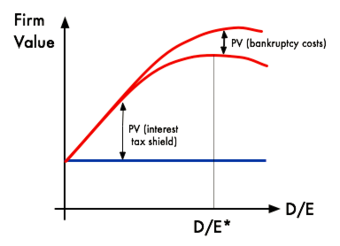
Financial Leverage Firm Value Implications
This graph illustrates a theoretical firm value maximizing curve when it comes to a debt-to-equity ratio. All this means is that each organization has the ideal balance between debt and equity, and finding the ‘sweet spot’ is a useful strategic aspect of financial leverage decisions.
13.5.2: Impacts of Financial Leverage
The use of financial leverage can positively – or negatively – impact a company’s return on equity as a consequence of the increased level of risk.
Learning Objective
Describe how leverage can impact a business
Key Points
- If value is added from financial leveraging then the associated risk will not have a negative effect.
- At an ideal level of financial leverage, a company’s return on equity increases because the use of leverage increases stock volatility, increasing its level of risk which in turn increases returns.
- If earnings before interest and taxes are greater than the cost of financial leverage than the increased risk of leverage will be worthwhile.
Key Terms
- solvency
-
The state of having enough funds or liquid assets to pay all of one’s debts; the state of being solvent.
- liquidity
-
Availability of cash over short term: ability to service short-term debt.
Impacts of Financial Leverage
Taking on debt, as an individual or a company, will always bring about a heightened level of risk due to the fact that income must be used to pay back the debt even if earnings or cash flows go down. From a company’s perspective, the use of financial leverage can positively – or sometimes negatively – impact its return on equity as a consequence of the increased level of risk.
Impact on Return on Equity
Return on equity is the rate of return on the shareholders’ equity of a company’s common stock owners. It measures a firm’s efficiency at generating profits from every unit of shareholders’ equity. Return on equity shows how well a company uses investment funds to generate earnings growth. It can be calculated using the following equation:

Return On Equity
The equation used to calculate return on equity.
At an ideal level of financial leverage, a company’s return on equity increases because the use of leverage increases stock volatility, increasing its level of risk which in turn increases returns. However, if a company is financially over-leveraged a decrease in return on equity could occur. Financial over-leveraging means incurring a huge debt by borrowing funds at a lower rate of interest and using the excess funds in high risk investments. If the risk of the investment outweighs the expected return, the value of a company’s equity could decrease as stockholders believe it to be too risky.
Leverage, Risk, and Misconceptions
The most obvious risk of leverage is that it multiplies losses. Due to financial leverage’s effect on solvency, a company that borrows too much money might face bankruptcy during a business downturn, while a less-levered company may avoid bankruptcy due to higher liquidity. There is a popular prejudice against leverage rooted in the observation of people who borrow a lot of money for personal consumption – for example, heavy use of credit cards. However, in finance the general practice is to borrow money to buy an asset with a higher return than the interest on the debt. Instead of spending money it doesn’t have, a company actually creates value. On the other hand, when debt is taken on for personal use there is no value being created, i.e., no leveraging.
There is also a misconception that companies enter a higher level of financial leverage out of desperation, referred to as involuntary leverage. While involuntary leverage is certainly not a good thing, it is typically caused by eroding equity value as opposed to the addition of more debt. Therefore, it is typically a symptom of the problem, not the cause.
When evaluating the riskiness of leverage it is also important to factor in the value of the company itself and its activities. If a company borrows money to modernize, add to its product line, or expand internationally, the additional diversification will likely offset the additional risk from leverage. The upshot is, if value is expected to be added from the use of financial leverage, the added risk should not have a negative effect on a company or its investments.
13.5.3: Combining Operating Leverage and Financial Leverage
To calculate total leverage, we multiply Degree of Operating Leverage by Degree of Financial Leverage.
Learning Objective
Calculate a company’s total leverage
Key Points
- Total leverage measures the sensitivity of earnings to changes in the level of a company’s sales.
- If the percentage change in earnings and the percentage change in sales are both known, a company can simply divide the percentage change in earnings by the percentage change in sales to determine total leverage.
- Companies usually choose one form of leverage over the other when analyzing potential investments. A company utilizing both forms of leverage undertakes a very high level of risk.
Key Term
- Earnings Per Share
-
The amount of earnings per each outstanding share of a company’s stock.
Combining Operating and Financial Leverage
Operating and financial leverage can be combined into an overall measure called “total leverage. ” Total leverage can be used to measure the total risk of a company and can be defined as the percentage change in stockholder earnings for a given change in sales. In other words, total leverage measures the sensitivity of earnings to changes in the level of a company’s sales.
Methods For Finding Total Leverage
Total leverage can be determined by a couple of different methods. If the percentage change in earnings and the percentage change in sales are both known, a company can simply divide the percentage change in earnings by the percentage change in sales. Earnings can be measured in terms of EBIT, earnings before interest and taxes, or EPS, earnings per share. While EBIT can be determined by referencing a company’s income statement, we can determine earnings per share by dividing the company’s net income by it’s average price of common shares.
Another way to determine total leverage is by multiplying the Degree of Operating Leverage and the Degree of Financial Leverage.

Total Leverage Equation 1
Total leverage = DOL x DOF

Total Leverage Equation 2
Total leverage = DOL x DOF
Therefore:

Total Leverage Equation 3
TL = Total Leverage. P = Unit Revenue. V = Unit Variable Cost. X = Units Sold. FC = Fixed Costs. I = Interest Expense.
Fully derived, we see that to multiply Degree of Operating Leverage and Degree of Financial Leverage, we subtract fixed costs and interest expense from the total contribution margin (revenue minus variable cost times the number of units sold), and divide total contribution margin by this result. Companies usually choose one form of leverage over the other when analyzing potential investments. One that utilizes both forms of leverage undertakes a very high level of risk.
Chapter 12: The Role of Risk in Capital Budgeting
12.1: The Relationship Between Risk and Capital Budgeting
12.1.1: Risks Involved in Capital Budgeting
The process of capital budgeting must take into account the different risks faced by corporations and their managers.
Learning Objective
Identify the different risks that must be accounted for in the capital budgeting process
Key Points
- Capital budgeting (or investment appraisal) is the planning process used to determine whether an organization’s long-term investments are worth pursuing. The risk that can arise here involves the potential that a chosen action or activity (including the choice of inaction) will lead to a loss.
- There are numerous kinds of risks to be taken into account when considering capital budgeting. Each of these risks addresses an area in which some sort of volatility could forcibly alter the plan of firm managers.
- There are different ways to measure and prepare to deal and plan for these risks, including sensitivity analysis, scenario analysis, and break-even analysis among others.
Key Terms
- capital budgeting
-
The planning process used to determine whether an organization’s long term investments, such as new machinery, replacement machinery, new plants, new products, and research development projects are worth pursuing.
- risk
-
The potential that a chosen action or activity (including the choice of inaction) will lead to a loss (an undesirable outcome).
Capital Budgeting
Capital budgeting (or investment appraisal) is the planning process used to determine whether an organization’s long term investments, such as new machinery, replacement machinery, new plants, new products, and research development projects are worth pursuing. When taking on this planning process, managers must take into account the potential risks of the investment not panning out the way they plan for it to, for any number of reasons. In order to discuss this further, we should look into defining the concept or risk.
Risk
Risk is the potential that a chosen action or activity (including the choice of inaction) will lead to a loss (an undesirable outcome). The notion implies that a choice having an influence on the outcome exists (or existed). Potential losses themselves may also be called “risks. “
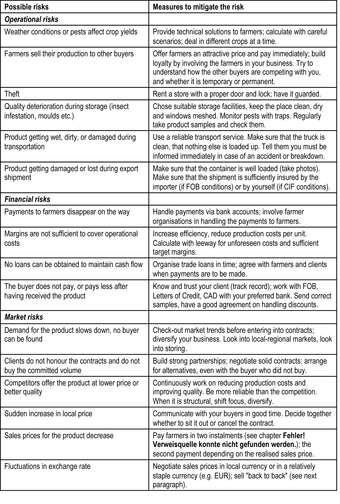
Possible Business Risks
This chart represents a list of the possible risks involved in running an organic business. Risks such as these affect sales, which in turn affect the amount of operating leverage a company should utilize.
There are numerous kinds of risks to be taken into account when considering capital budgeting including:
- corporate risk
- international risk (including currency risk)
- industry-specific risk
- market risk
- stand-alone risk
- project-specific risk
Each of these risks addresses an area in which some sort of volatility could forcibly alter the plan of firm managers. For example, market risk involves the risk of losses in position due to movement in market positions.
There are different ways to measure and prepare to deal with risks as well. One such way is to conduct a sensitivity analysis. Sensitivity analysis is the study of how the uncertainty in the output of a model (numerical or otherwise) can be apportioned to different sources of uncertainty in the model input.
A related practice is uncertainty analysis which focuses rather on quantifying uncertainty in model output. Ideally, uncertainty and sensitivity analysis should be run in tandem. Another method is scenario analysis, which involves the process of analyzing possible future events by considering alternative possible outcomes.
For example, a financial institution might attempt to forecast several possible scenarios for the economy (e.g., rapid growth, moderate growth, slow growth), and it might also attempt to forecast financial market returns (for bonds, stocks, and cash) in each of those scenarios. It might consider sub-sets of each of the possibilities. It might further seek to determine correlations and assign probabilities to the scenarios. Then it will be in a position to consider how to distribute assets between asset types (i.e., asset allocation). The institution can also calculate the scenario-weighted expected return (which figure will indicate the overall attractiveness of the financial environment). It may also perform stress testing, using adverse scenarios.
12.1.2: Risk Aversion
Risk aversion describes how people react to conditions of uncertainty and has implications for investment decisions.
Learning Objective
Evaluate a person’s risk aversion
Key Points
- Risk aversion is the reluctance of a person to accept a bargain with an uncertain payoff rather than another bargain with a more certain, but possibly lower, expected payoff.
- People can be risk averse, risk neutral, or risk loving. A risk averse person will generally take a guaranteed outcome even if it has a lower expected payout than a gamble, while a risk lover will take on the gamble unless the guaranteed payoff is greater than the expected payoff of the gamble.
- Firm management can adopt different stances based on how risk averse they feel they should be, given different market qualities and firm conditions. They will make capital investments that they feel will have the best payoffs, given the risks involved.
Key Term
- Risk Aversion
-
Risk Aversion is a concept that addresses how people will react to a situation with uncertain outcomes. It attempts to measure the tolerance for risk and uncertainty. Risk aversion is the reluctance of a person to accept a bargain with an uncertain payoff rather than another bargain with a more certain, but possibly lower, expected payoff.
In the realm of finance and economics, Risk Aversion is a concept that addresses how people will react to a situation with uncertain outcomes.

High dividend gambles
Risk aversion can be applied to many different situations including investments, lotteries, and any other situations with uncertain outcomes.
It attempts to measure the tolerance for risk and uncertainty. Risk aversion is the reluctance of a person to accept a bargain with an uncertain payoff rather than another bargain with a more certain, but possibly lower, expected payoff. For example, a risk-averse investor might choose to put his or her money into a bank account with a low but guaranteed interest rate instead of investing in a stock that may have high expected returns, but also involves a chance of losing value. Risk aversion can be applied to many different situations, including investments, lotteries, and other situations with uncertain outcomes. Because organizations are composed of individuals, risk aversion at the individual level plays a role in organizational decision making.
People fall under different categories of risk aversion. If we look at an example where a person could receive 50 dollars without risk, or take a gamble where they receive 100 dollars or 0 dollars depending on the outcome of a coin flip, we can explain the differences. We see when we use the expected payoffs of each scenario we see that each has an expected payoff of 50 dollars. Situation one has a 100% chance of getting 50 dollars so it’s expected payoff is (1)(50)=50. For the second situation, the expected payoff deals with a 50-50 chance of getting 100 or 0 dollars so, (.5)(100)+(.5)(0)=50. This is important to know for this example. A risk-averse, or risk avoiding person would take the guaranteed payment of 50, or even less than that (40 or 30) depending on how risk averse they are. A risk neutral person would be indifferent between taking the gamble or the guaranteed money. Finally a risk loving person would take the non-guaranteed chance of possibly winning 100 dollars, rather than settling for the guaranteed option. If the guaranteed option was greater than 50 dollars, then the risk lover might consider the possibility of taking it.
This can be extended to capital budgeting. A firm’s management can adopt different stances based on how risk averse they feel they should be, given different market qualities and firm conditions. They will make capital investments that they feel will have the best payoffs, given the risks involved, and if they take a more risk averse stance they will make capital investment decisions that have a more guaranteed payoff. On the other hand, if they be more risk loving, they will be attracted to the more risky investments for capital that they believe have a chance for higher payoff.
12.1.3: Approaches to Assessing Risk
Some of the quantitative definitions of risk are grounded in statistical theory and lead naturally to statistical estimates, but some are more subjective.
Learning Objective
Define different types of risk
Key Points
- As risk carries so many different meanings, there are many formal methods used to assess or to “measure” risk. Planned actions are subject to large cost and benefit risks, so proper risk assessment and management is crucial to making them successful.
- The assessment of risk is an integral part of risk management in general, and includes probability studies, impact of events, taking into account the affect of every known risk on the project, and the actions needed to resolve these issues, should they occur.
- Behavioral finance focuses on risk-aversion, and other ways that financial behavior varies from what analysts call rational. Here, risk is uncertainty associated with return on assets. In enterprise risk management, risk is an event that can have negative influences on the enterprise in question.
Key Terms
- risk
-
The potential that a chosen action or activity (including the choice of inaction) will lead to a loss (an undesirable outcome).
- Behavioral Finance
-
Field that focuses on human risk-aversion, asymmetric regret, and other ways that human financial behavior varies from what analysts call “rational”.
There are numerous important and applicable approaches to assessing risk in capital budgeting.
Since planned actions are subject to large cost and benefit risks, proper risk assessment and risk management for such actions are crucial to making them successful. As risk carries so many different meanings, there are many formal methods used to assess or to “measure” risk. Some of the quantitative definitions of risk are well-grounded in statistics theory and lead naturally to statistical estimates, but some are more subjective. For example, in many cases a critical factor is human decision making. One can say that in the realm of capital budgeting and corporate finance, both types of risk assessment are crucial.

Inspecting Equipment
Risk can be assessed in a number of ways, and is a critical step in capital budgeting and planning, as well as project management.
The field of behavioral finance focuses on human risk-aversion, asymmetric regret, and other ways that human financial behavior varies from what analysts call “rational”. Risk, in that case, is the degree of uncertainty associated with a return on an asset. In enterprise risk management, a risk is defined as a possible event or circumstance that can have negative influences on the enterprise in question. Its impact can be on the very existence, the resources (human and capital), the products and services, or the customers of the enterprise, as well as external impacts on society, markets, or the environment. In a financial institution, enterprise risk management is normally thought of as the combination of credit risk, interest rate risk or asset liability management, market risk, and operational risk.
In project management, risk management can include: planning how risk will be managed, assigning a risk officer, maintaining a database of live risks, and preparing risk mitigation plans. The assessment of risk is an integral part of risk management in general, and includes probability studies, impact of events, and takes into account the affect of every known risk on the project, and the actions needed to resolve these issues, should they occur.
In the more general case, every probable risk can have a pre-formulated plan to deal with its possible consequences. From the average cost per employee over time, or cost accrual ratio, a project manager can estimate: the cost associated with the risk, if it arises, estimated by multiplying employee costs per unit time by the estimated time lost (cost impact, C where C = cost accrual ratio * S), the probable increase in time associated with a risk (schedule variance due to risk, Rs where Rs = Probability * S). Sorting on this value puts the highest risks to the schedule first. This is intended to cause the greatest risks to the project to be attempted first so that risk is minimized as quickly as possible.This can be slightly misleading as schedule variances with a large P (probability) and small S (estimated time lost) and vice versa are not equivalent. (The risk of the RMS Titanic sinking vs. the passengers’ meals being served at slightly the wrong time).
The probable increase in cost associated with a risk (cost variance due to risk, Rc where Rc = P*C = P*Cost Accrual Ratio*S = P*S*CAR): sorting on this value puts the highest risks to the budget first, which can raise concerns about schedule variance.
12.2: Assessing Stand-Alone Risk
12.2.1: Overview of How to Assess Stand-Alone Risk
Total Beta is a measure used to determine risk of a stand-alone asset, as opposed to one that is a part of a well-diversified portfolio.
Learning Objective
Describe different ways to assess stand-alone risks
Key Points
- Appraisers frequently value assets or investments, such as closely held corporations, as stand-alone assets.
- In terms of finance, the coefficient of variation allows investors to determine how much volatility (risk) they are assuming in relation to the amount of expected return from an investment.
- A lower coefficient of variation indicates a higher expected return with less risk.
Key Terms
- probability distribution
-
A function of a discrete random variable yielding the probability that the variable will have a given value
- correlation coefficient
-
Any of the several measures indicating the strength and direction of a linear relationship between two random variables.
Stand-Alone Risk
Recall that Beta is a number describing the correlated volatility of an asset or investment in relation to the volatility of the market as a whole. However, appraisers frequently value assets or investments, such as closely held corporations, as stand-alone assets. Total Beta is a measure used to determine the risk of a stand-alone asset, as opposed to one that is a part of a well-diversified portfolio. It is able to accomplish this because the correlation coefficient, R, has been removed from Beta. Total Beta can be found using the following formula:
Total Beta =
Another statistical measure that can be used to assess stand-alone risk is the coefficient of variation. In probability theory and statistics, the coefficient of variation is a normalized measure of dispersion of a probability distribution. It is also known as unitized risk or the variation coefficient. In terms of finance, the coefficient of variation allows investors to determine how much volatility (risk) they are assuming in relation to the amount of expected return from an investment. Volatility is measured in the form of the investment’s standard deviation from the mean return, thus the coefficient of variation is this standard deviation divided by expected return. A lower coefficient of variation indicates a higher expected return with less risk.
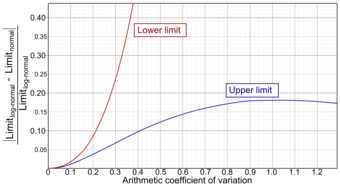
Coefficient of Variation
The coefficient of variation, an example of which is plotted in this graph, can be used to measure the ratio of volatility to expected return.
The coefficient of variation is a dimensionless number, meaning it is independent of the unit in which the measurement has been taken. For this reason, it becomes useful to us in finance to measure the risk of an investment in a way that it is not dependent upon other types of risk, such as that of the overall market.
12.3: Risk and Return
12.3.1: Risk and Return Considerations
The higher the risk undertaken, the more ample the expected return – and conversely, the lower the risk, the more modest the expected return.
Learning Objective
Evaluate a party’s risk aversion when proposing investment opportunities
Key Points
- The general progression in the risk-return spectrum is: short-term debt, long-term debt, property, high-yield debt, and equity.
- When a firm makes a capital budgeting decision, they will wish, as a bare minimum, to recover enough to pay the increased cost of goods due to inflation.
- Risk aversion is a concept based on the behavior of firms and investors while exposed to uncertainty to attempt to reduce that uncertainty.
- Beta is a measure firms can use in order to determine an investment’s return sensitivity in relation to overall market risk.
Key Terms
- political risk
-
the potential loss for a company due to nonmarket factors as macroeconomic and social policies
- inflation
-
An increase in the general level of prices or in the cost of living.
- systematic risk
-
The risk associated with an asset that is correlated with the risk of asset markets generally, often measured as its beta.
Risk and Return Considerations
Risk refers to the variability of possible returns associated with a given investment. Risk, along with the return, is a major consideration in capital budgeting decisions. The firm must compare the expected return from a given investment with the risk associated with it. Higher levels of return are required to compensate for increased levels of risk. In other words, the higher the risk undertaken, the more ample the return – and conversely, the lower the risk, the more modest the return.
This risk and return tradeoff is also known as the risk-return spectrum. There are various classes of possible investments, each with their own positions on the overall risk-return spectrum. The general progression is: short-term debt, long-term debt, property, high-yield debt, and equity. The existence of risk causes the need to incur a number of expenses. For example, the more risky the investment the more time and effort is usually required to obtain information about it and monitor its progress. Moreover, the importance of a loss of X amount of value can be greater than the importance of a gain of X amount of value, so a riskier investment will attract a higher risk premium even if the forecast return is the same as upon a less risky investment. Risk is therefore something that must be compensated for, and the more risk the more compensation is required.
When a firm makes a capital budgeting decision, they will wish, as a bare minimum, to recover enough to pay the increased cost of investment due to inflation. Thus, inflation is a pivotal input in a firm’s cost of capital. However, since interest rates are set by the market, it happens frequently that they are insufficient to compensate for inflation.
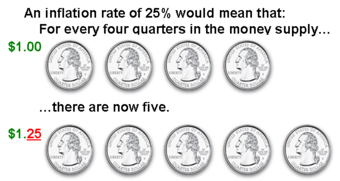
Inflation
Inflation is a rise in the general level of prices of goods and services in an economy over a period of time.
Risk aversion also plays an important role in determining a firm’s required return on an investment. Risk aversion is a concept based on the behavior of firms and investors while exposed to uncertainty to attempt to reduce that uncertainty. Risk aversion is the reluctance to accept a bargain with an uncertain payoff rather than another bargain with a more certain, but possibly lower, expected payoff. For example, a risk-averse investor might choose to put his or her money into a bank account with a low but guaranteed interest rate, rather than into a stock that may have high expected returns, but also involves a chance of losing value. Risk aversion can be thought of as having three levels:
- Risk-averse or risk-avoiding
- Risk-neutral
- Risk-loving or risk-seeking
Beta is a measure firms can use in order to determine an investment’s return sensitivity in relation to overall market risk. Beta describes the correlated volatility of an asset in relation to the volatility of the benchmark that said asset is being compared to. This benchmark is generally the overall financial market and is often estimated via the use of representative indices, such as the S&P 500. Beta is also referred to as financial elasticity or correlated relative volatility, and can be referred to as a measure of the sensitivity of the asset’s returns to market returns, its non-diversifiable risk, its systematic risk, or market risk. Higher-beta investments tend to be more volatile and therefore riskier, but provide the potential for higher returns. Lower-beta investments pose less risk, but generally offer lower returns.
12.4: Scenario and Simulation Assessments
12.4.1: Sensitivity Analysis
Sensitivity analysis determines how much a change in an input will affect the output.
Learning Objective
Describe how sensitivity analysis is used to make investment decisions
Key Points
- Since variations from the base assumptions are expected, businessmen and women want to know how much their output (eg., revenue) will be affected by the variations.
- Sensitivity analysis helps find the optimal levels for inputs (eg., raw material prices, number of employees, sales price) .
- Sensitivity analysis is a statistical tool based on seeing how inputs and parameters affect outputs. Generally, each input is changed one at a time to see how it affects output. However, this does not account for interconnectedness between inputs; they may not be independent variables.
Key Terms
- sensitivity analysis
-
the study of how the uncertainty in the output of a mathematical model or system can be apportioned to different sources of uncertainty in its inputs
- parameter
-
A variable kept constant during an experiment, calculation, or similar.
Capital budgeting is, by definition, forward looking. When dealing with expected resources and demands, uncertainty is a major factor. Sensitivity analysis is a statistical tool that determines how consequential deviations from the expected value occur. Sensitivity Analysis deals with finding out the amount by which we can change the input data for the output of our linear programming model to remain comparatively unchanged. This helps us in determining the sensitivity of the data we supply for the problem. It also helps to determine the optimal levels of each input.
Sensitivity analysis can be useful for a number of reasons, including:
- Support decision making or the development of recommendations for decision makers (e.g., testing the robustness of a result).
- Enhance communication from modelers to decision makers (e.g., by making recommendations more credible, understandable, compelling or persuasive).
- Increase understanding or quantification of the system (e.g., understanding relationships between input and output variables).
- Model development (e.g., searching for errors in the model).
In order to conduct a sensitivity analysis, all of the inputs and parameters are connected via an algorithm to produce the output. For example, a model of the inputs and parameters for a company interest in creating a new product may include information about expected availability of raw material, inflation rates, and number of employees working in R&D. The output would be the profit generated by the new product. The sensitivity analysis entails changing each variable and seeing how that changes the output . Generally, only one variable is changed at once, with all of the others fixed at their base value. This makes it easy to see how much a variable affects the output. However, not all of the inputs may be independent so changing inputs one at a time does not account for interaction between the inputs.
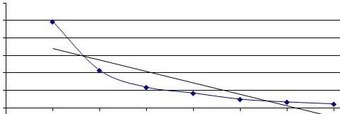
Sensitivity of a Variable
Sensitivity analysis determines how much an output is expected to change due to changes in a variable or parameter. In this case, the output (y-axis) decreases exponentially with an increase in the input (x-axis). This is mapped out for each input.
12.4.2: Scenario Analysis
Scenario analysis is a process of analyzing decisions by considering alternative possible outcomes.
Learning Objective
Explain scenario analysis is used by investors
Key Points
- Scenario analysis is designed to see the consequences of an action under different sets of factors. For example, it shows how an investment’s NPV would differ under high and low inflation.
- Scenarios should be feasible enough to provide an accurate picture of the outcomes. A “good” scenario for an investor should not include winning the lottery because, though good, it is neither probable nor realistic for analyzing possible results.
- Many scenario analyses use 3 scenarios: base case, worst case and best case. However, the number and conditions of the scenarios in each analysis can vary.
Key Terms
- scenario analysis
-
a process of analyzing possible future events by considering alternative possible outcomes
- analysis
-
A process of dismantling or separating into constituent elements in order to study the nature, function, or meaning.
- scenario
-
A set of factors that can affect the consequences of an action. The environment.
Scenario Analysis
Scenario analysis is a strategic process of analyzing decisions by considering alternative possible outcomes (sometimes called “alternative worlds”). It is not a predictive mechanism, but rather an analytic tool to manage uncertainty today. .
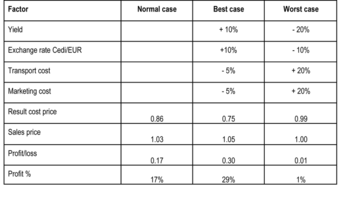
Scenario Analysis
This scenario analysis shows how changes in factors like yield and transport cost can affect profits.
For example, a firm might use scenario analysis to determine the net present value (NPV) of a potential investment under high and low inflation scenarios.
In another example, a bank might attempt to forecast several possible scenarios for the economy (e.g. rapid vs. moderate vs. slow growth) or it might try to forecast financial market returns (for bonds, stocks and cash) in each of those scenarios. Perhaps, it might also consider sub-sets of each of the possibilities. It might further seek to determine correlations and assign probabilities to the scenarios (and sub-sets if any). By analyzing these various scenarios, the bank will be in a better position to consider how best to allocate its assets.
Many scenario analyses use three different scenarios: base case, worst case and best case. The base case is the expected scenario: if all things proceed normally, this is what the expected outcome will be. The worst and best cases are obviously scenarios with less and more favorable conditions, but they are still confined by a sense of feasibility. For example, an investor creating the worst case scenario would not be well served to have it include a meteor strike that destroys the company. While clearly a bad scenario, it is not realistic enough to be helpful.
The purpose of scenario analysis is not to identify the exact conditions of each scenario; it just needs to approximate them to provide a plausible idea of what might happen.
12.4.3: Monte Carlo Simulation
Monte Carlo simulation uses statistical data to figure out the average outcome of a scenario based on multiple, complex factors.
Learning Objective
Describe how Monte Carlo simulations are used
Key Points
- The statistical distribution is estimated for each input (eg. inflation rate, market risk). Then, simulations are run to see how constantly changing inputs (based on their distribution) affect the output. The outputs are averaged to find the estimated output.
- Monte Carlo simulations are great for when there are multiple inputs that can all change and may be unrelated.
- Monte Carlo simulations can be applied in many areas of business, such as bond pricing, but are especially useful when estimating the “base case” is difficult to do by hand.
Key Term
- distribution
-
A probability distribution; the set of relative likelihoods that a variable will have a value in a given interval.
In order to account of complex, interconnected factors, all of which may affect financial outcomes, companies turn to statistical methods. The Monte Carlo method solves a problem by directly simulating the underlying process and then calculating the average result of the process. It simulates the various sources of uncertainty (eg. inflation, default risk, market changes, etc.) that affect the value of the instrument, portfolio, or investment in question, and calculates a representative value given these possible values of the underlying inputs. In essence, the Monte Carlo method is designed to find out what happens to the outcome on average when there are changes in the inputs.
Each potential factor is assigned a probability or statistical distribution. For example, the investor may estimate the probability of default on a bond as 20%. That means that 20% of the time, he will not earn back his principal. The investor may also estimate that the inflation rate is normally distributed around a mean of 3% and standard deviation of 0.5%.
The investor estimates the probability or distribution of every factor that could change the result of the investment. Then, he essentially uses the distributions to run many many simulations of all the inputs to see how they affect the output and then finds the average output .
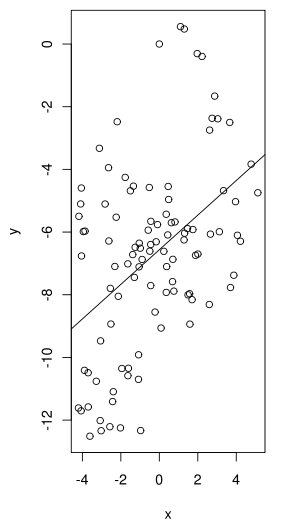
Monte Carlo Simulation
By running many simulations based on the probability or distribution of an input (x), the analyst can see the average output (y). This is done for multiple inputs at once to find out how they affect the output.
For example, for bonds and bond options, under each possible evolution of interest rates the investor observes a different yield curve and a different resultant bond price. To determine the bond value, these bond prices are then averaged. To value the bond option, as for equity options, the corresponding exercise values are averaged and present valued. By determining the average, the investor can figure out what the expected value is.
The advantage of the Monte Carlo method is that it is able to handle multiple moving, and possible related, inputs. As the number of factors increases, it becomes harder to figure out the “base case. ” Statistical analysis through Monte Carlo simulations is great at handling problems with multiple, inter-related, and uncertain factors.
12.4.4: Decision Trees
A decision tree is a decision support tool that uses a tree-like graph or model of decisions and their possible consequences.
Learning Objective
Describe how to set up a decision tree
Key Points
- Decision trees look similar to flow charts, except they are designed to pick the most optimal strategy.
- There are three types of nodes on a decision tree: decision nodes, chance nodes, and end nodes.
- Decision trees are solved from top to bottom in order to determine the most optimal strategy. Sometimes, there may not be an obvious optimal strategy, but the tree is still useful for mapping out the options faced and their costs/benefits.
Key Term
- node
-
A vertex point on a decision tree. Other branches may extend from it; if none do, it is an end node.
A decision tree is a decision support tool that uses a tree-like graph or model of decisions and their possible consequences, including chance event outcomes, resource costs, and utility. They help to identify the strategy that is most likely to reach the declared goal. For an investor, this may be used to help determine which bond to buy in order to get the highest expected return with only a certain amount of risk. Decision trees are set up much like an organizational flow chart.
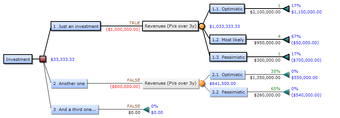
Decision Tree
This decision tree highlights the outcomes of different investing strategies. Next to the terminal nodes is blue text with the yield and gain.
Unlike a flow chart, a decision tree consists of three types of nodes:
- Decision nodes – commonly represented by squares – the user gets to decide which branch to take.
- Chance nodes – represented by circles – the branch taken is determined by probabilities.
- End nodes – represented by triangles – there are no more branches extending from the node, and the final value of the strategy is listed.
In order to set up and use a decision tree, the user must first list each decision point. For example, in , the investor first listed the number of investments that could be made (1, 2, or 3) and then the options for the likely payoffs (optimistic, most likely, etc.). Each end node was given a value. Working from left to right (or top to bottom), the investor determined that making one investment has the highest expected value ($641,500 vs. $0). Therefore, the investor will definitely choose to make one investment. Then, to determine the payoff, the probabilities and yields are listed. This is a chance node, so the investor doesn’t know how much he will earn from the investment, but does know his options.
Decision trees can become very complex, so determining the correct strategy becomes more difficult. Decision trees are always solved from the top to the bottom (or left to right) and is just a process of picking the most optimal path or seeing the likely payoffs.
There may not be an idea strategy shown on the decision tree. In that case, the decision tree is still useful as a way to map out all of the possible strategies with their costs and benefits.
12.5: Factors Impacting Capital Budgeting
12.5.1: Risk Adjusting the Discount Rate
Discount rates are adjusted on an investment to investment basis, as different investments encounter different degrees of risk that must be considered when determining equitable returns.
Learning Objective
Realize the reasoning behind adjusting discount rates for risk, and the way this impacts the cost of capital
Key Points
- In central banking, the established discount rate will act as the benchmark for future interest rates issued. This cost will be adjusted on an investment to investment basis depending upon the degree of risk.
- Discount rates are utilized in net present value calculations (NPV) in order to determine the rate of risk and return a new venture or new project should provide.
- Calculating NPV is an extremely useful tool. An NPV analysis will take future expectations of cost and revenue and ground them in present day dollars (to take into account the time value of money). This shows if/when a project will be profitable.
- When adjusting the NPV calculation for additional risks, and thus risk-adjusting the discount rate, a variety of factors can be taken into consideration. A rNPV (risk-adjusting NPV) will assign a probability to each incoming cash flow to adjust expectations of risk in the calculation.
Key Term
- discounted cash flow
-
An estimated future cash flow discounted by the probability of receiving that cash flow.
What is the Discount Rate?
The discount rate has a few definitions, depending on the context. For the sake of this discussion, the discount rate is the percentage used in an net present value calculation to understand the overall cost of capital (or, from the perspective of some investors, the required return) on a given project. What this means is that there is a rate, calculated by the assumption of risk, which is used to normalize the interest rate on borrowed capital (for the borrower) and/or invested capital (for the lender.
In U.S. central banking, the interest rate that banks pay the federal reserve when using securities as collateral is also referred to as the discount rate, and in this case it will act as the benchmark for future interest rates issued.
Why Adjust for Risk?
The primary purpose of a discount rate, or an interest rate in general, is fairly simple. Capital today is worth more than capital tomorrow, due to the time value of money (i.e. the opportunity cost of foregone investments). As a result of this concept, the idea of interest rates is justified. All this means is that a borrower of capital will have to take into account the cost of that capital over a given time period, which will be calculated as an additional percentage of the overall principal borrowed being added to the principal itself on a period to period basis.
In this context, the interest rate is subjected to risk. A riskier investment will require a higher return (due to the basic premise of risk and return). After all, why invest in a riskier investment when safer investments exist unless that riskier investment offers a higher percentage of return? It is at this point that the logic behind adjusting discount rates becomes practical. All discount rates must take into account the overall risk being assumed in the investment, and adjust the rate of expected return to meet the implications of the overall risk over time. For banks, for example, the overall interest rate they would offer a risky entrepreneurial project isn’t the same as the rate they would offer an established big business.
Risk-adjusted Net Present Value
A net present value calculation is a common and useful tool that takes the overall future projected costs and returns of a new venture or business project and grounds it in today’s dollars. What this means is it calculates out the time value of money during the projected time period of the financing of the project in order to see if the returns over a given time period will exceed the costs in beginning the project. As an entrepreneur, this will tell you if/when you will reach profitability (using a variety of assumptions). It is calculated as follows:
Adjusting this for the risk-adjusted discount rate is a simple modification, where each future cash flow is multiplied by the estimated likelihood of its occurrence. In this situation, a higher degree of uncertainty (and thus risk) is built into each expected cash flow (called a discounted cash flow, or DCF). Through discounting each cash flow by the estimated probability of receiving that return, the overall riskiness of the NPV calculation is increased. With this increase in risk, the discount rate can now be risk-adjusted accordingly.
Common Risk-adjusted Discount Rates
It is important to note at this point that every calculation is different, and some start-ups will see low discount rates because investors believe strongly in what the start up is trying to accomplish. However, the discount rates typically applied to different types of companies show significant differences:
- Early start-ups: 40–60%
- More established start-ups: 30–50%
- Mature companies: 10–25%
All and all, investors must carefully consider the risk in a given investment, and adjust the discount rates accordingly. This ensures a proper assessment of the risk and return ratio for various differentiated investment projects.
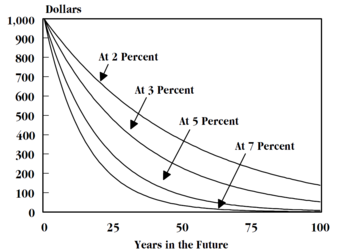
Discounting Curves
This chart illustrates the devaluation of capital over time as a result of various discount rates.
12.5.2: Risk Adjusting for the Time Horizon
A longer time horizon usually requires a higher return, due to increased price volatility and uncertainty relating to possible outcomes.
Learning Objective
Explain how an investement’s duration can influence its inherent risk
Key Points
- In terms of debt investments, default risk increases as the time horizon lengthens.
- Since stock investments have more time to overcome potential downturns in value, having a longer time horizon can justify more aggressive investing.
- When there are multiple possible outcomes, management of a firm may choose to undertake real options analysis in order to factor in the various possibilities.
Key Terms
- salvage value
-
The estimated value of an asset at the end of its useful life.
- time horizon
-
The period of time the asset is expected to be held or a project is expected to last.
Risk Adjusting for the Time Horizon
When evaluating the riskiness of an investment, not only will investors or companies need to evaluate their preferences and risk tolerance, but it is also necessary to take into account the time horizon of the investment. A longer time horizon will generally require a higher return, due to an increased risk in price volatility and increased uncertainty relating to possible outcomes. In terms of long term debt investments, such as long term corporate or government bonds, a longer time horizon gives rise to uncertainties in the potential operations of the debtor entity as well as unforeseen movements in the market as a whole. In other words, default risk increases as the time horizon lengthens. However, when considering stock investments, having a longer time horizon can be considered safer in some respects. Since stock investments have more time to overcome potential downturns in value, having a longer time horizon can justify more aggressive investing. For example, an individual investor with a time horizon of less than five years should not be invested in stocks. However, those with time horizons over five years should consider stocks because of their growth potential. Put simply, as time horizon lengthens a higher percentages of stocks should be added to a portfolio.
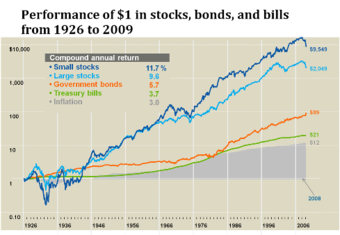
Performance of Stocks, Bonds and Bills
This graph gives an illustration of investing a dollar in different asset classes in the market from 1926 to the end of 2007.
For an individual, diversifying investments in different time horizons is also important. By staying in the market through different market cycles, individuals can reduce the risk of receiving a lower return than expected–especially with investments that fluctuate significantly over the short term.
Real Options Consideration
When there are multiple possible outcomes, management of a firm may choose to undertake real options analysis in order to factor in the various possibilities. A real option itself is the right, but not the obligation, to undertake certain business initiatives, such as deferring, abandoning, expanding, staging, or contracting a capital investment project. When uncertainty exists as to when and how business or other conditions will eventuate, flexibility as to the timing of the relevant project is valuable and constitutes optionality. Some examples include Inflation or deferment options, where management has flexibility as to when to start a project. For example, in natural resource exploration a firm can delay mining a deposit until market conditions are favorable. Also, an option to abandon, where management may have the option to cease a project during its life, and, possibly, to realize its salvage value. Here, when the present value of the remaining cash flows falls below this salvage value, the asset may be sold. Finally, sequencing options, where management can observe outcomes from a part of a project and resolve some of the uncertainty relating to the venture overall. Once resolved, management has the option to proceed or not with the development of the other projects.
12.6: Other Considerations in Capital Budgeting
12.6.1: Other Considerations in Capital Budgeting
The real option creates economic value by generating future decision rights for management.
Learning Objective
Describe how options influence capital budgeting and investment decisions
Key Points
- Traditional NPV analysis fails to consider that management can adapt and revise its strategies in response to unexpected market and technological developments that cause cash flows to deviate from their original expectations.
- The notion of real options was developed from the idea that one can view firms’ discretionary investment opportunities as a call option on real assets, in much the same way as a financial call option provides decision rights on financial assets.
- The option to defer an investment creates value because exogenous uncertainty can be reduced with the passage of time.
- Growth options are investments made not only for immediate cash flows from the project, but also for the economic value derived from subsequent investment opportunities.
Key Terms
- propensity
-
A tendency, preference, or attraction.
- net present value
-
the present value of a project or an investment decision determined by summing the discounted incoming and outgoing future cash flows resulting from the decision
Real Options and Capital Budgeting
Traditional capital budgeting theory holds that investments should be made when the simple net present value (NPV) of an investment opportunity equals or exceeds zero. It also assumes that the investment must be made either now or never. However, such an investment approach fails to consider that management can adapt and revise its strategies in response to unexpected market and technological developments that cause cash flows to deviate from their original expectations. In other words, it fails to capture managers’ flexibility in adapting their decisions to evolving market and technological uncertainty. The notion of real options was developed from the idea that one can view firms’ discretionary investment opportunities as a call option on real assets, in much the same way as a financial call option provides decision rights on financial assets.
A simple financial option gives its holder the right, but not the obligation, to buy or sell a specified quantity of an underlying asset at a specified price at or before a specified date. By analogy, a real option confers on the firm the right, but not the obligation, to take some action in the future. The option is “real” because the underlying assets are usually physical and human assets rather than financial securities. The commonality in applying option-pricing models for real assets and for financial securities is that the future is uncertain. In an uncertain environment, having the flexibility to decide what to do after some of that uncertainty is resolved has value. A key feature is that the real option creates economic value by generating future decision rights – specifically, by offering management the flexibility to act upon new information such that the upside economic potential is retained while the downside losses are contained .
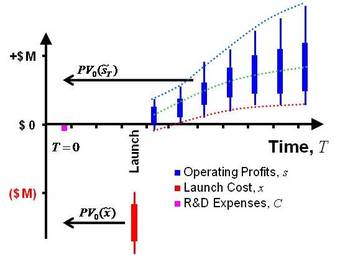
Project Cash Flow With Uncertainty
Projects with real options can be evaluated using a range of possible profits.
Real Options and Investment Decisions
A strategic implication of real options theory is that investment will be discouraged by exogenous uncertainty. For this reason, the timing of an investment can be crucial in determining its profitability. In other words, the option to defer an investment creates value because exogenous uncertainty can be reduced with the passage of time.
Another value-creating aspect of real options can be found in abandonment. The abandonment options comes into play when a firm purchases an asset that it may later resell or put to an alternative use, should future conditions be sufficiently adverse. Availability and recognition of this option will increase a firm’s propensity to invest relative to what would be suggested by a simple NPV rule, which assumes that the investment project continues for its physical lifetime and omits the possibility of future divestment.
Growth Options
Real investments are often made not only for immediate cash flows from the project, but also for the economic value derived from subsequent investment opportunities. Such future discretionary investment opportunities are known as growth options. For example, firms usually undertake research and development investments to strategically position themselves for the economic value from commercialization when market conditions turn favorable. Similarly, firms usually make foothold investments in a new foreign market for the possibility of expansion in the future. Such growth-oriented investment may appear uneconomical when viewed in isolation but may enable firms to capture future growth opportunities.
Chapter 11: Capital Budgeting
11.1: Introduction to Capital Budgeting
11.1.1: Defining Capital Budgeting
Capital budgeting is the planning process used to determine which of an organization’s long term investments are worth pursuing.
Learning Objective
Differentiate between the different capital budget methods
Key Points
- Capital budgeting, which is also called investment appraisal, is the planning process used to determine whether an organization’s long term investments, major capital, or expenditures are worth pursuing.
- Major methods for capital budgeting include Net present value, Internal rate of return, Payback period, Profitability index, Equivalent annuity and Real options analysis.
- The IRR method will result in the same decision as the NPV method for non-mutually exclusive projects in an unconstrained environment; Nevertheless, for mutually exclusive projects, the decision rule of taking the project with the highest IRR may select a project with a lower NPV.
Key Terms
- Modified Internal Rate of Return
-
The modified internal rate of return (MIRR) is a financial measure of an investment’s attractiveness. It is used in capital budgeting to rank alternative investments of equal size. As the name implies, MIRR is a modification of the internal rate of return (IRR) and, as such, aims to resolve some problems with the IRR.
- APT
-
In finance, arbitrage pricing theory (APT) is a general theory of asset pricing that holds, which holds that the expected return of a financial asset can be modeled as a linear function of various macro-economic factors or theoretical market indices, where sensitivity to changes in each factor is represented by a factor-specific beta coefficient.
Example
- Payback period: For example, a $1000 investment which returned $500 per year would have a two year payback period. The time value of money is not taken into account.
Capital Budgeting
Capital budgeting, which is also called “investment appraisal,” is the planning process used to determine which of an organization’s long term investments such as new machinery, replacement machinery, new plants, new products, and research development projects are worth pursuing. It is to budget for major capital investments or expenditures.
Major Methods
Many formal methods are used in capital budgeting, including the techniques as followed:
- Net present value
- Internal rate of return
- Payback period
- Profitability index
- Equivalent annuity
- Real options analysis
Net Present Value
Net present value (NPV) is used to estimate each potential project’s value by using a discounted cash flow (DCF) valuation. This valuation requires estimating the size and timing of all the incremental cash flows from the project. The NPV is greatly affected by the discount rate, so selecting the proper rate–sometimes called the hurdle rate–is critical to making the right decision.
This should reflect the riskiness of the investment, typically measured by the volatility of cash flows, and must take into account the financing mix. Managers may use models, such as the CAPM or the APT, to estimate a discount rate appropriate for each particular project, and use the weighted average cost of capital(WACC) to reflect the financing mix selected. A common practice in choosing a discount rate for a project is to apply a WACC that applies to the entire firm, but a higher discount rate may be more appropriate when a project’s risk is higher than the risk of the firm as a whole.
Internal Rate of Return
The internal rate of return (IRR) is defined as the discount rate that gives a net present value (NPV) of zero. It is a commonly used measure of investment efficiency.
The IRR method will result in the same decision as the NPV method for non-mutually exclusive projects in an unconstrained environment, in the usual cases where a negative cash flow occurs at the start of the project, followed by all positive cash flows. Nevertheless, for mutually exclusive projects, the decision rule of taking the project with the highest IRR, which is often used, may select a project with a lower NPV.
One shortcoming of the IRR method is that it is commonly misunderstood to convey the actual annual profitability of an investment. Accordingly, a measure called “Modified Internal Rate of Return (MIRR)” is often used.
Payback Period
Payback period in capital budgeting refers to the period of time required for the return on an investment to “repay” the sum of the original investment. Payback period intuitively measures how long something takes to “pay for itself. ” All else being equal, shorter payback periods are preferable to longer payback periods.
The payback period is considered a method of analysis with serious limitations and qualifications for its use, because it does not account for the time value of money, risk, financing, or other important considerations, such as the opportunity cost.
Profitability Index
Profitability index (PI), also known as profit investment ratio (PIR) and value investment ratio (VIR), is the ratio of payoff to investment of a proposed project. It is a useful tool for ranking projects, because it allows you to quantify the amount of value created per unit of investment.
Equivalent Annuity
The equivalent annuity method expresses the NPV as an annualized cash flow by dividing it by the present value of the annuity factor. It is often used when comparing investment projects of unequal lifespans. For example, if project A has an expected lifetime of seven years, and project B has an expected lifetime of 11 years, it would be improper to simply compare the net present values (NPVs) of the two projects, unless the projects could not be repeated.
Real Options Analysis
The discounted cash flow methods essentially value projects as if they were risky bonds, with the promised cash flows known. But managers will have many choices of how to increase future cash inflows or to decrease future cash outflows. In other words, managers get to manage the projects, not simply accept or reject them. Real options analysis try to value the choices–the option value–that the managers will have in the future and adds these values to the NPV.
These methods use the incremental cash flows from each potential investment or project. Techniques based on accounting earnings and accounting rules are sometimes used. Simplified and hybrid methods are used as well, such as payback period and discounted payback period.
11.1.2: The Goals of Capital Budgeting
The main goals of capital budgeting are not only to control resources and provide visibility, but also to rank projects and raise funds.
Learning Objective
Describe the goals of the capital budgeting process
Key Points
- Basically, the purpose of budgeting is to provide a forecast of revenues and expenditures and construct a model of how business might perform financially.
- Capital Budgeting is most involved in ranking projects and raising funds when long-term investment is taken into account.
- Capital budgeting is an important task as large sums of money are involved and a long-term investment, once made, can not be reversed without significant loss of invested capital.
Key Terms
- Preferred Stock
-
Preferred stock (also called preferred shares, preference shares or simply preferreds) is an equity security with properties of both an equity and a debt instrument, and is generally considered a hybrid instrument.
- Common stock
-
Common stock is a form of corporate equity ownership, a type of security.
The purpose of budgeting is to provide a forecast of revenues and expenditures. That is, to construct a model of how a business might perform financially if certain strategies, events, and plans are carried out. It enables the actual financial operation of the business to be measured against the forecast, and it establishes the cost constraint for a project, program, or operation.
Budgeting helps to aid the planning of actual operations by forcing managers to consider how the conditions might change, and what steps should be taken in such an event. It encourages managers to consider problems before they arise. It also helps co-ordinate the activities of the organization by compelling managers to examine relationships between their own operation and those of other departments.
Other essential functions of a budget include:
- To control resources
- To communicate plans to various responsibility center managers
- To motivate managers to strive to achieve budget goals
- To evaluate the performance of managers
- To provide visibility into the company’s performance
Capital Budgeting, as a part of budgeting, more specifically focuses on long-term investment, major capital and capital expenditures. The main goals of capital budgeting involve:
Ranking Projects
The real value of capital budgeting is to rank projects. Most organizations have many projects that could potentially be financially rewarding. Once it has been determined that a particular project has exceeded its hurdle, then it should be ranked against peer projects (e.g. – highest Profitability index to lowest Profitability index). The highest ranking projects should be implemented until the budgeted capital has been expended.

Private Equity
Private equity firms, such as NBGI, provide funds for companies unable or uninterested in obtaining funds publicly.
Raising funds
When a corporation determines its capital budget, it must acquire funds. Three methods are generally available to publicly-traded corporations: corporate bonds, preferred stock, and common stock. The ideal mix of those funding sources is determined by the financial managers of the firm and is related to the amount of financial risk that the corporation is willing to undertake.
Corporate bonds entail the lowest financial risk and, therefore, generally have the lowest interest rate. Preferred stock have no financial risk but dividends, including all in arrears, must be paid to the preferred stockholders before any cash disbursements can be made to common stockholders; they generally have interest rates higher than those of corporate bonds. Finally, common stocks entail no financial risk but are the most expensive way to finance capital projects.The Internal Rate of Return is very important.
Capital budgeting is an important task as large sums of money are involved, which influences the profitability of the firm. Plus, a long-term investment, once made, cannot be reversed without significant loss of invested capital. The implication of long-term investment decisions are more extensive than those of short-run decisions because of the time factor involved; capital budgeting decisions are subject to a higher degree of risk and uncertainty than are short-run decisions.

Goals of capital budgeting
The main goal of capital budgeting is to rank projects.
11.1.3: Accounting Flows and Cash Flows
Capital budgeting requires a thorough understanding of cash flow and accounting principles, particularly as they pertain to valuing processes and investments.
Learning Objective
Identify the various sources of cash flow within an organization
Key Points
- Accounting revolves around tracking the inflows and outflows of assets, capital, and resources for an organization to adhere to legal and investor expectations.
- When measuring the impact of assets, liabilities, and equity, it is useful to know in which situations to debit or credit the line item based upon the flow of capital.
- Cash flows analyses, such as the internal rate of return (IRR) or the net present value (NPV) of a given process, are core tools in capital budgeting for understanding and estimating cash flows.
- Cash flow analyses can include investing, operating and financing activities.
Key Terms
- internal rate of return (IRR)
-
A calculation that makes the net present value of all cash flows (positive and negative) from a particular investment equal to zero. It can also be described as the rate which will make an investment break even.
- net present value (NPV)
-
This calculation takes all future cash flows from a given operational initiative, and discounts them to their present value based on the weighted average cost of capital.
Accounting Flows
Accounting is the processes used to identify and transpose business transactions into permanent legal records of a business’s operations and capital flows. The International Accounting Standards (IAS) and the Generally Accepted Accounting Principles (GAAP) are legislative descriptions of expectations and norms within the accounting field.
When it comes to the capital flows in accounting, it is easiest to visualize it based on each type of item:

Accounting Flows
This chart is a useful way to see the trajectory of accounting flows as they apply to different types of line items.
Understanding how to report each type of asset, and the impacts these asset changes have on income statements, balance sheets, and cash flow statements, is important in accurately depicting accounting flows.
Cash Flows
A cash flow is one element of accounting flows, and particularly important to understanding capital budgeting. A cash flow describes the transmission of payments and returns internally and/or externally as a byproduct of operations over time. Conducting cash flow analyses on current or potential projects and investments is a critical aspect of capital budgeting, and determines the profitability, cost of capital, and/or expected rate of return on a given project, organizational operation or investment.
Cash flow analyses can reveal the rate of return, or value of suggested project, through deriving the internal rate of return (IRR) and the net present value (NPV). They also indicate overall liquidity, or a business’s capacity to capture existing opportunities through freeing of capital for future investments. Cash flows will also underline overall profitability including, but not limited to, net income.
Cash flows consolidate inputs from the following activities:
- Investing activities – Payments related to mergers or acquisitions, loans made to suppliers or received from customers, as well as the purchase or sale of assets are all considered investing activities and tracked as incoming or outgoing cash flows.
- Operating activities – Operating activities can be quite broad, incorporating anything related to the production, sale, or delivery of a given product or service. This includes raw materials, advertising, shipping, inventory, payments to suppliers and employee, interest payments, depreciation, deferred tax, and amortization.
- Financing activities – Financing activities primarily revolve around cash inflows from banks and shareholders, as well as outflows via dividends to investors. This includes, payment for repurchase of company shares, dividends, net borrowing and net repayment of debt.
11.1.4: Ranking Investment Proposals
Several methods are commonly used to rank investment proposals, including NPV, IRR, PI, payback period, and ARR.
Learning Objective
Analyze investment proposals by ranking them using different methods
Key Points
- The higher the NPV, the more attractive the investment proposal.
- The higher a project’s IRR, the more desirable it is to undertake the project.
- As the value of the profitability index increases, so does the financial attractiveness of the proposed project.
- Shorter payback periods are preferable to longer payback periods.
- The higher the ARR, the more attractive the investment.
Key Terms
- time value of money
-
The time value of money is the value of money, figuring in a given amount of interest earned over a given amount of time.
- discounted cash flow
-
In finance, discounted cash flow (DCF) analysis is a method of valuing a project, company, or asset using the concepts of the time value of money.
The most valuable aim of capital budgeting is to rank investment proposals. To choose the most valuable investment option, several methods are commonly used:

Investment Proposal
Choosing the best investment proposal for business
Net Present Value (NPV):
NPV can be described as the “difference amount” between the sums of discounted: cash inflows and cash outflows. In the case when all future cash flows are incoming, and the only outflow of cash is the purchase price, the NPV is simply the PV of future cash flows minus the purchase price (which is its own PV). The higher the NPV, the more attractive the investment proposal. NPV is a central tool in discounted cash flow (DCF) analysis and is a standard method for using the time value of money to appraise long-term projects. Used for capital budgeting and widely used throughout economics, finance, and accounting, it measures the excess or shortfall of cash flows, in present value terms, once financing charges are met.

NPV formula
Each cash inflow/outflow is discounted back to its present value (PV). Then they are summed. Therefore, NPV is the sum of all terms.
In financial theory, if there is a choice between two mutually exclusive alternatives, the one yielding the higher NPV should be selected. The rules of decision making are:
- When NPV > 0, the investment would add value to the firm so the project may be accepted
- When NPV < 0, the investment would subtract value from the firm so the project should be rejected
- When NPV = 0, the investment would neither gain nor lose value for the firm. We should be indifferent in the decision whether to accept or reject the project. This project adds no monetary value. Decision should be based on other criteria (e.g., strategic positioning or other factors not explicitly included in the calculation).
An NPV calculated using variable discount rates (if they are known for the duration of the investment) better reflects the situation than one calculated from a constant discount rate for the entire investment duration.
Internal Rate of Return (IRR)
The internal rate of return on an investment or project is the “annualized effective compounded return rate” or “rate of return” that makes the net present value (NPV as NET*1/(1+IRR)^year) of all cash flows (both positive and negative) from a particular investment equal to zero.
IRR calculations are commonly used to evaluate the desirability of investments or projects. The higher a project’s IRR, the more desirable it is to undertake the project. Assuming all projects require the same amount of up-front investment, the project with the highest IRR would be considered the best and undertaken first.
Profitability Index (PI)
It is a useful tool for ranking projects, because it allows you to quantify the amount of value created per unit of investment. The ratio is calculated as follows:
Profitability index = PV of future cash flows / Initial investment
As the value of the profitability index increases, so does the financial attractiveness of the proposed project. Rules for selection or rejection of a project:
- If PI > 1 then accept the project
- If PI < 1 then reject the project
Payback Period
Payback period intuitively measures how long something takes to “pay for itself. ” All else being equal, shorter payback periods are preferable to longer payback periods. Payback period is widely used because of its ease of use despite the recognized limitations: The time value of money is not taken into account.
Accounting Rate of Return (ARR)
The ratio does not take into account the concept of time value of money. ARR calculates the return, generated from net income of the proposed capital investment. The ARR is a percentage return. Say, if ARR = 7%, then it means that the project is expected to earn seven cents out of each dollar invested. If the ARR is equal to or greater than the required rate of return, the project is acceptable. If it is less than the desired rate, it should be rejected. When comparing investments, the higher the ARR, the more attractive the investment. Basic formulae:
ARR = Average profit / Average investment
Where: Average investment = (Book value at beginning of year 1 + Book value at end of user life) / 2
11.1.5: Reinvestment Assumptions
NPV and PI assume reinvestment at the discount rate, while IRR assumes reinvestment at the internal rate of return.
Learning Objective
Identify the reinvestment assumptions of different capital budgeting methods
Key Points
- If trying to decide between alternative investments in order to maximize the value of the firm, the reinvestment rate would be a better choice.
- NPV and PI assume reinvestment at the discount rate.
- IRR assumes reinvestment at the internal rate of return.
Key Term
- Weighted average cost of capital
-
The weighted average cost of capital (WACC) is the rate that a company is expected to pay on average to all its security holders to finance its assets.
Example
- At the end of the first quarter, the investor had capital of $1,010.00, which then earned $10.10 during the second quarter. The extra dime was interest on his additional $10 investment.
Reinvestment Rate
To some extent, the selection of the discount rate is dependent on the use to which it will be put. If the intent is simply to determine whether a project will add value to the company, using the firm’s weighted average cost of capital may be appropriate. If trying to decide between alternative investments in order to maximize the value of the firm, the corporate reinvestment rate would probably be a better choice.

Reinvestment
Reinvestment to expand business

Reinvestment Factor
Describe how the reinvestment factors related to total return.
NPV Reinvestment Assumption
The rate used to discount future cash flows to the present value is a key variable of this process. A firm’s weighted average cost of capital (after tax) is often used, but many people believe that it is appropriate to use higher discount rates to adjust for risk or other factors. A variable discount rate with higher rates applied to cash flows occurring further along the time span might be used to reflect the yield curve premium for long-term debt.
Another approach to choosing the discount rate factor is to decide the rate that the capital needed for the project could return if invested in an alternative venture. Related to this concept is to use the firm’s reinvestment rate. Reinvestment rate can be defined as the rate of return for the firm’s investments on average. When analyzing projects in a capital constrained environment, it may be appropriate to use the reinvestment rate, rather than the firm’s weighted average cost of capital as the discount factor. It reflects opportunity cost of investment, rather than the possibly lower cost of capital.
PI Reinvestment Assumption
Profitability index assumes that the cash flow calculated does not include the investment made in the project, which means PI reinvestment at the discount rate as NPV method. A profitability index of 1 indicates break even. Any value lower than one would indicate that the project’s PV is less than the initial investment. As the value of the profitability index increases, so does the financial attractiveness of the proposed project.
IRR Reinvestment Assumption
As an investment decision tool, the calculated IRR should not be used to rate mutually exclusive projects but only to decide whether a single project is worth the investment. In cases where one project has a higher initial investment than a second mutually exclusive project, the first project may have a lower IRR (expected return) but a higher NPV (increase in shareholders’ wealth) and, thus, should be accepted over the second project (assuming no capital constraints).
IRR assumes reinvestment of interim cash flows in projects with equal rates of return (the reinvestment can be the same project or a different project). Therefore, IRR overstates the annual equivalent rate of return for a project that has interim cash flows which are reinvested at a rate lower than the calculated IRR. This presents a problem, especially for high IRR projects, since there is frequently not another project available in the interim that can earn the same rate of return as the first project.
When the calculated IRR is higher than the true reinvestment rate for interim cash flows, the measure will overestimate–sometimes very significantly–the annual equivalent return from the project. This makes IRR a suitable (and popular) choice for analyzing venture capital and other private equity investments, as these strategies usually require several cash investments throughout the project, but only see one cash outflow at the end of the project (e.g., via IPO or M&A).
When a project has multiple IRRs, it may be more convenient to compute the IRR of the project with the benefits reinvested. Accordingly, MIRR is used, which has an assumed reinvestment rate, usually equal to the project’s cost of capital.

Calculation of the MIRR
MIRR is calculated as follows:
11.1.6: Long-Term vs. Short-Term Financing
Long-term financing is generally for assets and projects and short term financing is typically for continuing operations.
Learning Objective
Classify the different financing methods between short-term and long-term
Key Points
- Management must match long-term financing or short-term financing mix to the assets being financed in terms of both timing and cash flow.
- Long-term financing includes equity issued, Corporate bond, Capital notes and so on.
- Short-term financing includes Commercial papers, Promissory notes, Asset-based loans, Repurchase agreements, letters of credit and so on.
Key Terms
- Swap
-
In finance, a swap is a derivative in which counterparties exchange cash flows of one party’s financial instrument for those of the other party’s financial instrument.
- Call option
-
A call option, often simply labeled a “call”, is a financial contract between two parties, the buyer and the seller of this type of option. [1] The buyer of the call option has the right, but not the obligation to buy an agreed quantity of a particular commodity or financial instrument (the underlying) from the seller of the option at a certain time (the expiration date) for a certain price (the strike price)
- accounts receivable
-
Accounts receivable also known as Debtors, is money owed to a business by its clients (customers) and shown on its balance sheet as an asset.
Achieving the goals of corporate finance requires appropriate financing of any corporate investment. The sources of financing are, generically, capital that is self-generated by the firm and capital from external funders, obtained by issuing new debt and equity.
Management must attempt to match the long-term or short-term financing mix to the assets being financed as closely as possible, in terms of both timing and cash flows.

Financing
To manage business often requires long-term and short-term financing.
Long-Term Financing
Businesses need long-term financing for acquiring new equipment, R&D, cash flow enhancement and company expansion. Major methods for long-term financing are as follows:
Equity Financing
This includes preferred stocks and common stocks and is less risky with respect to cash flow commitments. However, it does result in a dilution of share ownership, control and earnings. The cost of equity is also typically higher than the cost of debt – which is, additionally, a deductible expense – and so equity financing may result in an increased hurdle rate which may offset any reduction in cash flow risk.
Corporate Bond
A corporate bond is a bond issued by a corporation to raise money effectively so as to expand its business. The term is usually applied to longer-term debt instruments, generally with a maturity date falling at least a year after their issue date.
Some corporate bonds have an embedded call option that allows the issuer to redeem the debt before its maturity date. Other bonds, known as convertible bonds, allow investors to convert the bond into equity.
Capital Notes
Capital notes are a form of convertible security exercisable into shares. They are equity vehicles. Capital notes are similar to warrants, except that they often do not have an expiration date or an exercise price (hence, the entire consideration the company expects to receive, for its future issue of shares, is paid when the capital note is issued). Many times, capital notes are issued in connection with a debt-for-equity swap restructuring: instead of issuing the shares (that replace debt) in the present, the company gives creditors convertible securities – capital notes – so the dilution will occur later.
Short-Term Financing
Short-term financing can be used over a period of up to a year to help corporations increase inventory orders, payrolls and daily supplies. Short-term financing includes the following financial instruments:
Commercial Paper
This is an unsecured promissory note with a fixed maturity of 1 to 364 days in the global money market. It is issued by large corporations to get financing to meet short-term debt obligations. It is only backed by an issuing bank or corporation’s promise to pay the face amount on the maturity date specified on the note. Since it is not backed by collateral, only firms with excellent credit ratings from a recognized rating agency will be able to sell their commercial paper at a reasonable price.
Asset-backed commercial paper (ABCP) is a form of commercial paper that is collateralized by other financial assets. ABCP is typically a short-term instrument that matures between 1 and 180 days from issuance and is typically issued by a bank or other financial institution.
Promissory Note
This is a negotiable instrument, wherein one party (the maker or issuer) makes an unconditional promise in writing to pay a determinate sum of money to the other (the payee), either at a fixed or determinable future time or on demand of the payee, under specific terms.
Asset-based Loan
This type of loan, often short term, is secured by a company’s assets. Real estate, accounts receivable (A/R), inventory and equipment are typical assets used to back the loan. The loan may be backed by a single category of assets or a combination of assets (for instance, a combination of A/R and equipment).
Repurchase Agreements
These are short-term loans (normally for less than two weeks and frequently for just one day) arranged by selling securities to an investor with an agreement to repurchase them at a fixed price on a fixed date.
Letter of Credit
This is a document that a financial institution or similar party issues to a seller of goods or services which provides that the issuer will pay the seller for goods or services the seller delivers to a third-party buyer. The issuer then seeks reimbursement from the buyer or from the buyer’s bank. The document serves essentially as a guarantee to the seller that it will be paid by the issuer of the letter of credit, regardless of whether the buyer ultimately fails to pay.
11.2: The Payback Method
11.2.1: Defining the Payback Method
The payback method is a method of evaluating a project by measuring the time it will take to recover the initial investment.
Learning Objective
Define the payback method
Key Points
- The payback period is the number of months or years it takes to return the initial investment.
- To calculate a more exact payback period: payback period = amount to be invested / estimated annual net cash flow.
- The payback method also ignores the cash flows beyond the payback period; thus, it ignores the long-term profitability of a project.
Key Terms
- Opportunity cost
-
The cost of an opportunity forgone (and the loss of the benefits that could be received from that opportunity); the most valuable forgone alternative.
- cost of capital
-
the rate of return that capital could be expected to earn in an alternative investment of equivalent risk
- time value of money
-
The value of money, figuring in a given amount of interest, earned over a given amount of time.
Example
- A $1000 investment which returned $500 per year would have a two year payback period.
Defining the Payback Method
In capital budgeting, the payback period refers to the period of time required for the return on an investment to “repay” the sum of the original investment.
As a tool of analysis, the payback method is often used because it is easy to apply and understand for most individuals, regardless of academic training or field of endeavor. When used carefully to compare similar investments, it can be quite useful. As a stand-alone tool to compare an investment, the payback method has no explicit criteria for decision-making except, perhaps, that the payback period should be less than infinity.
The payback method is considered a method of analysis with serious limitations and qualifications for its use, because it does not account for the time value of money, risk, financing or other important considerations, such as opportunity cost. While the time value of money can be rectified by applying a weighted average cost of capital discount, it is generally agreed that this tool for investment decisions should not be used in isolation. Alternative measures of “return” preferred by economists are net present value and internal rate of return. An implicit assumption in the use of the payback method is that returns to the investment continue after the payback period. The payback method does not specify any required comparison to other investments or even to not making an investment .

Capital Investment in Plant and Property
The payback method is a simple way to evaluate the number of years or months it takes to return the initial investment.
The payback period is usually expressed in years. Start by calculating net cash flow for each year: net cash flow year one = cash inflow year one – cash outflow year one. Then cumulative cash flow = (net cash flow year one + net cash flow year two + net cash flow year three). Accumulate by year until cumulative cash flow is a positive number, which will be the payback year.
11.2.2: Calculating the Payback Period
To calculate a more exact payback period: Payback Period = Amount to be initially invested / Estimated Annual Net Cash Inflow.
Learning Objective
Calculate an investment’s payback period
Key Points
- Payback period is usually expressed in years. Start by calculating Net Cash Flow for each year, then accumulate by year until Cumulative Cash Flow is a positive number: that year is the payback year.
- Some businesses modified this method by adding the time value of money to get the discounted payback period. They discount the cash inflows of the project by the cost of capital, and then follow usual steps of calculating the payback period.
- Additional complexity arises when the cash flow changes sign several times (i.e., it contains outflows in the midst or at the end of the project lifetime). The modified payback period algorithm may be applied.
Key Terms
- discounted payback period
-
The discounted payback period is the amount of time that it takes to cover the cost of a project, by adding positive discounted cash flow coming from the profits of the project.
- payback period
-
the amount of time required for the return on an investment to return the sum of the original investment
- cumulative
-
having priority rights to receive a dividend that accrue until paid
Payback period in capital budgeting refers to the period of time required for the return on an investment to “repay” the sum of the original investment.
Payback period is usually expressed in years. Start by calculating Net Cash Flow for each year: Net Cash Flow Year 1 = Cash Inflow Year 1 – Cash Outflow Year 1. Then Cumulative Cash Flow = (Net Cash Flow Year 1 + Net Cash Flow Year 2 + Net Cash Flow Year 3 … etc.) Accumulate by year until Cumulative Cash Flow is a positive number: that year is the payback year.
To calculate a more exact payback period:
Payback Period = Amount to be initially invested / Estimated Annual Net Cash Inflow.
Payback period method does not take into account the time value of money. Some businesses modified this method by adding the time value of money to get the discounted payback period. They discount the cash inflows of the project by a chosen discount rate (cost of capital), and then follow usual steps of calculating the payback period.
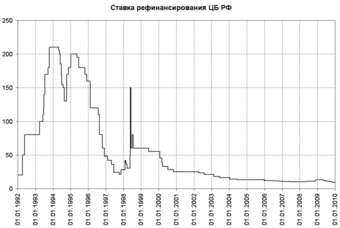
Discount rate
Discount rate set by Central Bank of Russia in 1992-2009.
Additional complexity arises when the cash flow changes sign several times (i.e., it contains outflows in the midst or at the end of the project lifetime). The modified payback period algorithm may be applied then. First, the sum of all of the cash outflows is calculated. Then the cumulative positive cash flows are determined for each period. The modified payback period is calculated as the moment in which the cumulative positive cash flow exceeds the total cash outflow.
Let’s take a look at one example. Year 0: -1000, year 1: 4000, year 2: -5000, year 3: 6000, year 4: -6000, year 5: 7000. The sum of all cash outflows = 1000 + 5000 + 6000 = 12000.
The modified payback period is in year 5, since the cumulative positive cash flows (17000) exceeds the total cash outflows (12000) in year 5. To be more detailed, the payback period would be: 4 + 2/7 = 4.29 year.
11.2.3: Discounted Payback
The payback method is more effective at accurately projecting payback periods when it is discounted to incorporate the time value of money.
Learning Objective
Apply the concept of time value of money to the payback method
Key Points
- The payback method simply projects incoming cash flows from a given project and identifies the break even point between profit and paying back invested money for a given process.
- However, the payback method does not take into account the time value of money. To do so, you simply need to discount the payback based upon a cost of capital or interest rate.
- Using the discounted cash flow analysis equation, it’s relatively simple to account for the time value of money when applied to payback periods.
Key Term
- payback method
-
A simple calculation that allows an assessment of the cost of a project via the time it will take to be repaid.
The Payback Method
The payback method is quite a simple concept. The majority of business projects (or even entire business plans for an organization) will require capital. When investing capital into a project, it will take a certain amount of time before the profits from the endeavor offset the capital requirements. Of course, if the project will never make enough profit to cover the start up costs, it is not an investment to pursue. In the simplest sense, the project with the shortest payback period is most likely the best of possible investments (lowest risk at any rate).
Time Value
Time is a commodity with cost from a financial point of view. For example, a project that costs $100,000 and pays back within 6 years is not as valuable as a project that costs $100,000 which pays back in 5years. Having the money sooner means more potential investment (and thus less opportunity cost). The shorter time scale project also would appear to have a higher profit rate in this situation, making it better for that reason as well.
If a payback method does not take into account the time value of money, the real net present value (NPV) of a given project is not being calculated. This is a significant strategic omission, particularly relevant in longer term initiatives. As a result, all corporate financial assessments should discount payback to weigh in the opportunity costs of capital being locked up in the project.
Discounted Payback
One way to do this is to discount projected cash flows into present dollars based upon the cost of capital. So a simple example of a payback period without time value of money (without discounted payback) would be as follows:
A project costs $10,000. It will return $2,000 each year in profit (after all expenses and taxes). This means that it’ll take a total of 5 years without a time value of money discount being applied. However, applying time value of money is a fairly simple process, and can be accomplished utilizing the discounted cash flow analysis equation:
For the sake of simplicity, let’s assume the cost of capital is 10% (as your one and only investor can turn 10% on this money elsewhere and it is their required rate of return). If this is the case, each cash flow would have to be $2,638 to break even within 5 years. At your expected $2,000 each year, it will take over 7 years for full pay back.
As you can see, discounting the payback period can have enormous impacts on profitability. Understanding and accounting for the time value of money is an important aspect of strategic thinking.
11.2.4: Advantages of the Payback Method
Payback period as a tool of analysis is easy to apply and easy to understand, yet effective in measuring investment risk.
Learning Objective
Describe the advantages of using the payback method
Key Points
- Payback period, as a tool of analysis, is often used because it is easy to apply and easy to understand for most individuals, regardless of academic training or field of endeavor.
- The payback period is an effective measure of investment risk. It is widely used when liquidity is an important criteria to choose a project.
- Payback period method is suitable for projects of small investments. It not worth spending much time and effort in sophisticated economic analysis in such projects.
Key Terms
- Opportunity cost
-
The cost of an opportunity forgone (and the loss of the benefits that could be received from that opportunity); the most valuable forgone alternative.
- cost of capital
-
the rate of return that capital could be expected to earn in an alternative investment of equivalent risk
- time value of money
-
The value of money, figuring in a given amount of interest, earned over a given amount of time.
Payback period in capital budgeting refers to the period of time required for the return on an investment to “repay” the sum of the original investment.
Payback period, as a tool of analysis, is often used because it is easy to apply and easy to understand for most individuals, regardless of academic training or field of endeavor. When used carefully or to compare similar investments, it can be quite useful. All else being equal, shorter payback periods are preferable to longer payback periods. As a stand-alone tool to compare an investment to “doing nothing,” payback period has no explicit criteria for decision-making (except, perhaps, that the payback period should be less than infinity).
The term is also widely used in other types of investment areas, often with respect to energy efficiency technologies, maintenance, upgrades, or other changes. For example, a compact fluorescent light bulb may be described as having a payback period of a certain number of years or operating hours, assuming certain costs. Here, the return to the investment consists of reduced operating costs. Although primarily a financial term, the concept of a payback period is occasionally extended to other uses, such as energy payback period (the period of time over which the energy savings of a project equal the amount of energy expended since project inception). These other terms may not be standardized or widely used.
The payback period is an effective measure of investment risk. The project with a shortest payback period has less risk than with the project with longer payback period. The payback period is often used when liquidity is an important criteria to choose a project .
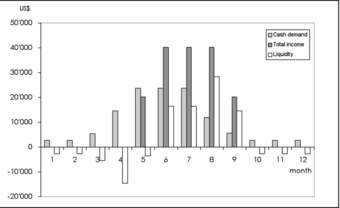
Monthly liquidity of an organic vegetable business
Cash demand is high from April to August. The business is more likely to use payback period to choose a project.
Payback period method is suitable for projects of small investments. It not worth spending much time and effort on sophisticated economic analysis in such projects.

Capital Investment in Plant and Property
The payback method is a simple way to evaluate the number of years or months it takes to return the initial investment.
11.2.5: Disadvantages of the Payback Method
Payback period analysis ignores the time value of money and the value of cash flows in future periods.
Learning Objective
Explain the disadvantages of the Payback Method
Key Points
- Payback ignores the time value of money.
- Payback ignores cash flows beyond the payback period, thereby ignoring the “profitability” of a project.
- To calculate a more exact payback period: Payback Period = Amount to be Invested/Estimated Annual Net Cash Flow.
Key Terms
- cost of capital
-
the rate of return that capital could be expected to earn in an alternative investment of equivalent risk
- return
-
Gain or loss from an investment.
- Opportunity cost
-
The cost of an opportunity forgone (and the loss of the benefits that could be received from that opportunity); the most valuable forgone alternative.
Disadvantages of the Payback Method
The payback period is considered a method of analysis with serious limitations and qualifications for its use, because it does not account for the time value of money, risk, financing, or other important considerations, such as the opportunity cost. While the time value of money can be rectified by applying a weighted average cost of capital discount, it is generally agreed that this tool for investment decisions should not be used in isolation. Alternative measures of “return” preferred by economists are net present value and internal rate of return. An implicit assumption in the use of payback period is that returns to the investment continue after the payback period. Payback period does not specify any required comparison to other investments or even to not making an investment.

Zhuhai sea front development
Payback is the amount of time it takes to return an initial investment; however, it does not account for the time value of money, risk, financing, or other important considerations, such as the opportunity cost.
Payback ignores the time value of money. For example, two projects are viewed as equally attractive if they have the same payback regardless of when the payback occurs. If both project require an initial investment of $300,000, but Project 1 has a payback of one year and Project two of three years, the projects are viewed equally, although Project 1 is more valuable because additional interest could be earned on the funds in year two and three.
Payback also ignores the cash flows beyond the payback period, thereby ignoring the profitability of the project. Thus, one project may be more valuable than another based on future cash flows, but the payback method does not capture this.
Additional complexity arises when the cash flow changes sign several times (i.e., it contains outflows in the midst or at the end of the project lifetime). The modified payback period algorithm may be applied then. First, the sum of all of the cash outflows is calculated. Then the cumulative positive cash flows are determined for each period. The modified payback period is calculated as the moment in which the cumulative positive cash flow exceeds the total cash outflow.
11.3: Internal Rate of Return
11.3.1: Defining the IRR
IRR is a rate of return used in capital budgeting to measure and compare the profitability of investments; the higher IRR, the more desirable the project.
Learning Objective
Explain how Internal Rate of Return is used in capital budgeting
Key Points
- The IRR of an investment is the discount rate at which the net present value of costs (negative cash flows) of the investment equals the net present value of the benefits (positive cash flows) of the investment.
- The higher a project’s IRR, the more desirable it is to undertake the project.
- A firm (or individual) should, in theory, undertake all projects or investments available with IRRs that exceed the cost of capital. Investment may be limited by availability of funds to the firm and/or by the firm’s capacity or ability to manage numerous projects.
Key Term
- effective interest rate
-
The effective interest rate, effective annual interest rate, annual equivalent rate (AER), or simply effective rate is the interest rate on a loan or financial product restated from the nominal interest rate as an interest rate with annual compound interest payable in arrears.
The internal rate of return (IRR) or economic rate of return (ERR) is a rate of return used in capital budgeting to measure and compare the profitability of investments. It is also called the “discounted cash flow rate of return” (DCFROR) or the rate of return (ROR). In the context of savings and loans the IRR is also called the “effective interest rate. ” The term “internal” refers to the fact that its calculation does not incorporate environmental factors (e.g., the interest rate or inflation).
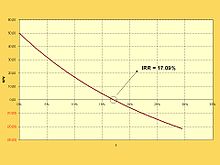
IRR
Showing the position of the IRR on the graph of NPV(r) (r is labelled ‘i’ in the graph).
The internal rate of return on an investment or project is the “annualized effective compounded return rate” or “rate of return” that makes the net present value (NPV as NET*1/(1+IRR)^year) of all cash flows (both positive and negative) from a particular investment equal to zero. In more specific terms, the IRR of an investment is the discount rate at which the net present value of costs (negative cash flows) of the investment equals the net present value of the benefits (positive cash flows) of the investment.
IRR calculations are commonly used to evaluate the desirability of investments or projects. The higher a project’s IRR, the more desirable it is to undertake the project. Assuming all projects require the same amount of up-front investment, the project with the highest IRR would be considered the best and undertaken first. A firm (or individual) should, in theory, undertake all projects or investments available with IRRs that exceed the cost of capital. Investment may be limited by availability of funds to the firm and/or by the firm’s capacity or ability to manage numerous projects.
11.3.2: Calculating the IRR
Given a collection of pairs (time, cash flow), a rate of return for which the net present value is zero is an internal rate of return.
Learning Objective
Calculate a project’s internal rate of return
Key Points
- Given the (period, cash flow) pairs (n, Cn) where n is a positive integer, the total number of periods N, and the net present value NPV, the internal rate of return is given by the function in which NPV = 0.
- Any fixed time can be used in place of the present (e.g., the end of one interval of an annuity); the value obtained is zero if and only if the NPV is zero.
- If the IRR is greater than the cost of capital, accept the project. If the IRR is less than the cost of capital, reject the project.
Key Terms
- cost of capital
-
the rate of return that capital could be expected to earn in an alternative investment of equivalent risk
- net present value profile
-
a graph of the sum of all cash inflows and outflows adjusted for the time value of money at different discount rates
Given a collection of pairs (time, cash flow) involved in a project, the internal rate of return follows from the net present value as a function of the rate of return. A rate of return for which this function is zero is an internal rate of return.
Given the (period, cash flow) pairs (n, Cn) where n is a positive integer, the total number of periods N, and the net present value NPV, the internal rate of return is given by r in:

Calculating IRR
NPV formula with r as IRR
The period is usually given in years, but the calculation may be made simpler if r is calculated using the period in which the majority of the problem is defined (e.g., using months if most of the cash flows occur at monthly intervals) and converted to a yearly period thereafter. Any fixed time can be used in place of the present (e.g., the end of one interval of an annuity); the value obtained is zero if and only if the NPV is zero.
For example, if an investment may be given by the sequence of cash flows:
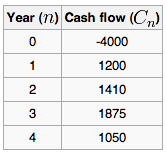
Calculating IRR
Cash flows and time
Because the internal rate of return on an investment or project is the “annualized effective compounded return rate” or “rate of return” that makes the net present value of all cash flows (both positive and negative) from a particular investment equal to zero, then the IRR r is given by the formula:

Calculating IRR
IRR is the rate at which NPV = 0.
In this case, the answer is 14.3%. If the IRR is greater than the cost of capital, accept the project. If the IRR is less than the cost of capital, reject the project.
11.3.3: Advantages of the IRR Method
The IRR method is easily understood, it recognizes the time value of money, and compared to the NPV method is an indicator of efficiency.
Learning Objective
Describe the advantages of using the internal rate of return over other types of capital budgeting methods
Key Points
- The IRR method is very clear and easy to understand. An investment is considered acceptable if its internal rate of return is greater than an established minimum acceptable rate of return or cost of capital.
- The IRR method also uses cash flows and recognizes the time value of money.
- The internal rate of return is a rate quantity, an indicator of the efficiency, quality, or yield of an investment.
Key Terms
- capital budgeting
-
The budgeting process in which a company plans its capital expenditure (the spending on assets of long-term value).
- cost of capital
-
the rate of return that capital could be expected to earn in an alternative investment of equivalent risk
The internal rate of return (IRR) or economic rate of return (ERR) is a rate of return used in capital budgeting to measure and compare the profitability of investment. IRR calculations are commonly used to evaluate the desirability of investments or projects. The higher a project’s IRR, the more desirable it is to undertake the project.
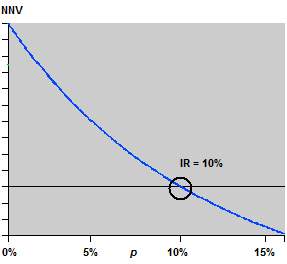
Internal rate of return
Internal rate of return is the rate at which the NPV of an investment equals 0.
One advantage of the IRR method is that it is very clear and easy to understand. Assuming all projects require the same amount of up-front investment, the project with the highest IRR would be considered the best and undertaken first. A firm (or individual) should, in theory, undertake all projects or investments available with IRRs that exceed the cost of capital. In other words, an investment is considered acceptable if its internal rate of return is greater than an established minimum acceptable rate of return or cost of capital. Most analysts and financial managers can understand the opportunity costs of a company. If the IRR exceeds this rate, then the project provides financial accretion. However, if the rate of an investment is projected to be below the IRR, then the investment would destroy company value. IRR is used in many company financial profiles due its clarity for all parties.
The IRR method also uses cash flows and recognizes the time value of money. Compared to payback period method, IRR takes into account the time value of money. This is because the IRR method expects high interest rate from investments.
In addition, the internal rate of return is a rate quantity, it is an indicator of the efficiency, quality, or yield of an investment. This is in contrast with the net present value, which is an indicator of the value or magnitude of an investment.
11.3.4: Disadvantages of the IRR Method
IRR can’t be used for exclusive projects or those of different durations; IRR may overstate the rate of return.
Learning Objective
Describe the disadvantages of using IRR for capital budging purposes
Key Points
- The first disadvantage of IRR method is that IRR, as an investment decision tool, should not be used to rate mutually exclusive projects, but only to decide whether a single project is worth investing in.
- IRR overstates the annual equivalent rate of return for a project whose interim cash flows are reinvested at a rate lower than the calculated IRR.
- IRR does not consider cost of capital; it should not be used to compare projects of different duration.
- In the case of positive cash flows followed by negative ones and then by positive ones, the IRR may have multiple values.
Key Terms
- mutually exclusive
-
Describing multiple events or states of being such that the occurrence of any one implies the non-occurrence of all the others.
- duration
-
A measure of the sensitivity of the price of a financial asset to changes in interest rates, computed for a simple bond as a weighted average of the maturities of the interest and principal payments associated with it
The first disadvantage of the IRR method is that IRR, as an investment decision tool, should not be used to rate mutually exclusive projects but only to decide whether a single project is worth investing in. In cases where one project has a higher initial investment than a second mutually exclusive project, the first project may have a lower IRR (expected return), but a higher NPV (increase in shareholders’ wealth) and should thus be accepted over the second project (assuming no capital constraints).
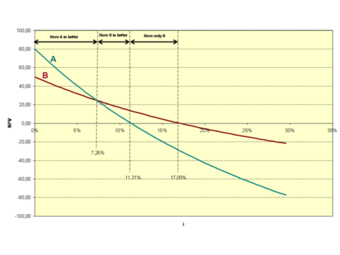
Disadvantage of IRR
NPV vs discount rate comparison for two mutually exclusive projects. Project A has a higher NPV (for certain discount rates), even though its IRR (= x-axis intercept) is lower than for project B
In addition, IRR assumes reinvestment of interim cash flows in projects with equal rates of return (the reinvestment can be the same project or a different project). Therefore, IRR overstates the annual equivalent rate of return for a project whose interim cash flows are reinvested at a rate lower than the calculated IRR. This presents a problem, especially for high IRR projects, since there is frequently not another project available in the interim that can earn the same rate of return as the first project. When the calculated IRR is higher than the true reinvestment rate for interim cash flows, the measure will overestimate–sometimes very significantly–the annual equivalent return from the project. The formula assumes that the company has additional projects, with equally attractive prospects, in which to invest the interim cash flows.
Moreover, since IRR does not consider cost of capital, it should not be used to compare projects of different duration. Modified Internal Rate of Return (MIRR) does consider cost of capital and provides a better indication of a project’s efficiency in contributing to the firm’s discounted cash flow.
Last but not least, in the case of positive cash flows followed by negative ones and then by positive ones, the IRR may have multiple values.
11.3.5: Multiple IRRs
When cash flows of a project change sign more than once, there will be multiple IRRs; in these cases NPV is the preferred measure.
Learning Objective
Explain the best way to evaluate a project that has multiple internal rates of return
Key Points
- In the case of positive cash flows followed by negative ones and then by positive ones, the IRR may have multiple values.
- It has been shown that with multiple internal rates of return, the IRR approach can still be interpreted in a way that is consistent with the present value approach provided that the underlying investment stream is correctly identified as net investment or net borrowing.
- NPV remains the “more accurate” reflection of value to the business. IRR, as a measure of investment efficiency may give better insights in capital constrained situations. However, when comparing mutually exclusive projects, NPV is the appropriate measure.
Key Terms
- Modified Internal Rate of Return
-
The modified internal rate of return (MIRR) is a financial measure of an investment’s attractiveness. It is used in capital budgeting to rank alternative investments of equal size. As the name implies, MIRR is a modification of the internal rate of return (IRR) and, as such, aims to resolve some problems with the IRR.
- mutually exclusive
-
Describing multiple events or states of being such that the occurrence of any one implies the non-occurrence of all the others.
In the case of positive cash flows followed by negative ones and then by positive ones, the IRR may have multiple values. In this case a discount rate may be used for the borrowing cash flow and the IRR calculated for the investment cash flow. This applies for example when a customer makes a deposit before a specific machine is built.
In a series of cash flows like (−10, 21, −11), one initially invests money, so a high rate of return is best, but then receives more than one possesses, so then one owes money, so now a low rate of return is best. In this case it is not even clear whether a high or a low IRR is better. There may even be multiple IRRs for a single project, like in the above example 0% as well as 10%. Examples of this type of project are strip mines and nuclear power plants, where there is usually a large cash outflow at the end of the project.
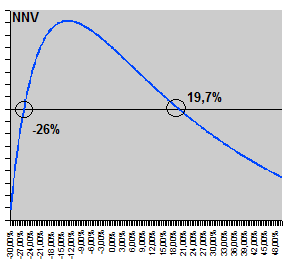
Multiple internal rates of return
As cash flows of a project change sign more than once, there will be multiple IRRs. NPV is a preferable metric in these cases.
When a project has multiple IRRs, it may be more convenient to compute the IRR of the project with the benefits reinvested. Accordingly, Modified Internal Rate of Return (MIRR) is used, which has an assumed reinvestment rate, usually equal to the project’s cost of capital.
It has been shown that with multiple internal rates of return, the IRR approach can still be interpreted in a way that is consistent with the present value approach provided that the underlying investment stream is correctly identified as net investment or net borrowing.
Despite a strong academic preference for NPV, surveys indicate that executives prefer IRR over NPV. Apparently, managers find it easier to compare investments of different sizes in terms of percentage rates of return than by dollars of NPV. However, NPV remains the “more accurate” reflection of value to the business. IRR, as a measure of investment efficiency may give better insights in capital constrained situations. However, when comparing mutually exclusive projects, NPV is the appropriate measure.
11.3.6: Modified IRR
The MIRR is a financial measure of an investment’s attractiveness; it is used to rank alternative investments of equal size.
Learning Objective
Calculate a project’s modified internal rate of return
Key Points
- MIRR is a modification of the internal rate of return (IRR) and as such aims to resolve some problems with the IRR.
- More than one IRR can be found for projects with alternating positive and negative cash flows, which leads to confusion and ambiguity. MIRR finds only one value.
- MIRR = {[FV(positive cash flows, reinvestment rate)/-PV(negative cash flows, finance rate)]^(1/n)}-1.
Key Terms
- cost of capital
-
the rate of return that capital could be expected to earn in an alternative investment of equivalent risk
- reinvestment rate
-
The annual yield at which cash flows from an investment can be reinvested.
The modified internal rate of return (MIRR) is a financial measure of an investment’s attractiveness. It is used in capital budgeting to rank alternative investments of equal size. As the name implies, MIRR is a modification of the internal rate of return (IRR) and as such aims to resolve some problems with the IRR.
While there are several problems with the IRR, MIRR resolves two of them. Firstly, IRR assumes that interim positive cash flows are reinvested at the same rate of return as that of the project that generated them. This is usually an unrealistic scenario and a more likely situation is that the funds will be reinvested at a rate closer to the firm’s cost of capital. The IRR therefore often gives an unduly optimistic picture of the projects under study. Generally, for comparing projects more fairly, the weighted average cost of capital should be used for reinvesting the interim cash flows. Secondly, more than one IRR can be found for projects with alternating positive and negative cash flows, which leads to confusion and ambiguity. MIRR finds only one value.
MIRR is calculated as follows:

MIRR
The formula for calculating MIRR.
Where n is the number of equal periods at the end of which the cash flows occur (not the number of cash flows), PV is present value (at the beginning of the first period), and FV is future value (at the end of the last period).
The formula adds up the negative cash flows after discounting them to time zero using the external cost of capital, adds up the positive cash flows including the proceeds of reinvestment at the external reinvestment rate to the final period, and then works out what rate of return would cause the magnitude of the discounted negative cash flows at time zero to be equivalent to the future value of the positive cash flows at the final time period.
Let take a look at one example. If an investment project is described by the sequence of cash flows: Year 0: -1000, year 1: -4000, year 2: 5000, year 3: 2000. Then the IRR is given by: NPV = -1000 – 4000 * (1+r)-1 + 5000*(1+r)-2 + 2000*(1+r)-3 = 0. IRR can be 25.48%, -593.16% or -132.32%.
To calculate the MIRR, we will assume a finance rate of 10% and a reinvestment rate of 12%. First, we calculate the present value of the negative cash flows (discounted at the finance rate): PV(negative cash flows, finance rate) = -1000 – 4000 *(1+10%)-1 = -4636.36.
Second, we calculate the future value of the positive cash flows (reinvested at the reinvestment rate): FV (positive cash flows, reinvestment rate) = 5000*(1+12%) +2000 = 7600.
Third, we find the MIRR: MIRR = (7600/4636.36)(1/3) – 1 = 17.91%.
11.4: Net Present Value
11.4.1: Defining NPV
Net Present Value (NPV) is the sum of the present values of the cash inflows and outflows.
Learning Objective
Define Net Present Value
Key Points
- Because of the time value of money, cash inflows and outflows only can be compared at the same point in time.
- NPV discounts each inflow and outflow to the present, and then sums them to see how the value of the inflows compares to the other.
- A positive NPV means the investment is worthwhile, an NPV of 0 means the inflows equal the outflows, and a negative NPV means the investment is not good for the investor.
Key Terms
- cash outflow
-
Any cash that is spent or invested by the investor.
- cash inflow
-
Cash that is received by the investor. For example, dividends paid on a stock owned by the investor is a cash inflow.
Every investment includes cash outflows and cash inflows. There is the cash that is required to make the investment and (hopefully) the return.
In order to see whether the cash outflows are less than the cash inflows (i.e., the investment earns a positive return), the investor aggregates the cash flows. Since cash flows occur over a period of time, the investor knows that due to the time value of money, each cash flow has a certain value today . Thus, in order to sum the cash inflows and outflows, each cash flow must be discounted to a common point in time.

Airplane
Before purchasing a new airplane, airlines evaluate the NPV of the plan by calculating the PV of the revenue it can earn from it and the PV of its cost (e.g., purchase cost, maintenance, fuel, etc. ).
The net present value (NPV) is simply the sum of the present values (PVs) and all the outflows and inflows:
NPV = PVInflows+ PVOutflows
Don’t forget that inflows and outflows have opposite signs; outflows are negative.
Also recall that PV is found by the formula
where FV is the future value (size of each cash flow), i is the discount rate, and t is the number of periods between the present and future. The PV of multiple cash flows is simply the sum of the PVs for each cash flow.
The sign of NPV can explain a lot about whether the investment is good or not:
- NPV > 0: The PV of the inflows is greater than the PV of the outflows. The money earned on the investment is worth more today than the costs, therefore, it is a good investment.
- NPV = 0: The PV of the inflows is equal to the PV of the outflows. There is no difference in value between the value of the money earned and the money invested.
- NPV < 0: The PV of the inflows is less than the PV of the outflows. The money earned on the investment is worth less today than the costs, therefore, it is a bad investment.
11.4.2: Calculating the NPV
The NPV is found by summing the present values of each individual cash flow.
Learning Objective
Calculate a project’s Net Present Value.
Key Points
- Cash inflows have a positive sign, while cash outflows are negative.
- To find the NPV accurately, the investor must know the exact size and time of occurrence of each cash flow. This is easy to find for some investments (like bonds), but more difficult for others (like industrial machinery).
- Investors use different rates for their discount rate such as using the weighted average cost of capital, variable rates, and reinvestment rate.
Key Terms
- cash flow
-
The sum of cash revenues and expenditures over a period of time.
- variable
-
something whose value may be dictated or discovered.
- discount rate
-
The interest rate used to discount future cash flows of a financial instrument; the annual interest rate used to decrease the amounts of future cash flow to yield their present value.
Calculating the NPV
The NPV of an investment is calculated by adding the PVs (present values) of all of the cash inflows and outflows . Cash inflows (such as coupon payments or the repayment of principal on a bond) have a positive sign while cash outflows (such as the money used to purchase the investment) have a negative sign.

Net Present Value (NPV) Formula
NPV is the sum of of the present values of all cash flows associated with a project. The business will receive regular payments, represented by variable R, for a period of time. This period of time is expressed in variable t. The payments are discounted using a selected interest rate, signified by the i variable.
The accurate calculation of NPV relies on knowing the amount of each cash flow and when each will occur. For securities like bonds, this is an easy requirement to meet. The bond clearly states when each coupon payment will occur, the size of each payment, when the principal will be repaid, and the cost of the bond. For other investments, this is not so simple to determine. When a new piece of machinery is purchased, for example, the investor (the purchasing company) has to estimate the size and occurrence of maintenance costs as well as the size and occurrence of the revenues generated by the machine.
The other integral input variable for calculating NPV is the discount rate. There are many methods for calculating the appropriate discount rate. A firm’s weighted average cost of capital after tax (WACC) is often used. Since many people believe that it is appropriate to use higher discount rates to adjust for risk or other factors, they may choose to use a variable discount rate.
Another approach to selecting the discount rate factor is to decide the rate that the capital needed for the project could return if invested in an alternative venture. If, for example, the capital required for Project A can earn 5% elsewhere, use this discount rate in the NPV calculation to allow a direct comparison to be made between Project A and the alternative. Related to this concept is to use the firm’s reinvestment rate. Reinvestment rate can be defined as the rate of return for the firm’s investments on average, which can also be used as the discount rate.
11.4.3: Interpreting the NPV
A positive NPV means the investment makes sense financially, while the opposite is true for a negative NPV.
Learning Objective
Interpret a series of net present value calculations
Key Points
- When inflows exceed outflows and they are discounted to the present, the NPV is positive. The investment adds value for the investor. The opposite is true when NPV is negative.
- A NPV of 0 means there is no change in value from the investment.
- In theory, investors should invest when the NPV is positive and it has the highest NPV of all available investment options.
- In practice, determining NPV depends on being able to accurately determine the inputs, which is difficult.
Key Term
- cash flow
-
The sum of cash revenues and expenditures over a period of time.
The NPV is a metric that is able to determine whether or not an investment opportunity is a smart financial decision. NPV is the present value (PV) of all the cash flows (with inflows being positive cash flows and outflows being negative), which means that the NPV can be considered a formula for revenues minus costs. If NPV is positive, that means that the value of the revenues (cash inflows) is greater than the costs (cash outflows). When revenues are greater than costs, the investor makes a profit. The opposite is true when the NPV is negative. When the NPV is 0, there is no gain or loss.
In theory, an investor should make any investment with a positive NPV, which means the investment is making money. Similarly, an investor should refuse any option that has a negative NPV because it only subtracts from the value. When faced with multiple investment choices, the investor should always choose the option with the highest NPV. This is only true if the option with the highest NPV is not negative. If all the investment options have negative NPVs, none should be undertaken.
The decision is rarely that cut and dry, however. The NPV is only as good as the inputs. The NPV depends on knowing the discount rate, when each cash flow will occur, and the size of each flow. Cash flows may not be guaranteed in size or when they occur, and the discount rate may be hard to determine. Any inaccuracies and the NPV will be affected, too .

Machinery
Being able to accurately find the NPV of a piece of machinery means having a good idea when all costs are going to occur (when it will need fixing) and when it will generate revenue (when it will be used on a job).
11.4.4: Advantages of the NPV method
NPV is easy to use, easily comparable, and customizable.
Learning Objective
Describe the advantages of using net present value to evaluate potential investments
Key Points
- When NPV is positive, it adds value to the firm. When it is negative, it subtracts value. An investor should never undertake a negative NPV project.
- As long as all options are discounted to the same point in time, NPV allows for easy comparison between investment options. The investor should undertake the investment with the highest NPV, provided it is possible.
- An advantage of NPV is that the discount rate can be customized to reflect a number of factors, such as risk in the market.
Key Term
- gain (or loss)
-
If an investment earns more value than it costs, the difference is the gain. If it costs more than it earns, the difference is a loss.
Calculating the NPV is a way investors determine how attractive a potential investment is. Since it essentially determines the present value of the gain or loss of an investment, it is easy to understand and is a great decision making tool.
When NPV is positive, the investment is worthwhile; On the other hand, when it is negative, it should not be undertaken; and when it is 0, there is no difference in the present values of the cash outflows and inflows. In theory, an investor should undertake positive NPV investments, and never undertake negative NPV investments . Thus, NPV makes the decision making process relatively straight forward.

NPV Decision Table
NPV simply and clearly shows whether a project adds value to the firm or not. It’s easy of use in decision making is one of its advantages.
Another advantage of the NPV method is that it allows for easy comparisons of potential investments. As long as the NPV of all options are taken at the same point in time, the investor can compare the magnitude of each option. When presented with the NPVs of multiple options, the investor will simply choose the option with the highest NPV because it will provide the most additional value for the firm. However, if none of the options has a positive NPV, the investor will not choose any of them; none of the investments will add value to the firm, so the firm is better off not investing.
Furthermore, NPV is customizable so that it accurately reflects the financial concerns and demands of the firm. For example, the discount rate can be adjusted to reflect things such as risk, opportunity cost, and changing yield curve premiums on long-term debt.
11.4.5: Disadvantages of the NPV method
NPV is hard to estimate accurately, does not fully account for opportunity cost, and does not give a complete picture of an investment’s gain or loss.
Learning Objective
Discuss the disadvantages of using the NPV method
Key Points
- NPV is based on future cash flows and the discount rate, both of which are hard to estimate with 100% accuracy.
- There is an opportunity cost to making an investment which is not built into the NPV calculation.
- Other metrics, such as internal rate of return, are needed to fully determine the gain or loss of an investment.
Key Term
- Opportunity cost
-
The cost of an opportunity forgone (and the loss of the benefits that could be received from that opportunity); the most valuable forgone alternative.
There are a number of disadvantages to NPV. NPV is still commonly used, but firms will also use other metrics before making investment decisions.
The first disadvantage is that NPV is only as accurate as the inputted information. It requires that the investor know the exact discount rate, the size of each cash flow, and when each cash flow will occur. Often, this is impossible to determine. For example, when developing a new product, such as a new medicine, the NPV is based on estimates of costs and revenues . The cost of developing the drug is unknown and the revenues from the sale of the drug can be hard to estimate, especially many years in the future.

Medicine
Drug developers must try to calculate the future revenues of a drug in order to find the NPV to determine if it is worth the cost of development.
Furthermore, the NPV is only useful for comparing projects at the same time; it does not fully build in opportunity cost. For example, the day after the company makes a decision about which investment to undertake based on NPV, it may discover there is a new option that offers a superior NPV. Thus, investors don’t simply pick the option with the highest NPV; they may pass on all options because they think another, better, option may come along in the future. NPV does not build in the opportunity cost of not having the capital to spend on future investment options.
Another issue with relying on NPV is that it does not provide an overall picture of the gain or loss of executing a certain project. To see a percentage gain relative to the investments for the project, internal rate of return (IRR) or other efficiency measures are used as a complement to NPV.
11.4.6: NPV Profiles
The NPV Profile graphs the relationship between NPV and discount rates.
Learning Objective
Describe the relationship between a project’s discount rate and its Net Present Value
Key Points
- The NPV Profile is a graph with the discount rate on the x-axis and the NPV of the investment on the y-axis.
- Higher discount rates mean cash flows that occur sooner are more influential to NPV. Since the earlier payments tend to be the outflows, the NPV profile generally shows an inverse relationship between the discount rate and NPV.
- The discount rate at which the NPV equals 0 is called the internal rate of return (IRR).
Key Terms
- discount rate
-
The interest rate used to discount future cash flows of a financial instrument; the annual interest rate used to decrease the amounts of future cash flow to yield their present value.
- internal rate of return
-
IRR. The rate of return on an investment which causes the net present value of all future cash flows to be zero.
NPV Profiles
The NPV calculation involves discounting all cash flows to the present based on an assumed discount rate. When the discount rate is large, there are larger differences between PV and FV (present and future value) for each cash flow than when the discount rate is small. Thus, when discount rates are large, cash flows further in the future affect NPV less than when the rates are small. Conversely, a low discount rate means that NPV is affected more by the cash flows that occur further in the future.
The relationship between NPV and the discount rate used is calculated in a chart called an NPV Profile . The independent variable is the discount rate and the dependent is the NPV. The NPV Profile assumes that all cash flows are discounted at the same rate.
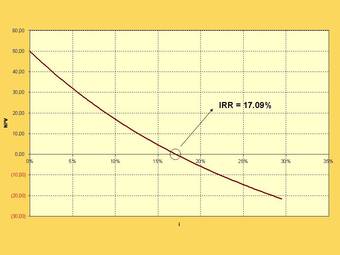
NPV Profile
The NPV Profile graphs how NPV changes as the discount rate used changes.
The NPV profile usually shows an inverse relationship between the discount rate and the NPV. While this is not necessarily true for all investments, it can happen because outflows generally occur before the inflows. A higher discount rate places more emphasis on earlier cash flows, which are generally the outflows. When the value of the outflows is greater than the inflows, the NPV is negative.
A special discount rate is highlighted in the IRR, which stands for Internal Rate of Return. It is the discount rate at which the NPV is equal to zero. And it is the discount rate at which the value of the cash inflows equals the value of the cash outflows.
11.5: Cash Flow Analysis and Other Factors
11.5.1: Cash Flow Factors
Cash flow factors are the operational, financial, or investment activities which cause cash to enter or leave the organization.
Learning Objective
Describe how cash flow factors can be used to improve or evaluate a business
Key Points
- Cash flow factors can be used to calculate parameters to measure organizational performance.
- Operational cash flows are those originating from the organization’s internal business.
- Financing cash flows are those originating from the issuance of debt or equity.
- Investment cash flows are those originating from assets and capital expenditures.
Key Terms
- liquidity
-
Availability of cash over short term: ability to service short-term debt.
- parameter
-
A variable kept constant during an experiment, calculation, or similar.
Definition
Cash flow is the movement of money into or out of a business, project, or financial product . It is usually measured during a specified, finite period of time. Measurement of cash flow can be used for calculating other parameters that give information on a company’s value and situation.

Cash
Cash flows reflect cash entering or leaving the organization.
Statement of Cash Flow in a Business’s Financial Statements
A business’s Statement of Cash Flows illustrates its calculated net cash flow. The net cash flow of a company over a period (typically a quarter or a full year) is equal to the change in cash balance over this period: It’s positive if the cash balance increases (more cash becomes available); it’s negative if the cash balance decreases. The total net cash flow is composed of several factors:
- Operational cash flows: Cash received or expended as a result of the company’s internal business activities. This includes cash earnings plus changes to working capital. Over the medium term, this must be net positive if the company is to remain solvent.
- Investment cash flows: Cash received from the sale of long-life assets or spent on capital expenditure, such as, investments, acquisitions, and long-life assets.
- Financing cash flows: Cash received from the issue of debt and equity, or paid out as dividends, share repurchases or debt repayments.
Uses
Cash flow factors can be used for calculating parameters, such as:
- to determine a project’s rate of return or value. The cash flows into and out of projects are used as inputs in financial models, such as internal rate of return and net present value.
- to determine problems with a business’s liquidity. Being profitable does not necessarily mean being liquid. A company can fail because of a shortage of cash even while profitable.
- as an alternative measure of a business’s profits when it is believed that accrual accounting concepts do not represent economic realities. For example, a company may be notionally profitable but generating little operational cash (as may be the case for a company that barters its products rather than selling for cash). In such a case, the company may be deriving additional operating cash by issuing shares or raising additional debt finance.
- can be used to evaluate the “quality” of income generated by accrual accounting. When net income is composed of large non-cash items, it is considered low quality.
- to evaluate the risks within a financial product (e.g., matching cash requirements, evaluating default risk, re-investment requirements, etc)
Cash flow is a generic term used differently depending on the context. It may be defined by users for their own purposes. It can refer to actual past flows or projected future flows. It can refer to the total of all flows involved or a subset of those flows.
11.5.2: Replacement Projects
A replacement project is an undertaking in which the company eliminates a project at the end of its life and substitutes another investment.
Learning Objective
Analyze a possible replacement projects to determine if it should be implemented
Key Points
- The cash flow analysis must take all cash flow components into account, such as opportunity costs and depreciation and maintenance expense.
- The replacement project’s cash flows are the additional inflows and outflows to be provided by the prospective replacement project.
- The comparison between the replacement and the current project informs the decision whether to undertake the replacement and, if applicable, at what point replacement should occur.
Key Terms
- capital budgeting
-
The budgeting process in which a company plans its capital expenditure (the spending on assets of long-term value).
- sunk cost
-
A cost that has already been incurred and which cannot be recovered to any significant degree.
- Opportunity cost
-
The cost of an opportunity forgone (and the loss of the benefits that could be received from that opportunity); the most valuable forgone alternative.
Definition
The possibility of replacement projects must be taken into account during the process of capital budgeting and subsequent project management. A replacement project is an undertaking in which the company eliminates a project at the end of its life and substitutes another investment. This replacement project can serve the purpose of replacing an expiring investment with a new, identical one, or replacing an existing investment that is producing unfavorable results with one that management believes will perform better.
When analyzing a project, and ultimately deciding whether it is a good investment decision or not, one focuses on the expected cash flows associated with the project. These cash flows form the basis for the project’s value, usually after implementing a method of discounted cash flow analysis. Most projects have a finite useful life. Analysis can be undertaken in order to determine when the optimum point of replacement will be, as well as if replacement is a viable option in the first place. To accomplish this, one analyzes the cash flows of the current project in relation to the expected cash flows from the replacement project .

Replacing a window sill vs. keeping the old one
Replacement project analysis tells a company whether the costs of a replacement project provide a suitable return on investment.
Analysis
The net cash flows for a project take into account revenues and costs generated by the project, along with more indirect implications, such as sunk costs, opportunity costs and depreciation costs related to the project. All of these considerations taken together allow management to consider the project’s incremental cash flows, which are inflows and outflows the project produces over predictable periods of time. Discounted cash flow analysis should be undertaken for both the existing project and the potential replacement project. These analyses can then be used to compare the expected profitability of both projects; which will, in theory, lead management to make the right decision regarding the investments.
In general, there will be some sort of cash inflow from ending the old project — for example, from the terminal value realized upon the sale of existing equipment — and a subsequent cash outflow to begin the new project. The loss of expected future cash flows from the previous project, or opportunity cost, must also be taken into account. A general form that can be used to analyze these cash flows is:
Increase in Net Income + (Depreciation on New Investment – Depreciation on Old Investment)
11.5.3: Sunk Costs
Sunk costs are retrospective costs that cannot be recovered, and are therefore irrelevant to future investment decisions in the project which incurs them.
Learning Objective
Identify sunk costs when making an investment decision
Key Points
- Only prospective costs should impact an investment decision. Therefore, sunk costs are not to be considered when deciding whether to undertake a project.
- A sunk cost is distinct from an economic loss. A loss may be caused by a sunk cost, however.
- Sunk costs are irrecoverable.
Key Term
- retrospective
-
Affecting or influencing past things; retroactive.
Definition
Sunk costs are retrospective costs that have already been incurred and cannot be recovered. Sunk costs are sometimes contrasted with prospective costs, which are future costs that may be incurred or changed if an action is taken .

Sunk
Sunk costs are irrecoverable.
Impact on Investment Decision
The idea of sunk costs is often employed when analyzing business decisions. In traditional microeconomic theory, only prospective (future) costs are relevant to an investment decision. For example the research and development of a pharmaceutical are retrospective once it is time to market the product. Once spent, such costs are sunk and should have no effect on future pricing decisions. The company will charge market prices whether R&D had cost one dollar or one million dollars. Therefore, the costs of R&D are considered sunk once they are retrospective and irrecoverable. At that point, they have no rational bearing on further investment decisions.
Difference from Economic Loss
The sunk cost is distinct from economic loss. For example, when a car is purchased, it can subsequently be resold; however, it will probably not be resold for the original purchase price. The economic loss is the difference between these values (including transaction costs). The sum originally paid should not affect any rational future decision-making about the car, regardless of the resale value. If the owner can derive more value from selling the car than not selling it, then it should be sold, regardless of the price paid. In this sense, the sunk cost is not a precise quantity, but an economic term for a sum paid in the past, which is no longer relevant to decisions about the future. The sunk cost may be used to refer to the original cost or the expected economic loss. It may also be used as shorthand for an error in analysis due to the sunk cost fallacy, irrational decision-making or, most simply, as irrelevant data.
11.5.4: Opportunity Costs
Opportunity cost refers to the value lost when a choice is made between two mutually exclusive options.
Learning Objective
Identify opportunity costs when making an economic choice
Key Points
- Opportunity cost can be seen as the second-best choice available to an economic actor.
- Opportunity cost can be measured monetarily, or more subjectively in terms of pleasure or utility.
- Opportunity cost shows not only that resources are scarce, but also that economic choices are limited.
Key Terms
- implicit costs
-
The opportunity cost equal to what a firm must give up in order to use factors which it neither purchases nor hires.
- explicit costs
-
a direct payment made to others in the course of running a business, such as wage, rent and materials
Definition
Opportunity cost is the cost of any activity measured in terms of the value of the next best alternative forgone (that is not chosen). In other words, it is the sacrifice of the second best choice available to someone, or group, who has picked among several mutually exclusive choices. .

Alternative choices
Choosing one alternative means another is foregone.
Economic Concept
Opportunity cost is a key concept in economics; it relates the scarcity of resources to the mutually exclusive nature of choice. The notion of opportunity cost plays a crucial role in ensuring that scarce resources are allocated efficiently. Thus, opportunity costs are not restricted to monetary or financial costs: the real cost of output forgone, lost time, pleasure or any other benefit that provides utility are also considered implicit. or opportunity, costs. In the context of cash flow analysis, opportunity cost can be thought of as a cash flow that could be generated from assets the organization already owns, if they are not used for the project in question. There is always a trade-off between making decisions on the allocation of assets.
Assessing Opportunity Cost
Opportunity cost is assessed not only in monetary or material terms, but also in terms of anything which is of value to the decision maker. For example, a person who desires to watch each of two television programs being broadcast simultaneously, and cannot record one, can only watch one of the desired programs. Therefore, the opportunity cost of watching an NFL football game could be not enjoying the college football game, or vice versa.
Examples
In a restaurant situation, the opportunity cost of eating steak could be trying the salmon. The opportunity cost of ordering both meals could be twofold: the extra $20 to buy the second meal, and reputation with peers, as the diner may be thought of as greedy or extravagant for ordering two meals. A family might decide to use a short period of vacation time to visit Disneyland rather than doing household improvement work. The opportunity cost of having happier children could therefore be a remodeled bathroom.
In a job situation, a person could either choose to run their own bakery, or work as an employee for a restaurant. There are explicit costs on the line, such as the capital necessary to start a business, purchase of all the inputs, and so forth. However, there are possible implicit benefits, such as autonomy and freedom to be “your own boss”, and implicit costs, such as the stress of running your own business. If the individual chooses to run their own bakery, their opportunity costs are the salary that the restaurant would have paid, and the smaller burden of responsibility as an employee instead of an owner.
11.5.5: Externalities
An externality is an effect of an economic action, the cost or benefit of which is shouldered by someone outside the transaction.
Learning Objective
Explain how externalities can affect different parties to a transaction
Key Points
- An externality that is a cost is a negative externality, while one that is a benefit is a positive externality.
- Prices do not reflect externalities because they affect people outside the economic transaction.
- Negative externalities can lead to over-production, while positive externalities can lead to under-production. The former case occurs because the producer does not pay the external cost, while the latter occurs because the benefit is generated without profit.
Key Term
- benefit
-
An advantage, help, or aid from something.
Definition
In economics, an externality is a cost or benefit that is not transmitted through prices and is incurred by a party who was not involved as either a buyer or seller of the goods or services. The cost of an externality is a negative externality , or external cost, while the benefit of an externality is a positive externality, or external benefit.

Pollution
Pollution is an example of a negative externality.
Relation to Prices
In the case of both negative and positive externalities, prices in a competitive market do not reflect the full costs or benefits of producing or consuming a product or service. Producers and consumers may neither bear all of the costs nor reap all of the benefits of the economic activity.
Over- and Under-Production
Standard economic theory states that any voluntary exchange is mutually beneficial to both parties involved in the trade. This is because buyers or sellers would not trade if either thought it was not beneficial.
However, an exchange can cause additional effects on third parties. Those who suffer from external costs do so involuntarily, while those who enjoy external benefits do so at no cost. A voluntary exchange may reduce total economic benefit if external costs exist. The person who is affected by the negative externalities in the case of air pollution will see it as lowered utility: either subjective displeasure or potentially explicit costs, such as higher medical expenses.
On the other hand, a positive externality would increase the utility of third parties at no cost to them. Since collective societal welfare is improved, but the providers have no way of monetizing the benefit, less of the good will be produced than would be optimal for society as a whole.
For example, manufacturing that causes air pollution imposes costs on the whole society, while public education is a benefit to the whole society. If there exist external costs such as pollution, the good will be overproduced by a competitive market, as the producer does not take into account the external costs when producing the good.
If there are external benefits, such as in areas of education, too little of the good would be produced by private markets as producers and buyers do not take into account the external benefits to others. Here, overall cost and benefit to society is defined as the sum of the economic benefits and costs for all parties involved.
“Free Rider” Problem
Positive externalities are often associated with the free rider problem. For example, individuals who are vaccinated reduce the risk of contracting the relevant disease for all others around them, and at high levels of vaccination, society may receive large health and welfare benefits. Conversely, any one individual can refuse vaccination, still avoiding the disease by “free riding” on the costs borne by others.
Market Correction
The market-driven approach to correcting externalities is to “internalize” third-party costs and benefits, for example, by requiring a polluter to repair any damage that they cause. But in many cases internalizing costs or benefits is not feasible, especially if the true monetary values cannot be determined.
11.5.6: Tax Rate
The tax rate is the amount of tax expressed as a percentage.
Learning Objective
Differentiate the different types of tax rates
Key Points
- The methods used to present a tax rate include: statutory, average, marginal, and effective rates.
- Statutory tax rates are those imposed by law.
- Average tax rate is the total tax liability divided by taxable income.
- Marginal tax rate is the rate at a specific level of spending or income. It is also known as tax “on the last dollar,” earned or spent.
- Effective tax rate describes when varying measures of tax are divided by varying measures of the tax base. It is inconsistently defined in practice.
Key Term
- margin
-
Collateral that the holder of a financial instrument has to deposit to cover some or all of the credit risk of their counterparty.
Definition
In a tax system, the tax rate describes the ratio at which a business or person is taxed .

Tax Rate
The tax rate is a percentage of the taxable base.
Methods
There are several methods used to present a tax rate:
- statutory
- average
- marginal
- effective
Statutory
A statutory tax rate is the legally imposed rate. An income tax could have multiple statutory rates for different income levels, whereas a sales tax may have a flat statutory rate.
Average
An average tax rate is the ratio of the amount of taxes paid to the tax base (taxable income or spending). To calculate the average tax rate on an income tax, divide the total tax liability by the taxable income.
Marginal
A marginal tax rate is the tax rate that applies to the last dollar of the tax base (taxable income or spending) and is often applied to the change in one’s tax obligation as income rises.
For an individual, this rate can be determined by increasing or decreasing the income earned or spent and calculating the change in taxes payable. An individual’s tax bracket is the range of income for which a given marginal tax rate applies.
The marginal tax rate may increase or decrease as income or consumption increases, although in most countries the tax rate is progressive in principle. In such cases, the average tax rate will be lower than the marginal tax rate. For instance, an individual may have a marginal tax rate of 45%, but pay an average tax of half this amount.
In a jurisdiction with a flat tax on earnings, every taxpayer pays the same percentage of income, regardless of income or consumption. Some proponents of this system propose to exempt a fixed amount of earnings (such as the first $10,000) from the flat tax.
Marginal tax rates may be published explicitly, together with the corresponding tax brackets, but they can also be derived from published tax tables showing the tax for each income. It may be calculated by noting how tax changes with changes in pre-tax income, rather than with taxable income.
Effective
The term effective tax rate has significantly different meanings when used in different contexts or by different sources. Generally it means that some amount of tax is divided by some amount of income or other tax base. In U.S. income tax law, the term is used in relation to determining whether a foreign income tax on specific types of income exceeds a certain percentage of U.S. tax that might apply on such income.
The popular press, Congressional Budget Office, and various think tanks have used the term to refer to varying measures of tax divided by varying measures of income, with little consistency in definition. An effective tax rate may incorporate econometric, estimated, or assumed adjustments to actual data, or may be based entirely on assumptions or simulations. It also incorporates tax breaks or exemptions.
11.5.7: Depreciation
Depreciation is the process by which an asset is used up, and its cost is allocated over a period of time.
Learning Objective
Describe the relationship between allocation of cost and the matching principle when calculating depreciation
Key Points
- Fair value depreciation is an estimate of the market value of an asset.
- The cost of an asset that is to be allocated by depreciation is the amount paid for it minus any salvage value it will have at the end of its useful life.
- Methods used for apportioning the cost over a period of time include fixed percentage, straight-line, and declining balance.
Key Term
- allocate
-
To distribute according to a plan.
Definition
Depreciation refers to two very different but related concepts: the decrease in value of assets (fair value depreciation), and the allocation of the cost of assets to periods in which the assets are used (depreciation with the matching principle).
Fair Value Depreciation
Fair value depreciation affects the values of businesses and entities. It is a concept used in accounting and economics, defined as a rational and unbiased estimate of the potential market price of a good, service, or asset, taking into account the amount at which the asset could be bought or sold in a current transaction between willing parties.
Allocation of Cost with Matching Principle

Depreciated value
Depreciation measures how much of an asset is used up in a certain amount of time.
The allocation of the cost of an asset to periods in which it is used up affects net income. Any business or income producing activity using tangible assets incurs costs related to those assets. In determining the net income from an activity, the receipts from the activity must be reduced by appropriate costs.
One such cost is the cost of assets used but not currently consumed in the activity. Such costs must be allocated to the period of use. Where the assets produce benefit in future periods, the matching principle of accrual accounting dictates that those costs must be deferred rather than treated as a current expense.
The business records depreciation expense as an allocation of such costs for financial reporting. The costs are allocated in a rational and systematic manner as a depreciation expense to each period in which the asset is used, beginning when the asset is placed in service.
Generally this involves four criteria:
- the cost of the asset
- the expected salvage value, also known as residual value of the asset
- the estimated useful life of the asset
- a method of apportioning the cost over such life.
The cost of an asset so allocated is the difference between the amount paid for the asset and the salvage value.
Methods
Depreciation is any method of allocating net cost to those periods expected to benefit from use of the asset. Generally the cost is allocated as a depreciation expense, among the periods in which the asset is expected to be used. Such expense is recognized by businesses for financial reporting and tax purposes. Methods of computing depreciation may vary by asset for the same business. Methods may be specified in the accounting or tax rules of a country. Several standard methods of computing depreciation expense may be used, including:
- fixed percentage
- straight line
- declining balance method
Depreciation expense generally begins when the asset is placed in service. For instance, a depreciation expense of 100 dollars per year for 5 years may be recognized for an asset costing 500 dollars.
11.5.8: Elective Expensing
Section 179 of the IRS code allows some pieces of property to be expensed entirely when they are purchased, rather than depreciated.
Learning Objective
Summarize section 179 of the tax code and how it applies to businesses
Key Points
- Usually this provision applies to small businesses because there are limitations on what and how much property can be expensed.
- Though buildings were not originally eligible, a 2010 law included them.
- The total deduction for a year cannot exceed the person’s income for that year.
Key Term
- deduction
-
A sum that can be removed from tax calculations; something that is written off.
Definition
Section 179 of the United States Internal Revenue Code (26 U.S.C. § 179) allows a taxpayer to elect to deduct the cost of certain types of property on their income taxes as an expense, rather than requiring the cost of the property to be capitalized and depreciated. This property is generally limited to tangible, depreciable, personal property which is acquired by purchase for use in the active conduct of a trade or business . This can afford considerable tax savings in some circumstances.
Property
Buildings were not eligible for section 179 deductions prior to the passage of the Small Business Jobs Act of 2010; however, qualified real property may now be deducted. Depreciable property that is not eligible for a section 179 deduction is still deductible over a number of years through MACRS depreciation according to sections 167 and 168. The 179 election is optional, and the eligible property may be depreciated according to sections 167 and 168 if preferable for tax reasons. Furthermore, the 179 election may be made only for the year the equipment is placed in use and is waived if not taken for that year. However, if the election is made, it is irrevocable unless special permission is given.
Limitations
The § 179 election is subject to three important limitations:
- There is a dollar limitation. Under section 179(b)(1), the maximum deduction a taxpayer may elect to take in a year is 500,000 dollars in 2010 and 2011, 125,000 dollars in 2012, and 25,000 dollars for years beginning after 2012.
- If a taxpayer places more than 2 million dollars worth of section 179 property into service during a single taxable year, the 179 deduction is reduced, dollar for dollar, by the amount exceeding the 2 million threshold. This threshold is further reduced to 500,000 dollars beginning in 2012, and then 200,000 dollars afterward.
- Lastly, the section provides that a taxpayer’s 179 deduction for any taxable year may not exceed the taxpayer’s aggregate income from the active conduct of trade or business by the taxpayer for that year. If, for example, the taxpayer’s net trade or business income from active conduct of trade or business was 72,500 dollars in 2006, then the deduction cannot exceed 72,500 dollars that year. However, any deduction not allowed in a given year under this limitation can be carried over to the next year.

Truck
Expensing is applied to property used in a business, such as trucks.
Chapter 10: Introduction to the Cost of Capital
10.1: The Basics of the Cost of Capital
10.1.1: Defining the Cost of Capital
Risk, return, and the time value of money are central inputs in distilling the cost of capital as an investor or borrower.
Learning Objective
Understand the broader concepts in the cost of capital
Key Points
- Defining the cost of capital takes into account two general perspectives: the required rate of return of the lender and the weighted average cost of capital for the borrower.
- Understanding the time value of money and understanding how to discount cash flows and returns into present value are important in assessing the cost of capital.
- As an investor, understanding the opportunity cost of foregone investments as a result of risk and expected return is critical to intelligent investing.
- By calculating and understanding the cost of debt and the cost of equity, organizations can calculate a weighted average cost of capital (WACC) consolidating all funding sources.
- Ultimately the cost of capital accounts for opportunity cost, risk, return, and the time value of money.
Key Term
- risk-free rate
-
The default rate of return attached to a ‘risk free’ asset, such as a treasury bond. While nothing is completely risk free, these assets are as close to minimal risk as possible and represent the lowest practical rate of return.
When defining the cost of capital, it’s useful to frame it from either the borrower’s point of view (i.e. the organization) or the lender’s point of view (the investor). For the organization borrowing the capital, the cost of capital is the cumulative rate of interest (usually derived as an average rate, combining all capital inputs) applied to the borrowed capital to fund a project. From the investor’s point of view, the cost of capital is the relative required return rate considering the risk of the investment being made.
If this all sounds a bit confusing, don’t worry. Here’s an overview of the most important concepts:
Net Present Value (NPV)
The reason that capital incurs interest revolves around the simple fact that time has an impact on the valuation of capital, presenting opportunity costs and risk. To take into account the present value of future cash flows is therefore an important aspect of anticipating the rate of return on an investment. An NPV calculation will look at the forecasts for future cash flows, and discount those into present day dollars based on a given interest rate. This allows investors and organizations to determine if the cost of capital will be offset by the profits of a given investment.
Required Rate of Return
From the investor’s point of view, every investment has a required rate of return for (generally) two reasons: the opportunity cost of foregone investments and the risk of the borrower defaulting on payments. For example, if an investor can get 10% return on an investment with exactly the same risk as an option with 12% return, the investor would incur an opportunity cost of 2% by investing in the 10% return option. Similarly, if two investments both yield a 10% return but present different levels of risk, an investor would make the decision based on the lowest risk option.
Cost of Debt
As an organization, one of the options for sourcing capital is to pursue debt. This can either be through taking out a loan or putting selling corporate bonds. These options tend to have lower interest rates, and long payback periods. Debt is paid back first in the case of bankruptcy, lowering it’s risk as an investment (and subsequently, lowering it’s return). The cost of this capital is calculated as:
Rf is the risk-free rate and T is the corporate rate. Tax is included in debt as debt is discounted as a deductible expense.
Cost of Equity
Equity, usually represented as shares of stock, is another option for borrowing (and investing) at the organizational level. Equity’s cost is calculated via the capital asset pricing model (CAPM), as follows:
The variables above are:
- Es is the expected return for a security
- Rf is the expected risk-free rate
- βs is the sensitivity to market risk
- Rm is the historical return of the market
- (Rm – Rf) is the risk premium compared to the risk-free rate
Weighted Average Cost of Capital
With the above options in mind, the weighted average cost of capital (WACC) normalizes the cost of capital by combining the interest rates being incurred from both debt and equity. It can be written as:
While each of these concepts is quite a bit more complex in implementation, this overview gives some scope as to the general definition and considerations involved in the cost of capital. Capital incurs costs due to risk, return, and the intrinsic time value of money.
10.1.2: Differences Between Required Return and the Cost of Capital
The average cost of capital is calculated via combining the overall average required rate on debt stakeholders and equity stakeholders
Learning Objective
Calculate the weighted average cost of capital by understanding the required rate of various investors
Key Points
- Investors need to know the overall required return based on the risk of the investment in order to compare this to other investment opportunities.
- The overall cost of capital will be the combination of various required rates of returns on behalf of investors, some of which will likely be debt while others will be equity.
- The cost of capital should be weighted in order for the overall weight average cost of capital (WACC) for a given project or venture to be calculated. This WACC determines the overall required return on the project to become profitable (or at least break even).
- As a result, the difference between required return and cost of capital is twofold: the perspective (i.e. the borrower or the lender) and the potential for averaging these costs of capital from the borrowers perspective (i.e. multiple required returns).
Key Term
- weighted average cost of capital
-
Or WACC, this is a calculation of the various required returns on a project, which ultimately determines the profitability required to break even.
Why Require Return Rates
When making investments on the business level, it is critical to create a required amount of return on the project. A required return is exactly what it sounds like— the amount of profit as a percentage of the investment that will be created over a given time period.
As an investor, this required rate is a practical concept. Investors have options, and each of those options will offer a rate of return. The risk attached to those rates will fluctuate, as higher risk projects require a higher rate of return. Through establishing this required rate, the investor is stipulating their expectations on repayment of this invested capital, which the borrower will confirm and agree to repay over a set time period (usually via timed installments).
So What’s Cost of Capital?
This required amount of return will ultimately equal the cost of capital, as the required rate from the investor is now a cost being put on the borrower. Now, cost of capital for a given investor will always equate to the required return. However, things get a bit more complicated when organizations fund new projects via a wide variety of stakeholders.
Weighted Average Cost of Capital (WACC)
This is where the concept of weighted average cost of capital (WACC) enters the equation, as there may be more than one investor with varying rates of return. Intuitively, the WACC will then be a calculation which takes into account the percentage of the overall borrowed capital that each form of investment contributed, and the respective required rates. To make this a bit clearer, let’s look at the equation of WACC that takes into account one rate for equity and another rate for debt:
In the above equation, you have D as total debt, E as total equity, Kd as the required return on debt, and Ke as the required return on equity. If various investors require different rates of return, the equation can be altered accordingly (i.e. Kd and Ke will each be averaged based on their respective inputs). For the sake of simplicity, this WACC equation will suffice for the majority of calculations.
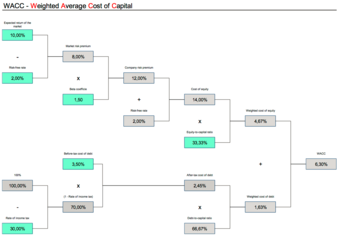
WACC
While this image goes into a bit more detail on the derivation of the cost of equity and the cost of debt, the final three boxes on the right ultimately demonstrate the way in which required rates balance out into a WACC (one for debt, one for equity). Debt tends to be a lower rate because it is paid out first if a company goes bankrupt (i.e. lower risk). Equity is a bit higher risk (only paid out if there is capital remaining after debts are paid), and thus equity has a higher rate (and higher risk).
The Difference
Ultimately, the difference between the cost of capital and the required return is both one of perspective (borrower looks at cost of capital for a project; investors look at required return) as well as the potential for a WACC, which integrates various required returns for a single investment project.
10.1.3: Relationship Between Financial Policy and the Cost of Capital
Financial policy, not cost of capital, must be utilized to determine which investments to pursue, given that resources are limited.
Learning Objective
Explain the relationship between a company’s financial policy and its cost of capital
Key Points
- As opposed to strictly using cost of capital, decisions must be made using opportunity cost of capital.
- Opportunity cost of capital is the amount of money foregone by investing in one asset compared to another.
- Facets of financial policy include valuation, portfolio theory, hedging, and capital structure.
Key Term
- leverage
-
The use of borrowed funds with a contractually determined return to increase the ability of a business to invest and earn an expected higher return (usually at high risk).
Financial Policy and the Cost of Capital
Financial policy is used by companies or investors in order to determine the best way to allocate their resources. In regard to cost of capital, financial policy must be utilized in order to decide which investments have the highest return, given that resources are limited. To analyze various options, managers use valuation techniques, such as the capital asset pricing model or discounted cash flow analysis. As opposed to strictly using cost of capital, decisions must be made using opportunity cost of capital.
Opportunity cost of capital is the amount of money foregone by investing in one asset compared to another. As an investor, this can simply be a choice of one asset over another. As a company, this choice can also involve the use of current assets in new investments. For example, an idle piece of land could be used for a new factory; however, the opportunity cost of what else it could have been used for must be taken into consideration during analysis.
Other Roles of Financial Policy
The use of financial policy in decision making does not only involve valuation. Other facets include portfolio theory, hedging, and capital structure.
Portfolio Theory
Portfolio theory is a mathematical formulation of the concept of diversification in investing. It attempts to maximize the expected return of a portfolio, or a collection of investments, for a given amount of risk by carefully choosing the proportions of various assets. In other terms, portfolio theory attempts to minimize risk for a given level of expected return. For example, to the extent prices in the stock market move differently from prices in the bond market, a collection of both types of assets can, in theory, face lower overall risk than either could individually.
Hedging
Along the same lines, companies use hedging techniques to offset potential gains and losses. Hedging is the practice of taking a position in one market to offset and balance against the risk adopted by assuming a position in a contrary or opposing market or investment. Simply put, a hedge is used to reduce any substantial gains or losses suffered by an individual or an organization. Companies often use hedging techniques to offset the risk of price fluctuation for commodities, such as oil or agricultural products.
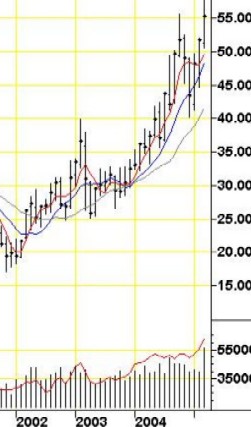
Oil Prices
Companies often use hedging techniques to offset price fluctuations for commodities. The fluctuation of oil prices can be seen in the above graph.
Capital Structure
The capital structure of a company refers to the way it finances its assets through some combination of equity, debt, or hybrid securities. Capital structure may be highly complex and include dozens of sources. A simple example, though, would be a company that sold $20 million in equity and $80 million in debt. This company would be 20% equity financed and 80% debt financed. A company’s ratio of debt to total financing is referred to as its leverage.
10.2: Valuing Different Costs
10.2.1: The Cost of Debt
The cost of debt is a calculation taking into account the risk premium, the risk-free rate, and taxes.
Learning Objective
Calculate the cost of debt and understand how debt differs from equity
Key Points
- The weighted average cost of capital takes into account the cost of debt and the cost of equity. Measuring the cost of each of these is therefore critical to effective capital structuring.
- The cost of debt tends to be lower than the cost of equity, as debts are paid before equity in a bankruptcy situation.
- The risk-free rate and the tax rate are both firmly set. The risk-free rate is determined as the rate of return on an idealized risk-free asset.
- The risk premium is negotiated between the lender and the borrower, mostly depending on collateral and scale of the loan.
When financing a new project, business, or operation, organizations can utilize both equity and debt to create a balanced weighted average cost of capital. One of the primary differences between equity and debt pertains to risk, and the impact that risk has on the cost of capital. To understand the role of debt, and how the cost of debt impacts overall cost of capital, the weighted average cost of capital equation is a useful data point:
Calculating the Cost of Debt (Rd)
When an organization borrows capital from outside lenders, the interest on these loans is called debt. The variables involved in a debt transaction are fairly simple:
- Kd – The cost of debt (referred to as Rd above)
- Rf – The risk free rate
- T – Tax
- Credit risk rate – Or the risk premium
When these variables are plugged into a formula, it looks like this:
The risk -free rate (or Rf) is externally determined from the general market, and is described as the overall cost incurred due to the time value of money with no risk whatsoever involved. This is usually derived from a government treasury bond, as it is the most the investment asset in most markets with the lowest possible rate of risk. Tax rates are set externally as well, and are concrete.
The credit risk rate is therefore the point of negotiation, and where a risk premium is attached to the debt instrument to compensate the investor in regards to a return (for the risk taken). As a general rule, the larger the debt is the higher the risk rate will be (as all other things being equal, a higher debt is harder to pay back). Debtors will also take into consideration the collateral available to the organization (i.e. a valuation of their assets).
Debt Compared to Equity
Determining the cost of debt is quite a bit easier than determining the cost of equity. The inputs to a debt assessment are tangibly determined, and consistent across the life of the agreement. It is worth noting that debt is generally less risky from the investor’s point of view, as debt obligations are paid out before equity obligations if a business goes bankrupt.
10.2.2: The Cost of Preferred Stock
The cost of preferred stock is equal to the preferred dividend divided by the preferred stock price, plus the expected growth rate.
Learning Objective
Calculate the cost of a company preferred stock
Key Points
- Preferred stock is an equity security with properties of both an equity and a debt instrument.
- Because preferred stock carries a differing amount of risk than other types of securities, we must calculate its asset specific cost of capital to work into our overall weighted average cost of capital.
- The dividend is usually specified as a percentage of the par value or as a fixed amount.
Key Term
- hybrid instrument
-
A broad group of securities that pay a predictable (fixed or floating) rate of return or dividend until a certain date, at which point the holder has a number of options including converting the securities into the underlying share.
Example
- The price of a preferred stock is $100. It will pay a fixed dividend of $10 each year. The growth rate is expected to be 3%.. The cost of preferred stock is 13%.
The Cost of Preferred Stock
Preferred stock is an equity security with properties of both an equity and a debt instrument. It is generally considered a hybrid instrument. Preferred stock represents some degree of ownership in a company, but usually doesn’t come with the same voting rights. In the event of liquidation, preferred shareholders are paid off before the common shareholder, but after debt holders. Preferred stock may also be callable or convertible, meaning that the company has the option to purchase the shares from shareholders at anytime for any reason – usually for a premium – or convert the shares to common stock. Similar to bonds, preferred stocks are rated by the major credit rating companies. Some people consider preferred stock to be more like debt than equity.
Contribution To Cost of Capital
Because preferred stock carries a differing amount of risk than other types of securities, we must calculate its asset specific cost of capital to work into our overall weighted average cost of capital. Similar to debt, this can be a relatively simple process since we can observe values needed as inputs in the market. With preferred shares, investors are usually guaranteed a fixed dividend forever. This is different than common stock, which has variable dividends that are never guaranteed. If preferred dividend is known and fixed, we can use the following equation to calculate the cost of capital for preferred stock .

Cost of Preferred Stock
The cost of preferred stock is equal to the preferred dividend divided by the preferred stock price, plus the growth rate.
This tells us that the cost of preferred stock is equal to the preferred dividend divided by the preferred stock price, plus the expected growth rate. The dividend is usually specified as a percentage of the par value or as a fixed amount. Sometimes, dividends on preferred shares may be negotiated as floating – they may change according to a benchmark interest rate index.

Example Equation
$10 divided by $100, plus 3%.
10.2.3: The Cost of Common Equity
The cost of common equity is an imperfect calculation, an estimation based upon valuing the firms risk relative to the market.
Learning Objective
Utilize various formulas to calculate the cost of common equity from different perspectives
Key Points
- Debt is a firm calculation of the cost of capital, where the lender applies an premium (interest rate) to the risk-free rate based upon the organization’s existing assets (collateral) and the size of the loan.
- The cost of common equity is quite a bit less clear, as it is an estimation of the organization’s susceptibility to risk.
- The capital asset pricing model (CAPM) is the traditional way to approach estimating an organization’s required return rate for an investor, requiring a risk estimation.
- An expansion on the CAPM approach is the Fama-French three-factor model, which adds company size and book-to-market ratio to this calculation.
- The dividend discount model is another method, where each expected future dividend payment is discounted to present day dollars to provide a valuation of the security.
Key Term
- price-to-book ratio
-
Or market-to-book ratio, this ratio compares the market valuation of an organization to the book value of the organization.
As a funding source, debt and equity are priced quite differently. While debt relies heavily on default premiums being applied to a risk-free bond rate of interest (the premium usually dependent on the size of the debt compared to the size of the firm), equity isn’t quite as well-defined. As a result, the cost of common equity is often inferred through assessing and comparing it to similar risk profiles, and trying to decipher the firm’s relative sensitivity to systematic (market) risk.
The Capital Asset Pricing Model
One common tool used in assessing the cost of common equity is the capital asset pricing model (CAPM), which can be described via the following formula:
What this formula is saying is essentially that the cost of equity is equal to the risk free rate of return plus a premium for the expected risk of investing in the organization’s equity. The variable are defined as follows:
- Es – expected return for a security
- Rf – expected risk-free return rate
- βs – sensitivity to market risk
- Rm – historical return of the stock market
- (Rm – Rf) – risk premium of market assets over risk free assets
Other Tools to Value Equity
The cost of common equity is essentially the same thing as estimating the expected (or required) return to investors in the stock market. The idea is simply that the higher risk an organization is, the higher the corresponding return should be. As a result, there are countless stock price evaluation strategies and tactics one could use to estimate the cost of common equity from various perspectives. Two of these include the dividend discount model and the Fama-French three-factor model.
Dividend Discount Model
In short, this theory states that a given stock is worth the sum of its future dividend payments, discounted to their present value. This is therefore a model of deriving the present value of future dividend payments, calculated as follows (assuming no end date):
In this calculation, P is the stock price while D is the dividend, g is the (constant) growth rate, and r is the constant cost of equity and t is time.
There are a few problems with this method, most notably that a steady and perpetual growth rate that is less than the cost of capital may not be reasonable. Similarly, this model is quite vulnerable to the growth rate. Also, not all stocks pay dividends.
Fama-French Three-Factor Model
Another valuation model was derived by Eugene Fama and Kenneth French with the intention to include company size and price-to-book ratio with overall market risk. You’ll recognize the first half of this equation as the simple CAPM calculation, while the second half includes SMB (small minus big market capitalization) and HML (high minus low book-to-market ratio) multiplied by coefficients (from linear regression). While this all sounds a bit complicated, the basic premise is to offset the risk calculation with a stronger valuation for a firm’s assets and scale:
Conclusion
All and all, the valuation of common equity is always an estimation. As understanding the risk of a given organization within the stock market is intrinsically speculative, equity tends to be quite a bit more costly than debt. After all, when an organization goes bankrupt it is the debtors who are reimbursed first, preferred stock next, and common stock last. This is the riskiest position of an investment.
10.2.4: The Cost of Retained Earnings
Due to the relationship between retained earnings and dividends, the cost of retained earnings as a source of capital is relative to the overall cost of equity.
Learning Objective
Recognize the relationship between dividends, net income, and retained earnings
Key Points
- Retained earnings represent the capital remaining after net income is paid out to investors and shareholders via dividends. Retained earnings are reinvested back into the organization.
- Reinvesting capital into the organization is therefore considered equity, and calculated relative to that equity within the weighted average cost of capital (WACC).
- Retained earnings represents the capital left after paying out dividends. The opportunity cost of retaining earnings is dividends, and is therefore equivalent in cost to the equity that expects those dividends.
- As a result, understanding the retention ratio is dependent on deriving the dividend payout ratio.
Key Term
- dividend payout ratio
-
The fraction of net income an organization pays out to investors.
Retained Earnings Defined
Retained earnings indicate the amount of capital remaining after profits or losses from net income are paid out to investors and shareholders via dividends. Retained earnings are reinvested back into the organization. When organizations create profits, these profits are not always entirely distributed to investors at the end of a reporting period. As a result, these retained earnings can essentially be viewed as a potential funding source for the organization.
No capital comes without costs, however, and the cost of this capital must be taken into account when calculating the weighted average cost of capital (WACC). Retained earnings are included in the WACC equation as equity, as dividends are a component of the return on capital to equity stakeholders, and thus will have a correspondingly weighted influence on the cost of equity.
Understanding the equation to determine the retention ratio adds some clarification for this point:
The dividend payout ratio is a useful addition to the above equation, and is written as:
The relationship between dividends and retained earnings is quite clear when it comes to recognizing the opportunity cost and thus the overall cost of this capital source.
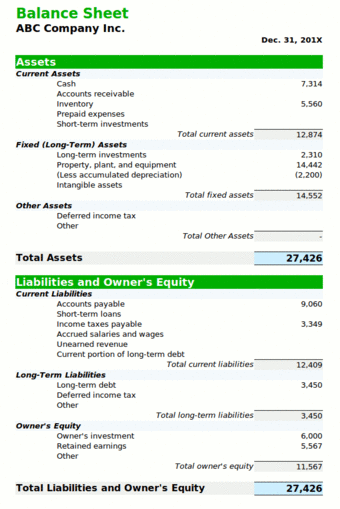
Balance Sheet Example
Retained earnings is listed under equity, and is thus relative to the cost of equity.
10.2.5: The Cost of New Common Stock
Issuing new common stock is a time intensive process that gives access to capital with various direct and indirect costs.
Learning Objective
Weigh the direct and indirect costs of issuing new common stock as a form of capital
Key Points
- One of the options for raising organizational capital is issuing new common stocks, which falls under new equity (as opposed to debt).
- Issuance of new common stock incurs a variety of direct costs, including those related to legal, accounting, marketing, management, and taxation.
- Issuing new common stock also incurs a variety of indirect costs revolving around loss of ownership, legal requirements of financial statement releases, and unreliability of demand for shares.
Key Term
- weighted average cost of capital
-
Common stock is one of a variety of inputs in the weighted average cost of capital, which calculates the overall cost of borrowing.
Cost of Capital
When it comes to the cost of capital, common stock is one of a few options on the table for raising funding. From various debt instruments to preferred stock to common stock, larger organizations tend to diversify funding input to optimize their potential financial leverage. In order to understand the weighted average cost of capital (WACC) of all of these inputs, the cost of each source of debt and/or equity must be determined.
The Cost of Common Stock
When it comes to issuing common stock, there are both direct and indirect costs to consider.
Direct Costs
In terms of literal capital spent, the issuance of new common stock incurs a variety of capital costs both at the initial offering and throughout the process of managing this funding source over time:
- Legal fees for the distribution of business shares to the general public
- Increased accounting costs (if initial IPO) for management of a publicly traded firm
- Marketing costs for recruiting investors
- The time and effort of management
- Taxation (which differ region to region) pertaining the the distribution of equity
From a general perspective, the process of offering shares is skill intensive, from management to legal to accounting, firms must hire and maintain a wide pool of talent to maintain this form of equity.
Indirect Costs
In addition to the tangible capital costs involved, there are also a variety of indirect trade-offs that organizations must understand prior to pursuing this source of funding. Indirect costs include:
- Requirement to release financial information, including information that competitors may find valuable
- Compared to debt, it is less reliable as there may not be buyers interested at the desired price point
- Some loss of control, as the sale of shares is essentially the sale of organizational ownership
- Depending on the scale of shares available, the organization must consider takeover risks
As the issuance of publicly traded common stock is essentially the sale of the public auction of organizational equity, any and all considerations pertaining to control, ownership and legal implications should be considered as opportunity costs compared to other forms of funding.
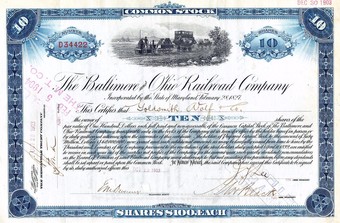
Common Stock
Stock image of common stock.
10.3: Approaches to Calculating the Cost of Capital
10.3.1: The Capital Asset Pricing Model
The capital asset pricing model helps investors assess the required rate of return on a given asset by measuring sensitivity to risk.
Learning Objective
Calculate sensitivity to risk on a theoretical asset using the CAPM equation
Key Points
- Investors use various tools to determine the overall expected return and relative risk of a security in the broader financial markets.
- One such tool is the capital asset pricing model (CAPM), which essentially distills the required rate of return applied to the risks (both of which are relative to the risk-free rate).
- By utilizing the variables involved in a CAPM calculation, an investor can also determine the risk to return ratio alongside the security market line (a graphical representation of the asset’s risk and return).
- By utilizing the CAPM equation, investors can determine when an asset is undervalued, and balance a portfolio for the best prospective return on the lowest possible risk.
Key Term
- capital asset pricing model
-
An equation that assesses the required rate of return on a given investment based upon its risk relative to a theoretical risk-free asset.
When considering assets for the diversification of an investment portfolio, investors and financiers use a variety of tools to project the required rate of return and risk of a given investment. All this really means is that investors are on the look out for ways to minimize risk, maximize returns, and invest intelligently in assets that are well-priced. The key assumption here is that the market will self-correct to adjust each investment option’s expected return to the relative risk of investing.
The Capital Asset Pricing Model
When measuring the ratio between risk and return on a given investment, the capital asset pricing model (CAPM) can be a useful tool. This model focuses on measuring a given asset’s sensitivity to systematic risk (also referred to as market risk) in relation to the expected return compared to that of a theoretical risk-free asset.
How CAPM Works
This sounds complicated, but it’s simpler than it seems. All this really means is that the CAPM tries to measure the risk the market will offer the asset compared to the risk-free rate, and make sure the expected return will offset that risk. To understand this concept, there are a few variables that are useful to identify up front:
- E(Ri) is an expected return on security
- E(RM) is an expected return on market portfolio M
- β is a non-diversifiable or systematic risk
- RM is a market rate of return
- Rf is a risk-free rate
There are quite a few ways to rearrange the relationship between these variables to derive meaningful information. Like all equations, depending on what you know you can solve for what you don’t know as well. For a basic CAPM calculations, you would want to solve for the expected return on a security, which looks like this:
Security Market Line
Through rearranging these variables, you can also take a look at the concept of the security market line (SML), which underlines a security’s relationship with systematic risk and respected return in a graphical format. This is written as:
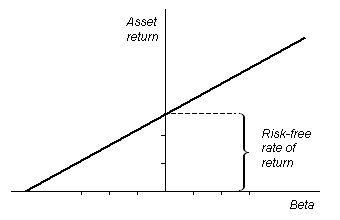
Security Market Line
The security market line is illustrated in this graph, where an assets expected return can be visualized.
Risk and Return
A final application of the CAPM variables in relation to one another is in deriving a ratio that illustrates the relationship between risk and return. On the left side of the equation below, you have an assessment of the overall risk relative to a risk-free asset. On the right side, you have the overall return (similarly relative to a risk-free asset). This can be written as follows:
Investors can utilize the CAPM equation and its various implications to assess a variety of market investment opportunities to diversify a portfolio and identify undervalued assets.
10.3.2: The SML Approach
The SML is the graphical representation of CAPM used to determine if an asset is priced to offer a reasonable expected return for the risk.
Learning Objective
Analyze assets using the Security Market Line Approach
Key Points
- The SML graphs the relationship between risk β (beta) and expected return.
- All correctly priced assets lie on the SML.
- If a security is priced above the SML, it is undervalued. If it is priced below the SML, it is overvalued.
Key Term
- slope
-
The ratio of the vertical and horizontal distances between two points on a line; zero if the line is horizontal, undefined if it is vertical.
Example
- The current risk-free rate is 5%. The market is expected to return 12% next year. The beta of the security is 1.9. Expected return = 5% + 1.9*(12% – 5%) Expected return = 18.3% We expect the asset to return 18.3% and be plotted on the SML. However, the current real rate of return for the asset is 19%. The asset would be plotted above the SML. Therefore, it is undervalued and should be bought.
The SML Approach
The Security Market Line (SML) is the graphical representation of the capital asset pricing model (CAPM), with the x-axis representing the risk (beta), and the y-axis representing the expected return. It graphs the relationship between beta (β) and expected return, i.e. it shows expected return as a function of β. The y-intercept of the SML is equal to the risk-free interest rate, while the slope is equal to the market risk premium (the market’s rate of return minus the risk-free rate). The slope also represents the risk-return tradeoff at a given time. The SML is applicable to any asset.

SML Equation
The SML is the graphical representation of CAPM, and thus is found using the same equation.
Applications of the SML
Individual assets that are correctly priced are plotted on the SML. In the ideal world of CAPM, all assets are correctly priced and thus lie on the SML. In real market scenarios, we are able to use the SML graph to determine if an asset being considered for a portfolio offers a reasonable expected return for the risk. If an asset is priced at a point above the SML, it is undervalued, since for a given amount of risk, it yields a higher return. Conversely, an asset priced below the SML is overvalued, since for a given amount of risk, it yields a lower return.

CAPM-SML
The Security Market Line for the Dow Jones Industrial Average over a 3 year period, with the x-axis representing beta and the y-axis representing expected return.
Another way to think about real market applications of the SML would be in terms of buying and selling securities. If an asset is priced above the SML, and thus undervalued, it should be bought. If an asset is priced below the SML, and thus overvalued, it should be sold.
10.3.3: Discounted Cash Flow Approach
A discounted cash flow analysis is a highly useful tool for calculating the net present value of a given product, process, asset, or organization.
Learning Objective
Translate future projected cash flows into present day dollars, incorporating risk and the time value of money
Key Points
- A discounted cash flow analysis is a highly useful tool for determining the net present value (NPV) of a given organization, process, product, or asset.
- An NPV takes into account risk, forecasts for cash flows, and the time value of money to determine what future capital returns are worth in present-day dollars.
- When calculating discounted cash flows over a given time period, investors and strategists must estimate the required rate of return based on assumed risk and the opportunity cost of risk-free investments (i.e. risk-free rate).
- The most important thing for strategists and investors to remember about a discounted cash flow analysis is uncertainty, as these are future cash flows that may (or may not) occur.
Key Terms
- discount rate
-
The interest rate used to discount future cash flows into present values.
- nominal value
-
Prior to adjustment (in this context, prior to time value of money adjustments).
The discounted cash flow approach is a valuation method investors and organizations can use to assess the net present value (NPV) of an asset, process, product, or the overall organization. NPV analyses using the discounted cash flow approach are widely used across various industries to decide which projects to invest in. They are also used as valuation devices for investors when looking at company performance, using past performance to project future performance.
The Discounted Cash Flow Formula
The discounted cash flow formula focuses on determining the relative time value of money of each projected cash flow (i.e. monthly, quarterly, annually, etc.), bringing each forecast of future value into present value terms. Just as in an NPV analysis, the ultimate end product will be the value of future profits (or losses) in today’s terms. It’s calculated as follows:
In situations of multiple cash flows over multiple periods of time, it is necessary to create a summation that can incorporate variance in both variables:
Sometimes cash flows are considered continuous. In such scenarios, the appropriate adjustment to the equation is:
Inputs
When considering these formulas, you’ll need to understand your inputs. The inputs for a discounted cash flow analysis are:
- DPV – The discounted present value of the future cash flow (FV), or FV adjusted to compensate for the units of time in the future it will be received.
- FV – The nominal value of a cash flow amount in a future period (i.e. the amount of the cash flow prior to taking time value of money into account).
- r – The interest rate or discount rate, which reflects two important pieces of information: the opportunity cost of foregoing other investments as well as the intrinsic risk of not receiving the projected cash flow.
- n – The time (in a given unit of time) before the future cash flow occurs. This is usually done annually, but can be done monthly or quarterly. Keep in mind that r must be adjusted according to the time period!
Strategic Use
Like any projection, the most important thing to keep in mind as either investor or strategist is uncertainty. The primary purpose of a future cash flow analysis is to balance expectations to consider existing and future resources to make the optimal decision (from a profit perspective). As a result, determining ‘r’ (required rate of return due to opportunity cost and risk) is absolutely critical to the success of these calculations.
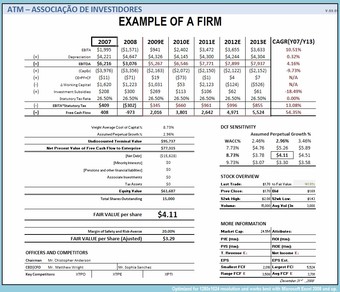
A Discounted Cash Flow Example
This is a good example of a what a discounted cash flow analysis would look like on paper, particularly as a prospective investor. There’s actually quite a bit more information here than you may strictly need to understand the calculation, but it’s a great way to see how each piece of information fits together.
10.3.4: The “Bond Yield Plus Risk Premium” Approach
We can estimate the value of a company’s equity by adding its risk premium to the yield to maturity on the company’s long-term debt.
Learning Objective
Describe the process for the bond yield plus risk premium approach
Key Points
- The BYPRP approach applies to a company’s publicly traded equity.
- The yield to maturity is the discount rate at which the sum of all future cash flows from a bond are equal to its price.
- The equity risk premium is the return that stocks are expected to receive in excess of the risk-free interest rate.
- The BYPRP approach does not produce as accurate an estimate as the capital asset pricing model or discounted cash flow analysis.
Key Terms
- dividend yield
-
A company’s total annual dividend payment per share, divided by its price per share.
- principal payment
-
The payment made upon maturity of a bond
- coupon payment
-
A periodic interest payment that the bondholder receives during the time between when the bond is issued and when it matures.
Example
- A company’s long-term debt has a yield to maturity of 6%. The risk premium on its equity is 4%. Thus, the required return on the company’s equity is 10%.
Bond Yield Plus Risk Premium Approach
The bond yield plus risk premium (BYPRP) approach is another method we can use to determine the value of an asset, specifically, a company’s publicly traded equity. BYPRP allows us to estimate the required return on an equity by adding the equity’s risk premium to the yield to maturity on company’s long-term debt.

Bond Yield Plus Risk Premium Equation
States that the required return on an equity equals the yield of the company’s long-term debt plus the equity’s risk premium.
Bond Yield vs. Risk Premium
Simply put, the yield on a bond is the rate of return received from the investment. In the BYPRP approach, we use a bond’s yield to maturity, which is the discount rate at which the sum of all future cash flows from the bond (coupon payments and principal payments) are equal to the price of the bond. This is also referred to as the internal rate of return (IRR).
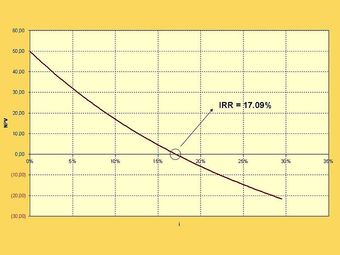
Yield To Maturity Graph
A hypothetical graph showing yield to maturities (or internal rates of return) for corresponding present values.
The equity risk premium is essentially the return that stocks are expected to receive in excess of the risk-free interest rate. The normal historical equity risk premium for all equities has been just over 6%. In general, an equity’s risk premium will be between 5% and 7%. Common methods for estimating the equity risk premium include:
- The Fed Model (forward operating earnings yield [earnings per share divided by share price] minus the 10-year U.S. Treasury Bond yield)
- The dividend yield plus projected earnings growth, minus the 10-year Treasury yield
- The historical stock returns minus the 10-year Treasury yield
Estimating the value of an equity using the bond yield plus risk premium approach has its drawbacks. We can only utilize the BYPRP approach if the entity has publicly traded debt, and it does not produce as accurate an estimate as the capital asset pricing model or discounted cash flow analysis.
Moreover, equity risk premium estimates can be highly inaccurate, while also varying wildly depending on which model is used. It can be very difficult to get an accurate estimate of the risk premium on an equity, having a duration of roughly 50 years, using a risk-free rate of such short duration as a 10-year Treasury bond.

Example Equation
Required return = 6% + 4%
10.4: The WACC
10.4.1: Weighted Average Cost of Capital
The weighted average cost of capital (WACC) is a calculation that reflects how much an organization pays in interest when acquiring financing options.
Learning Objective
Derive the weighted average cost of capital
Key Points
- The weighted average cost of capital (WACC) is a calculation that allows firms to understand the overall costs of acquiring financing.
- Capital inputs generally come in the form of debt and equity. Debt is usually quite simple to calculate as it is set in the terms of bonds and loans explicitly.
- Equity is a bit more complex, as it is subjected to market (systematic) risk. The capital asset pricing model is a useful tool in estimating the cost of equity.
- Applying the WACC to the estimated rate of return for new projects and ventures is a simple way to determine if a project is sufficiently profitable to offset the cost (risk) of financing.
Key Term
- weighted average cost of capital
-
A calculation of the overall cost of capital used by an enterprise, made by totaling the cost of each source of capital used multiplied by its proportional share of the total capital used.
Weighted Average Cost of Capital Defined
Organizations have a few options available when it comes to finding funding for their operations. From debt options such as taking out loans or offering long-term corporate bonds to equity such as preferred and common stock, larger organizations tend to find a balance between these options that is optimized for the best possible weighted average cost of capital (WACC) to operate at the scale that creates the best revenue opportunity.
In short, the WACC is a measure of what all of these capital inputs will cost the organization in terms of an average interest rate.
Why Calculate WACC?
WACC is a useful calculation, as it shows management what the cost of borrowing capital is overall. This overall cost of capital can then be a minimum required return on any new operation. For example, if it will cost 8% in capital costs to fund a project that creates 10% in profit, the organization can confidently borrow capital to fund this project. If the project would only turn 8% profit, the firm would have a difficult decision. If the project would turn 6% profit, it is quite easy to strategically argue against the new project.
How to Calculate WACC
Calculating the cost of capital is actually quite a simple equation. Most firms are only receiving from either debt or equity (though there can be quite few inputs to each of these subheadings). What this means is that the overall percentage of the business that is funded by debt (MVd/MVd + MVe) must be multiplied by the cost of debt (Rd), while similarly the percent funding of equity (MVe/MVd + MVe) must be multiplied by the cost of equity (Re) and added together. This can also be applied to the corporate tax rate in a given country of operation. This is written out as follows:
The cost of debt is usually fixed, based on the terms of a given bond or loan contract. As a result, the cost of debt is usually both certain and predictable. The cost of equity is a little bit more complex, as it is speculative and often determined (to some degree) by investor behavior. The capital asset pricing model (CAPM) is a traditional approach to determining the cost of equity:
Each of the variables here are defined as:
- Es – expected return
- Rf – expected risk-free return
- βs – sensitivity to market risk
- Rm -historical return
- (Rm – Rf) – risk premium of market assets over risk free assets.
By calculating the estimated cost of equity, and applying that to the WACC equation with the cost of debt and capital structure, organizations can determine the cost of capital (and thus the required return on projects/assets).
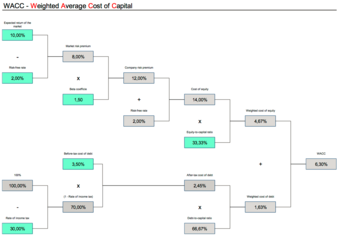
Weighted Average Cost of Capital Tree
This diagram is an excellent illustration of how various forms of debt and equity consolidate into broader calculation of debt and equity overall, and how those can combine as a total weighted average cost of capital.
10.4.2: The Weightings
The weightings used in the WACC are ratios of the market values of various forms of debt and equity used in a company’s financing.
Learning Objective
Define how a company’s weighted average cost of capital is weighted
Key Points
- The WACC must take into account the weight of each component of a company’s capital structure.
- The calculation of the WACC usually uses the market values of the various components rather than their book values.
- Market value is the price at which an asset would trade in a competitive auction setting.
- Book value refers to the value of an asset according to the account balance present on the balance sheet of a company.
- If the value of a company’s debt exceeds the value of its equity, the cost of its debt will have more “weight” in calculating its total cost of capital than the cost of equity. If the value of the company’s equity exceeds its debt, the cost of its equity will have more weight.
Key Term
- Synergy
-
Benefits resulting from combining two different groups, people, objects, or processes.
The Weightings
To calculate the weighted average cost of capital (WACC) we must take into account the weight of each component of a company’s capital structure. To review, the equation for WACC is:
MVe stands for the market value of equity; MVd stands for the Market Value of Debt; Re stands for cost of equity; Rd stands for cost of debt; and t is the company’s tax rate. If the person analyzing a company chooses or if the market value of a company’s debt and equity is not available, the book value can be used.
The “weighting” varies based on how the company finances its activities. If the value of a company’s debt exceeds the value of its equity, the cost of its debt will have more “weight” in calculating its total cost of capital than the cost of equity. If the value of the company’s equity exceeds its debt, the cost of its equity will have more weight.
Market Value vs. Book Value
Since we are measuring expected cost of new capital, the calculation of weighted average cost of capital usually uses the market values of the various components rather than their book values. These may differ significantly.
Market value is the price at which an asset would trade in a competitive auction setting. It is the true underlying value of an asset according to theoretical standards. It is a distinct concept from market price, which is the price at which one can transact. For market price to equal market value, the market must be efficient and rational. Market value also requires the element of “special value” to be disregarded. Special value refers to a synergy that may exist between two parties that makes the fair price of a transaction higher.
Book value refers to the value of an asset according to the account balance present on the balance sheet of a company. The balance sheet is a summary of the financial balances of a company and is often described as a “snapshot of a company’s financial condition. “
An asset’s initial book value is its actual cash value or its acquisition cost. Cash assets are recorded or “booked” at actual cash value. Assets such as buildings, land, and equipment are valued based on their acquisition cost, which includes the actual cash cost of the asset, plus certain costs tied to the purchase of the asset, such as broker fees.
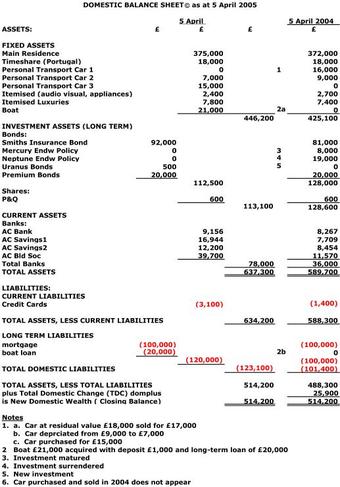
Domestic Balance Sheet
If the person analyzing a company chooses or if the market value of a company’s debt and equity is not available, the book value can be used. The book value of debt and equity can be found on the company’s balance sheet.
10.4.3: Factors Controlled by the Firm
Decisions about capital structure (ratio of debt and equity) alongside projecting rates of return can give firms some internal control over capital costs.
Learning Objective
Recognize the strategic considerations of capital structure by understanding weighted average cost of capital and the internal rate of return
Key Points
- By understanding the weighted average cost of capital (WACC) and potential internal rates of return (IRR) of various projects, firms can have some strategic control of capital costs and investment returns.
- Each funding source will come with a different cost of capital. Averaging these funding sources into the WACC is a central tool for financial management.
- Once the costs of capital are optimized, a business can apply this cost of capital to various asset and project assessments. The IRR must exceed the WACC.
Key Term
- capital structure
-
The way that a corporation finances its assets through some combination of equity, debt, and hybrid securities.
When pursuing financing, organizations encounter a variety of factors that impact the weighted average cost of capital. Some of these factors are within the firm’s strategic control, while others are external forces outside the firm’s control. As a financial professional or upper level strategist, understanding what capital structure options are available to a firm plays a critical role in financial management.
Capital Structure
Capital structure refers to the way in which an organization finances operations. This is generally illustrated via a balance sheet, where the overall assets are offset by the capital structure of liabilities and equity. It is through the decisions to acquire various forms of debt and equity that an organization can derive a weighted average cost of capital (WACC) that is sustainable within the context of organizational profitability. If the cost of capital is higher than the returns from those investments, the organization lacks the profitability required to justify itself. WACC is calculated as follows:
In the above equation, the first segment is measuring the cost of equity coupled with the percentage of the capital structure that is funded by equity. The second segment is making the same calculation, but this time with the cost of debt and the relative percentage of capital structure which is funded via this source. The final segment (1 – t) is the application of a corporate tax rate (depending on the country of operation.
Understanding the cost of each input of the capital structure, firms can control (to some degree) how they fund their operations and acquisitions of assets.
Internal Rate of Return
Another important decision made by financial professionals in relation to the cost of capital revolves around the required rates of return of various projects. Investing capital into an operation always incurs the opportunity cost of investing in something else. As a result, organizations can control their operations by measuring and projecting the rate of return on each project, and investing strategically in the most profitable projects.
An internal rate of return (IRR) calculation can be useful when doing this. The IRR is going to look at the net present value (NPV) of a given project, and calculate it for a break even point (i.e. set the equation to zero, when taking cost into account). By doing so, the organization can identify the anticipated rate of return on the project. take a look at the equation below:
In this equation, n is the number of periods in a project (i.e. number of anticipated cash flows over the life of the project), C is the cash flow amount (which can vary for each period, hence the summation), r is the rate of return being solved for, and N is total number of periods (n). When solving for zero, the organization will identify what the rate of return is for each project. Deciding upon projects that provide returns greater than the WACC derived from the capital structure will set the organization down a profitable path (assuming forecasts are reliable!).
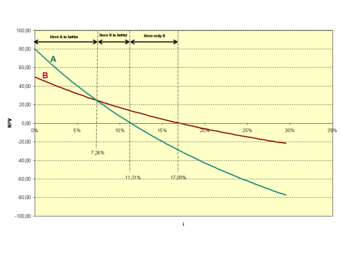
Exclusive_investments.png
When weighed different projects over time, the IRR calculation can be useful in determining which investment of capital is best over the lifetime of each project. When taking the WACC into account (derived from capital structure decisions), the organization can measure operational options against the required rate of return.
10.4.4: Factors External to the Firm
The weighted average cost of capital is vulnerable to market risks, interest rate changes, inflation, economic factors, and tax rates.
Learning Objective
Recognize the various external factors that may impact the weighted average cost of capital
Key Points
- While organizations have some control over capital structure decisions, there are many factors at play in the external environment that are outside the control of the firm.
- Interest rates, inflation, and other economic forces can play a substantial role in the overall cost of capital.
- Fluctuations in the marketplace (i.e. market risk, or systematic risk) can be both unpredictable and influential on overall risk and return for investors, impacting capital costs.
- Corporate and investor tax legislation impacts the cost of capital, as both organizations and investors must factor tax into their investment decisions.
Key Term
- systematic risk
-
Risk that is intrinsic to the marketplace.
When organizations begin weighing the weighted average cost of capital (WACC) and determining overall capital structure, there are some factors that are within the control of the organization, and some external factors that are not. When it comes to projecting the cost of capital, it’s useful to assess some of the external factors that may influence the overall cost.
Interest Rates
Interest rates fluctuate for a wide variety of reasons, and are a primary tool of monetary policy. Governments and central banks often make alterations to interest rates as a result of investment, unemployment, inflation, and other broader economic factors. Altering interest rates can impact the spending, borrowing, and investing habits within an economy, and therefore tend to fluctuate for economic purposes.
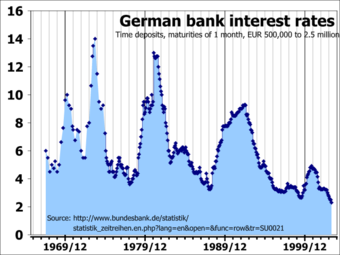
German Bank Interest Rates
This chart illustrates changes in interest rates in Germany over time.
Inflation
Related to interest rates (and a direct impact upon interest rate change) is the natural inflation or deflation of the currency being borrowed or lent. Organizations must take into account the time value of money as it pertains to that capital’s actual alterations in value, which is firmly outside the control of the organization.
Market Fluctuations
2008 is a prime example of how market forces can drastically impact equity. As markets rise and fall, the cost of capital as well as the perceived market risk (systematic risk) will naturally and relatively unpredictably fluctuate. When utilizing markets as a source of funding, the intrinsic risk of the market itself is outside of the control of the organization.
Corporate Tax
Depending upon the region of operation, tax implications may have a significant impact on the cost of capital. In many jurisdictions, debt and interest on equity may receive certain tax breaks. Investors may also encounter taxes on returns on their investments and tax on dividends, impacting the perceived risk and return ratio of a prospective investor. Profit beyond the cost of expenses and capital will be taxed as well, which impacts the overall weighted average cost of capital.
Other Factors
The cost of capital is largely a simple trade off between the time value of money, risk, return, and opportunity cost. Any external factors in the form of opportunity costs or unexpected risks can impact the overall cost of capital.
10.4.5: Making Risk Adjustments
New projects sometimes require taking on risks outside of a company’s current scope, resulting in the need to adjust risk in the WACC.
Learning Objective
Describe how individual projects can alter a company’s WACC of capital
Key Points
- It is possible to adjust risk by figuring the differing risk into the company’s beta.
- The beta coefficient is the risk of a new project in relation to the risk of the market as a whole.
- Therefore, if a new project of differing risk is undertaken, the beta for that project will be weighted into the company’s overall cost of capital.
Key Term
- covariance
-
A measure of how much two random variables change together.
Making Risk Adjustments
The weighted average cost of capital is the minimum return that a company must earn on an existing asset base. This means that, when calculated, WACC will produce a rate equivalent with the current level of risk present in a company’s activities. However, some new ventures will require taking on risks outside of the company’s current scope.
In this case, adjustments will need to be made to the WACC in order to account for the differing level of risk. If the risk is very different, the company’s current WACC may be sidestepped altogether in favor of a WACC typical for companies with similar investments. It is possible to make such adjustments by figuring the differing risk into the company’s beta .

Beta Equation
The beta of an investment is equal to the covariance between the rate of return of the investment, r(a), and that of the portfolio, r(p).
The beta coefficient, expressed as a covariance, is the risk of a new project in relation to the risk of the market as a whole. A company itself will be considered, for investment purposes, as a “portfolio of assets,” and its beta coefficient will represent the weighted average of each “asset’s” beta. Therefore, if a new project of differing risk is undertaken, the beta for that project will be weighted into the company’s overall cost of capital. For example, if the project is twice as sensitive to fluctuations in the market as the company as a whole, then the project’s beta should be twice that of the company during the valuation process. This will increase the risk premium on the project and its cost of equity and subsequently the weighted average cost of capital. This increase in cost of capital will devalue the company’s stock, unless this increase was offset by a higher expected rate of return.
10.4.6: Problems with WACC
While a WACC analysis is highly useful in understanding the cost of funding a project, it relies on assumptions.
Learning Objective
Recognize the risk of using a WACC analysis to predict the overall cost of capital
Key Points
- A weighted average cost of capital (WACC) calculation is a great tool for businesses (particularly financial professionals) in understanding how much it will cost to finance a project.
- However, despite this usefulness, a WACC calculation relies on assumptions that may or may not prove true. This uncertainty should be taken into account when making projections.
- Some of these assumptions include the profitability of the project (which should exceed the cost of capital), the opportunity cost of foregone investments, and the total amount of capital required for the project.
- Whenever a firm uses forecasts such as a WACC, the most important thing to keep in mind is that future planning is based on assumptions. Identify each assumption, and mitigate the risk through understanding worst-case scenarios.
Key Term
- capital requirements
-
The amount of money a project needs in order to be successfully funded.
WACC
The weighted average cost of capital (WACC) is a common and highly useful approach to determining how much it will cost (as a percentage) to borrow money in order to fund a given operation or project. This overall cost of borrowing capital is a great tool for financial professionals, who would like to understand how much a project will cost, and how much it will provide in return. The overall goal is to maintain a certain level of profitability when it comes to making investments in organizational projects.
As a reminder, the formula for WACC is:
Advantages
As a model, the WACC has quite a few advantages. Generally speaking, this process will take into account the differences between the cost of debt and the cost of equity in a given calculation. This allows the firm to understand how much a project funded fully by debt would differ in terms of capital costs than a project that requires a great deal of equity as well (hint: debt is almost always cheaper). It also takes into account the time value of money, normalizing cash flows for present value. Another advantage of this calculation is the simplicity of it. Upper management can quickly look at the WACC for a given project, and compare that to the forecast of the profitability.
Problems
No forecast is perfect, however. All financial professionals and upper management executives must understand the drawbacks of WACC (along with those of virtually every attempt to project future costs and profits with present and past data).
The simplest problem with the calculation are the assumptions it relies on. These can include:
- Profitability – When determining the cost of capital, this number isn’t particularly useful without an understanding of the return on that capital. After all, the profitability must exceed the cost of borrowing the money. Profitability in a future market is never certain, as the demands, needs, competition, and price of inputs could change any day.
- Opportunity Costs – Another important consideration are the opportunity costs, both for investors in the business and the business itself. The cost of capital, particularly on the equity side, are made through identifying the risk of this particular project compared to other projects that could be invested in. These opportunity costs will change over time, which may also change the cost of funding (depending on the contract which secures that funding).
- Amount Required – Projects often encounter unforeseen hurdles, and jumping over these hurdles may required capital that hasn’t been considered in the forecast. As the amount of capital required increases, the financial risk from investors also increases. Higher risk means higher returns, and more capital requirements during the project may increase the overall average cost of capital.
Conclusion
While the WACC calculation does rely on quite a few assumptions, this is something of a necessary risk when it comes to financial projections. Forecasts are not sure things, they are intrinsically uncertain. It is exactly due to this uncertainty that capital investments are risk, and require returns in the first place. When using this model to predict how much capital can be borrowed and at what rate, keep in mind that the situation can change any day.
Chapter 9: Security Market Efficiency and Returns
9.1: The Security Markets
9.1.1: Types of Stock Market Transactions
Types of stock market transactions include IPO, secondary market offerings, secondary markets, private placement, and stock repurchase.
Learning Objective
Differentiate between the different types of stock market transactions
Key Points
- An initial public offering (IPO), or stock market launch, is a type of public offering where shares of stock in a company are sold to the general public, on a securities exchange, for the first time.
- A secondary market offering is a registered offering of a large block of a security that has been previously issued to the public.
- In the secondary market, securities are sold by and transferred from one investor or speculator to another. It is therefore important that the secondary market remain highly liquid.
- Private placement (or non-public offering) is a funding round of securities which are sold not through a public offering, but rather through a private offering, mostly to a small number of chosen investors.
- Stock repurchase (or share buyback) is the reacquisition by a company of its own stock.
Key Terms
- underwriter
-
An entity which markets newly issued securities
- FINRA
-
In the United States, the Financial Industry Regulatory Authority, Inc., or FINRA, is a private corporation that acts as a self-regulatory organization (SRO). FINRA is the successor to the National Association of Securities Dealers, Inc. (NASD). Though sometimes mistaken for a government agency, it is a non-governmental organization that performs financial regulation of member brokerage firms and exchange markets. The government organization which acts as the ultimate regulator of the securities industry, including FINRA, is the Securities and Exchange Commission.
Types of Stock Market Transactions
IPO
An initial public offering (IPO), or stock market launch, is a type of public offering where shares of stock in a company are sold to the general public, on a securities exchange, for the first time. Through this process, a private company transforms into a public company. Initial public offerings are used by companies to raise expansion capital, monetize the investments of early private investors, and become publicly traded enterprises.
A company selling shares is never required to repay the capital to its public investors. After the IPO, when shares are traded freely in the open market, money passes between public investors.
When a company lists its securities on a public exchange, the money paid by the investing public for the newly issued shares goes directly to the company (primary offering) as well as to any early private investors who opt to sell all or a portion of their holdings (secondary offering) as part of the larger IPO. An IPO, therefore, allows a company to tap into a wide pool of potential investors to provide itself with capital for future growth, repayment of debt, or working capital.
Although an IPO offers many advantages, there are also significant disadvantages. Chief among these are the costs associated with the process, and the requirement to disclose certain information that could prove helpful to competitors, or create difficulties with vendors. Details of the proposed offering are disclosed to potential purchasers in the form of a lengthy document known as a prospectus.
Most companies undertaking an IPO do so with the assistance of an investment banking firm acting in the capacity of an underwriter. Underwriters provide a valuable service, which includes help with correctly assessing the value of shares (share price), and establishing a public market for shares (initial sale).
Secondary market offering
A secondary market offering, according to the U.S. Financial Industry Regulatory Authority (FINRA), is a registered offering of a large block of a security that has been previously issued to the public. The blocks being offered may have been held by large investors or institutions, and proceeds of the sale go to those holders, not the issuing company. This is also sometimes called secondary distribution.
A secondary offering is not dilutive to existing shareholders, since no new shares are created. The proceeds from the sale of the securities do not benefit the issuing company in any way. The offered shares are privately held by shareholders of the issuing company, which may be directors or other insiders (such as venture capitalists) who may be looking to diversify their holdings. Usually, however, the increase in available shares allows more institutions to take non-trivial positions in the issuing company which may benefit the trading liquidity of the issuing company’s shares.
Transactions on Secondary Market
After the initial issuance, investors can purchase from other investors in the secondary market. In the secondary market, securities are sold by and transferred from one investor or speculator to another. It is therefore important that the secondary market be highly liquid. As a general rule, the greater the number of investors that participate in a given marketplace, and the greater the centralization of that marketplace, the more liquid the market.
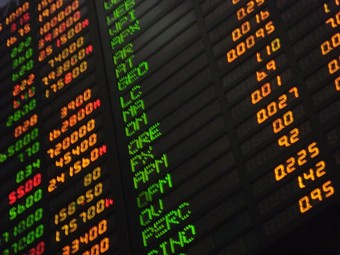
The Philippine Stock Market Board
Private placement
Private placement (or non-public offering) is a funding round of securities which are sold not through a public offering, but rather through a private offering, mostly to a small number of chosen investors. “Private placement” usually refers to the non-public offering of shares in a public company (since, of course, any offering of shares in a private company is and can only be a private offering).
Stock repurchase
Stock repurchase (or share buyback) is the reacquisition by a company of its own stock. In some countries, including the U.S. and the UK, a corporation can repurchase its own stock by distributing cash to existing shareholders in exchange for a fraction of the company’s outstanding equity; that is, cash is exchanged for a reduction in the number of shares outstanding. The company either retires the repurchased shares or keeps them as treasury stock, available for re-issuance.
Companies making profits typically have two uses for those profits. Firstly, some part of profits can be distributed to shareholders in the form of dividends or stock repurchases. The remainder, termed stockholder’s equity, are kept inside the company and used for investing in the future of the company. If companies can reinvest most of their retained earnings profitably, then they may do so. However, sometimes companies may find that some or all of their retained earnings cannot be reinvested to produce acceptable returns.
9.1.2: Types of Market Organizations
There are three main types of market organization that facilitate trading of securities: auction market, brokered market, and dealer market.
Learning Objective
Differentiate between the different types of market organizations
Key Points
- The primary market is that part of the capital markets that deals with the issue of new securities.
- Over-the-counter (OTC) or off-exchange trading is to trade financial instruments such as stocks, bonds, commodities, or derivatives directly between two parties.
- The secondary market, also called aftermarket, is the financial market in which previously issued financial instruments such as stock, bonds, options, and futures are bought and sold.
- One type of market structure is the auction market, where buyers and sellers are brought together directly, announcing the prices at which they are willing to buy or sell securities.
- Broker markets are usually only used for securities that have no public market, necessitating the middleman in the form of a broker. The broker works for a client to find a suitable trading partner.
- Dealer markets, also called quote-driven markets, centers on market-makers (or dealers) who provide the service of continuously bidding for securities that investors want to sell and offering securities that investors want to buy.
Key Terms
- dealer market
-
an exchange where institutions are assigned to a particular security and trade out of their own account
- auction market
-
an exchange where goods and services are offered up for bid, bids are taken, and then sold to the highest bidder
- securities
-
Synonymous with “financial instrument. ” A tradable asset of any kind; either cash, evidence of an ownership interest in an entity, or a contractual right to receive or deliver cash or another financial instrument.
- swaps
-
A swap is a derivative in which counterparties exchange cash flows of one party’s financial instrument for those of the other party’s financial instrument.
- forwards
-
A non-standardized contract between two parties to buy or sell an asset at a specified future time at a price agreed upon today.
Security Markets
The securities market is an economic institute where sale and purchase transactions of securities between subjects of economy take place according to demand and supply. These can be broken down into different types based on what is being traded. They are also differentiated by structure. The primary market is the part of the capital markets that deals with the issue of new securities. The secondary market, also known as the aftermarket, is the financial market where previously issued securities and financial instruments such as stock, bonds, options, and futures are bought and sold. After the initial issuance, investors can purchase from other investors in the secondary market.
The major stock exchanges are the most visible example of liquid secondary markets – in this case, for stocks of publicly traded companies. Exchanges such as the New York Stock Exchange, Nasdaq, and the American Stock Exchange provide a centralized, liquid secondary market for the investors who own stocks that trade on those exchanges. Most bonds and structured products trade “over the counter,” or by phoning the bond desk of one’s broker-dealer. Over-the-counter (OTC) or off-exchange trading is to trade financial instruments such as stocks, bonds, commodities, or derivatives directly between two parties. It is contrasted with exchange trading, which occurs via facilities constructed for the purpose of trading (i.e., exchanges), such as futures exchanges or stock exchanges.
In the U.S., over-the-counter trading in stock is carried out by market makers that make markets in OTCBB and Pink Sheets securities using inter-dealer quotation services such as Pink Quote (operated by Pink OTC Markets) and the OTC Bulletin Board (OTCBB). OTC stocks are not usually listed nor traded on any stock exchanges, although exchange listed stocks can be traded OTC on the third market. An over-the-counter contract is a bilateral contract in which two parties agree on how a particular trade or agreement is to be settled in the future. It is usually from an investment bank to its clients directly. Forwards and swaps are prime examples of such contracts.
Types of Market Organization
There are three main types of market organization that facilitate the trading of securities: an auction market, a brokered market, and a dealer market. Hybrids of these types may also exist.
In the auction market format, buyers and sellers are brought together directly, announcing the prices at which they are willing to buy or sell securities. “Orders” are centralized by the market, so highest bidders and lowest sellers are exposed to each other. The New York Stock Exchange is a notable secondary market that is structured as an auction market. The NYSE trades in a continuous auction format, where traders can execute stock transactions on behalf of investors. They will gather around the appropriate post where a “specialist” acts as an auctioneer in an open outcry auction market environment to bring buyers and sellers together and to manage the actual auction.
Broker markets are usually only used for securities that have no public market, necessitating the middleman in the form of a broker. When a client asks their broker to fill an order, it is the broker’s job to track down trading partners. The broker provides information about potential buyers and sellers and earns a commission in return. Municipal bonds are often traded in this way.
Dealer markets, also called quote-driven markets, centers on market-makers (or dealers) who provide the service of continuously bidding for securities that investors want to sell and offering securities that investors want to buy. This person or company quotes both a buy and a sell price in a financial instrument or commodity held in inventory. Dealers earn a profit on the bid-offer spread. Most foreign exchange trading firms are market makers and so are many banks. The market maker sells to and buys from its clients and is compensated by means of price differentials for the service of providing liquidity, reducing transaction costs and facilitating trade. The NASDAQ, many OTC markets, and the Forex are structured this way .
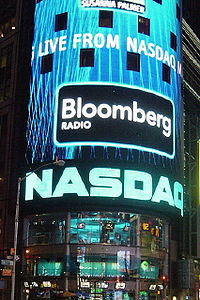
NASDAQ
NASDAQ is a major example of a secondary quote-driven market.
9.2: Understanding Returns
9.2.1: Reporting
When accounting for capital gains and losses in the securities market, understanding reporting responsibilities and potential reductions is critical.
Learning Objective
Recognize the broader points of capital gains reporting, alongside the potential reductions available
Key Points
- Capital gains and losses must be reported to their respective countries for investments in debt, equity, and derivatives.
- When an investment is sold in the market for a loss or gain in a given reporting period, that investment must be reported as income on the income statement.
- When an investment is held over the reporting period, it is an asset on the balance sheet and reported accordingly.
- There are a wide variety of tax reductions on certain investment types, and understanding the existing legislation for reductions or deferments can be a significant value add for organizations.
Key Terms
- Securities
-
Assets purchased in the securities market, such as equity, debt and derivatives.
- capital gains
-
Values captured from the trade of assets on the securities market.
Securities to Report
Both organizations and individual investors trade a wide variety of financial securities with the intention of gaining returns upon these investments. Securities include exchanges involving:
- Debt securities bonds, banknotes, debentures, etc.)
- Equity (mutual funds, stock, commodities, etc.)
- Derivatives (options, forwards, futures, swaps, etc.)
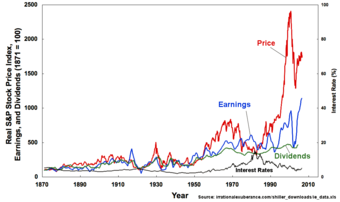
Stock Price Index Over Time
The securities trading markets have appreciated substantially in recent times, making the scale of investments (and subsequent reporting) more important than ever.
When considering the returns derived from these various investments, organizations and individuals must be aware of the reporting obligations in the country in which those securities are traded. Organizations like the IRS have a wide variety of taxation requisites depending upon different investment situations, and understanding these regulations is critical to ethical trading and adherence to legalities.
Reporting Obligations
Capital Gains
Most commonly, reporting of investments will fall under the reporting of capital gains. Both organizations and individuals must report any and all capital gains within a given time period. These capital gains are profits derived from the sale of investments, which is to say that existing investments where capital is still tied in the underlying asset it not taxable (though it must be reported on the balance sheet for organizations as assets).
When profits from short term investments are derived in a taxation period for an organization, this profit is reported on the income statement and taxed accordingly. Capital gains taxes can differ based on the duration and type of investment made, but for the sake of this discussion it is enough to understand that an existing investment is an asset on the balance sheet and profit from the trade of an investment should be reported as profit (or loss) on the income statement.
Potential Reductions and Deferrals
As with most regulatory environments, it is not a one size fits all model. There are various situations where capital gains taxes can be reduced through understanding the legislation and reporting accurately and strategically. A few examples of potential reductions or deferrals in capital gains reporting include:
- In some countries, specific industry investments receive tax breaks to stimulate economic growth. For example, an investment in new green technologies is often a source of potential tax break, as it is beneficial to the broader economy and world at large.
- Retirement investments are often tax free (until withdrawn) to stimulate responsible saving and retirement planning. This allows companies to accumulate interest on what would’ve been taxable income until the capital is removed from the account.
- The sale of an asset at a loss is often a tax deductible, as are other capital losses.
- Donations of assets or capital to charity are tax deductible in most situations.
- Occasionally, the acquisition of certain assets will have the value reevaluated. In such situations, the difference between the original price and the new price may be a source of tax deduction.
While there are countless other small legislative items which may indicate tax implications on capital gains, this gives a reasonable overview of the types of considerations accountants make when considering capital gains.
9.2.2: Dollar Returns
The dollar return is the difference between the final value and the initial value in nominal terms.
Learning Objective
Calculate an investment’s dollar return
Key Points
- Dollar returns do not take into account things like the time value of money or the time frame of the investment.
- In security markets, the dollar return of the security is the difference in the final market price and the market price at which it was purchased.
- Dollar returns are useful for determining the nominal amount that the firm’s assets will change.
Key Term
- return
-
Gain or loss from an investment.
The dollar return of a security is the difference between the initial and ending value.
Finding the dollar return for securities that trade in open markets is a matter of finding the difference in price from year to year. For example, consider in which a $100 security earns a stated return of 5% per year. At the end of year 1, it is worth $105, which is $5 more than $100 (its value at the beginning of year 1), so the dollar return is $5. The capital value at the end of year 2 is $110.25, which is $5.25 more than at the end of year 1, and $10.25 more than at the beginning of year 1. Therefore, the dollar gain is $10.25. This continues for each successive year.
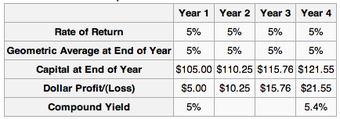
Dollar Profit/(Loss)
The dollar return is the difference in value from year to year, plus the previous dollar return.
The dollar return does not take into account things like the time value of money or how the amount of return earned per year; it is simply the difference in nominal values. This means that dollar returns can provide an incomplete picture if used incorrectly. For example, suppose an investor has two investment options, both of which promise a dollar return of $1,000,000. S/he cannot tell which option is better without knowing additional details such as the risk or how long it will take to realize the returns. If the first option has a $1,000,000 return over two years and the other has a $1,000,000 return over 10 years, the first option is clearly more attractive.
Dollar returns are valuable for comparing the nominal differences in investments. If two investments have similar profiles (risk, duration, etc.), than dollar returns is a useful way to compare them. The investor will always choose the option with the higher dollar return. Furthermore, the dollar return is useful because it provides an idea about how the assets of a firm will change. If a firm is looking for an additional $50,000 from investment, they will only accept investments with a $50,000 dollar return, regardless of the percent return.
9.2.3: Percentage Returns
Percentage returns show how much the value of the investment has changed in proportion to the size of the initial investment.
Learning Objective
Calculate an investment’s percentage return using CAGR
Key Points
- Total percentage returns divide the dollar returns by the initial value of the investment. This is also the return on investment (ROI).
- Annual returns show the percentage by which the value of the asset changes in each individual year.
- Average annual percentage returns can be calculated by dividing ROI by the number of years, or by other methods such as the compound annual growth rate (CAGR) or internal rate of return (IRR).
Key Terms
- compound annual growth rate
-
CAGR. A method for finding the average annual return of an investment.
- internal rate of return
-
IRR. The rate of return on an investment which causes the net present value of all future cash flows to be zero.
- return on investment
-
ROI. The dollar return of the investment divided by the initial value.
The conventional way to express the return on a security (and investments in general) is in percentage terms. This is because it does not only matter how much money was earned on the investment, it matters how much was earned in proportion to the cost.
There are two types of percentage returns: total and annual. Total returns calculate how much the value of the investment has changed since it was first purchased, while annual returns calculate how much the value changed each year. When the length of time of the investment is one year, the total and annual returns are equivalent.
Total Returns
The total percentage return is based off of the final value (Vf), the initial value (Vi), and all dividend payments or additional incomes (D). If the investment is a security such as a stock, the final value is the sales price, the initial value is the purchase price, and D is the sum of all dividends received.
This type of return is also called the return on investment (ROI), where the numerator is the dollar return.
Annual Returns
In , the ROI is calculated for each individual year by dividing the dollar return by the initial value of $1,000. To find the return for the security overall, simply sum the dollar returns and divide by the initial value. The ROI can be annualized by dividing by the number of years between the purchase and sale of the security. This is the arithmetic mean of the return.

Cash Flow Return
The ROI is the percentage return, and is calculated by dividing the dollar return by the initial value of the investment ($1,000).
However, this does not fully take into consideration compounding. To do so, analysts use other formulas, like the compound annual growth rate (CAGR):
In this case, the only variable that differs from the previous formula is t, which is the number of years between the beginning and end of the investment. CAGR is a way of measuring the return per year. It is widely used because it allows for the easy comparison of the growth rates of multiple investments.
Another common method for finding the annual return is to calculate the internal rate of return (IRR). Recall that the IRR is the discount rate at which the net present value (NPV) equals 0.
9.2.4: Historical Returns: Market Variability and Volatility
Markets and securities may follow general trends, but exogenous factors (such as macroeconomic changes) cause variability and volatility.
Learning Objective
Describe how historical returns can be used to predict future performance
Key Points
- Historical returns do not guarantee future returns.
- All markets have a degree of systemic risk which means that they have a risk of collapsing due to external factors. Companies are also interconnected, so the failure of one company can have far-reaching effects.
- “Animal spirits” describes general investor sentiment which can affect markets, even without changes in the underlying financials.
Key Terms
- systemic risk
-
The risk of collapse of an entire financial system or entire market.
- volatility
-
A quantification of the degree of uncertainty about the future price of a commodity, share, or other financial product.
- animal spirits
-
After Keynes (citation 1936, above), the emotional and intuitive factors that drive business decisions whether to make investment gambles.
Historical analysis of markets and of specific securities is a useful tool for investors, but it does not predict the future of the market. There are general trends and expectations of future behavior, but they are just generalizations. For example, the Dow Jones Industrial Average (DJIA) has generally followed an upward trend from 1900-2009 . However, an investor who looked at this graph in early 1929 and made the decision to invest because s/he would be guaranteed to make money was in for a shock when the market crashed in October 29, 1929. Past performance is not a guarantee of future performance.

DJIA 1900-2009
The Dow Jones Industrial Average has generally increased overall since 1900, but its past performance is not a guarantee of future performance.
Inherent in all markets is something called “systemic risk. ” Systemic risk is the risk of collapse of an entire financial system or entire market, as opposed to risk associated with any one individual entity, group, or component of a system. Macroeconomic forces, such as the Great Depression, affect the entire stock market and can’t be predicted from past market performance. The failure of one company affects all the companies who purchase from it or sell to it, which in turn affects all the companies that rely on them. These types of interlinkages are a cause of the overall market variability and volatility.
Furthermore, market variability and volatility can be the cause of what John Maynard Keynes called animal spirits. Animal spirits are the emotions felt by investors who affect markets. Expectations of investors affect how they act, which in turn affects the markets. If investors are feeling optimistic, for example, the market may go up, even without an improvement in the financials of the underlying companies.
Markets and stocks are affected by many factors beyond the information in their financial statements and past performance. Historical returns may provide an idea of the overall trend, but certainly are not enough to accurately predict future performance.
9.2.5: Calculating and Understanding Average Returns
Average returns are commonly found using average ROI, CAGR, or IRR.
Learning Objective
Differentiate between the different methods for calculating the average return of an investment
Key Points
- Average return on investment (ROI) is the arithmetic average of the total cash returns divided by the initial investment. It is useful for quick calculations and specific securities (such as bonds purchased at par), but does not account for compounding returns.
- Compound annual growth rate (CAGR) is derived from the future value formula with compounding interest. It accounts for compounding returns.
- Internal rate of return (IRR) is the discount rate at which the NPV equals 0. It is used because it allows for easy comparison between investment options and is easy to understand.
- For all three methods, the higher the average rate of return, the more attractive the investment is.
Key Term
- compounding returns
-
Returns earned on previous returns. Akin to compounding interest.
The average return of an investment can be calculated a number of ways. The three main methods are
- Return on investment (ROI)
- Compound annual growth rate (CAGR)
- Internal rate of return (IRR).
For all three methods, the higher the rate, the more desirable the investment.
ROI
To calculate the total ROI of an investment, simply divide the total dollar returns of the investment by the initial value. The average ROI is the arithmetic average: divide the total ROI by the number of periods. If the purchase of a stock led to an ROI of 15% over 5 years, the average ROI is 3% per year. This is a simple way to calculate the average return. It is useful for certain securities such as bonds. If the only source of return on a bond is the coupon payments, then this is an accurate method. A bond purchased at par that pays a 5% coupon per year, will have a return of 25% over 5 years. However, this is a very special case. Average ROI generally does not calculate the actual average rate of return, because it does not incorporate compounding returns. A stock that appreciates by 3% per year would not actually be worth 15% more over 5 years, because the gains compound.
CAGR
CAGR stands for compound annual growth rate. It is calculated by the following formula where Vf is the future value, Vi is the initial value, and t is the number of years:
CAGR, unlike average ROI, does consider compounding returns. CAGR is derived from the compounding interest formula, FV=PV(1+i)t, where PV is the initial value, FV is the future value, i is the interest rate, and t is the number of periods. The CAGR formula is what results when solving for i: the interest rate becomes CAGR, FV becomes Vf, PV becomes Vi, and the number of periods is generally assumed to be in years.
CAGR is very useful for finding the rate of return that the investment would have to earn every year for the life of the investment to turn the initial value into the future value over the given time frame.
IRR
The internal rate of return (IRR) is another commonly used method for calculating the average return . IRR is the discount rate at which the net present value (NPV) is equal to 0. Using IRR allows for easy comparison between investment options. It is also known as the effective interest rate.

Internal Rate of Return
The IRR is calculated by finding the discount rate at which the NPV of the investment equals 0.
9.3: Market Efficiency
9.3.1: Behavior of an Efficient Market
Efficient-market hypothesis (EMH) asserts that financial markets are informationally efficient and should therefore move unpredictably.
Learning Objective
Describe what an efficient market looks like
Key Points
- The efficient-market hypothesis (EMH) asserts that financial markets are “informationally efficient. ” As a result, one cannot consistently achieve returns in excess of average market returns on a risk-adjusted basis, given the information available at the time the investment is made.
- Historically, there was a very close link between EMH and the random-walk model and then the Martingale model. The random character of stock market prices was first modelled by Jules Regnault, a French broker, in 1863.
- The definitions for three forms of financial market efficiency: weak, semi-strong, and strong.
Key Term
- Martingale model
-
In probability theory, a martingale is a model of a fair game where knowledge of past events will never help to predict future winnings.
In finance, the efficient-market hypothesis (EMH) asserts that financial markets are “informationally efficient. ” As a result, one cannot consistently achieve returns in excess of average market returns on a risk-adjusted basis, given the information available at the time the investment is made.
There are three major versions of the hypothesis: “weak,” “semi-strong,” and “strong. ” The weak-form EMH claims that prices on traded assets (e.g., stocks, bonds, or property) already reflect all past publicly available information. The semi-strong-form EMH claims both that prices reflect all publicly available information and that prices instantly change to reflect new public information. The strong-form EMH also claims that prices instantly reflect even hidden or “insider” information. Critics have blamed the belief in rational markets for much of the late-2000’s financial crisis. In response, proponents of the hypothesis have stated that market efficiency does not mean having no uncertainty about the future. Market efficiency is a simplification of the world which may not always hold true. The market is practically efficient for investment purposes for most individuals.
Random-Walk Model
Historically, there was a very close link between EMH and the random-walk model and then the Martingale model. The random character of stock market prices was first modelled by Jules Regnault, a French broker, in 1863 and then by Louis Bachelier, a French mathematician, in his 1900 PhD thesis, “The Theory of Speculation. ” His work was largely ignored until the 1950’s; however, beginning in the 1930’s scattered, independent work corroborated his thesis. A small number of studies indicated that U.S. stock prices and related financial series followed a random walk model. Research by Alfred Cowles in the ’30s and ’40s suggested that professional investors were in general unable to outperform the market .
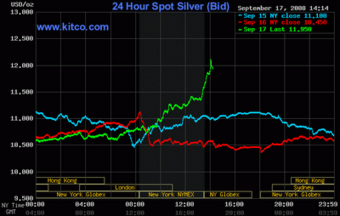
Random Walk
Stock market cannot be predicted.
Weak, Semi-strong, and Strong
The efficient-market hypothesis emerged as a prominent theory in the mid-1960’s. Paul Samuelson had begun to circulate Bachelier’s work among economists. In 1964 Bachelier’s dissertation along with the empirical studies mentioned above were published in an anthology edited by Paul Cootner. In 1965 Eugene Fama published his dissertation arguing for the random walk hypothesis, and Samuelson published a proof for a version of the efficient-market hypothesis. In 1970 Fama published a review of both the theory and the evidence for the hypothesis. The paper extended and refined the theory, included the definitions for three forms of financial market efficiency: weak, semi-strong, and strong.
It has been argued that the stock market is “micro efficient,” but not “macro inefficient. ” The main proponent of this view was Samuelson, who asserted that the EMH is much better suited for individual stocks than it is for the aggregate stock market. Research based on regression and scatter diagrams has strongly supported Samuelson’s dictum.
9.3.2: The Efficient Market Hypothesis
The EMH asserts that financial markets are informationally efficient with different implications in weak, semi-strong, and strong form.
Learning Objective
Differentiate between the different versions of the Efficient Market Hypothesis
Key Points
- In weak-form efficiency, future prices cannot be predicted by analyzing prices from the past.
- In semi-strong-form efficiency, it is implied that share prices adjust to publicly available new information very rapidly and in an unbiased fashion, such that no excess returns can be earned by trading on that information.
- In strong-form efficiency, share prices reflect all information, public and private, and no one can earn excess returns.
Key Terms
- technical analysis
-
A stock or commodity market analysis technique which examines only market action, such as prices, trading volume, and open interest.
- fundamental analysis
-
An analysis of a business with the goal of financial projections in terms of income statement, financial statements and health, management and competitive advantages, and competitors and markets.
- insider trading
-
Buying or selling securities of a publicly held company by a person who has privileged access to information concerning the company’s financial condition or plans.
The efficient-market hypothesis (EMH) asserts that financial markets are “informationally efficient. ” In consequence of this, one cannot consistently achieve returns in excess of average market returns on a risk-adjusted basis, given the information available at the time the investment is made.
There are three major versions of the hypothesis: weak, semi-strong, and strong.
- The weak-form EMH claims that prices on traded assets (e.g., stocks, bonds, or property) already reflect all past publicly available information.
- The semi-strong-form EMH claims both that prices reflect all publicly available information and that prices instantly change to reflect new public information.
- The strong-form EMH additionally claims that prices instantly reflect even hidden or “insider” information.
Weak-form efficiency
In weak-form efficiency, future prices cannot be predicted by analyzing prices from the past. Excess returns cannot be earned in the long run by using investment strategies based on historical share prices or other historical data. Technical analysis techniques will not be able to consistently produce excess returns, though some forms of fundamental analysis may still provide excess returns. Share prices exhibit no serial dependencies, meaning that there are no “patterns” to asset prices. This implies that future price movements are determined entirely by information not contained in the price series. Hence, prices must follow a random walk. This “soft” EMH does not require that prices remain at or near equilibrium, but only that market participants not be able to systematically profit from market “inefficiencies. ” However, while EMH predicts that all price movement (in the absence of change in fundamental information) is random (i.e., non-trending), many studies have shown a marked tendency for the stock markets to trend over time periods of weeks or longer and that, moreover, there is a positive correlation between degree of trending and length of time period studied (but note that over long time periods, the trending is sinusoidal in appearance). Various explanations for such large and apparently non-random price movements have been promulgated.
Semi-strong-form efficiency
In semi-strong-form efficiency, it is implied that share prices adjust to publicly available new information very rapidly and in an unbiased fashion, such that no excess returns can be earned by trading on that information. Semi-strong-form efficiency implies that neither fundamental analysis nor technical analysis techniques will be able to reliably produce excess returns. To test for semi-strong-form efficiency, the adjustments to previously unknown news must be of a reasonable size and must be instantaneous. To test for this, consistent upward or downward adjustments after the initial change must be looked for. If there are any such adjustments it would suggest that investors had interpreted the information in a biased fashion and, hence, in an inefficient manner.
Strong-form efficiency
In strong-form efficiency, share prices reflect all information, public and private, and no one can earn excess returns. If there are legal barriers to private information becoming public, as with insider trading laws, strong-form efficiency is impossible, except in the case where the laws are universally ignored. To test for strong-form efficiency, a market needs to exist where investors cannot consistently earn excess returns over a long period of time. Even if some money managers are consistently observed to beat the market, no refutation even of strong-form efficiency follows–with hundreds of thousands of fund managers worldwide, even a normal distribution of returns (as efficiency predicts) should be expected to produce a few dozen “star” performers.
9.3.3: Implications and Limitations of the Efficient Market Hypothesis
The limitations of EMH include overconfidence, overreaction, representative bias, and information bias.
Learning Objective
Discuss the limitations of the Efficient Market Hypothesis
Key Points
- Empirical evidence has been mixed, but has generally not supported strong forms of the Efficient Market Hypothesis.
- Speculative economic bubbles are an obvious anomaly in that the market often appears to be driven by buyers operating on irrational exuberance, who take little notice of underlying value.
- Any anomalies pertaining to market inefficiencies are the result of a cost benefit analysis made by those willing to incur the cost of acquiring the valuable information in order to trade on it.
- The financial crisis of 2007–2012 has led to renewed scrutiny and criticism of the hypothesis, claiming that belief in the hypothesis caused financial leaders to adopt a “chronic underestimation of the dangers of asset bubbles breaking”.
Key Terms
- information bias
-
Information bias is a type of cognitive bias, and involves distorted evaluation of information. Information bias occurs due to people’s curiosity and confusion of goals when trying to choose a course of action.
- efficient markets hypothesis
-
a set of theories about what information is reflected in securities trading prices
Investors and researchers have disputed the Efficient Market Hypothesis both empirically and theoretically. Behavioral economists attribute the imperfections in financial markets to a combination of cognitive biases such as overconfidence, overreaction, representative bias, information bias, and various other predictable human errors in reasoning and information processing. These have been researched by psychologists such as Daniel Kahneman, Amos Tversky, Richard Thaler, and Paul Slovic. These errors in reasoning lead most investors to avoid value stocks and buy growth stocks at expensive prices, which allow those who reason correctly to profit from bargains in neglected value stocks and the excessive selling of growth stocks.
Empirical evidence has been mixed, but has generally not supported strong forms of the Efficient Market Hypothesis. According to a publication by Dreman and Berry from 1995, low P/E stocks have greater returns. In an earlier paper Dreman also refuted the assertion by Ray Ball that these higher returns could be attributed to higher beta. Ball’s research had been accepted by Efficient Market theorists as explaining the anomaly in neat accordance with modern portfolio theory.
Speculative economic bubbles
Speculative economic bubbles are an obvious anomaly, in that the market often appears to be driven by buyers operating on irrational exuberance, who take little notice of underlying value. These bubbles are typically followed by an overreaction of frantic selling, allowing shrewd investors to buy stocks at bargain prices. Rational investors have difficulty profiting by shorting irrational bubbles because, as John Maynard Keynes commented, “markets can remain irrational far longer than you or I can remain solvent. ” Sudden market crashes, like the one that occurred on Black Monday in 1987, are mysterious from the perspective of efficient markets, but allowed as a rare statistical event under the Weak-form of EMH. One could also argue that if the hypothesis is so weak, it should not be used in statistical models due to its lack of predictive behavior.
Transaction costs
Further empirical work has highlighted the impact transaction costs have on the concept of market efficiency, with much evidence suggesting that any anomalies pertaining to market inefficiencies are the result of a cost benefit analysis made by those willing to incur the cost of acquiring the valuable information in order to trade on it. Additionally the concept of liquidity is a critical component to capturing “inefficiencies” in tests for abnormal returns. Any test of this proposition faces the joint hypothesis problem, where it is impossible to ever test for market efficiency, since to do so requires the use of a measuring stick against which abnormal returns are compared– in other words, one cannot know if the market is efficient if one does not know if a model correctly stipulates the required rate of return. Consequently, a situation arises where either the asset pricing model is incorrect or the market is inefficient, but one has no way of knowing which is the case.
Late 2000s financial crisis
The financial crisis of 2007–2012 has led to renewed scrutiny and criticism of the hypothesis. Market strategist Jeremy Grantham has stated flatly that the EMH is responsible for the current financial crisis, claiming that belief in the hypothesis caused financial leaders to have a “chronic underestimation of the dangers of asset bubbles breaking. ” Noted financial journalist Roger Lowenstein blasted the theory, declaring “the upside of the current Great Recession is that it could drive a stake through the heart of the academic nostrum known as the Efficient-Market Hypothesis. ” Former Federal Reserve chairman Paul Volcker chimed in, saying, “[it is] clear that among the causes of the recent financial crisis was an unjustified faith in rational expectations and market efficiencies. “
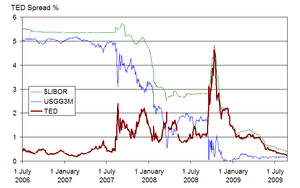
2008 Financial Crisis
The strong form of EMH is diminished by the 2008 crisis
The financial crisis has led Richard Posner, a prominent judge, University of Chicago law professor, and innovator in the field of Law and Economics, to back away from the hypothesis and express some degree of belief in Keynesian economics. Posner accused some of his Chicago School colleagues of being “asleep at the switch,” claiming that “the movement to deregulate the financial industry went too far by exaggerating the resilience– the self healing powers– of laissez-faire capitalism. ” Others, such as Fama himself, said that the hypothesis held up well during the crisis and that the markets were a casualty of the recession, not the cause of it. Despite this, Fama has conceded that “poorly informed investors could theoretically lead the market astray” and that stock prices could become “somewhat irrational” as a result.
Critics have suggested that financial institutions and corporations have been able to decrease the efficiency of financial markets by creating private information and reducing the accuracy of conventional disclosures, and by developing new and complex products which are challenging for most market participants to evaluate and correctly price.
9.4: Market Regulation
9.4.1: Securities Act of 1933
The Securities Act of 1933 ensures investors receive complete and accurate information before they invest.
Learning Objective
Describe how the Securities Act of 1933 regulates stock markets
Key Points
- The Act’s objectives are to provide investors with material financial and other corporate information about issuers of public securities.
- The primary purpose of the 1933 Act is to ensure that buyers of securities receive complete and accurate information before they invest.
- Among other things, registration forms call for: a description of the securities to be offered for sale; information about the management of the issuer; information about the securities (if other than common stock); and financial statements certified by independent accountants.
- Rule 144, promulgated by the SEC under the 1933 Act, permits, under limited circumstances, the sale of restricted and controlled securities without registration.
- Regulation S is a “safe harbor” that defines when an offering of securities is deemed to be executed in another country and therefore not be subject to the registration requirement under section 5 of the 1933 Act.
Key Terms
- private placements
-
Private placement (or non-public offering) is a funding round of securities which are sold not through a public offering, but rather through a private offering, mostly to a small number of chosen investors.
- SEC
-
The U.S. Securities and Exchange Commission (frequently abbreviated SEC) is a federal agency[2] which holds primary responsibility for enforcing the federal securities laws and regulating the securities industry, the nation’s stock and options exchanges, and other electronic securities markets in the United States.
The Securities Act of 1933 (also known as the ’33 Act) is essentially a consumer protection law for “retail” investors (i.e. not money managers, foundations, pensions, etc.)
Purpose
The Act’s objectives are to provide investors with material, financial, and other corporate information about issuers of public securities (i.e. stocks and bonds), and to prevent fraud in the offering of such securities. The primary purpose of the ’33 Act is to ensure that buyers of securities receive complete and accurate information before they invest.
Registration Process
Unless they qualify for an exemption, securities offered or sold to the public in the U.S. must be registered by filing a registration statement with the SEC. Although the law is written to require registration of securities, it is more useful as a practical matter to consider the requirement to be that of registering offers and sales. If person A registers a sale of securities to person B, and then person B seeks to resell those securities, person B must still either file a registration statement or find an available exemption.

US SEC
The U.S. Securities and Exchange Commission (frequently abbreviated SEC) is a federal agency, which holds primary responsibility for enforcing the federal securities laws and regulating the securities industry
Many transactions are exempt from regulation under the Securities Act. Section 4 of the Act limits its application to public offerings (according to SEC guidelines, more than 25 offerees) by issuers and their underwriters (i.e. investment banks). This means that the Act primarily applies to companies offering securities to the public, and not to transactions between investors or to sales of stock to small groups of investors (i.e. private placements. )
The prospectus, which is the document through which an issuer’s securities are marketed to a potential investor, is included as part of the registration statement. The SEC prescribes the relevant forms on which an issuer’s securities must be registered. Among other things, registration forms call for:
- a description of the securities to be offered for sale;
- information about the management of the issuer;
- information about the securities (if other than common stock); and
- financial statements certified by independent accountants.
For public offerings, the main requirement of the Securities Act is registration. An issuer must prepare an extensive statement describing the securities to be offered and detailing the nature of the issuer’s business. Once this statement is registered with and approved by the SEC, its data and forecasts are placed in a prospectus for potential investors. Any offering of the securities by the issuer or underwriter must thereafter be accompanied by the prospectus.
Rule 144
Rule 144, promulgated by the SEC under the 1933 Act, permits, under limited circumstances, the sale of restricted and controlled securities without registration. In addition to restrictions on the minimum length of time for which such securities must be held and the maximum volume permitted to be sold, the issuer must agree to the sale. If certain requirements are met, Form 144 must be filed with the SEC. Often, the issuer requires that a legal opinion be given indicating that the resale complies with the rule. The amount of securities sold during any subsequent three-month period generally does not exceed any of the following limitations:
- 1% of the stock outstanding
- the average weekly reported volume of trading in the securities on all national securities exchanges for the preceding four weeks
- the average weekly volume of trading of the securities reported through the consolidated transactions reporting system (NASDAQ)
- Notice of resale is provided to the SEC if the amount of securities sold in reliance on Rule 144 in any three-month period exceeds 5,000 shares or if they have an aggregate sales price in excess of $50,000. After one year, Rule 144(k) allows for the permanent removal of the restriction except as to ‘insiders’.
- In cases of mergers, buyouts or takeovers, owners of securities who had previously filed Form 144 and still wish to sell restricted and controlled securities must refile Form 144 once the merger, buyout, or takeover has been completed.
Regulation S
Regulation S is a “safe harbor” that defines when an offering of securities is deemed to be executed in another country and therefore not be subject to the registration requirement under section 5 of the 1933 Act. The regulation includes two safe harbor provisions: an issuer safe harbor and a resale safe harbor. In each case, the regulation demands that offers and sales of the securities be made outside the United States and that no offering participant (which includes the issuer, the banks assisting with the offer, and their respective affiliates) engage in “directed selling efforts. ” In the case of issuers for whose securities there is substantial U.S. market interest, the regulation also requires that no offers and sales be made to U.S. persons (including U.S. persons physically located outside the United States).
9.4.2: Securities Exchange Act of 1934
The Securities Exchange Act of 1934 is a law governing the secondary trading of securities, financial markets and their participants.
Learning Objective
Define how the Securities Exchange Act of 1934 regulates the US securities markets
Key Points
- The Securities Exchange Act of 1934 is a law governing the secondary trading of securities in the United States of America. The Act and related statutes form the basis for the regulation of the financial markets and their participants in the United States.
- One area subject to 34 Act regulation is the actual securities exchange: New York Stock Exchange, the American Stock Exchange, and regional exchanges like the Cincinnati Stock Exchange, Philadelphia Stock Exchange and Pacific Stock Exchange.
- The ’34 Act also regulates broker-dealers without a status for trading securities. A telecommunications infrastructure was developed to provide for trading without a physical location.
- In 1938 the Exchange Act was amended by the Maloney Act, which authorized the formation and registration of national securities associations to supervise the conduct of their members subject to the oversight of the SEC.
- In the last 30 years, brokers have created two additional systems for trading securities. The alternative trading system, or ATS, is a quasi exchange where stocks are commonly purchased and sold through a smaller, private network of brokers, dealers, and other market participants.
Key Term
- NASDAQ
-
The National Association of Securities Dealers Automated Quotations; this is an electronic stock market.
The Securities Exchange Act of 1934 (also called the Exchange Act, ’34 Act, or Act of ’34) is a law governing the secondary trading of securities, including stocks, bonds, and debentures, in the United States of America. It was a sweeping piece of legislation. The Act and related statutes form the basis for the regulation of the financial markets and their participants in the United States. The 1934 Act also established the Securities and Exchange Commission (SEC), the agency primarily responsible for enforcement of United States federal securities law.

Securities Exchange Act of 1934
Act of 1934 governs the secondary trading of securities.
While the Securities Act is very limited in scope, the Securities Exchange Act (also known as the Exchange Act or 1934 Act) is much broader. It regulates stock exchanges, brokers, dealers, and even private traders.
Companies raise billions of dollars by issuing securities in what is known as the primary market. In contrast with the Securities Act of 1933, which regulates these original issues, the Securities Exchange Act of 1934 regulates the secondary trading of those securities between persons often unrelated to the issuer, in most cases through brokers or dealers. Trillions of dollars are made and lost each year through trading in the secondary market.
Securities exchanges
One area subject to 34 Act regulation is the actual securities exchange — the physical place where people purchase and sell securities (stocks, bonds, notes of debenture). Some of the well known exchanges include the New York Stock Exchange, the American Stock Exchange, and regional exchanges like the Cincinnati Stock Exchange, Philadelphia Stock Exchange and Pacific Stock Exchange. At those places, agents of the exchange or specialists, act as middlemen for the competing interests to buy and sell securities. An important function of the specialist is to inject liquidity and price continuity into the market. Given that people come to the exchange to easily acquire securities or to easily dispose of a portfolio of securities, the specialist’s role is important to the exchange.
Securities associations
The ’34 Act also regulates broker-dealers without a status for trading securities. A telecommunications infrastructure was developed and allows for for trading without a physical location. Previously these brokers would find stock prices through newspaper printings and conduct trades verbally by telephone. Today, a digital information network connects these brokers. This system is called NASDAQ, standing for the National Association of Securities Dealers Automated Quotation System.
Self-regulatory organizations (SRO)
In 1938, the Exchange Act was amended by the Maloney Act, which authorized the formation and registration of national securities associations to supervise the conduct of their members subject to the oversight of the SEC. That amendment led to the creation of the National Association of Securities Dealers, Inc. – the NASD, which is a Self-Regulatory Organization (or SRO). The NASD had primary responsibility for the oversight of brokers and brokerage firms, and later, the NASDAQ stock market.
Other trading platforms
In the last 30 years, brokers have created two additional systems for trading securities. The alternative trading system, or ATS, is a quasi exchange where stocks are commonly purchased and sold through a smaller, private network of brokers, dealers, and other market participants. The ATS is different from exchanges and associations in that the volumes for ATS trades are comparatively low, and the trades tend to be controlled by a small number of brokers or dealers. ATS acts as a niche market, a private pool of liquidity. Reg ATS, an SEC regulation issued in the late 1990s, requires these small markets to 1) register as a broker with the NASD, 2) register as an exchange, or 3) operate as an unregulated ATS, staying under low trading caps.
Issuers
While the ’33 Act recognizes that timely information about the issuer is vital to effective pricing of securities, the Act’s disclosure requirement (the registration statement and prospectus) is a one-time affair. The ’34 Act extends this requirement to securities traded in the secondary market. Provided that the company has more than a certain number of shareholders and has a certain amount of assets (500 shareholders, above $10 million in assets, per sections 12, 13, and 15 of the Act), the ’34 Act requires that issuers regularly file company information with the SEC on certain forms (the annual 10-K filing and the quarterly 10-Q filing).
Antifraud provisions
While the ’33 Act contains an antifraud provision (Section 17), when the ’34 Act was enacted, questions remained about the reach of that antifraud provision and whether a private right of action—that is, the right of an individual citizen to sue an issuer of stock or related market actor, as opposed to government suits—existed for purchasers.
9.4.3: Securities Acts Amendments of 1975
The 1975 amendments are to establish a national market system for the nationwide clearance and settlement of securities transactions.
Learning Objective
Define how the Securities Act Amendments of 1975 regulate U.S. stock markets
Key Points
- The 1975 amendments, also called the National Exchange Market System Act, directed the securities and exchange commission to work with the industry toward establishing a national market system together with a system for the nationwide clearance and settlement of securities transactions.
- The National Market System (NMS) is the national system for trading equities in the United States.
- A national market system plan (or NMS plan) is a structured method of transmitting securities transactions in real-time.
- In 2005, the rules promoting the national market system were consolidated into REG NMS.
- The order protection rule has generated controversies since it requires traders to transact on a trading venue at the lowest price rather than on a venue that offers the quickest execution or the most reliability.
Key Terms
- settlement
-
Settlement of securities is a business process whereby securities or interests in securities are delivered, usually against (in simultaneous exchange for) payment of money, to fulfill contractual obligations, such as those arising under securities trades.
- clearance
-
In banking and finance, clearing denotes all activities from the time a commitment is made for a transaction until it is settled. Clearing is necessary because the speed of trades is much faster than the cycle time for completing the underlying transaction.
Example
- For example, if the best two quotes in one market are superior to the best quote in another market, a portion of an incoming market order may still trade at the inferior market at the inferior price even though the second best quote on the superior market is still available. If more than just the top of the book (the best quote) were protected by the order rule, the market order would have transacted at a superior price and the limit order offering the superior price would have transacted more quickly.
The 1975 amendments, also called the National Exchange Market System Act, directed the securities and exchange commission to work with the industry toward establishing a national market system together with a system for the nationwide clearance and settlement of securities transactions.

SEC
The amendments are direct SEC to enable the establishment of a National Market System.
National market system plan
A national market system plan (or NMS plan) is a structured method of transmitting securities transactions in real-time. In the United States, national market systems are governed by section 11A of the Securities Exchange Act of 1934.
In addition to processing the transactions themselves, these plans also show the price and volume data for these transactions. Information on each securities trade is sent to a central network at the Securities Industry Automation Corporation (SIAC) where it is then distributed and consolidated with other trades on the same “tape”.
Securities Industry Automation Corporation (SIAC)
The Securities Industry Automation Corporation (SIAC) is a subsidiary of the NYSE Euronext. Its purpose is to provide technical services for the exchanges themselves, members and other financial institutions. In this role, SIAC provides the computers and other systems required to run the exchanges. It also owns communication lines and hardware that provide real-time quotes and transaction information to all market participants from the Consolidated Tape/Ticker System (CTS), Consolidated Quotation System (CQS), and Options Price Reporting Authority (OPRA).
National Market System (NMS)
The National Market System (NMS) is the national system for trading equities in the United States.
Regulation NMS (or Reg NMS — Regulation National Market System) is a regulation promulgated and defined by the United States Securities and Exchange Commission (SEC) as “a series of initiatives designed to modernize and strengthen the national market system for equity securities. ” It was established in 2007 and seeks to foster both “competition among individual markets and competition among individual orders” in order to promote efficient and fair price formation across securities markets. In 1972, before the SEC began its pursuit of a national market system, the market for securities was quite fragmented. The same stock sometimes traded at different prices at different trading venues, and the NYSE ticker tape did not report transactions of NYSE-listed stocks that took place on regional exchanges or on other over-the-counter securities markets. This fragmentation made it difficult for traders to compare prices of stocks. In 1975, Congress authorized the SEC to facilitate a national market system.
Formation of Reg NMS
In 2005, the rules promoting the national market system were consolidated into REG NMS. Some of the more notable rules include:
- Order Protection (or Trade Through) Rule – provides intermarket price priority for quotations that are immediately and automatically accessible (Rule 611)
- Access Rule – addresses access to market data such as quotations (Rule 610)
- Sub-Penny Rule – establishes minimum pricing increments (Rule 612)
- Market Data Rules: a) Allocation amendment – institutes a new Market Data Revenue Allocation Formula, b) Governance amendment – creates advisory committees, c) Distribution and Display Rules – governing market data (Rule 600, 601 & 603).
The order protection rule has generated controversies since it requires traders to transact on a trading venue at the lowest price rather than on a venue that offers the quickest execution or the most reliability. Thus, some have described it as an improper government intervention into private business affairs. Defenders of the rule argue that it really just requires what brokers should be doing if they are acting in their customer’s best interests. Still, others have argued that the rule is too lax because it only protects the quotes at the top of the book.
9.4.4: Sarbanes–Oxley Act of 2002
The Sarbanes–Oxley Act is to set new or enhanced standards for all U.S. public company boards, management, and public accounting firms.
Learning Objective
Identify the responsibilities imposed on companies by the Sarbanes-Oxley Act of 2002
Key Points
- As a result of SOX, top management must now individually certify the accuracy of financial information. In addition, penalties for fraudulent financial activity are much more severe.
- SOX increased the independence of the outside auditors who review the accuracy of corporate financial statements, and increased the oversight role of boards of directors.
- The bill was enacted as a reaction to a number of major corporate and accounting scandals including those affecting Enron, Tyco International, Adelphia, Peregrine Systems, and WorldCom.
- Opponents claim it has reduced America’s international competitive edge against foreign financial service providers; Proponents say that SOX has been a “godsend” for improving the confidence of fund managers and other investors with regard to the veracity of corporate financial statements.
Key Terms
- conflicts of interest
-
A conflict of interest (COI) occurs when an individual or organization is involved in multiple interests, one of which could possibly corrupt the motivation for an act in the other.
- off-balance-sheet
-
Off-balance sheet (OBS), or Incognito Leverage, usually means an asset or debt or financing activity not on the company’s balance sheet.
- boards of directors
-
A board of directors is a body of elected or appointed members who jointly oversee the activities of a company or organization.
Example
- For example, Section 302 requires that the company’s “principal officers” (typically the Chief Executive Officer and Chief Financial Officer) certify and approve the integrity of their company financial reports quarterly.
The Sarbanes–Oxley Act of 2002
The Sarbanes–Oxley Act of 2002 is a federal law that set new or enhanced standards for all public company boards, management, and public accounting firms in the United States. It is also known as the Public Company Accounting Reform and Investor Protection Act (in the Senate) and Corporate and Auditing Accountability and Responsibility Act (in the House) and more commonly called Sarbanes–Oxley, Sarbox or SOX. It It is named after sponsors U.S. Senator Paul Sarbanes (D-MD) and U.S. Representative Michael G. Oxley (R-OH). As a result of SOX, top management must now individually certify the accuracy of financial information. In addition, penalties for fraudulent financial activity are much more severe. SOX also increased the independence of the outside auditors who review the accuracy of corporate financial statements, and increased the oversight role of boards of directors.

Senator Sarbanes and Representative Oxley
Senator Sarbanes and Representative Oxley sponsored the 2002 Act.
The bill was enacted as a reaction to a number of major corporate and accounting scandals including those affecting Enron, Tyco International, Adelphia, Peregrine Systems, and WorldCom. These scandals, which cost investors billions of dollars when the share prices of affected companies collapsed, shook public confidence in the nation’s securities markets.
In response to the perception that stricter financial governance laws are needed, SOX-type laws have been subsequently enacted in Japan, Germany, France, Italy, Australia, India, South Africa, and Turkey.
Public Company Accounting Oversight Board (PCAOB)
Title I provides independent oversight of public accounting firms providing audit services (auditors). It also creates a central oversight board tasked with registering auditors, defining the specific processes and procedures for compliance audits, inspecting and policing conduct and quality control, and enforcing compliance with the specific mandates of SOX.
Auditor Independence
Title II consists of nine sections and establishes standards for external auditor independence, to limit conflicts of interest. It also addresses new auditor approval requirements, audit partner rotation, and auditor reporting requirements. It restricts auditing companies from providing non-audit services (e.g., consulting) for the same clients.
Corporate Responsibility
Title III consists of eight sections and mandates that senior executives take individual responsibility for the accuracy and completeness of corporate financial reports. It enumerates specific limits on the behaviors of corporate officers and describes specific forfeitures of benefits and civil penalties for non-compliance.
Enhanced Financial Disclosures
Title IV describes enhanced reporting requirements for financial transactions, including off-balance-sheet transactions, pro-forma figures and stock transactions of corporate officers. It requires internal controls for assuring the accuracy of financial reports and disclosures, and mandates both audits and reports on those controls.
Analyst Conflicts of Interest
Title V consists of only one section, which includes measures designed to help restore investor confidence in the reporting of securities analysts. It defines the codes of conduct for securities analysts and requires disclosure of knowable conflicts of interest.
Commission Resources and Authority
Title VI defines practices to restore investor confidence in securities analysts. It also defines the SEC’s authority to censure or bar securities professionals from practice and defines conditions under which a person can be barred from practicing as a broker, advisor, or dealer.
Studies and Reports
Title VII consists of five sections and requires the Comptroller General and the SEC to perform various studies and report their findings.
Corporate and Criminal Fraud Accountability
Title VIII describes specific criminal penalties for manipulation, destruction or alteration of financial records or other interference with investigations, while providing certain protections for whistle-blowers.
White Collar Crime Penalty Enhancement
Title IX increases the criminal penalties associated with white-collar crimes and conspiracies. It recommends stronger sentencing guidelines and specifically adds failure to certify corporate financial reports as a criminal offense.
Corporate Tax Returns
Title X consists of one section. Section 1001 states that the Chief Executive Officer should sign the company tax return.
Corporate Fraud Accountability
Title XI consists of seven sections. Section 1101 recommends a name for this title as “Corporate Fraud Accountability Act of 2002”. It identifies corporate fraud and records tampering as criminal offenses and joins those offenses to specific penalties. It also revises sentencing guidelines and strengthens their penalties. This enables the SEC to resort to temporarily freezing transactions or payments that have been deemed “large” or “unusual”.
Debate continues over the perceived benefits and costs of SOX. Opponents of the bill claim it has reduced America’s international competitive edge against foreign financial service providers, saying SOX has introduced an overly complex regulatory environment into U.S. financial markets. Proponents of the measure say that SOX has been a “godsend” for improving the confidence of fund managers and other investors with regard to the veracity of corporate financial statements.
9.4.5: Global Research Settlement
The Global Settlement was an enforcement agreement to address issues of conflict of interest within the SEC and other big investment companies.
Learning Objective
Describe how the Global Research Settlement addressed conflicts of interest in the market
Key Points
- The Global Settlement was an enforcement agreement reached on April 28, 2003 between the SEC, NASD, NYSE, and ten of the United States’s largest investment firms to address issues of conflict of interest within their businesses.
- The central issue at hand that had been previously decided in court was the conflict of interest between the investment banking and analysis departments of ten of the largest investment firms in the United States.
- As part of the settlement decision published on December 20, 2002, several regulations designed to prevent abuse stemming from pressure by investment bankers on analysts to provide “favorable” appraisals were instantiated.
- Other than these regulatory actions, the firms involved in the settlement were also to pay fines to their investors, to fund investor education, and to pay for independent third-party market research.
Key Terms
- IPOs
-
An initial public offering (IPO) or stock market launch is a type of public offering where shares of stock in a company are sold to the general public, on a securities exchange, for the first time.
- conflict of interest
-
A conflict of interest (COI) occurs when an individual or organization is involved in multiple interests, one of which could possibly corrupt the motivation for an act in the other.
The Global Settlement was an enforcement agreement reached on April 28, 2003 between the Securities and Exchange Commission (SEC), National Association of Securities Dealers (NASD), New York Stock Exchange (NYSE), and ten of the United States’s largest investment firms. The agreement was meant to address issues of conflict of interest within their businesses.
The central issue at hand that had previously been decided in court was the conflict of interest between the investment banking and analysis departments of ten of the largest investment firms in the United States. The investment firms involved in the settlement had all engaged in actions and practices that had aided and abetted the inappropriate influence of their research analysts by their investment bankers seeking lucrative fees. A typical violation addressed by the settlement was the case of CSFB and Salomon Smith Barney, which were alleged to have engaged in inappropriate spinning of “hot” IPOs and issued fraudulent research reports in violation of various sections within the Securities Exchange Act of 1934. Similarly, UBS Warburg and Piper Jaffray were alleged to have received payments for investment research without disclosing such payments in violation of the Securities Act of 1933.
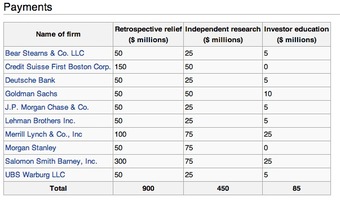
Payments
The table shows the payments of each company
Enforcement actions
As part of the settlement decision published on December 20, 2002, several regulations designed to prevent abuse stemming from pressure by investment bankers on analysts to provide “favorable” appraisals were put in place. Most importantly, these firms would have to literally insulate their banking and analysis departments from each other physically and with Chinese walls. In addition, budget allocation to management in research departments will be independent of investment departments. Research analysts will also be prohibited from going on pitches and roadshows with bankers during advertising and promotion of IPOs. Similarly, the Global Settlement also increased the IPO “quiet period” from 25 days to 40 days. Finally, research analysts’ historical ratings must be disclosed and made available.
Other than these regulatory actions, the firms involved in the settlement were required to pay fines to their investors, to fund investor education, and to pay for independent third-party market research. A total fine of $1.435 billion was assessed and is described in the table below.
Chapter 8: Introduction to Risk and Return
8.1: Understanding Return
8.1.1: Expected Return
In probability theory, the expected value of a random variable is the weighted average of all possible values.
Learning Objective
Calculate the expected return of an investment portfolio
Key Points
- In order to make investment decisions, investors often estimate the expected return of a potential investment.
- Expected value is a concept that the helps investors assess the value of a potential investment based on different future outcomes and a probability for each outcome.
- Once you have categories for different scenario’s, along with probabilities and returns in each scenario, you then calculate your expected return by multiplying each probability by it’s respective outcome and adding these all together.
Key Terms
- expected value
-
The expected value of a random variable is the weighted average of all possible values that this random variable can take on.
- expected return
-
The expected return of a potential investment can be computed by computing the product of the probability of a given event and the return in that case and adding together the products in each discrete scenario.
Imagine that your friend offered you a chance to play his game of dice. You have to pay $1 to play and he keeps your money if you roll anything other than a 6. Would you play it? If you answered “it depends”, you are ready to learn about expected value.
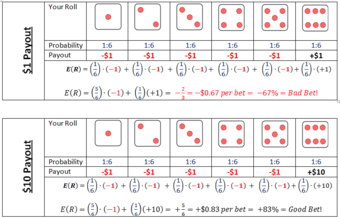
Care to roll the dice?
Is a bet that doesn’t always pay out, but pays out big when it does a good bet? Is playing the lottery a good bet? Would it be a good bet if tickets were only $0.10 instead of $1.00?
If your friend told you he would pay you $1 every time you roll a 6, you would be crazy to play. If your friend told you he would pay you $10 every time you roll a 6, you would be crazy not to play.
Expected value is calculated by multiplying the probability that something will happen by the resulting outcome if it happens. In the two cases described above, there are 5 ways to lose and only 1 to win. But in scenario 1, you can expect to lose $0.67 or 67% every time you bet, and in scenario two, you can expect to win $0.83 or 83% with each bet. This is a confusing topic in statistics and finance because on any given roll, there are only two outcomes — win or lose — and neither outcome involves $0.67 or $0.83 increments.
But to understand expected value, you have to imagine playing a particular game hundreds of times. If you were to sit at your friend’s apartment and play the dice game 100 times, imagine what your bottom line would be. Even though you lose most of the time you roll in the 2nd scenario, when you win, you win big. After 100 games, you could expect to be up ($0.83 per roll) x (100 rolls) = $83. If you were foolish enough to play the game in the first scenario 100 times you would expect to be down $67 to your friend.
In finance, evaluating your expected return is important, but never as simple as evaluating a game of dice. Imagine that you are going to buy a house a year from today and you have $20,000 saved for that investment. Because you are smart enough to be using a free online text book, you are probably savvy enough to know that you can invest the money for a year and get some return on it. You are considering investing that money into stock of a Ski/Snowboard Mountain in Colorado, so you go talk to your snowboarding friend who lives on your floor of the dorm. He tells you that any given winter could be hella gnarly, totally chillax or wicked bogus, depending on how much it snows. You start doing some research, and you realize that how the stock has performed has everything to do with how much it snows. You create three different categories based on snowfall and label them hella gnarly (HG), totally chillax (TC) and wicked bogus (WB). In recent HG winters, those with over 20 feet of annual snowfall, the stock has averaged a 25% annual return. In recent TC winters, those with between 10 feet and 20 feet of snowdrop throughout the season, the stock has averaged 10%. In WB winters, those with less than 10 feet of total snowdrop, the stock has averaged -20%. Ok, so now what? Should you buy the stock?
If you said “it depends,” that’s a good answer. Being as smart as you are, you investigate recent weather patterns and you decide that there is a 25% chance of an HG year, a 60% chance of a TC year and only a 15% chance of a WB winter. You understand that past performance is never a guarantee of future results, but still you are happy with your research and you project an expected rate of return for your $20,000. How will it do?
Based on your research, you realize that the stock has an expected return that is calculated thus:
E[R]= (ProbabilityHG)x(ReturnHG)+(ProbabilityTC)x(ReturnTC)+(ProbabilityWB)x(ReturnWB) = (0.25)(25%) + (0.60)(10%)+(0.15)(-20%) = 6.25% + 6% + -3% = 9.25%
If you were to invest the stock in the ski mountain, year after year, and your research proves accurate, you could expect to receive an average of 9.25% return each year. That is your expected return.
8.1.2: Variance
Variance is a statistical concept describing the range around expected return within which an investment return can be reasonably expected to fall.
Learning Objective
Explain the importance of a stock’s variance and standard deviation
Key Points
- Any investment should be made taking time considerations and risk tolerance into account. If there is a specific deadline for when the investment needs to be matured (i.e. to generate retirement income, pay for a down payment on a house, college tuition) then caution is required.
- Three different asset classes — stocks, bonds, money markets — range from aggressive, to moderate, to conservative. An investment that is aggressive typically features a higher expected return, but also a higher variance.
- Variance is calculated by calculating an expected return and summing a weighted average of the squared deviations from the mean return.
Key Terms
- standard deviation
-
The standard deviation of an investment is obtained by taking the square root of the variance. It has a more straightforward meaning than variance. It tells you that in a given year, you can expect an investment’s return to be one standard deviation above or below the average rate of return.
- variance
-
In finance, variance is a term used to measure the degree of risk in an investment. It is calculated by finding the average of the squared deviations from the mean rate of return.
Introducing Variance
In probability theory and statistics, the variance is a measure of how far a set of numbers is spread out. It is one of several descriptors of a probability distribution, describing how far the numbers lie from the mean (expected value).
Understanding the concept of variance along with three typical asset classes — money market, bonds, stocks — can help you build a portfolio for any investor. Money market investments are very safe, they almost never go in the red, but they also don’t pay high returns. Stocks are on the opposite end of the spectrum, going back and forth between red and black from year to year frequently, but over longer periods of time they usually pay higher premiums. Bonds are somewhere in the middle. They are safer than a stock, but riskier than a money market and their average returns reflect that.
This table shows how to calculate the variance of an investment outcome .

How much do investors want to pay to have to take the good with the bad?
Calculating variance is a 3 step process once expected return has been calculated. Calculate deviations from mean (blue), square the deviations (yellow), multiply the squared deviation by its original probability (orange). Get brownie points by taking the square root of that number and interpret its meaning in the form of a sentence.
You may not need to calculate variance yourself, but you should still notice how we got it. In the figure, we started with three scenarios and a probability (P) and return (R) associated with each. We did some math and ended up using the two blue columns to get the yellow one. Then we multiplied the two yellow columns to get the orange one. We get the variance from adding up the numbers in the orange column. Of the three numbers, we add (62, 0.34, and 128). Two are very big and one is very small. The small number comes from the TC scenario where the stock returns 10%, which is very close to our expectation of 9.25%. The bigger numbers come from winters that are extreme — when the stock performs way above 9.25% (HG) or way below it (WB). The standard deviation can be read as a percentage. It means that, even though we can expect an average of 9.25% return on our stock over the course of 50 years, if we take any given year out and look at its performance, it is likely be somewhere within 13.81% above or below that figure.
Variance in Relation to Expected Return
In the discussion of expected return, we concluded that, based on your research, you can expect the Ski/Snowboard Resort in Colorado to have an expected return of 9.25% based on three distinct weather outcomes. However, if you invest your $20,000 in that company and expect to have $21,850 after a year, you must remember that this isn’t a dice game that you can play over and over again. There will only be one result in this case and at the end of it, you have to make a down payment on a house. Is this a good investment idea?
What if your bid for a house won’t be accepted unless you can put at least $20,000 down? There is an 85% chance that the winter is either hella gnarly (HG) or totally chillax (TC), and in either of those cases you will still have over $20,000 to make a down payment. There is also a 15% chance that the year ends up being wicked bogus (WB), and if that is the case you will lose 20% or $4,000 of your initial investment. Now you have $16,000 and all of a sudden you are thinking tree fort. Let’s compare that investment to a CD at a bank that pays 3.25% no matter how much snow falls this winter. You can have an investment that is federally insured to pay you $20,650 one year from today and you can be assured to have enough to make a down payment on your house.
If you can let that $20,000 investment sit for 10 years before you need it, there is a much better chance that you will end up in the black (experiencing a profit) than in the red (experiencing a loss). A 30 year old with a 401K can be much more aggressive in his portfolio than a 65 year old who will be retiring in one year can. Every portfolio should be modeled with time-frame and risk tolerance considerations. It would be just as foolish for the 65 year old to be investing in aggressive stocks as it would for the 30 year old to buy conservative CD’s in his retirement account.
8.2: Portfolio Considerations
8.2.1: Portfolio Diversification and Weighting
Weighting is the percent allocation a particular investment type receives within a portfolio.
Learning Objective
Describe how weighting a portfolio is important for diversification
Key Points
- Diversification is the idea of spreading a portfolio across different classes of investments with a target weight attached to each class.
- Modern portfolio theory is the idea that for any investment objective, there is an optimal mix of investments that can maximize expected return subject to a specific risk threshold.
- Systemic risk is the risk that applies to a particular market or industry. It cannot be diversified away. Specific risk is the risk that applies to one particular investment within a market and it can be diversified away.
Key Term
- systemic risk
-
Refers to the risk common to all securities which cannot be diversified away.
In finance, there are two types of risk – systemic risk and specific risk. Systemic risk is essentially the risk that the markets will experience in a downturn and all investments within that market will be negatively affected. It is difficult to reduce with diversification. Specific risk is the risk associated with one individual security. It can be diversified away. Let’s go back to our Ski/Snowboard example.
Let’s say that you pick one resort to invest in, and cross your fingers hoping for a huge snowdrop this winter. It turns out that the winter sets records for snowdrop across the state of Colorado and as an industry, the resorts turn record profits. Unfortunately, your snowboard friend didn’t tell you that the resort you picked still hasn’t upgraded to the high-speed chairlifts, and they also don’t plow their roads very often. It turns out that while all the other mountains were turning huge profits, your investment actually lost 10%. The risk associated with the one mountain is called “specific risk. ” The risk of bad weather, in this example, is systemic risk. If you had taken your money and divided it up across all of the ski resorts in Colorado, you would be up 15%, but because you happened to pick the one bad egg, you lost money.
This example explains why investors are often choosing mutual funds and exchange traded funds (ETFs) over individual stocks and bonds. Mutual funds and ETF’s invest in underlying pools of investments specific to a particular investment objective. These objectives can range from specific to one particular industry to something that achieves a balanced portfolio of blended assets.
The idea of eliminating risk by spreading investments across pools of underlying stocks and bonds is called “diversification. ” A diversified portfolio spreads investments across all asset classes with a weighting system that takes time frame and risk tolerance into account. The “weight” is the proportion of that portfolio assigned to one category. In our example. we talked about diversifying away the risks of slow chair lifts but in reality, there are many more aspects to diversification. Look at the pie chart below. How many pairs of antonyms can you find?
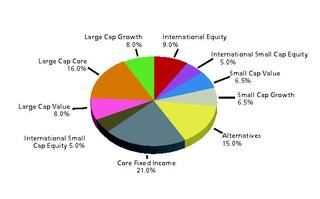
Diversified Portfolio
Asset classes and their weightings for a particular portfolio
8.2.2: Implications for Expected Returns
The expected return of a diversified portfolio is the expected return of each of its underlying investments times the weight the investment receives.
Learning Objective
Calculate the expected returns of an investment portfolio
Key Points
- Asset allocation is a theory of designing a portfolio that achieves a weighting scheme with a target mix of different asset classes that is suitable to the time frame and risk tolerance of the investor.
- The principals that support the theory of asset allocation are the cyclical nature of investments within a particular class of assets and weaker or even negative correlations that often exist across asset classes.
- When you re-balance your portfolio after it has deviated from the original target mix, you are selling classes that have relatively appreciated in order to buy those which have relatively depreciated.
- If you believe that markets go in cycles, you should believe in selling assets that have relatively appreciated and buying those which have relatively depreciated.
Key Term
- Strategic Asset Allocation
-
The primary goal of a strategic asset allocation is to create an asset mix that will provide the optimal balance between expected risk and return for a long-term investment horizon.
Asset allocation is the theory that any portfolio should have a set of target weights for different asset classes based on time frame and risk tolerance. There are two key principals at work in this theory. The first is that everything goes in cycles and the second is that often when one things is ebbing, the other is flowing. Let’s make this very simple and say that bonds return 4% in a bad year, 6% in an average year, and 8% in a good year, and stocks return -5% in a bad year, 10% in an average year, and 15% in a good year.
Stock have cycles and when stocks do well, bonds are more likely to do poorly and vice versa. Let’s say we have a portfolio of $100,000 that has a target mix of 60% stocks and 40% fixed income and, therefore, has $60,000 in stocks and $40,000 bonds. Stocks have a good year and bonds have a bad one, and now we have $69,000 invested in stocks and $41,600 in bonds. At this point, we have a total portfolio of $110,600 and an asset mix of roughly 62% stocks and 38% bonds. We began with a target mix of 60-40 but since the equity market fared better than fixed-income market, we are a little off-balance. So how do we fix that? We could sit and wait and watch what happens, or we could shift $2,640 from our equity position to a fixed-income position. Remember, things go in cycles, so we expect that if stocks do well relatively to bonds that sometime in the future, bonds will do well relative to stocks. By shifting $2,640 from our equity position to our fixed-income position, we are essentially selling stocks after they have appreciated (at a high) and buying bonds after they have failed to appreciate (at a low). Look at how the different asset mixes fare, based on a 10-year period that is consistent with historical averages.
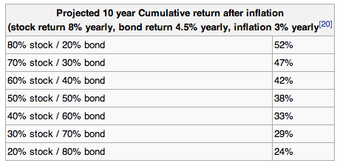
Average Returns for Different Weighting Schemes
Different returns are expected for different asset allocations given historical averages
Assuming rebalancing, the
expected return
of a diversified portfolio is simply the expected return of each of its underlying investments times the allocation weight the investment receives.
The theory can feature different strategies, including strategic asset allocation, tactical asset allocation, and others, but the ideas are the same as the implications for return. A portfolio should consist of a variety of classes of assets to take advantage of zero and negative correlations between those classes, and it should be designed to achieve a target mix of assets that are rebalanced when one grows in relation to another.
8.2.3: Implications for Variance
A diversified portfolio containing investments with small or negative correlation coefficients will have a lower variance than a single asset portfolio.
Learning Objective
Describe how a portfolio is diversified to minimize variance
Key Points
- Portfolio managers often target a mix of assets across different categories that maximize potential return and limit specific risk.
- Portfolio managers choose from many more classes of assets than the two that have been used primarily for this chapter.
- With historical data, powerful software and a proficient financial analyst, a correlation matrix can be produced that helps portfolio managers make investment decisions that will limit the portfolio’s overall risk and exposure to market downturns.
Key Term
- Correlation Matrix
-
A matrix that shows a set of correlations between two random variables over a number of observations.
A primary reason for a diversified asset allocation is the fact that markets often sway away from each other, and it can be beneficial to have a portion of your holdings invested in bonds in years when stocks do badly. As you can see from the graphic below, there is still considerable risk to an investor who is heavily invested in stocks, even with a blended portfolio.
Remember that in 2000, the Nasdaq lost 39.28% of its value (4,069.31 to 2,470.52) and in 2001, the Nasdaq lost 21.05% of its value (2,470.52 to 1,950.40). Had your portfolio consisted of a set of stocks that approximated the Nasdaq index, you would have lost roughly 52% of your portfolio’s value (from 4069.31 to 1950.40).
In actuality, as mentioned before, there are more than two basic asset classes. Here are some examples of the the types of assets that may be included in a diversified strategy:
- cash and cash equivalents (e.g., deposit account , money market fund )
- fixed interest securities, such as bonds : investment-grade or junk (high yield); government or corporate; short-term, intermediate, long-term; domestic, foreign, or emerging markets ; or convertible security
- stocks : value, dividend, growth, sector specific, or preferred (or a “blend” of any two or more of the preceding); large-cap versus mid-cap, small-cap or micro-cap; public equities versus private equities , domestic, foreign (developed), emerging or frontier markets
- commodities : precious metals, broad basket, agriculture, energy, etc.
- commercial or residential real estate (also REITs )
- collectibles, such as art, coins, or stamps
- insurance products (an annuity , a life settlement , a catastrophe bond , personal life insurance products, etc.)
- derivatives , such as long-short or market neutral strategies, options , collateralized debt, and futures
- foreign currency
- venture capital, leveraged buyout, merger arbitrage, or distressed security funds
A fundamental justification for asset allocation (or Modern Portfolio Theory) is the notion that different asset classes offer returns that are not perfectly correlated, hence diversification reduces the overall risk in terms of the variability of returns for a given level of expected return. Asset diversification has been described as “the only free lunch you will find in the investment game”. Academic research has painstakingly explained the importance of asset allocation and the problems of active management (see academic studies section below). Although risk is reduced as long as correlations are not perfect, it is typically forecast (wholly or in part) based on statistical relationships (like correlation and variance) that existed over some past period. Expectations for return are often derived in the same way.
A diversified portfolio containing investments with small or negative correlation coefficients will have a lower variance than a similar portfolio of one asset type. This is why it’s possible to reduce variance without compromising expected return by diversifying.
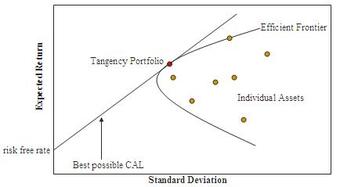
Illustration of Modern Portfolio Theory
Diversifying asset classes can reduce portfolio variance without diminishing expected return
8.3: The Impact of News of Expected Returns
8.3.1: Surprises and Returns
Surprise announcements can trigger a chain of events that affect the stock price of a particular company by changing investor expectations.
Learning Objective
Describe how a surprise announcement can influence a stock’s price
Key Points
- Surprise announcements that come from a company, its competition, or a supplier or customer can affect the long run value of a stocks and bonds related to that company.
- These announcements will often concern earnings, stages in a product development cycle (FDA approval of a drug) or corporate structure changes (the acquisition of a competitor) and can move a company’s outlook positively or negatively.
- When the news is generally seen as positive, a company’s equity and debt become more valuable on the secondary market, and its stock price will rise and the effective yield on its debt instruments will fall.
Key Term
- mergers and acquisitions
-
Mergers and acquisitions (M&A) is an aspect of corporate strategy, corporate finance, and management dealing with the buying, selling, dividing, and combining of different companies and similar entities that can help an enterprise grow rapidly in its sector or location of origin, or a new field or new location, without creating a subsidiary, other child entity, or using a joint venture.
Surprise announcements can trigger a chain of events that affect the stock price of a particular company, competitors and other companies that might be suppliers to or customers of the primary company.
Announcements of Mergers and acquisitions (M&A) are a frequent type of surprise announcements. Mergers and acquisition is a category of announcement that deals with corporate structure. When the announcement is publicly made, analysts use that information to factor into the company’s long run market outlook. A merger or an acquisition could signal to an analyst that one particular company is financially weak, and it could downgrade its long run outlook for that company. Alternatively, an M&A announcement could also signal to analysts that a company has a chance to increase its market share and henceforth its profits. These announcements typically make the biggest splash in a top-heavy industry, such as automobiles, pharmaceuticals, or healthcare, with a few strong players dominating a market that is researching, developing, and innovating new products.
Other announcements that can have a variety of impacts on asset valuation can come in the form of a major court decision, news of development of new research, and innovation, FDA approval of a new drug or a new cheap source of raw materials. Any of this news has the potential to impact a particular company and, in some cases, competition, suppliers, and customers of that company. In many cases, there will be signals that analysts pick up on ahead of time. Investors who are actively making investment decisions based on a particular company or within a particular industry need to be aware of how a surprise announcement might affect their investment.
Fixed-income market participants also make forecasts on the long-run health of a company to project the likelihood an issuer of debt might default. A company’s instruments are subject to move in the event of an aforementioned announcement or if a private rating agency (Standard and Poors or Moody’s) changes its outlook on their debt. If a news announcement is seen as positive for a company, its fixed-income instruments might seem more creditworthy, its bonds will rise in price, and its yield will decline. The inverse is also true.
Take a look at the creditworthiness ratings of different countries by Standard and Poors.

World countries Standard & Poor’s ratings
An example of the credit ratings prescribed by Standard & Poor’s as a result of their respective long-term liability analysis for debt issued at the national government level. Countries issue debt to build national infrastructure. Look how expensive it is to raise capital for such projects based on geographic region.
8.3.2: Announcements, News, and Returns
The Value of a Company.
Learning Objective
Describe how analysts use announcements, news, and returns to evaluate stock
Key Points
- A company that is publicly traded must announce its earnings reports quarterly. When the report matches analysts’ expectations, the stock’s price will not be greatly affected. When it announces a report that is unexpected, it can affect the stock price of a competitor or supplier as well.
- Beta is a metric used to signal the risk in a particular stock. Stocks with high beta values fluctuate more on a day-to-day basis than those with lower beta values.
- Analysts constantly assess the health of public companies to assess the value of its equity and debt instruments, and their outlook affects stock and bond prices in secondary markets.
Key Term
- beta
-
In finance, the Beta (β) of a stock or portfolio is a number describing the correlated volatility of an asset in relation to the volatility of the benchmark that said asset is being compared to.
The words stock and equity are used interchangeably, because a stock is reflective of a piece of ownership in a company. In general, investors buy stocks for two reasons: because they expect the company to grow its product and market share over time (growth) or because they feel that the company is undervalued based on its current stock price. Analysts may research a stock from a fundamental or a technical lens.
Fundamental analysis involves analyzing a company’s financial statements and health, its management and competitive advantages, and its competitors and markets . Technical analysts study the patterns and price fluctuations and attempt to forecast the direction of prices through the study of past market data, primarily price, and volume. A stock’s price is essentially determined by the buying and selling decisions of fundamental and technical analysts, who often manage large sums of money and have access to broad pools of data. Some stocks tend to fluctuate more than others on a day-to-day basis, and the metric called Beta describe’s the variance of a stocks day to day price. Stocks that tend to experience larger swings have higher beta values and expose owners to more specific risk.
In order for a company to be publicly traded on an exchange, it must comply with the regulations of that exchange board (NYSE or NASDAQ). Public investors are entitled to complete, accurate, and timely financial information about their investments. Companies generally announce updated financial figures on a quarterly basis. These figures include their current revenues, expenses and profits, and investors use this information to assess the company’s financial health. For most established companies, these reports are consistent and predictable and barely affect a stock’s price. Macy’s may announce higher profits in quarter 4 than quarter 3, but its price might not move, because analysts expected that Christmas would bring additional sales based on past data.
When a company announces its earnings as higher or lower than expected, the stock may experience a sudden shift in value. A higher than expected profit may come from increased revenues or decreased expenses. If a growing company announces higher than expected profits because of decreased expenses, it signals to investors that the company has found a cheaper way to produce its good. That could in turn affect the expected returns of a competitor’s stock, either positively or negatively, depending on how analysts forecast the effect. The announcement of higher than expected sales from Ford could affect its stock price significantly, and it could set into motion a chain of events. If analysts believe that the trend is based on a shift away from public transportation, it could raise the price of GM, Toyota, and maybe even Chevron. If Nvidia, a company who produces micro-processors for smart phones, announces higher than expected profits on reduced production costs, it might not only cause their stock to spike, but it could lead to a decrease in the price of the stock of their primary competition, Intel.
In general, fluctuations in one stock will often lead to fluctuations in another stock. There are times when the markets are relatively stable and those when it is relatively volatile. Consider the image below. The correlation of 0.769 suggests that the volatility of the stock market in one month is very highly correlated to that in the previous month.
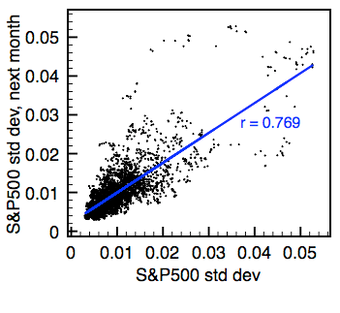
Volatility begets volatility
Data shown is from the period of Jan. 1990-Sep. 2009. Volatility is measured as the standard deviation of S&P 500 one-day returns over a month’s period.
8.4: Risk
8.4.1: Types of Risk
There are many types of financial risk, including asset-backed, prepayment, interest rate, credit, liquidity, market, operational, foreign, and model risk.
Learning Objective
Classify different securities by the types of financial risk associated with the investment opportunity
Key Points
- Financial risk is associated to the chances that an investor might lose value in an investment. It is separated into different sources of decline.
- Often the risks interact with each other and ultimately shock causes panic. Many of the worst market crashes have been a result of widespread speculation and not the devaluation of that asset itself.
- In the market crash of 2008, investors feared that some home owners would default. It triggered a chain of events that shocked the whole world and left many people in bad financial situations.
Key Term
- Variable Rate Mortgage
-
A variable-rate mortgage, adjustable-rate mortgage (ARM), or tracker mortgage is a mortgage loan with the interest rate on the note periodically adjusted based on an index which reflects the cost to the lender of borrowing on the credit markets.
The term “financial risk” is broad, but can be broken different categories to understand it better.
Types of Financial Risk
Asset-backed risk affects investments in asset-backed securities such as home loans. In order to finance home sales, banks issue bonds that serve as a debt obligation to its buyer. The buyer of the debt is essentially receiving the interest from the bank that the home-buyer is paying to it.
Prepayment risk is the risk that the buyer goes ahead and pays off the mortgage. Therefore, the buyer of the bond loses the right to the buyer’s interest payments over time.
Interest rate risk refers an asset whose terms can change over time, such as a Variable Rate Mortgage payment.
Credit risk or default risk, is the risk that a borrower will default (or stop making payments).
Liquidity risk is the risk that an asset or security cannot be converted into cash in a timely manner. Some investments (i.e. stocks) can be sold immediately at the current market rate and others (i.e. houses) are subject to a much higher degree of liquidity risk.
Market risk is the term associated with the risk of losing value in an investment will lose value because of a decline in the market.
Operational risk is another type of risk that deals with the operations of a particular business. If you are invested in the Boston Red Sox, your operational risk might include the chance that starting pitchers and recent acquisitions won’t perform, that your manager will turn the clubhouse into a mess, or that ownership will not be able to execute a long term strategy. Any of these risks might result in decreased revenues from ticket sales.
Foreign investment risk involves the risk associated with investments in foreign markets.
Model risk involves the chances that past models, which have been used to diversify away risk, will not accurately predict future models.
Example
A recent phenomenon that applies the concepts of these risks and how they interact with each other happened in 2008 when the housing market crashed. Can you find an example of each form of risk here?
Leading up to the crisis, many people received loans to buy houses which they really couldn’t afford. The mortgages often featured variable rate annuities, meaning that the interest rate terms of the mortgage started low and increased over time. Over the past 20 year period, house prices had risen constantly and investors assumed the trend would continue. Buyers worried about an adjustment to their interest rate, and all of a sudden a 1500 monthly payment became 2000. When interest rates climbed 2 percentage points and the mortgage climbed to $2000, some owners had to default (stop making payments) . They were promised that their investment would appreciate in value and they would be able to refinance it. The home loans were packaged and shipped off to investors all over the world in the form of complex investment vehicles. They seemed rewarding and highly safe at first, but then a few started breaking down. By now, these vehicles had made their way all the way around the world. When some investors defaulted, the world realized there were no mechanics around to fix these vehicles. After a few vehicles broke down, no one wanted to buy them, leading to the worst crash across world markets since 1929.
8.4.2: Measuring Risk
The higher the risk undertaken, the more ample the expected return and the lower the risk, the more modest the expected return.
Learning Objective
Calculate the risk of a portfolio using computational methods
Key Points
- The general progression in the risk-return spectrum is: short-term debt, long-term debt, property, high-yield debt, and equity.
- When a firm makes a capital budgeting decision, they will wish, as a bare minimum, to recover enough to pay the increased cost of goods due to inflation.
- Risk aversion is a concept based on the behavior of firms and investors while exposed to uncertainty to attempt to reduce that uncertainty.
- Beta is a measure firms can use in order to determine an investment’s return sensitivity in relation to overall market risk.
Key Terms
- systematic risk
-
The risk associated with an asset that is correlated with the risk of asset markets generally, often measured as its beta.
- inflation
-
An increase in the general level of prices or in the cost of living.
Risk and Return Considerations
Risk refers to the variability of possible returns associated with a given investment. Risk, along with the return, is a major consideration in capital budgeting decisions. The firm must compare the expected return from a given investment with the risk associated with it. Higher levels of return are required to compensate for increased levels of risk. In other words, the higher the risk undertaken, the more ample the return – and conversely, the lower the risk, the more modest the return.
This risk and return tradeoff is also known as the risk-return spectrum. There are various classes of possible investments, each with their own positions on the overall risk-return spectrum. The general progression is: short-term debt, long-term debt, property, high-yield debt, and equity. The existence of risk causes the need to incur a number of expenses. For example, the more risky the investment the more time and effort is usually required to obtain information about it and monitor its progress. Moreover, the importance of a loss of X amount of value can be greater than the importance of a gain of X amount of value, so a riskier investment will attract a higher risk premium even if the forecast return is the same as upon a less risky investment. Risk is therefore something that must be compensated for, and the more risk the more compensation is required.
When a firm makes a capital budgeting decision, they will wish, as a bare minimum, to recover enough to pay the increased cost of investment due to inflation. Thus, inflation is a pivotal input in a firm’s cost of capital. However, since interest rates are set by the market, it happens frequently that they are insufficient to compensate for inflation.
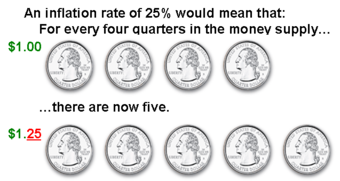
Inflation
Inflation is a rise in the general level of prices of goods and services in an economy over a period of time.
Risk aversion also plays an important role in determining a firm’s required return on an investment. Risk aversion is a concept based on the behavior of firms and investors while exposed to uncertainty to attempt to reduce that uncertainty. Risk aversion is the reluctance to accept a bargain with an uncertain payoff rather than another bargain with a more certain, but possibly lower, expected payoff. For example, a risk-averse investor might choose to put his or her money into a bank account with a low but guaranteed interest rate, rather than into a stock that may have high expected returns, but also involves a chance of losing value. Risk aversion can be thought of as having three levels:
- Risk-averse or risk-avoiding
- Risk-neutral
- Risk-loving or risk-seeking
Beta is a measure firms can use in order to determine an investment’s return sensitivity in relation to overall market risk. Beta describes the correlated volatility of an asset in relation to the volatility of the benchmark that said asset is being compared to. This benchmark is generally the overall financial market and is often estimated via the use of representative indices, such as the S&P 500. Beta is also referred to as financial elasticity or correlated relative volatility, and can be referred to as a measure of the sensitivity of the asset’s returns to market returns, its non-diversifiable risk, its systematic risk, or market risk. Higher-beta investments tend to be more volatile and therefore riskier, but provide the potential for higher returns. Lower-beta investments pose less risk, but generally offer lower returns.
8.5: Implications Across Portfolios
8.5.1: Calculating Expected Portfolio Returns
A portfolio’s expected return is the sum of the weighted average of each asset’s expected return.
Learning Objective
Calculate a portfolio’s expected return
Key Points
- To calculate the expected return of a portfolio, you need to know the expected return and weight of each asset in a portfolio.
- The figure is found by multiplying each asset’s weight with its expected return, and then adding up all those figures at the end.
- These estimates are based on the assumption that what we have seen in the past is what we can expect in the future, and ignores a structural view on the market.
Key Term
- weighted average
-
In statistics, a weighted average is an average that takes each object and calculates the product of its weight and its figure and sums all of these products to produce one average. It is implied that all the individual weights add to 1.
Let’s say that we have a portfolio that consists of three assets, and we’ll call them Apples, Bananas, and Cherries. We decided to invest in all three, because the previous chapters on diversification had a profound impact on our investment strategy, and we now understand that diversifiable risk doesn’t pay a risk premium, so we try to eliminate it.

A Fruitful Portfolio
How would you calculate the expected return on this portfolio?
The return of our fruit portfolio could be modeled as a sum of the weighted average of each fruit’s expected return. In math, that means:
Where A stands for apple, B is banana, C is cherry and FMP is farmer’s market portfolio. W is weight and E(RX) is the expected return of X. A good exercise would be to calculate this figure on your own, then look below to see if you completed it accurately.
Here’s what you should get:
In reality, a portfolio is not a fruit basket, and neither is the formula. A math-heavy formula for calculating the expected return on a portfolio, Q, of n assets would be:
What does this equal?
Remember that we are making the assumption that we can accurately measure these outcomes based on what we have seen in the past. If you were playing roulette at a casino, you may not know if red or black (or green) is coming on the next spin, but you could reasonably expect that if you bet on black 4000 times in a row, you’re likely to get paid on about 1900 of those spins. If you go to Wikipedia, you can review a wide variety of challenges to this model that have very valid points. Remember, the market is random: it is not a roulette wheel, but that might be the best thing we have to compare it to.
8.5.2: Portfolio Risk
The risk in a portfolio is measured as the amount of variance that investors can expect based on historical data.
Learning Objective
Calculate a portfolio’s variance
Key Points
- Portfolios that are efficient investments are those that effectively diversify the underlying risk away and price their investment efficiently.
- Portfolio risk takes into account the risk and weight of each individual position and also the co-variances across different positions.
- To calculate the risk of a portfolio, you need each asset’s variance along with a matrix of cross-asset correlations.
Key Terms
- portfolio
-
The group of investments and other assets held by an investor.
- Co-Variance
-
In probability theory and statistics, co-variance is a measure of how much two random variables change together.
- risk
-
The potential (conventionally negative) impact of an event, determined by combining the likelihood of the event occurring with the impact, should it occur.
Portfolio Risk
An investor can reduce portfolio risk by holding combinations of instruments which are not perfectly positively correlated (correlation coefficient). In other words, investors can reduce their exposure to individual asset risk by holding a diversified portfolio of assets. Diversification may allow for the same portfolio expected return with reduced risk.
Three assets (apples, bananas, and cherries) can be thought of as a bowl of fruit. The index is a a fruit basket. A full fruit basket probably has 10 or 15 different fruits, but my bowl will be efficient as much as its statistical parameters (risk and return) mimic those of the whole basket. In this unit, we are talking about calculating the risk of a portfolio. In addition, we can extend the implications made by the security market line theory from individual assets to portfolios. How does my bowl of fruit compare to the whole basket and how does that compare to other bowls out there?
Calculating Portfolio Risk
To calculate the risk in my bowl, we need a little more background information on fruit markets. First, we are going to need the variance for each fruit. Remember that the standard deviation answers the question of how far do I expect one individual outcome to deviate from the overall mean. And variance is that number squared. Mathematically, the formula is:
It is the expected value of the difference between the individual return in a given day (R) and the average outcome average return over a year (E(R)).
In order to calculate the variance of a portfolio of three assets, we need to know that figure for apples, bananas, and cherries, and we also need to know the co-variance of each. Co-variances can be thought of as correlations. If every time bananas have a bad day, so do apples, their co-variance will be large. If bananas do great half of the time when cherries do bad and bananas do terrible the other half, their co-variance is zero. If there is zero correlation among all three fruits, we have cut our risk in thirds by owning all three, but if they are perfectly correlated, we haven’t diversified away any of our risk.
In reality, they are probably positively correlated, since they are all fruits, but not at all perfectly. Apples and bananas grow in different climates so their performance may be a result of weather patterns in either region. Apples may be a substitute for cherries when cherries are expensive. The overall risk of the portfolio would take into account three individual variances and three co-variances (apples-bananas, apples-cherries, and bananas-cherries) and it would reduce the overall portfolio to the degree that they are uncorrelated.
The formula to compute the co-variance between returns on X and Y:
This means what do I expect to see, in a given time period, when I multiply how much X returned off its average performance from how much Y returned off its average. But notice how it could be positive or negative. And if X tends to be up when Y is down, that would make them two good hedges. And it can be shown that:
From co-variance, we get correlation coefficients:
In finance and statistics, the greek letter rho squared represents variance.
So now that we have figures to help us measure the risk and reward of our individual fruit bowl, we can go look at historical figures to determine the expected returns and the risk of the index that comprises the entire fruit basket industry. If our portfolio of investments has diversified away as much risk as is possible given the costs of diversifying, our portfolio will be attractive to investors. If our bowl does not diversify away enough risk, it will not lie on the Security Market Line for those who we are trying to recruit into buying our portfolio.
The same principles that were applied to individual investments in the Understanding the SML section can be applied to the market for portfolio investments. If an institutional investor, such as a city pension fund, looked at two portfolios with identical returns and different risks, they would choose the portfolio that minimized its risk. Thus the only portfolios that are efficient investments are those that effectively diversify the underlying risk away and price their investment efficiently .

Variance of any portfolio
The formula shows that the overall variance in a portfolio is the sum of each individual variance along with the cross-asset correlations.
8.5.3: Beta Coefficient for Portfolios
A portfolio’s Beta is the volatility correlated to an underlying index.
Learning Objective
Calculate a portfolio’s beta
Key Points
- In individual stocks, a beta coefficient compares how much a particular stock fluctuates in value on a day-to-day basis.
- A beta coefficient for a portfolio of assets measures how that portfolio value changes compared to a benchmark, like the S&P 500. A value of 1 suggests that it fluctuates as much as the index and in the same direction.
- A beta coefficient of less than 1 suggests a portfolio that fluctuates less than the benchmark. A negative beta is an indication that a portfolio moves in the opposite direction of its benchmark.
Key Term
- Normalized variable
-
In statistics, a normalized variable is one that is calculated using a ratio of itself and some benchmark figure. Normalized figures tend to be smaller than the original values.
In this section, we will discuss the idea of calculating a Beta coefficient to help investors measure the risk-reward trade-off for a blended pool of investments.
In this case, it is important to remember that a portfolio may represent the seller side of the market and the buyer can be thought of an institutional investor or a mutual fund. A portfolio’s Beta is the volatility correlated to an underlying index. If we think of the S&P 500 as the index, a portfolio that fluctuates identically to the market has a Beta of 1. What would the following portfolios have for Beta values?

Calculating Beta
Two hypothetical portfolios; what do you think each Beta value is?
Do you have an answer? Beta is a normalized variable, which means that it is a ratio of two variances, so you have to compare the volatility of returns to the benchmark volatility. Portfolio A has a direct relationship with the S&P 500 – it is scaled by three times each day. When the market is up 2%, it is up 6%. Thus, the portfolio would have a Beta value of 3. Portfolio B is a different situation; it is also directly proportional, but in the negative direction. Every time the market is up 1%, the portfolio is down half a percent. The Beta for this portfolio, when compared with the S&P 500 benchmark, would be -0.5. A Beta of zero in this situation doesn’t necessarily mean a risk free asset, it simply means that it is not correlated with the benchmark.
In reality, the numbers would rarely work out this cleanly, but this is a good model to demonstrate some key concepts. A pension fund that seeks to maximize its reward and limit its risk might be interested in each of these portfolios. If you invested equal amounts in each portfolio, it would leave you over-exposed to the market because it would have a Beta of 1.5. But let’s say you have $300,000 to invest; you could put that in a fund that is indexed to the S&P 500 and is perfectly correlated with it.
Every time the S&P gains 1%, your fund nets you 100,000 in fund A and S Misplaced &3,000 and your position in fund B pays you 2,000, which is less damage than you would have suffered on your position in the S&P index fund. On days when the S 3,000 and your fund A position loses 2,000 and your upside is limited by the same amount, your downside is reduced.
A pension fund is a good example of an institutional client that could extend the principles of diversification to a pool of blended portfolios. A city with an aging workforce needs to be protected from downside risk. It is the same principle as an employee approaching retirement; it can afford to have a heavier position in the S&P 500 if it has a position in portfolio B.
8.6: Diversification
8.6.1: Impact of Diversification on Risk and Return: Unsystematic Risk
In general, diversification can reduce risk without negatively impacting expected return.
Learning Objective
Describe unsystemic risk
Key Points
- Diversification is not putting all your eggs in one basket.
- Diversification relies on the lack of a tight positive relationship among the assets’ returns, and works even when correlations are near zero or somewhat positive.
- The debate over active vs passive management is one that takes on the limits to diversification.
Key Term
- Unsystematic risk
-
Unsystematic or diversifiable risk is a term given to the portion of risk in a portfolio that can be diversified away by holding a pool of individual assets.
Did your grandmother ever warn you not to put all your eggs in one basket? Did you know what she was talking about? The implication is obvious. If you put all your eggs in one basket, and that basket breaks, you are stuck with nothing to fry up into an omelet.
Grandma wasn’t telling you to grow up and be an omelet chef, she was actually giving you some sage advice that applies to your future as a portfolio manager. We have talked about diversification previously, and this section will follow from that. Remember, we talked about every particular investment having an expected return and a variance. If you are managing a pool of assets, you want to get positive returns without being in danger of “losing your shirt. ” The probability that one stock goes belly up is much higher than that the whole stock market does. In finance, systematic risk is the term associated with risk that can be diversified away by investing in a broader pool of assets.
Diversification relies on the lack of a tight positive relationship among the assets’ returns, and works even when correlations are near zero or somewhat positive. On the flip-side, hedging is the tactic that relies on negative correlations among assets. Diversification comes with a cost associated with it, and some might point out that it is possible to over-diversify. The idea is that you can only diversify away so much risk, that the marginal returns on each new asset are decreasing, and each transaction has a cost in terms of a transaction fee and also research costs. At some point, it just isn’t worth it anymore. The risk that can be diversified away is called “unsystematic risk” or “diversifiable risk. “
Some investors like to call themselves fans of active or passive management. In fact, two of the biggest mutual fund managers–Fidelity and Vanguard–take opposite stances on this issue and use it as a selling point to customers. Proponents of passive management say the market knows best, and they seek a portfolio that has an underlying pool that mimics a benchmark index (think S&P 500). The other guys–active managers–believe that their fundamental analysis yields them a competitive advantage. They might decide Microsoft’s stock is underpriced based on changing demographics to the labor supply in Seattle, or they might decide that political stability has improved emerging markets in Sub-Saharan Africa but the yield on their bonds hasn’t taken that into account. This debate is all held on the margins. Research has shown that there is a clear advantage in any portfolio to hold at least 30 different positions.
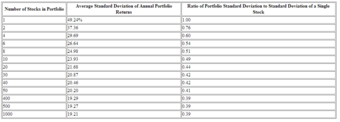
An empirical example relating diversification to risk reduction
In 1977 Elton and Gruber worked out an empirical example of the gains from diversification. Their approach was to consider a population of 3,290 securities available for possible inclusion in a portfolio, and to consider the average risk over all possible randomly chosen n-asset portfolios with equal amounts held in each included asset, for various values of n. Their results are summarized in the following table. It can be seen that most of the gains from diversification come for n≤30.
8.6.2: Impact of Diversification on Risk and Return: Systematic Risk
Systematic risk is intrinsic to the market, and thusly diversification has no effect on its presence in investments.
Learning Objective
Describe how systemic risk influences the stock market
Key Points
- Diversification is a technique for reducing risk that relies on the lack of a tight positive relationship among the returns of various types of assets.
- The role of diversification is to narrow the range of possible outcomes.
- Unsystematic risk does not factor into an investment’s risk premium, since this type of risk can be diversified away.
Key Term
- systematic risk
-
systematic or non-diversifiable risk is a term given to the portion of risk in a portfolio that cannot be diversified away by holding a pool of individual assets and therefore commands a return in excess of the risk-free-rate.
Recall that previously we talked about the security market line and the implication that investors require more compensation for extra risk. One might pay the same amount for a safe investment as for an investment carrying more risk; however, the riskier investment will, in theory, provide a higher return. This is the principle behind the security market line . Diversification is a technique for reducing risk that relies on the lack of a tight positive relationship among the returns of various types of assets. By diversifying a portfolio of assets, an investor loses the chance to experience a return associated with having invested solely in a single asset with the highest return. On the other hand, the investor also avoids experiencing a return associated with having invested solely in the asset with the lowest return — sometimes even becoming a negative return. Thus, the role of diversification is to narrow the range of possible outcomes.
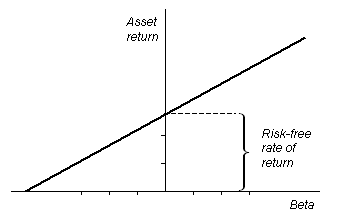
The Security Market Line
Diversification theory says that the only risk that earns a risk premium is that which can’t be diversified away.
As a result, the portion of risk that is unsystematic — or risk that can be diversified away — does not require additional compensation in terms of expected return. For example, consider the case of an individual who buys 50 corporate bonds from a single company. The individual receives a certain yield based on the purchase price. However, if unexpected business risks lead to liquidity problems, the company might go bankrupt and default on its loans. In such a case, the investor will lose the entirety of the investment. Conversely, if the investor buys a single bond from 50 different corporations who have similar credit ratings, then one instance of insolvency will have a far less drastic effect on the investor’s portfolio.
Now, imagine that these 50 corporations are all given a lesser credit rating because of the risk of their overall market segment. In this case, the individual is still at risk to lose some or all of the initial investment. This type of risk cannot be diversified away, and is referred to as systematic risk. This is the portion of risk that pays the risk premium, because the risk associated with this particular segment of the market is more tightly linked to the risk of the market as a whole. This risk is present regardless of the amount of diversification undertaken by an investor.
8.7: Understanding the Security Market Line
8.7.1: Expected Risk and Risk Premium
Overall riskiness of an asset is composed of its own individual risk (beta) along with its risk in relation to the market as a whole.
Learning Objective
Use a stock’s beta to estimate a stock’s daily growth or decline.
Key Points
- In return for undertaking risk, investors expect to be compensated in such as a way as to reasonably reward them.
- Systemic risk is the risk associated with an entire financial system or entire market. It cannot be diversified away.
- Unsystematic risk is risk to which only specific classes of securities or industries are vulnerable, and with proper grouping of assets it can be reduced or even eliminated.
- Beta is a number describing the correlated volatility of an asset in relation to the volatility of the benchmark that said asset is being compared to — usually the market as expressed in an index.
- The term risk premium refers to the amount by which an asset’s expected rate of return exceeds the risk-free interest rate.
Key Terms
- Risk free rate
-
Risk-free interest rate is the theoretical rate of return of an investment with no risk of financial loss.
- treasury bill
-
Treasury bills (or T-Bills) mature in one year or less. They do not pay interest prior to maturity; instead they are sold at a discount of the par value to create a positive yield to maturity.
A certain amount of risk is inherent in any investment. Risk can be defined, generally, as the potential that a chosen action or activity (including the choice of inaction) will lead to a loss or an undesirable outcome. The notion of risk implies that a choice having an influence on the outcome exists. More specifically to finance, risk can be seen as relating to the probability of uncertain future events. In return for undertaking risk, investors expect to be compensated in such as a way as to reasonably reward them. This is a central them in the subject of finance. In the financial realm, two types of risk exist: systematic and unsystematic.
Systemic risk is the risk associated with an entire financial system or entire market. This type of risk is inherent in all marketable securities and cannot be diversified away. On the other hand, unsystematic risk is risk to which only specific classes of securities or industries are vulnerable. This type of risk is uncorrelated with broad market returns, and with proper grouping of assets can be reduced or even eliminated. Because of this characteristic, investors are not rewarded for taking on unsystematic risk.
Systematic risk can be understood further using the measure of Beta. This is a number describing the correlated volatility of an asset in relation to the volatility of the benchmark that said asset is being compared to — usually the market as expressed in an index.

Beta
Beta is a measure that relates the rate of return of an asset, ra, with the rate of return of a benchmark, rb.
Values of Beta can be interpreted using the following information:
- Betas less than 0: Asset generally moves in the opposite direction as compared to the index.
- Betas equal to 0: Movement of the asset is uncorrelated with the movement of the benchmark.
- Beta between 0 and 1: Movement of the asset is generally in the same direction as, but less than the movement of the benchmark.
- Beta equal to 1: Movement of the asset is generally in the same direction as, and about the same amount as, the movement of the benchmark.
- Beta greater than 1: Movement of the asset is generally in the same direction as, but more than, the movement of the benchmark.
Risk Premium
The term risk premium refers to the amount by which an asset’s expected rate of return exceeds the risk free rate. The difference between the return of an asset in question and that of a risk-free asset — for instance, a US Treasury bill — can be interpreted as a measure of the excess return required by an investor on the risky asset. The risk premium, along with the risk-free rate and the asset’s Beta, is used as an input in popular asset valuation techniques, such as the Capital Asset Pricing Model.
8.7.2: Defining the Security Market Line
The security market line displays the expected rate of return of a security as a function of systematic, non-diversifiable risk.
Learning Objective
Describe the Security Market Line
Key Points
- The security market line is the theoretical line on which all capital investments lie. Investors want higher expected returns for more risk.
- On a graph, the line has risk on its horizontal axis (independent variable) and expected return on the vertical axis (dependent variable).
- Assuming a linear relationship between risk and return, the assumption is that the y-intercept is the return on a risk-free investment (the risk free rate), and the slope is the premium on risk in terms of expected returns.
- Given two investments with the same expected return, investors would always choose less risk. Someone with opposite preferences might better be called a gambler.
Key Terms
- market risk premium
-
the amount by which expected rate of return of the exchange system exceeds the risk-free interest rate
- market risk
-
the potential for loss due to movements in prices in a system of exchange
- line of credit
-
source of debt extended to a government, business or individual by a bank or other financial institution
- diversifiable risk
-
the potential for loss which can be removed by investing in a variety of assets
- security market line
-
Security market line (SML) is the representation of the capital asset pricing model. It displays the expected rate of return of an individual security as a function of systematic, non-diversifiable risk (its beta).
- beta
-
Average sensitivity of a security’s price to overall securities market prices.
The security market line, also known as the “characteristic line”, is the graphical representation of the capital asset pricing model. It is a hypothetical construct based on a world of perfect information. In the absence of perfect information, we can more or less assume historical data will give us an accurate expectation of what kind of returns and risk to expect with a particular investment of capital. The security market line graphs the systematic, non-diversifiable risk (stated in terms of beta) versus the return of the whole market at a particular time, and shows all risky marketable securities. The security market line is defined by the equation:

The equation that defines the security market line.
Look at the equation and remember that old formula of a line: y = mx + b. In this case it looks rearranged, like y = b + mx, but the real question is what do the slope and y-intercept actually represent?
The Y-intercept of the SML is equal to the risk-free interest rate. Recall that the risk-free interest rate is the theoretical rate of return of an investment with no risk of financial loss. When used in portfolio management, the SML represents the investment’s opportunity cost — i.e., investing in a combination of the market portfolio and the risk-free asset. All the correctly priced securities are plotted on the SML. The assets that lie above the line are undervalued because for a given amount of risk, they yield a higher return. The assets below the line are overvalued because for a given amount of risk, they yield a lower return.
The slope of the SML is equal to the market risk premium and reflects the risk return trade off at a given time. The idea of a security market line follows from the ideas asserted in the last section, which is that investors are naturally risk averse, and a premium is expected to offset the volatility of a risky investment. In a perfect world, with perfect information, any capital investment is on the security market line. The idea of a security market line is important for understanding the capital asset pricing model. Let’s look at the line again:
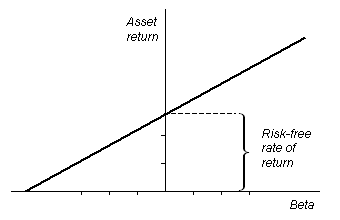
The Security Market Line
This is an example of a security market line graphed. The y-intercept of this line is the risk-free rate (the ROI of an investment with beta value of 0), and the slope is the premium that the market charges for risk.
8.7.3: Impact of the SML on the Cost of Capital
The plotted location of an instrument on the SML has consequences on its price, return, and cost of capital it contributes to a firm.
Learning Objective
Describe the impact of the SML on determining the cost of capital
Key Points
- The security market line is a hypothetical concept that suggests that investors require compensation in the form of expected returns for the risk the investment exposes them to.
- A capital investment below the security market wouldn’t be efficiently priced to the buyer of the investment. A higher return or lower price would be required, both increasing the cost of capital.
- A capital investment above the security market line wouldn’t be efficiently priced for the seller or whomever raises the capital. A lower return or higher price would be necessary to justify this cost of capital for the company.
Key Term
- capital asset pricing model
-
In finance, the capital asset pricing model (CAPM) is used to determine a theoretically appropriate required rate of return of an asset, if that asset is to be added to an already well-diversified portfolio, given that asset’s non-diversifiable risk.
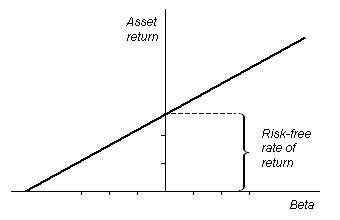
The Security Market Line
The location of a financial instrument above, below, or on the security market line will lead to consequences for a company’s cost of capital.
The security market line is a graphical representation of the capital asset pricing model that illustrates the idea that investments are priced efficiently based on the expected return and beta-value (risk). Companies often turn to capital markets in order to generate funds — using the issuance of either debt or equity. The cost of obtaining funds in such a manner is known as a company’s cost of capital. There is a tradeoff between a security’s price and its expected return. If the price of the instrument goes up, its expected returns go down, and vice versa. A firm that is raising capital would like to sell these instruments for a high price, and investors want to buy them for a low price.
An instrument plotted below the SML would have a low expected return and a high price. This market situation would be quite attractive from the perspective of a company raising capital; however, such an investment wouldn’t make sense for a rational buyer. The rational investor will require either a higher return or lower price, which will both result in a higher cost of capital for the company.
An instrument plotted above the line has a high expected return and a low price. This would not be an attractive market situation for a company looking to raise capital. Such a firm wants to raise as much money as possible, which means getting investors to pay the highest price possible.
An instrument plotted on the SML can be thought of to be fairly priced for the amount of expected return. Such an instrument would be a fair investment from an individual’s perspective, and would lead to a fair cost of capital from a company’s perspective.
